

40 Must-See Holy Sites in Israel and the West Bank
By: Author Milijana
Posted on Published: November 10, 2018 - Last updated: March 31, 2024
Categories ISRAEL , MIDDLE EAST , SPIRITUAL TRAVEL
Sharing is caring!
A complete guide to popular holy sites in Israel and the West Bank. Traveling to Israel and the West Bank, but not visiting religious places of Judaism, Islam, and Christianity means not trying to understand the cultures and beliefs of people inhabiting this area and far. Religious, spiritual, or simply curious about other cultures and respectful of their beliefs, here is a recommended list of the most important religious sites In Israel and the West Bank and the most popular holy sites in Israel and the West Bank. The list covers sacred places of four monotheistic religions: Judaism, Christianity, Islam, and Bahai’s Faith. It sums up holy places of Judaism, holy places of Christianity, holy places of Islam, and holy places of Bahai Faith in Israel and the West Bank.
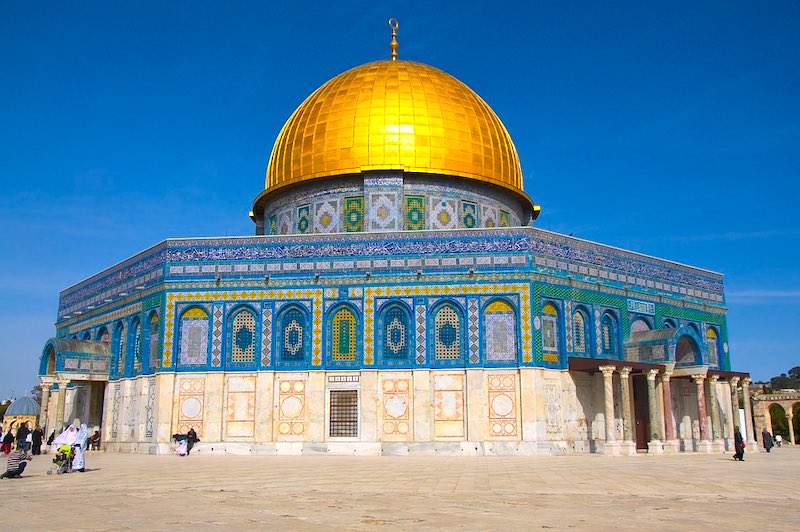
THIS POST MAY CONTAIN COMPENSATED LINKS. PLEASE READ MY DISCLAIMER FOR MORE INFO.
RELIGIONS OF ISRAEL AND THE WEST BANK
Today Christianity is the biggest religion in the world with about 2.1 billion followers worldwide.
Islam is the second-largest religion with over 1.8 billion followers. Judaism has about 13 million followers and the Bahai Faith has about 7 million followers worldwide.
To summarize, that’s more than 4 billion people.
4 billion people, out of the estimated 7.5 billion people on the Earth. What do those 4 billion people have in common?
Holy places in one country, today called Israel .
Israel and the West Bank cover the largest part of the biblical Holy Land, while a few sites are in Jordan and Egypt ( Sinai mountain ).
Speaking of religions in Israel, today about 75% of the population of Israel are followers of Judaism, about 18% are followers of Islam, 2% are Christians and about 1.6% are Druze (an Islamic sect). Regarding the main religions in the West Bank, about 75% of the West Bank’s population are followers of Islam, about 17% are followers of Judaism and 8% are followers of Christianity.
Holy sites in Israel and P alestine
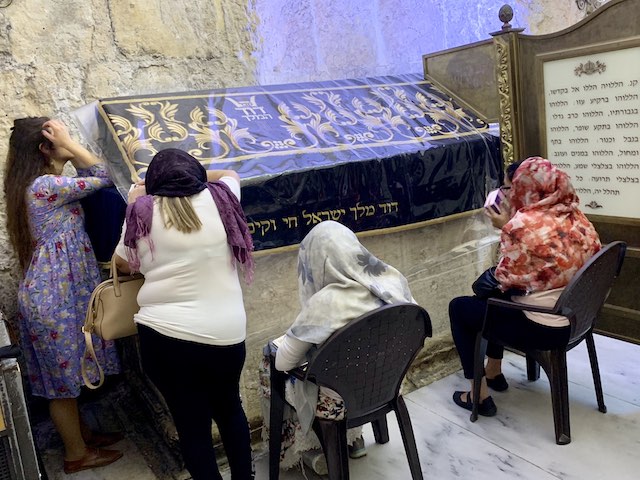
Recommended Holy Land tour: 8 Days in the Holy Land for Catholics (Viator)
1.1 Temple Mount or Haram Al-Sharif
1.2 dome of the rock, 1.3 al-aqsa mosque, 1.4 the western wall or the buraq wall, 1.5 church of the holy sepulchre, 1.6. via dolorosa, 1.7 king david’s tomb, 1.8 last supper room, 1.9 church of dormition, 1.10 dome of ascension, 1.11 church of saint mark, 1.12 mount of olives, 1.13 garden of gethsemane, 1.14 church of all nations, 1.15 tomb of the prophets, 2.1 church of the nativity and the grotto of the nativity, 2.2 church of st catherine, 2.3 milk grotto, 2.4 tomb of rachel, 3.1 basilica of the annunciation, 3.2 church of st joseph, 3.3 synagogue church, 3.4 mary’s well, 3.5 church of the transfiguration, 4.1 tombs of the patriarchs and matriarchs, 5.1 mount of beatitudes, 5.3 capernaum, 5.4 jesus trail, 5.6 qasr el yahud – the jesus’ baptism site on the river jordan, 6.1 muhraka monastery, 6.2 stella maris monastery and elijah’s cave, 6.3 shrine of the bab and the bahai’s garden, 7.1 house of abbud, 7.2 bahji mansion and shrine of baha-ullah, 8.1 tomb of rabbi shimon bar yochai, 8.2 haari ashkenazi synagogue, 8.3 sephardic harri synagogue, 8.4 abuhav synagogue, map of holy sites in the holy land.
- Why is Jerusalem a holy city?
- Why is Jerusalem important?
Why is Jerusalem important to Jews?
- Why is Jerusalem important to Christians?
- Why is Jerusalem important to Muslims?
RECOMMENDED READ
40 popular holy sites in israel and the west bank.
The following list of popular holy sites in Israel and the West Bank covers the most important holy sites of Judaism , holy sites of Christianity , holy sites of Islam , and holy sites of Bahai’s Faith .
The list wraps up 40 sacred places in Jerusalem, Bethlehem, Nazareth, Hebron, the Sea of Galilee, Haifa, Acre (Akko), and Safed.
The collection of 40 sacred places in Israel and the West Bank starts with the holiest city in the world – Jerusalem.
1. Holy Sites in Jerusalem
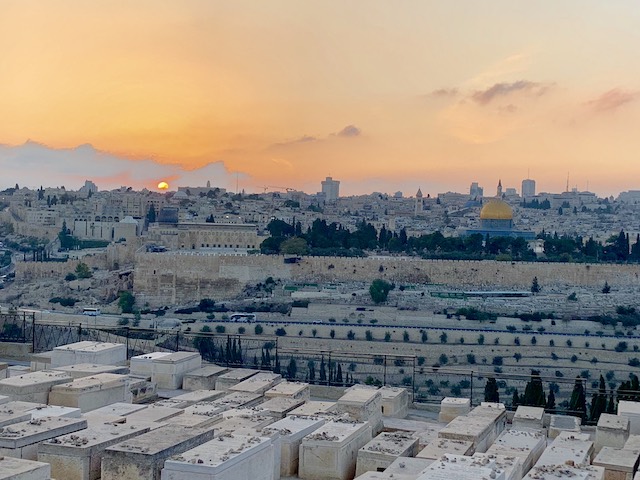
JERUSALEM, meaning ‘the City of Peace’ in Hebrew, is called the holiest city in the world. Jerusalem is a holy city of 3 major monotheistic religions and the oldest monotheistic religions in the world. Jerusalem is a holy city for Muslims, Jews, and Christians. As such, Jerusalem holds a striking number of holy sites in Israel. Jerusalem is one of the most sacred places in the world, if not the most sacred place in the world.
The Old City of Jerusalem is divided into 4 quarters: the Muslim quarter, the Christian quarter, the Jewish quarter, and the Armenian quarter. Present-day Jerusalem holds about 1.200 Jewish synagogues, about 150 Christian churches, and more than 70 Muslim mosques.
To briefly outline the history of Jerusalem, let me say that the official history of Jerusalem starts in 1.000 BC when King David made Jerusalem the capital of the Kingdom of Israel. After that Jerusalem was conquered many times and ruled by Babylonians, Persians, Greeks, Syrians, Romans, Muslims, Crusaders, Egyptian Mamelukes, Ottoman Turks, and Brits, partially by Jordanians and now Israelis and partially by Palestinians.
Knowing the history of Jerusalem, historical places in Jerusalem, and sacred sites in Jerusalem, it’s quite obvious why Jerusalem is a holy city of Islam, a holy city of Judaism, and a holy city of Christianity. Even more, Jerusalem is the holiest city of Judaism, the holiest city of Christianity, and one of the 3 major Islamic holy cities. Therefore, it’s not surprising that a once-in-a-lifetime pilgrimage to Jerusalem is on the wish list of many believers.
The most important sacred sites in Jerusalem are the Temple Mount (Haram al-Sharif), Dome of the Rock, Al Aqsa mosque , Western Wall (Buraq Wall), Church of Holy Sepulcher , Via Dolorosa , King David’s Tomb , Last Supper Room , Church of Dormition , Dome of Ascension, Church of St Mark , Mount of Olives , Garden of Gethsemane , Church of All Nations , and Tomb of the Prophets .
But, three major holy sites in Jerusalem and famous landmarks in Jerusalem are the Temple Mount (with Dome of the Rock and Al Aqsa mosque ), the Western Wall, and the Church of the Holy Sepulchre.
The Temple Moun t (with Dome of the Rock and Al Aqsa mosque ), the Western Wall, and the Church of the Holy Sepulchr e in Jerusalem are considered the holiest places in Israel and some of the holiest places in the World.
Holy Sites in Jerusalem:
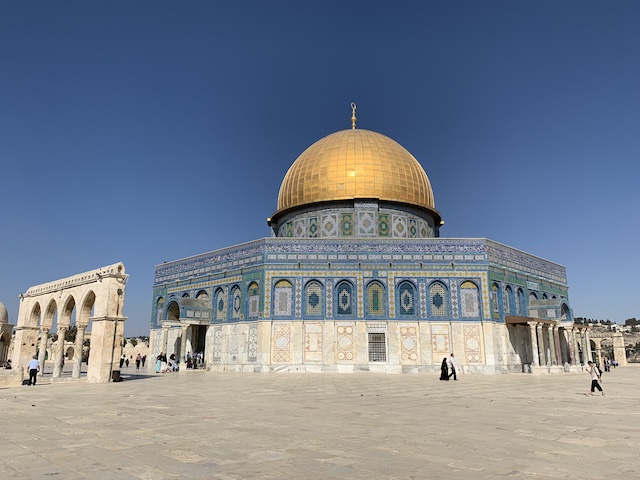
What is the Temple Mount?
The TEMPLE MOUNT, also called HARAM AL-SHARIF which means the NOBLE SANCTUARY, is a plateau in the Old City of Jerusalem.
The Temple Mount is considered to be the holiest place in Jerusalem and a place of huge importance to today’s 3 main religions in the World: Islam, Christianity, and Judaism.
Why is the Temple Mount important? Why is the Temple Mount a source of argument?
The Temple Mount is the holiest site in Judaism. It is the site where King Solomon’s First Temple stood once.
But, for Muslims, the Temple Mount is Haram Al-Sharif (or the Noble Sanctuary), the site where Prophet Muhammed ascended to Heaven from the Earth on a winged horse during his Night Journey.
Haram Al-Sharif is the 3rd holiest place in Islam, after Mecca and Medina, and a place of Islamic worship. Masjid al-Haram in Mecca, al-Masjid an-Nabawi in Medina, and Haram Al-Sharif in Jerusalem are the most important holy sites of Islam. On that account, major Islamic holy cities are Mecca, Medina, and Jerusalem.
Why is the Temple Mount important to Judaism?
For Jews, the Temple Mount is the site where the First Temple or the Great Temple of Jerusalem built by King Solomon stood. The temple held the Ark of the Convent with the Ten Commandments.
The Temple Mount is believed to be the place of the Biblical Mount Moriah with the sacred rock on which Abraham planned to sacrifice his son Isaac to God. The Temple Mountain is the holiest site in Judaism holding the Foundation Stone where Earth was created. It is a Jewish place of worship.
Why is the Temple Mount important to Christianity?
The Temple Mount is also a sacred place of Christianity. For Christians, this is the place where Jesus as a baby was first presented to God, and where he was praying and preaching to his disciples daily.
Jesus as a child impressed the Jewish teachers with his knowledge at that time synagogue on the Temple Mount. Jesus in anger overturned the tables of moneychangers in front of the synagogue (temple) on the Temple Mount.
The TEMPLE MOUNT holds another two important religious sites in Jerusalem and Jerusalem landmarks: the DOME OF THE ROCK and AL-AQSA MOSQUE .
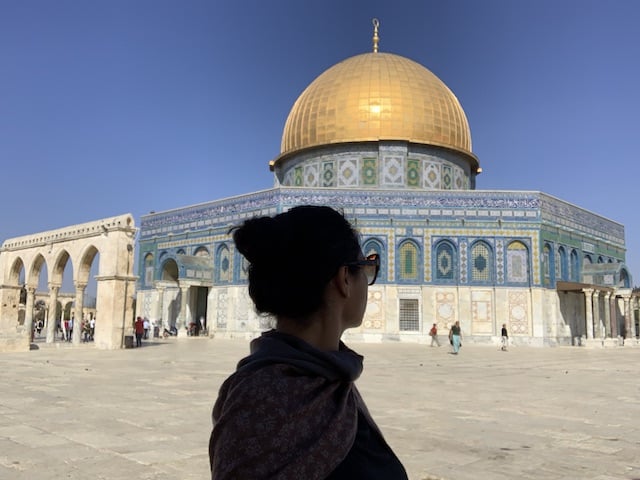
The Dome of the Rock is a Jerusalem landmark that dominates the architecture of Jerusalem. Thus, when you see postcards from Jerusalem most likely you see the golden cupola of the Dome of the Rock.
What is the Dome of the Rock? Why is the Dome of the Rock important?
The Dome of the Rock is a Muslim shrine in Jerusalem built on the Temple Mount or the Noble Sanctuary.
Why is the Dome of the Rock important to Islam?
The Dome of the Rock is built over the sacred stone where the Prophet Muhammed ascended to Heaven from the Earth on a winged horse during his Night Journey.
Thus, the Dome of the Rock in Jerusalem is one of the most important Islamic holy sites in the world.
Why is the Dome of the Rock important to Judaism?
According to Jewish beliefs, this is the very same rock on which Abraham prepared to sacrifice his son to God and the rock in the center of Solomon’s Temple.
Therefore, the Dome of the Rock in Jerusalem is one of the most important Judaism holy sites.
Why is the Dome of the Rock important to Christianity?
Abraham is highly praised by all Abrahamic faiths: Judaism, Islam, and Christianity.
In short, all Abrahamic religions come from Abraham’s family tree.
So, the Temple Mount has been a Christian pilgrimage site for centuries as well. Furthermore, in medieval times during the conflict between Christians and Muslims, when a Fatimid Caliph ordered the destruction of the Church of Holy Sepulchre (the church where Jesus was crucified and buried), the Crusaders took the Dome of the Rock and turned it into a church called ‘Templum Domini’ or ‘Temple of the Lord’.
Al Aqsa mosque is the third holiest site in Islam and one of Jerusalem’s most famous places.
The Al Aqsa mosque stands on Haram-Al Sharif (or, the Temple Mount) compound in Jerusalem.
While the Dome of the Rock was built around 690 AD, the Al-Aqsa mosque was built 20 years later around 710 AD.
In the 11th century during the Crusaders’ times, Crusader kings converted the Al-Aqsa mosque into a royal palace. In the 12th century, it became the headquarters of the Knights of Templar. Sultan Saladin took it in the 12th century, followed by Mamluks in the mid-14th century.
Today Muslims or more precisely the Waqf (the Supreme Muslim Religious Council ) manage the Temple Mount with the Dome of the Rock and Al Aqsa Mosque, while the City of Jerusalem is under Israeli governance.
The entrance to Temple Mountain for non-Muslims is from the wooden Mughrabi Bridge next to the Western Wall.
Opening times: 7:30 am -11 am, and 1:30 pm- 2:30 pm (closed on Fri and Sat to non-Muslims)
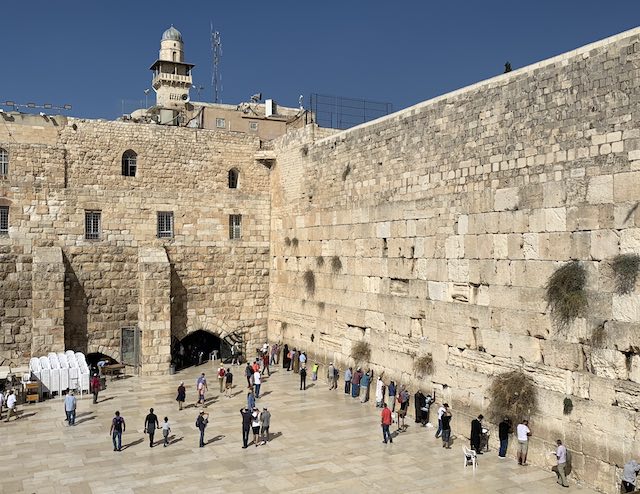
The WAILING WALL, or the Western Wall or Kotel HaMa’aravi in Hebrew, is the last remaining wall of the Temple Mount where once the ancient Solomon’s Temple of Jerusalem and where the Holy of Holies – the Gate to Haven stood. The Holy of the Holies is the most sacred site in Judaism. Therefore, the Western Wall in Jerusalem is one of the most popular holy sites in Israel.
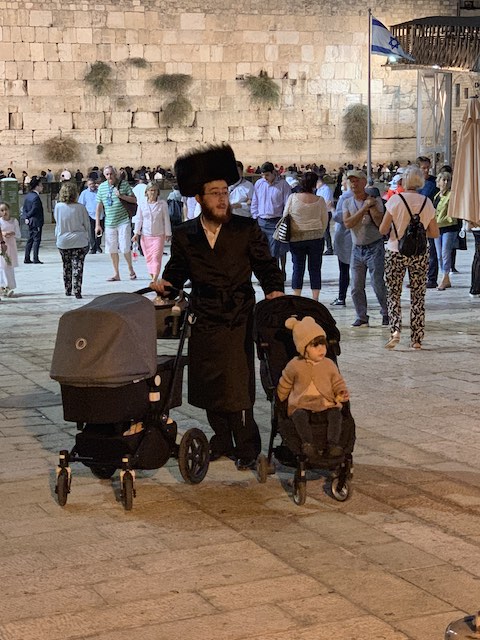
There are separate prayer sites for men and women on the Western Wall. The left side of the wall is reserved for men’s praying and the right side for women. According to tradition, prayers put their prayer notes in the cracks between the rocks. The Western Wall is the Buraq Wall for Muslims. The Buraq Wall is the site where Prophet Muhammad tied his horse Burqa on the Night Journey to Jerusalem. On that account, this site is one of Islam’s sacred sites and one of the most important Islamic holy places.
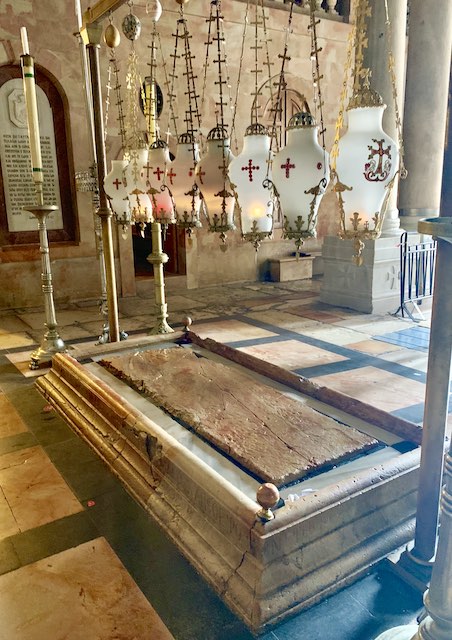
The Church of the Holy Sepulchre in Jerusalem is the most important and holiest Christian site in the world. It is the holiest place in Christianity where Jesus was crucified, buried, and resurrected. The Church of the Holy Sepulchre in Jerusalem is one of the most popular holy sites in Israel and one of the most famous sacred sites in the world.
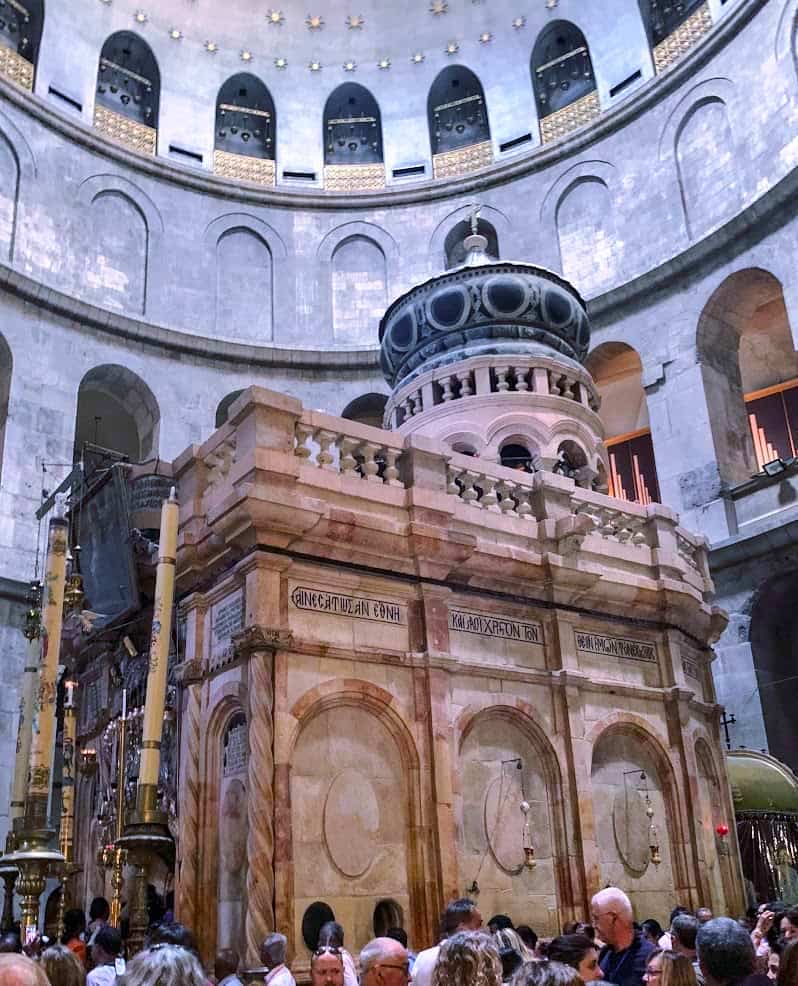
Where is Jesus buried? Where is Jesus’ tomb?
The tomb of Jesus is in the Church of the Holy Sepulchre in Jerusalem.
Furthermore, the Church of the Holy Sepulchre in Jerusalem holds the STONE OF ANOINTING (also called the STONE OF UNCTION), the GOLGOTHA HILL (also called the CALVARY, or the PLACE OF THE SKULL) where Jesus was crucified, the AEDICULE CHAPEL (the Mausoleum) with the TOMB OF JESUS and the ANGEL STONE, the stone door which was used to close the tomb of Jesus. For that, the Church of the Holy Sepulchre in Jerusalem is the holiest site in Christianity. For centuries six Christian denominations share the church: the Greek Orthodox, Roman Catholic, Ethiopian, Coptic, and Syriac Orthodox, while a Muslim family keeps the key to the church.
Opening hours: 5 am – 8 pm (summer), and 4 am-7 pm (winter)
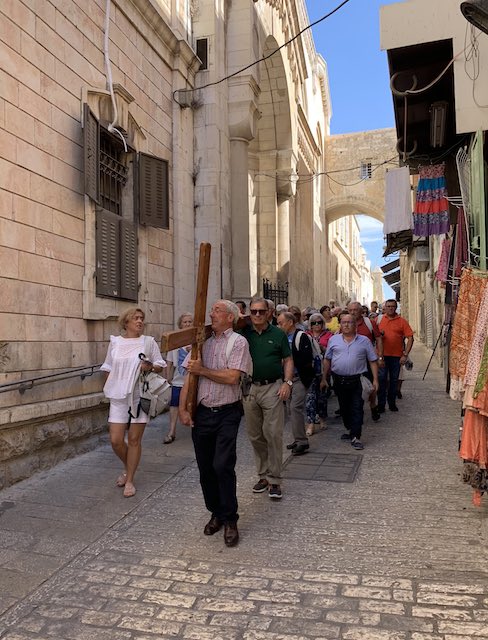
WAY OF SORROWS or VIA DOLOROSA in Jerusalem marks a 500 m-long route of suffering Jesus Christ on his way to crucifixion. Undeniably, the Via Dolorosa in Jerusalem is one of the most famous holy places in Jerusalem and the most popular holy sites in Israel. Walking Via Dolorosa is among the most popular things to do in the Holy Land for Christians. And, Jerusalem Old City walking tours are some of the best Jerusalem tours . 14 Stations of the Cross start with the first station in the courtyard of Al-Omariya School for boys in Jerusalem (close to the Lion’s Gate in Jerusalem) and finish with the last 4 stations in the Church of the Holy Sepulchre. The biggest part of the Via Dolorosa is in the Muslim Quarter, while the smaller part is in the Christian Quarter in Jerusalem. On Good Friday the Christian procession goes via Via Dolorosa which is accompanied by Muslim guards in Ottoman uniforms marking their authority.
The TOMB OF KING DAVID is one of the most important Judaism places of worship and holy sites in Jerusalem. It is a Jewish holy place on Mount Zion, located just outside the walls of the Old City of Jerusalem in the Armenian quarter. King David was the second king of the ancient Kingdom of Israel and was highly praised in the Old Testament. The Tomb of King David in Jerusalem is a Jewish holy place of worship and one of the most popular holy sites in Israel.
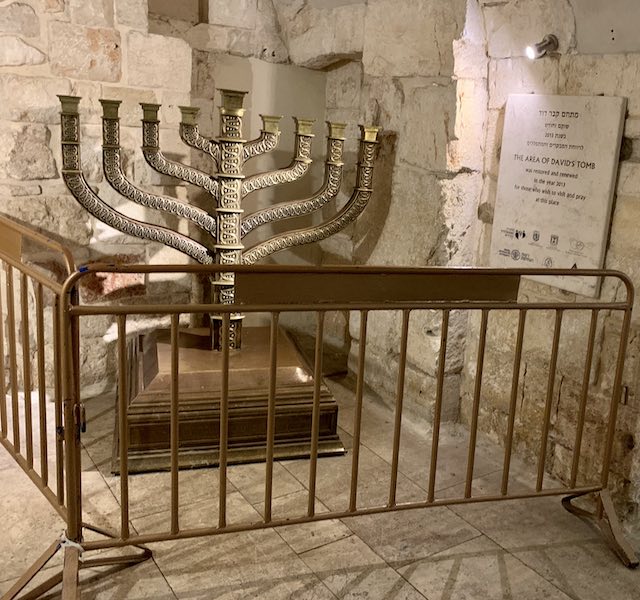
The Room of Jesus’ Last Supper, one of the most important holy sites of Christianity is just above the room with the tomb of King David.
Opening hours of the Tomb of King David in Jerusalem: 8 am-5 pm (Sat – Thu), 8 am-1 pm (Fri)
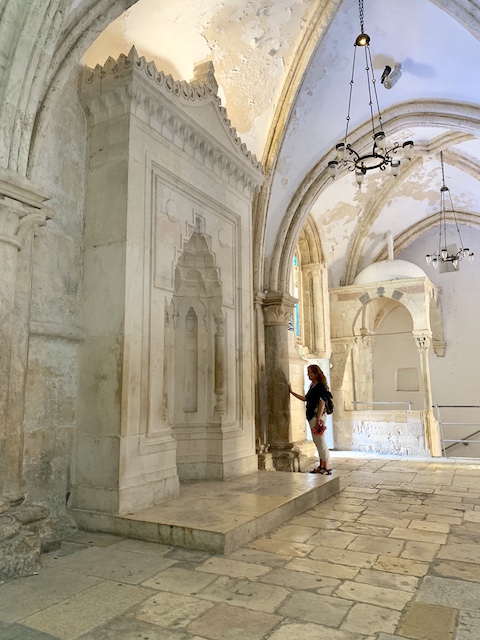
The list of Christian sites in Jerusalem goes on with the ROOM OF THE LAST SUPPER which is located on Mount Zion in Jerusalem. The Room of the Last Supper also called the CENACLE ROOM, is one of the most popular holy sites in Israel for Christians. This is a holy site of Christianity as this is the room of the Last Supper where Jesus washed their feet to His apostles and shared His last meal with them the night before He died and the night when He instituted the Eucharist. This is also the place where the Holy Spirit came on the apostles on Pentecost. The Last Supper Room is also known as the UPPER ROOM since it is located in an upper room in the King David’s Tomb compound.
Opening hours of the Room of Last Supper Room in Jerusalem: 8 am – 5 pm (Sat Thu), 8 am-1 pm (Fri)
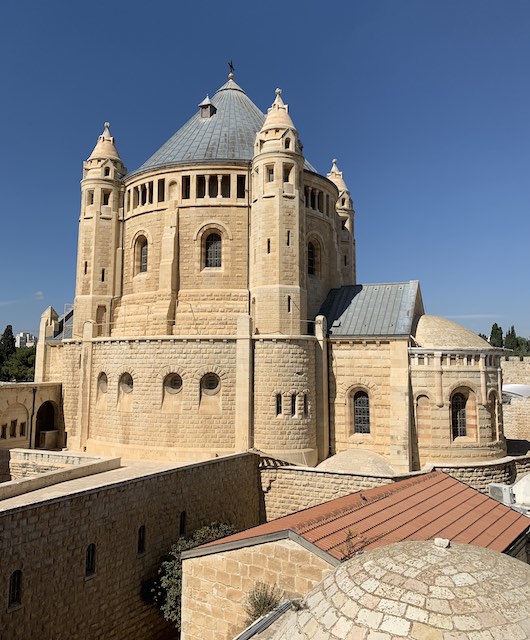
The Church of Dormition stands on the top of Mount Zion in the Old City of Jerusalem. It is another important sacred site of Christianity as it is believed to be the place where the Virgin Mary fell asleep and died.
Opening times: 8:30 am-11.45 am, 12:40 pm-5:30 pm, (Mon-Fri); 8:30 am-11.45 am, 12:40 pm-2:45 pm, 3:30 pm-5:30 pm (Mon); 10:30 am-11:45 am, 12:30 pm-5.30 pm (Sun)
The Dome of Ascension in Jerusalem is another popular holy site in Israel. It is one of the sacred sites of Christianity but also one of the sacred sites of Islam. It is a Christian sacred site and a sacred site of Islam on Mount Zion. This is the place where Jesus ascended to Heaven. The shrine has been a part of a mosque since the 12th century when Sultan Saladin defeated the Crusaders. Since Muslims believe also in the Ascension of Jesus Christ, the church was converted into a mosque. Ergo, it is one of the sacred places of Islam as well. Christians are allowed to celebrate the Ascension here on the Ascension Feast Day.
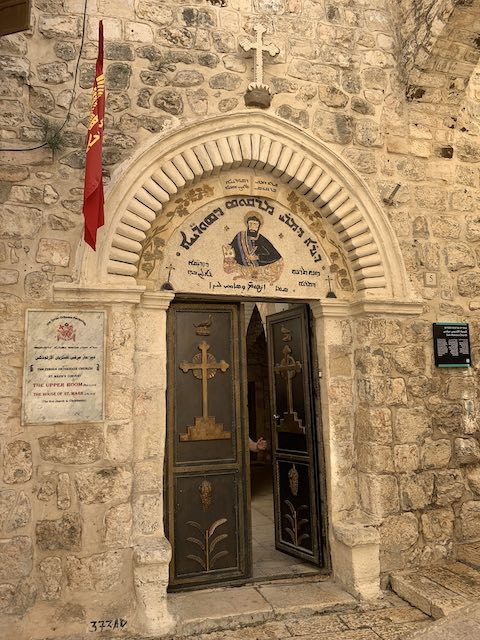
The Church of St Mark is a Syriac Orthodox church in the Armenian quarter of the Old City of Jerusalem. Syriac Christians were the first people who adopted Christianity as indigenous people of the Holy Land.
Syriac is the Aramaic dialect Jesus spoke. The oldest surviving liturgy in Christianity is served in Syriac.
Syriac Orthodox Church is an Oriental Orthodox church that is autonomous and doesn’t belong either to Rome or Constantinople.
The Church of St Mark is one of the most beautiful churches I have seen in Jerusalem and one of Jerusalem’s religious sites that shouldn’t be missed out in Israel.
Opening times: 9 am-5 pm (Apr-Sep); 7 am-4 pm (Oct-Mar); 11 am-4 pm (Sun)
The MOUNT OF OLIVES is a Christian holy place and a Jewish holy site. According to the Old Testament, King David ran away from the Mount of Olives when his son rebelled. For Jewish believers, the Messiah will descend on the Mount of Olives and enter Jerusalem through the Golden Gate on Judgment Day.
Christians believe that Jesus went from the Mount of Olives to Jerusalem on Palm Sunday. Also according to the New Testament, Jesus was arrested on the Mount of Olives.
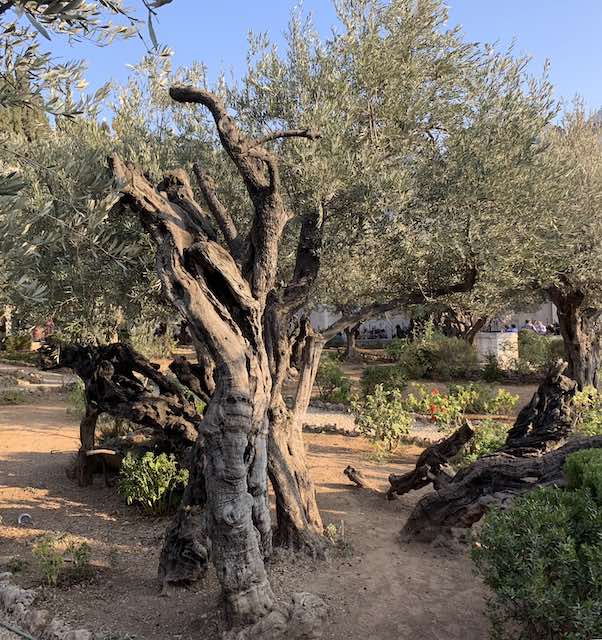
The GARDEN OF GETHSEMANE is another holy site of Christianity in Jerusalem. It is the garden on the foot of the Mount of Olives where Jesus prayed the night before he was arrested and crucified.
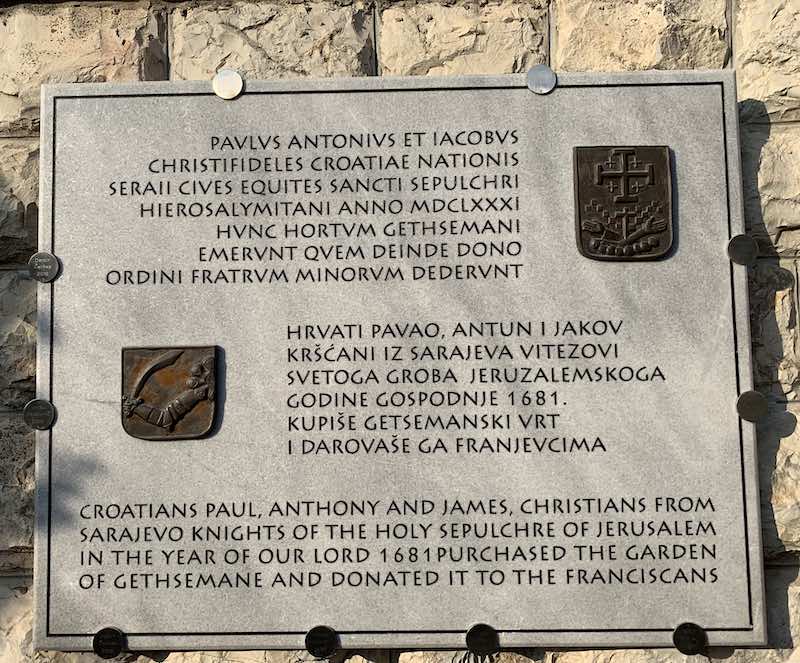
The Church of All Nations, also called the Basilica of Agony, is located in the Garden of Gethsemane. The Garden of Gethsemane and the Basilica of Agony are Christianity’s sacred places.

The BASILICA OF AGONY, or the Church of All Nations, is a church just next to the olives of the Garden of Gethsemane. It is another holy place of Christianity and one of the important holy sites of Jerusalem. The basilica was built over the rock where Jesus prayed in agony before he was betrayed by Judas Iscariot. A pair of thornbirds on the Rock of Jesus Agony symbolize souls who want to share Christ’s Passion. Opening time: 8 am – 12 pm, 2 pm – 6 pm (or 2 pm – 5 pm in winter)
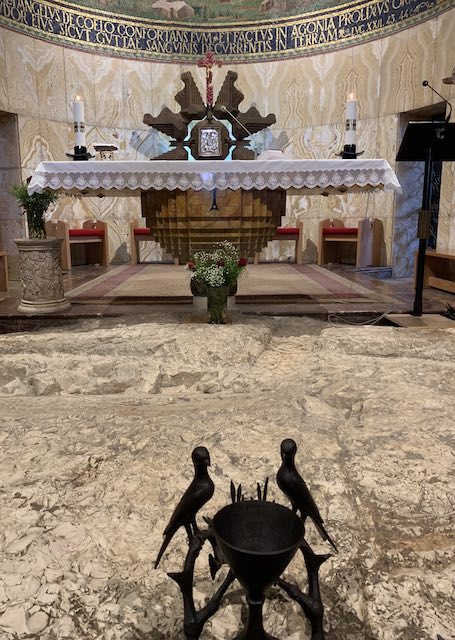
The TOMB OF THE PROPHETS on the Mount of Olives is again one of those holy sites in Jerusalem that is a Christian holy place and a holy place of Judaism as well.
The Tomb of the Prophets is a catacomb with the tombs of Biblical prophets Zechariah, Malachi, and Haggai. If you are looking for the tomb of Old Testament prophets, the Tomb of the Prophets on the Mount of Olives is the place to visit. Opening hours of the Tomb of the Prophets: 9 am-3 pm (Fri, Sat, Sun closed)
Plan your trip to Jerusalem Book your stay at Chain Gate Hostel, or Stay Inn Hostel (budget) Jerusalem Hotel (mid-range) The Sephardic House Hotel in the Jewish quarter (luxury) Check out the most popular tours in Jerusalem Jerusalem Walking Tour: In the Footsteps of Jesus (the most popular tour) Old Jerusalem Full-Day Tour
What are the most important holy sites in Jerusalem?
The most important sacred sites in Jerusalem are the Temple Mount (Haram al-Sharif), Dome of the Rock, Al Aqsa mosque, Western Wall (Buraq Wall), Church of Holy Sepulcher, Via Dolorosa, King David’s Tomb, Last Supper Room, Church of Dormition, Dome of Ascension, Church of St Mark, Mount of Olives, Garden of Gethsemane, Church of All Nations, and Tomb of the Prophets.
But, 3 major holy sites in Jerusalem and famous landmarks of Jerusalem are the Temple Mount (with Dome of the Rock and Al Aqsa mosque ), the Western Wall, and the Church of the Holy Sepulchre.
What are the holiest places in Israel?
The Temple Moun t (with Dome of the Rock and Al Aqsa mosque ), the Western Wall, and the Church of the Holy Sepulchr e in Jerusalem are considered as the holiest places in Israel and some of the holiest places in the World.
2. Holy Sites in Bethlehem
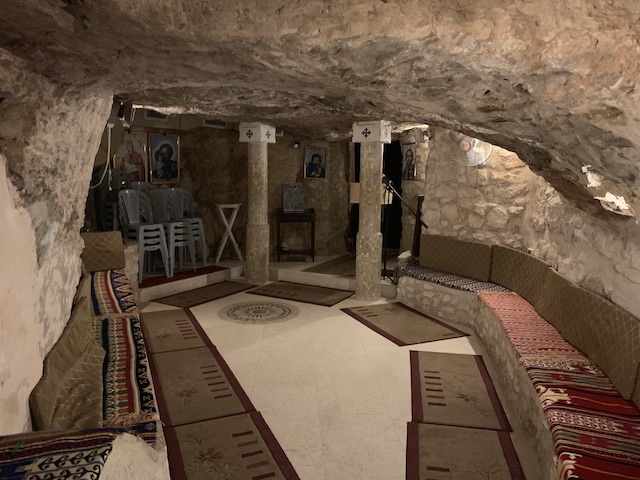
The City of Bethlehem in the West Bank is located only 9 km south of Jerusalem. Bethlehem in Hebrew means ‘the City of Bread’. Bethlehem is a holy city holding several important sacred places of Christianity, sacred places of Islam, and sacred sites of Judaism. Bethlehem is one of the most important holy cities of Christianity since it is the birthtown of Jesus Christ. Since Jesus is a prophet for Muslims, Bethlehem is also a holy city of Islam. But Bethlehem is also the birthtown of King David, the Israeli’s second king, and therefore a sacred place of Judaism. Jerusalem and Bethlehem are the most important two holy cities for Christianity. For Christianity, holy sites in Bethlehem are the Church of the Nativity, Church of St Catherine, Milk Grotto, and Tomb of Rachel (near Bethlehem).
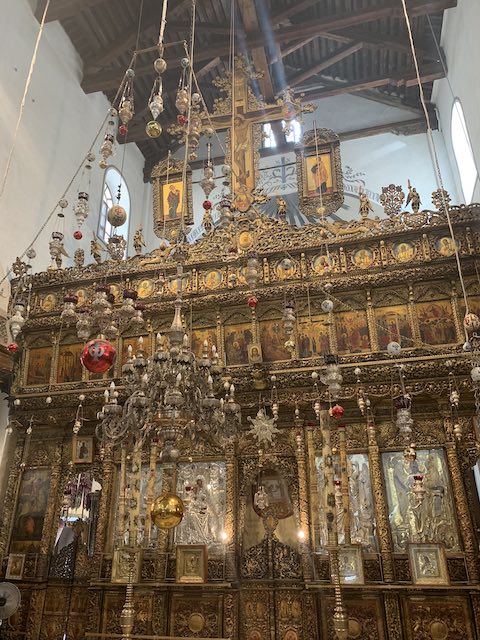
If you want to see the place where Jesus was born, you should head to the Church of the Nativity in Bethlehem. THE CHURCH OF THE NATIVITY in Bethlehem was built over the grotto where the Virgin Mary gave birth to Jesus. To enter the church the visitors need to go through small and narrow doors and bow themselves in the respect of the place where God humbled Himself and became a human. Small steps in the church lead down to the GROTTO OF NATIVITY.
The church is run by 3 Christian denominations: the Greek Orthodox, Armenian Orthodox, and Catholic Churches. The biggest part of the church is run by the Greek Orthodox Church and smaller parts by the Armenian Orthodox Church and the Catholic Church. Thus, Christmas in the Church of Nativity is celebrated in line with the Julian Calendar on 7 January, not on 25 December. UNESCO listed Bethlehems Church of the Nativity as a World Heritage Site.
Opening hours of the Church of the Nativity in Bethlehem: 6:30 am – 7:30 pm (Apr-Sept), 5:30 am – 5 pm (Oct-Mar); the Grotto is closed on Sundays
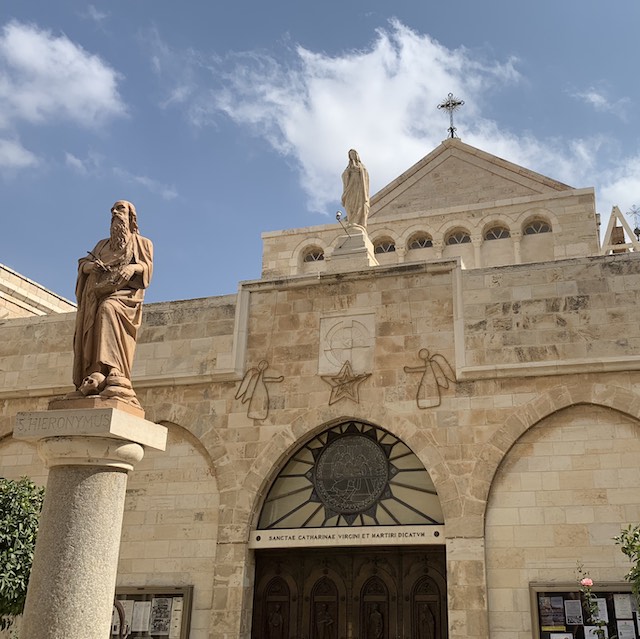
The Church of St Catherine is a Catholic church adjacent to the Nativity Church in Bethlehem. St. Catherine of Alexandria was an advocate of Christianity who was beheaded by Emperor Maximian for her faith in the 4th century. On 25 December the Christmas Mass is celebrated and broadcast worldwide from the Church of St Catherine, not from the Nativity Church.
Opening times: 6 am-7:30 pm (Apr-Sep), 5:30 am-5 pm (Oct-Mar)
YOU MIGHT ALSO LIKE TO READ: Climbing Mount Sinai in Egypt
The Milk Grotto in Bethlehem is a sacred place for Muslims and Christians.
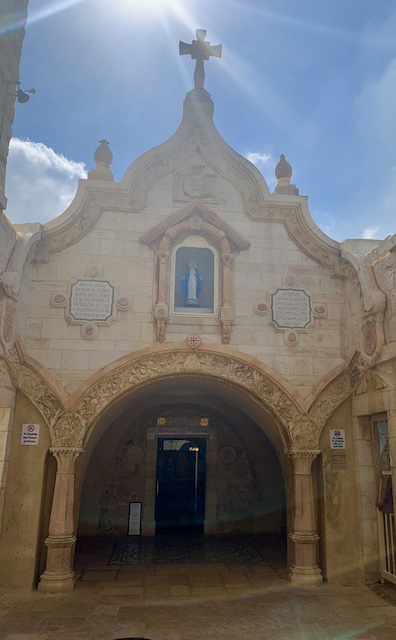
According to the legend, Mary and Joseph stopped in the cave, above which now a chapel stands while running away from the Roman soldiers to Egypt. While nursing baby Jesus, a drop of Mary’s milk dropped down onto the stone which became white.
This is a Christian pilgrimage site for women who want to conceive.
Opening hours: 8 am-5 pm (Sun closed from 1 pm-2 pm)
Plan your trip to Bethlehem Book your stay at The Walled Off Hotel (mid-range) Dar Sitti Aziza (luxury) Or join a day tour to Bethlehem from Jerusalem or Tel Aviv Bethlehem and Jerusalem Day Biblical Tour from Tel Aviv (Viator) or Day Tour to Jerusalem and Bethlehem from Tel Aviv (Viator; the most popular) Bethlehem Half-Day Tour from Jerusalem (Get Your Guide) or Bethlehem and Jerusalem Day Trip from Tel Aviv (Get Your Guide; the most popular)
The Tomb of Rachel is the burial site of Rachel, who was the wife of patriarch Jacob and who died while giving birth to son Benjamin.
The Tomb of Rachel is a Jewish, Christian, and Muslim pilgrim site. Biblical Rachel was childless for many years but eventually gave birth to her sons Joseph and Benjamin. Sadly, she died while giving birth to the latter. Therefore, the Tomb of Rachel is a pilgrimage site on the West Bank, especially for women who want to conceive.
The tomb of Rachel is in the north of Bethlehem, on the road Jerusalem-Bethlehem. It can be accessed only from the Jerusalem side.
3. Holy Sites in Nazareth
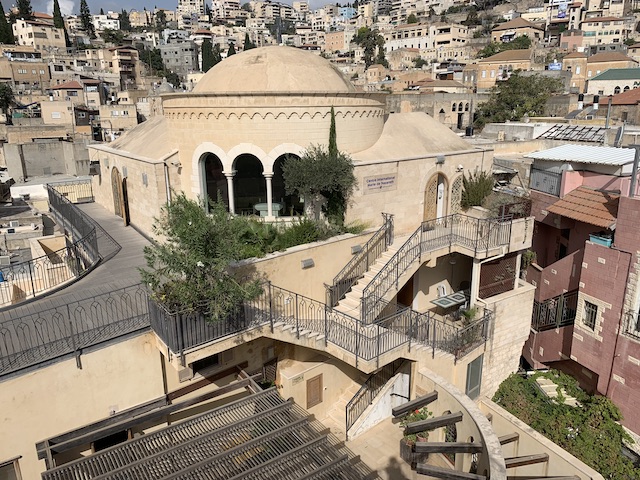
Nazareth is one of the most important Biblical places in Israel and religious places in Israel. Nazareth is a Christian pilgrim city where the Holy Family (Mary, Joseph, and Jesus) lived after coming back from Egypt.
There are several Christian holy sites in Nazareth and thus, several popular holy sites in Israel.
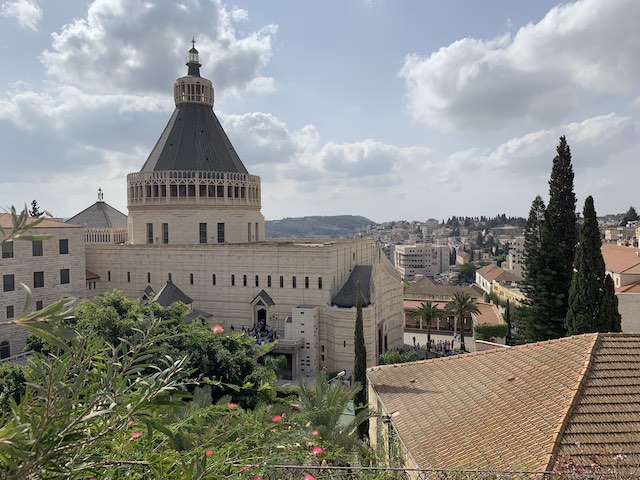
The Basilica of the Annunciation is made over the cave which is believed to be once the home of the Virgin Mary and the place where the angel Gabriel appeared to announce her giving birth to Jesus. It is one of the most important sacred places in Christianity.
The Basilica of the Annunciation in Nazareth is the largest Christian church in the Middle East.
Opening times: 8 am-6 pm
Next to the Basilica of the Annunciation stands the Church of St Joseph which is a sacred place in Christianity. The Church was built over a cave which is believed to be the carpentry workshop of St Joseph.
Opening hours of St Joseph Church in Nazareth: 8 am-6 pm
East of the St Joseph Church in Nazareth you can find another holy place of Christians – the Synagogue Church. The Synagogue Church in Nazareth is a Melkite Greek Catholic church. Melkite is a Greek word for the carpenter.
Opening hours of the Synagogue Church in Nazareth: 8 am-5 pm (Apr-Sep), 8 am-4 pm (Oct-Mar); Sun closed
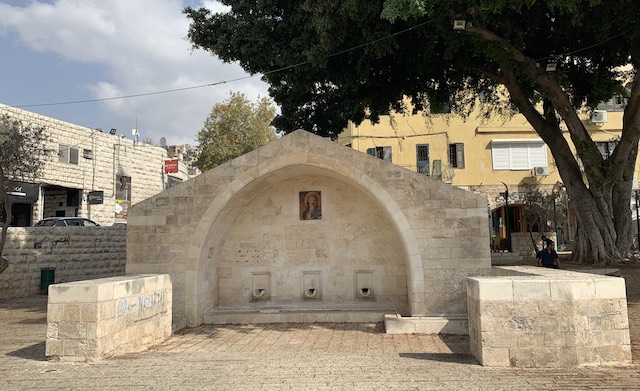
The Mary’s Well is actually a public fountain and is believed to be an ancient well fed by Mary’s Spring. The Mary’s Well is close to the Orthodox Church of St Gabriel with an altar under which Mary’s Spring flows. Orthodox Christians believe that Angel Gabriel appeared to the Virgin Mary at the place where today is St Gabriel Church, not the Basilica of Annunciation. Opening hours of St Gabriel Greek Orthodox church in Nazareth: 8 am-12 pm, 1 pm-5 pm
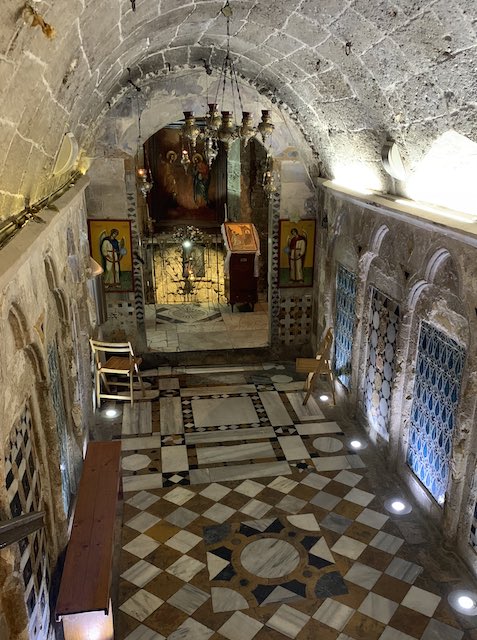
Plan your trip to Nazareth Book your stay at: Michel House (mid-range) Al Bishara Guest House (luxury) Or, take a day tour to Bethlehem from Tel Aviv or Jerusalem Nazareth, Tiberias, and the Sea of Galilee Day Trip from Tel Aviv (Viator) Nazareth, Tiberias & Sea of Galilee Day Trip from Tel Aviv (Get Your Guide) Nazareth, Tiberias and the Sea of Galilee Day Trip from Jerusalem (Viator) Nazareth, Tiberias & Sea of Galilee Day Trip from Jerusalem (Get Your Guide)
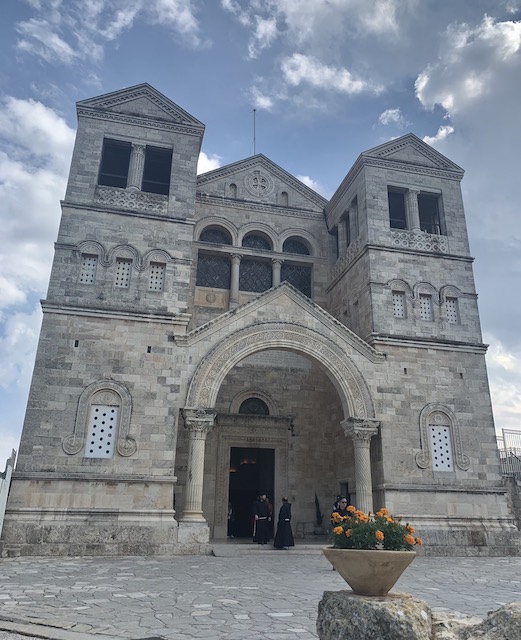
7 km east of Nazareth, there is a Christan religious site on Mount Tabor in Galilee which is believed to be the place of Jesus’ transfiguration.
Mount Tabor is a special holy place in Israel where the connection between humanity and the divine is visible in the sublime nature of Mount Tabor best experienced by hiking the mount. The elegant Church of the Transfiguration stands on Mount Tabor since the beginning of the 20th century. The church was designed by Italian architect Antonio Barluzzi who also designed, among others, the church on the Mount of Beatitudes and the Church of All Nations in the Gethsemane Garden.
Opening hours of the Church of the Transfiguration on Mount Tabor: 8 am-12 pm, 2 pm-5 pm
4. Holy sites in Hebron
Ancient Hebron was one of the holiest cities of the Holy Land.
Hebron is a holy city of Judaism, Christianity, and Islam. The holy city of Hebron is the 5th holiest city in Islam, the 2nd holiest city in Judaism, and a holy city in Christianity.
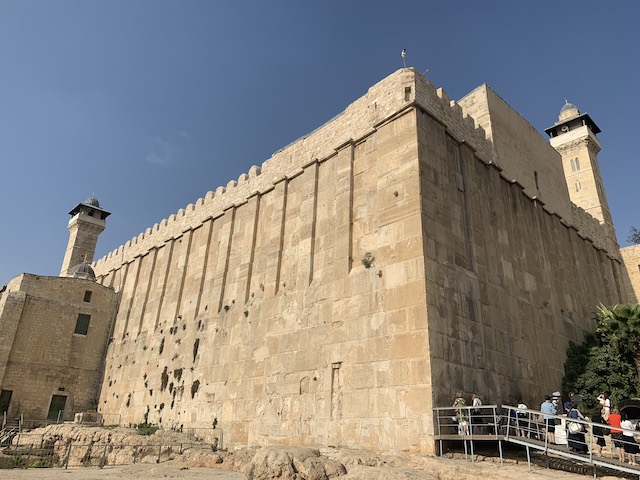
The Tombs of the Patriarchs and Matriarchs in Hebron is a sacred site to all Abrahamic faiths: Judaism, Christianity, and Islam.
It is the burial site of three prophets and their wives – three biblical couples: Abraham and Sarah, Isaac and Rebeckah, and Jacob and Leah. Abraham bought this property with the Cave of Machpelah – Cave of the Double Tombs about 2,000 BC as the burial place for his wife Sarah and himself.
It is also called the Sanctuary of Abraham or Ibrahimi Mosque by Muslims. The Tombs of the Patriarchs in Hebron is the 2nd holiest site in Judaism, after the Western Wall. It is also a sacred site for Christians. To Muslims who refer Abraham to be a prophet of God, the Cave of Machpelah is the fourth holiest site in the World. This over 2000-year-old complex with the tombs of the prophets looks like a walled fortress. Herod the Great built the complex with an open roof to the sky. The complex is divided into 3 sections. Each section holds the cenotaphs of a prophet and a wife. Actual graves are in the caves beneath the cenotaphs.
The complex today is divided into two sides: a Muslim side with a mosque and a Jewish side with a synagogue. The mosque holds the cenotaphs of Abraham and Sarah, and Isaac and Rebekah. The synagogue holds the cenotaphs of Jacob and Leah, although all cenotaphs can be seen from each side through small openings.
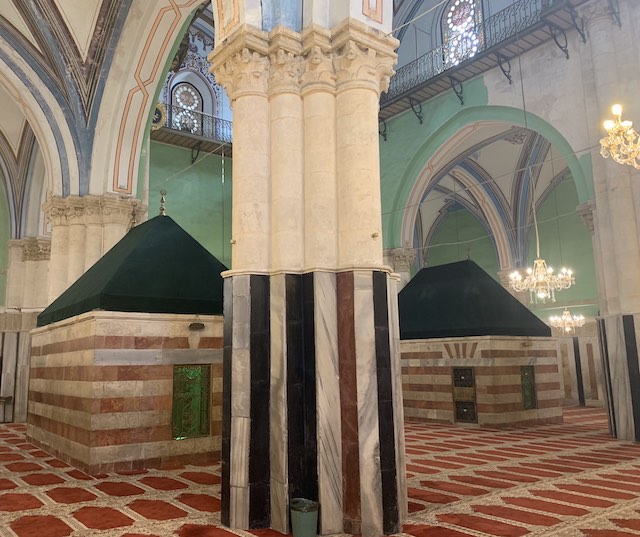
Jewish people are not allowed to enter the mosque side while Muslims are not allowed to access the synagogue side, except on a mutually agreed few days a year.
As a Christian, I was allowed to enter both sides. And although I hadn’t initially planned to visit Hebron in my Israel and the West Bank itinerary , Hebron became one of the highlights of my trip. I came to the Tomb of the Patrichas and Matriarchs compound just before the afternoon prayers started. I visited the mosque part first, and then the synagogue part. I stood in the compound listening to the simultaneous prayers of a rabbi and an imman. They were praying to God, the God of Abraham and Sarah, Isaac and Rebekah, and their descendants (all of us!).
2017 UNESCO declared Hebron and the Tombs of the Patriarchs a World Heritage Site . Opening hours of the Tombs of the Patriarchs in Hebron: 7:30 am-11:30 am, 1 pm-2:30 pm, 3:30 pm-5 pm (Muslim side closed on Fri, Jewish side closed on Sat)
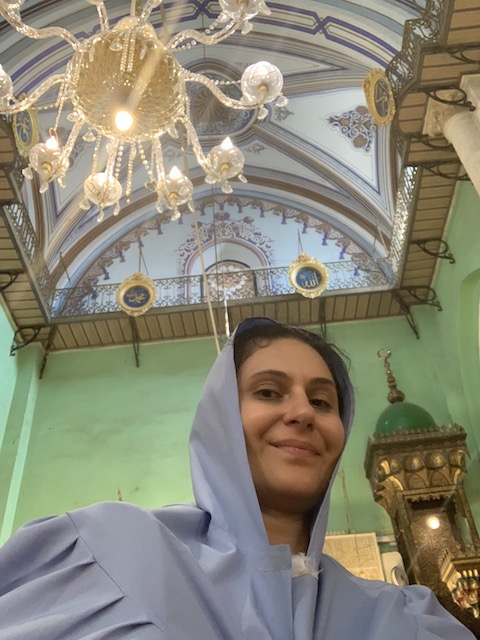
Plan your trip to Hebron Take a day tour to Hebron from Jerusalem: Hebron Day Tour From Jerusalem
5. Holy sites in the Sea of Galilee
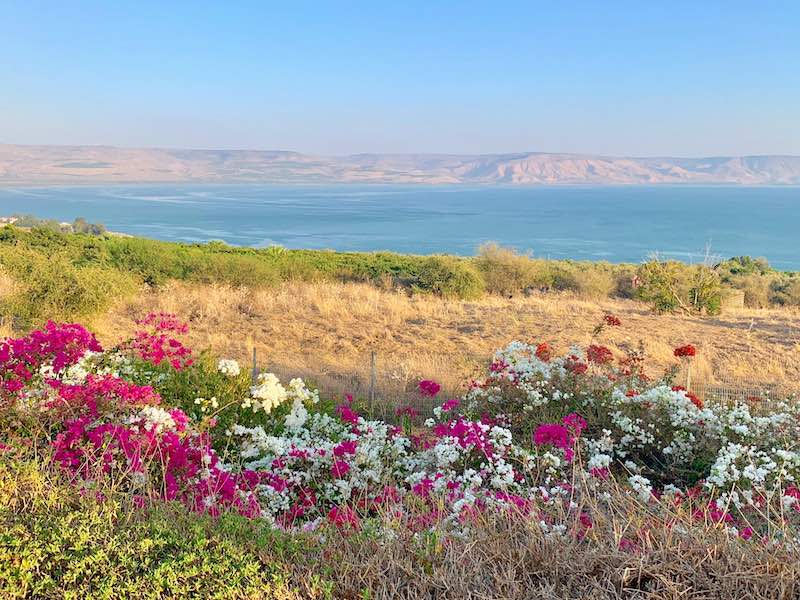
The Sea of Galilee is an important Christian site where according to the Holy Bible Jesus calmed the water and asked Peter, James, John, and Andrew to follow Him.
Lake Kinneret is the Biblical site where Jesus walked on the water. So please head to the Sea of Galilee, if you are after the Biblical place where the ‘ Jesus walking on water ‘ story took place.
The Sea of Galilee area holds an impressive number of Biblical sites in Israel, religious sites in Israel, and popular holy sites in Israel. But, Tiberias on the Sea of Galilee is also one of the main holy cities of Judaism as well.
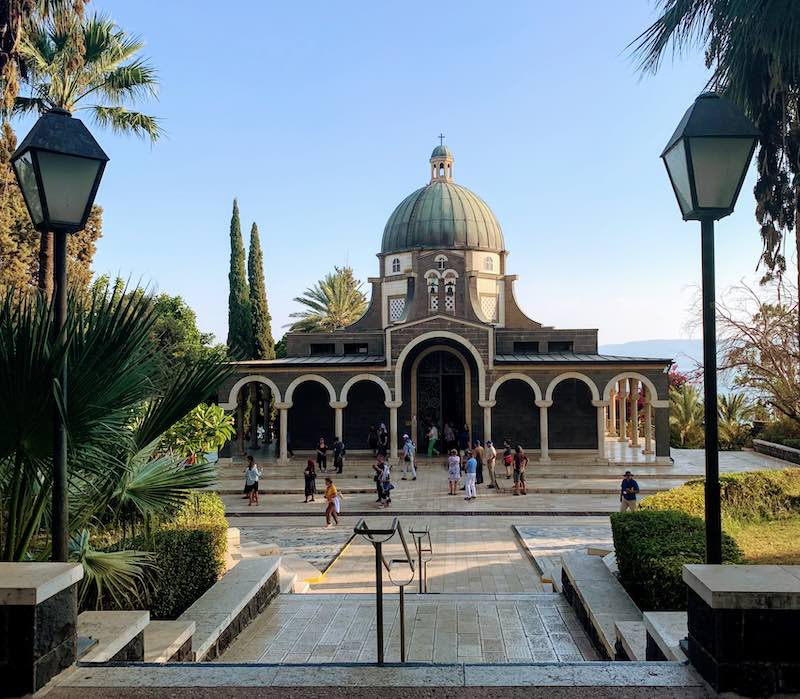
The Mount of Beatitudes is a hill on the northwestern part of the Sea Galilee where Jesus is believed to have taught the Seron of the Mount, including the Beatitudes. Today a Roman Catholic church stands at the top of the Mount of Beatitudes.
Opening hours of the Church of the Mount of Beatitudes: 8:30 am-12 pm, 2:30 pm-5 pm (2:30 pm-4 pm winter)
Tabgha stands at the foot of the Mount of Beatitudes and is only 3 km southwest of Capernaum.
It is a Christian sacred site. It is believed to be the Biblical place where Jesus made the Miracle of the Multiplication – where Jesus fed 5,000 people with 5 loaves of bread and 2 fish. Thus, Tabgha on the Sea of Galilee is Christianity’s holy site.
Opening hours of the Tabgha: 8 am-5 pm (Mon Fri), 8 am-4 pm (Sat), Sun closed
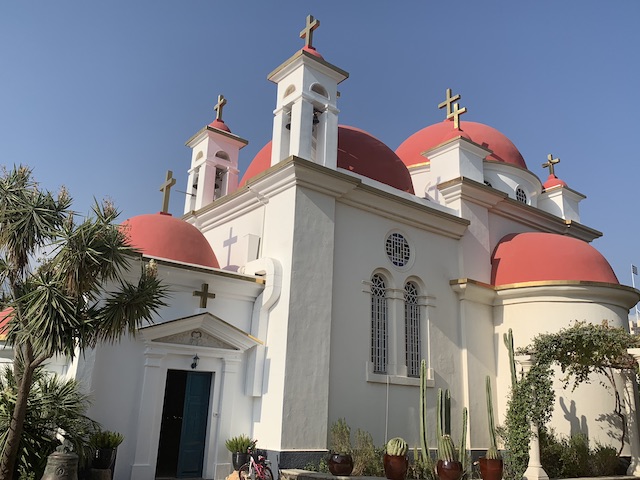
Capernaum is the hometown of Jesus’ miracles and the hometown of His first apostles: the fishermen Peter, Andrew, James, and John, and the tax collector Mathew. Therefore, Capernaum on the shore of the Sea of Galilee is one of the most popular holy sites in Israel. Today beautiful Greek Orthodox Church of the Holy Apostles stands on the shore of the Sea of Galilee in ancient Capernaum. Opening hours of the Church of the Holy Apostles: 10 am-4:30 pm (summer), 10 am-5:30 pm (winter)
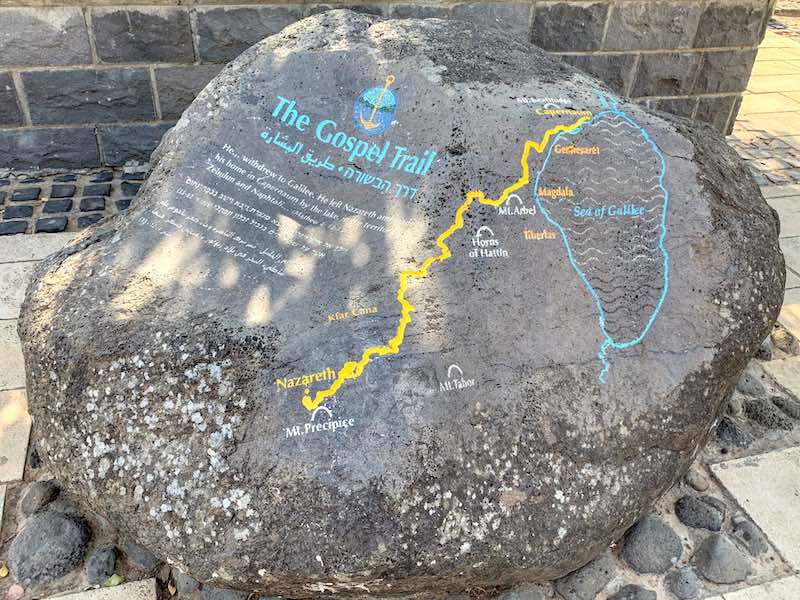
What about walking with Jesus in Israel?! Jesus Trail is a 65 km long pilgrim route in Galilee following the footsteps of Jesus Christ. The Jesus trail covers several of Christian’s sacred places and popular holy sites in Israel . The Jesus Trail route starts in Nazareth and goes through Cana, the Sea of Galilee, Capernaum, Tabgha, and the Mount of Beatitudes. The Jesus trial lasts 4 days. If you wish to trek several historical sites in Israel where Jesus walked and to follow Jesus’ walks, this trail is for you.
Plan your trip to Tiberias Book your stay in Tiberias: click here to get the best rates for your stay in Tiberias .
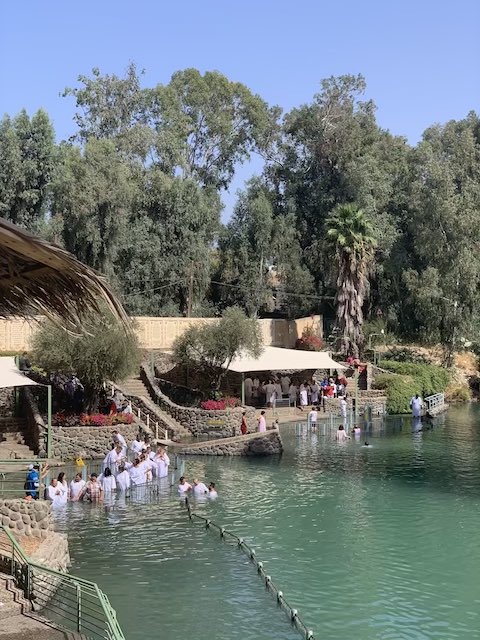
This is the place where Jesus was baptized by St John the Baptist on the western bank of the River Jordan in the Palestinian territories. In fact, the original site of the baptism of Jesus is just across this site, on the east side of the river Jordan in Jordan . The original site of Jesus’ baptism in Jordan is called Al-Maghtas. Qasr El-Yahud is a Christian, Muslim, and Jewish sacred site on the West Bank. Jewish people believe that this is the site where Israelites crossed the river Jordan and where Elijah the Prophet ascended to Heaven. That’s why this site is on the list of Judaism’s sacred places too. Opening hours of Qasr El Yahud: 8 am-4 pm (Sat-Tue), 8 am-3 pm (Fri, holidays)
Plan your visit to Jesus’ baptism site Take a day tour to Jesus’ baptism site from Tel Aviv or Jerusalem: Jordan River, Nazareth & Sea of Galilee from Tel Aviv (Get Your Guide) Bethlehem, Jericho & Jordan River – Small Group Tour from Jerusalem (Viator)
6. Holy sites in Haifa
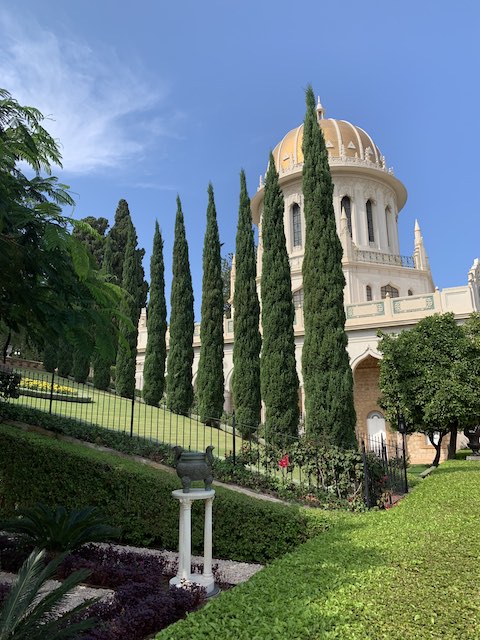
Haifa is the third-largest city in Israel with some exquisite sacred places for Christianity, Islam, and the Bahai Faith.
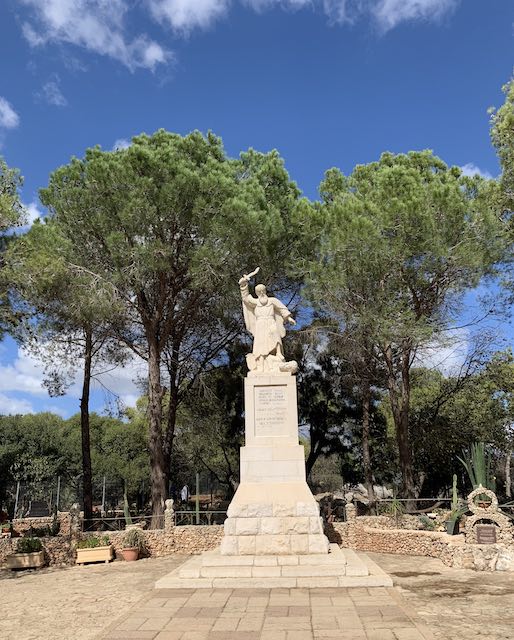
The Muhraka (the Horn of Carmel ) monastery is a Carmelite monastery on the top of the Carmel mount in Haifa and the place where the prophet Elijah lived and fought the prophets of Baal.
Elijah, meaning ‘Yahweh is my God’ is a famed prophet and an important prophet for Jews, Christians, Muslims, and Druze.
Mount Carmel means ‘the God’s vineyard’.
The Muhraka monastery on Mount Carmel near Haifa is a sacred place for Jews, Christians, and Muslims and one of the most popular holy sites in Israel. A Catholic religious order called the Carmelite Order was founded here more than 800 years ago.
The views over the Jezreel Valley from the monastery are nothing less than spectacular.
Opening hours of the Muhraka Monastery: Mon-Sat 8 am – 12 pm, 2:20 pm-4:30 pm (Sep-Apr), Mon-Sat 8 am-12 pm, 2:20 pm-5 pm (May -Aug), Sun closed
The Stella Maris Monastery, or in Latin ‘the Star of the Sea’ referring to the Virgin Mary, in Haifa is the world’s headquarters of the Carmelite Catholic religious order.
The Elijah Cave stands just below the Stella Maris monastery on the foothill of Mount Carmel in Haifa. It is believed to be the cave where the prophet Elijah mediated before defeating the prophets of Baal. Elijah was God’s messenger and a famous prophet for Jews, Christians, Muslims, and Druze. Therefore, the Elijah cave is one of the most sacred sites in Israel and a religious place for Jews, Christians, Muslims, and Druze.
Opening hours of the Stella Maris Monastery in Haifa: 6:30 am-12.30 pm, 3 pm-6 pm
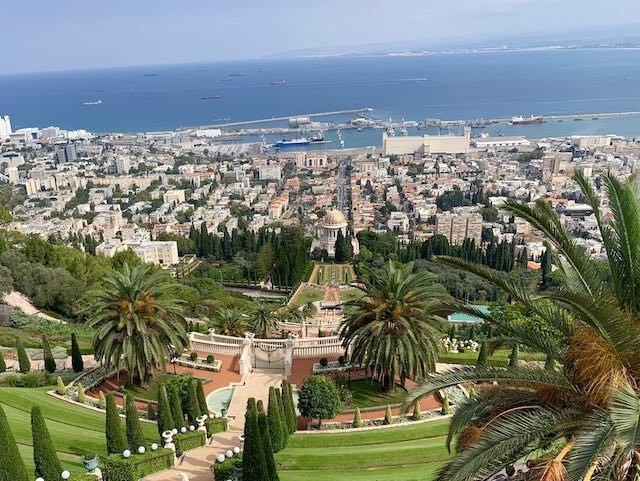
The Shrine of the Bab in Haifa is a mausoleum and the burial site of the Bab, the forerunner and the prophet of the Bahai Faith.
This is the second holiest place of the Bahai Faith, after the Shrine of Baha-Ullah in Akko. The Shrine of the Bab, Bahais Gardens, and the Shrine of Baha-Ullah are Bahai places of worship. Bab in Arabic means the Gate. The beautiful gardens surrounding the Shrine of the Bab are well-known as the Hanging Gardens of Haifa. The Shrine of the Bab and the Bahai’s Gardens are a UNESCO World Heritage Site in Israel. The Bahai Faith is a monotheistic religion founded in the 19th century in Persia advocating the spiritual unity of humanity and the fundamental oneness of all religions. Bahai believers believe that there is only One God whose messengers were Abraham, Jesus, Buddha, and Muhammad. Bahai’s holy places in Israel are Haifa, Acre (Akko), and Bahji, near Akko.
Opening hours of the Shrine of the Bab: 9 am-12 pm Opening hours of the Hanging Gardens in Haifa: 9 am-5 pm
Plan your trip to Haifa Book your stay at: Port Inn (budget) Templers Boutique Hotel (mid-range) Schumacher Hotel Haifa (luxury) And, take a tour of Haifa Haifa and Acco Private Tour (Viator)
7. Holy sites in Akko
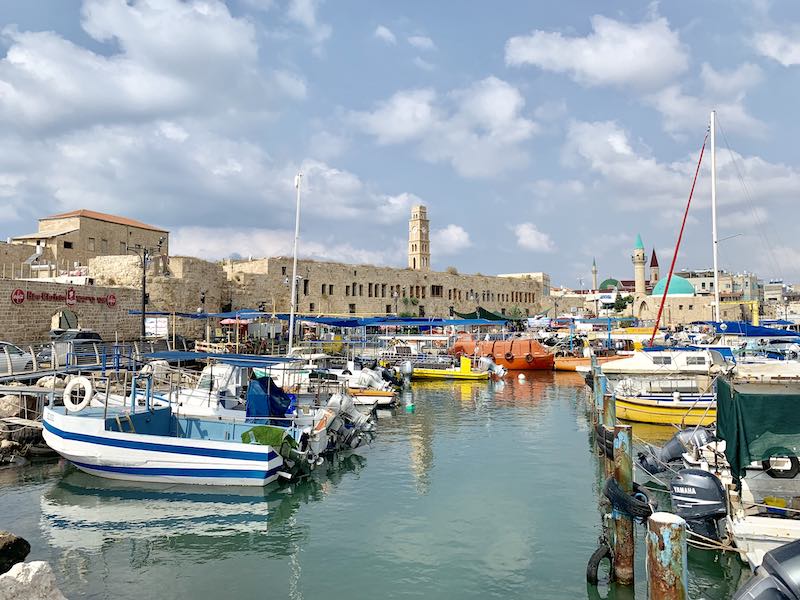
The Old City of Acre (Akko), popularly known as the Crusaders’ town as once it was the home of the Templars, is one of the UNESCO sites in Israel.
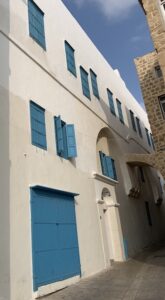
The House of Abbud is a house in the center of the Old City of Akko where the founder of the Bahai Faith lived.
The Bahai Faith was founded by a man called Bahá’u’lláh, meaning the Glory of God. Baha-Ullah was Bab’s main follower. He was expelled from Teheran and lived his last 32 years in Akko. He died and was buried in Akko.
The House of Abbud is recognizable for its white-painted walls and turquoise windows. In this house, Baha-Ullah lived for a few years and composed the principles of the Bahai Faith summarized in the Bahai’s Holy book called Aqdas.
The Bahji mansion with the Shrine of Baha-Ullah is the holiest place for the Bahai Faith.
The Shrine of Baha-Ullah holds the tomb of Baha-Ullah surrounded by beautiful Persian gardens and stands next to the Bahji mansion, which was a summer house in which Baha-Ullah spent his last years of life. The Bahji mansion is located in Bahji at the northern edge of Akko about 1.2 miles (2 km) from the center of Akko.
Opening hours of the Gardens: 9 am-4 pm Opening hours of the Shrine and inner gardens: 9 am-12 pm (Fri, Sat, Sun, Mon)
Plan your trip to Akko Book your stay at: HI – Akko Knights Hostel (mid-range) Zidan Sarai , or The Efendi Hotel Akko (luxury) Take a day tour of Acco: Haifa and Acco Private Tour (Viator)
8. Holy sites in Safed
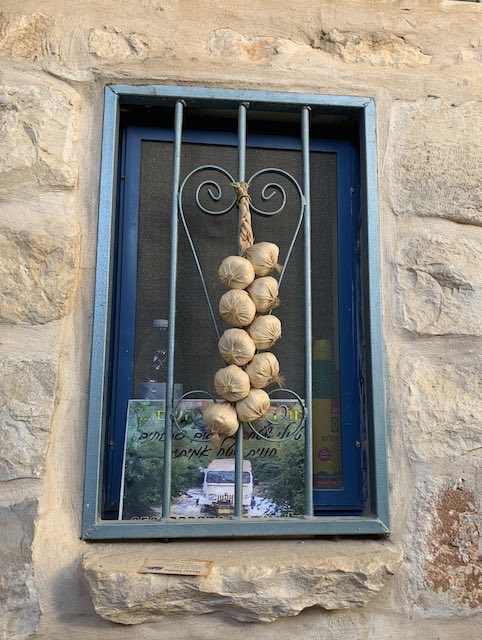
TZFAT or SAFED is the City of Kabbalah and it is one of the four holiest cities for Jews.
Four Jewish holy cities with holy places of Judaism are Jerusalem, Hebron, Tiberias, and Safed. There are four main sacred places of Judaism in Safed:
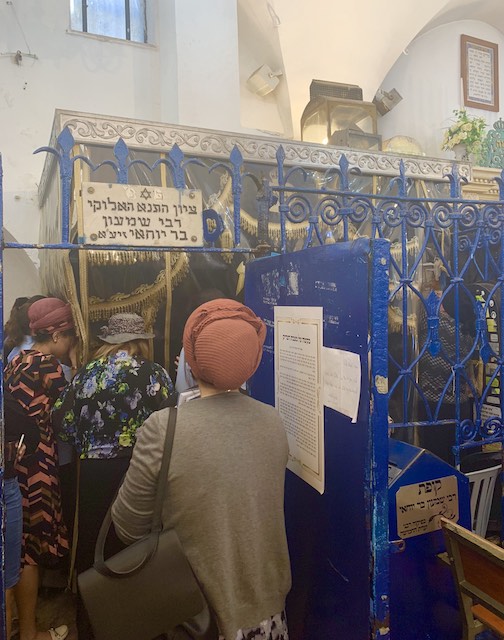
The Tomb of Rabbi Shimon is the burial site of the author of the Book of Zohar (the main textbook of Kabbalah), one of the most important Judaism sacred sites in Israel and a Jewish place of worship.
The tomb is located on Mount Meron 6 miles (10 km) from Safed. Rabbi Shimon lived in the 2nd century and taught mystical Kabbalah which covers the esoteric dimension and the deepest secrets of the Torah.
Opening hours of the Tomb of Rabbi Shimon Bar Yochai: open daily
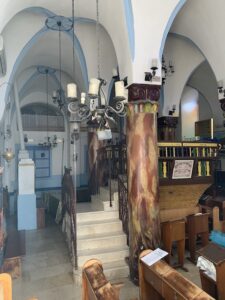
The Ari Ashkenazi Synagogue in Safed is the oldest synagogue still in use in Israel and is a Judaism sacred site. The synagogue was built in the 16th century in memory of Rabbi Ari, a well-known kabbalist who lived in Safed.
Opening hours of Haari Ashkenazi Synagogue in Safed: 11 am-2 pm (winter), 11 am-3:30 pm (summer), Sat closed
The Sephardic Synagogue of the Ari is the oldest synagogue in Safed. The synagogue was called ‘Elijah the Prophet’ but over time got renamed after Rabbi Ari who came to Safed in the 16th century to share his knowledge of Kabbalah.
Opening hours of Sephardic Haari Synagogue in Safed: 11 am-2 pm (winter), 11 am-3:30 pm (summer), Sat closed
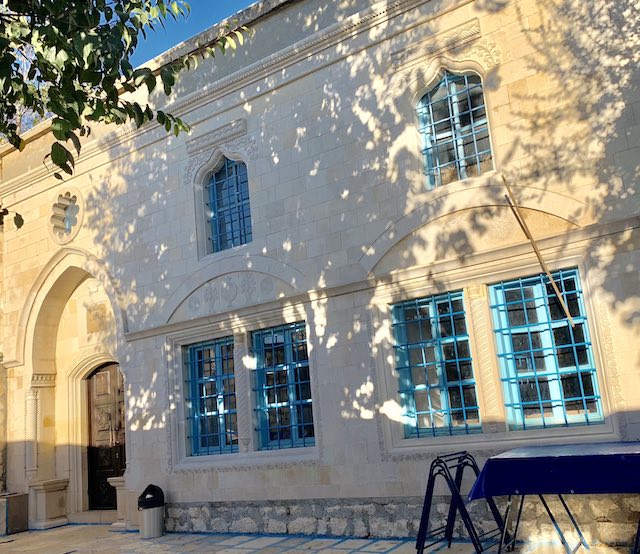
According to some beliefs, the Abuhav Synagogue was miraculously transported from Spain to Safed. The Abuhav Synagogue was named after a 15th-century famous rabbi and kabbalist Abuhav.
Opening hours of the Abuhav Haari Synagogue in Safed: 11 am-2 pm (winter), 11 am-3:30 pm (summer), Sat closed
If you are planning a trip to Israel and wish to see all or some of these religious places in Israel, I suggest checking out my 10 day Israel itinerary .
I have created this Holy Land map to help you see the exact location of the popular holy sites in Israel and the West Bank. You can download the map via Google Maps and save the map on your phone or tablet. The Holy Land Map will be available to you offline on your phone or tablet. Once you are in Israel you can easily find the holy sites navigating by this map.
Map of holy sites in Israel and the West Bank for your Holy Land Pilgrimage
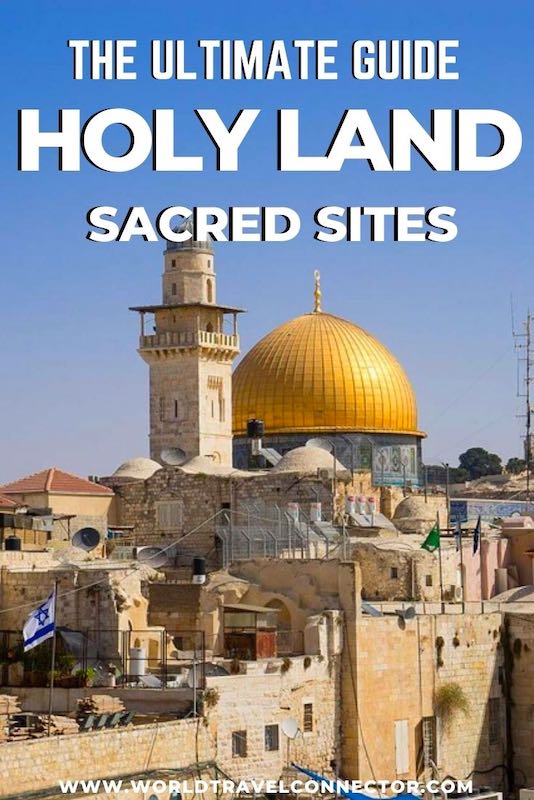
Why is Jerusalem a holy city ?
Jerusalem is a holy city of 3 major monotheistic religions: Judaism, Christianity, and Islam. Jerusalem is the holiest city of Judaism, the holiest city of Christianity, and one of the 3 major Islamic holy cities (along with Mecca and Medina).
Why is Jerusalem important ?
Jerusalem is called the holiest city in the world. Jerusalem is important to all Abrahamic faiths: Judaism, Islam, and Christianity. Jerusalem holds the Temple Mount which is considered to be the holiest place in Jerusalem. The Temple Mount is the holiest site in Judaism where once the First Temple (or the Great Temple of Jerusalem) built by King Solomon stood. The temple held the Ark of the Convent with the Ten Commandments. But, for Muslims, the Temple Mount is Haram Al-Sharif (or the Noble Sanctuary), the site where Prophet Muhammed ascended to Heaven from the Earth on a winged horse during his Night Journey. The Church of the Holy Sepulchre in Jerusalem is the holiest Christian site in the world since it is the site where Jesus was crucified, buried, and resurrected.
The Temple Mount in Jerusalem is the holiest site in Judaism where once the First Temple (or the Great Temple of Jerusalem) built by King Solomon stood . The temple held the Ark of the Convent with the Ten Commandments .
The Temple Mount is believed to be the place of the Biblical Mount Moriah with a sacred rock on which Abraham planned to sacrifice his son Isaac to God. The Temple Mountain is the holiest site in Judaism holding the Foundation Stone where Earth was created. The Wailing Wall , (or the Western Wall, Kotel HaMa’aravi in Hebrew), is the last remaining wall of the Temple Mount where once the ancient Solomon’s Temple of Jerusalem and the Holy of Holies – the Gate to Haven stood. The Holy of the Holies is the most sacred site in Judaism.
Why is Jerusalem important to Christians ?
The Church of the Holy Sepulchre in Jerusalem is the most important and the holiest Christian site in the World where Jesus was crucified, buried, and resurrected . The Church of the Holy Sepulchre in Jerusalem holds the Stone of Anointing (also called the Stone of Unction ), the Golgotha Hill (also called the Calvary , or the Place of the Skull ) where Jesus was crucified, the Aedicule Chapel (the Mausoleum) with the Tomb of Jesus and the Angel Stone (the stone door which was used to close the tomb of Jesus). For that, the Church of the Holy Sepulchre in Jerusalem is the holiest site in Christianity.
Why is Jerusalem important to Muslims ?
The Temple Mount in Jerusalem is also called Haram Al-Sharif (or the Noble Sanctuary ) by Muslims. Haram Al-Sharif in Jerusalem is the site where Prophet Muhammed ascended to Heaven from the Earth on a winged horse during his Night Journey. Haram Al-Sharif in Jerusalem is the 3rd holiest place in Islam, after Masjid al-Haram in Mecca and al-Masjid an-Nabawi in Medina. On that account, major Islamic holy cities are Mecca, Medina, and Jerusalem.
A History of God: The 4,000-Year Quest of Judaism, Christianity, and Islam
Then and Now Bible Maps
Jesus: A Pilgrimage
Come and See: A Catholic Guide to the Holy Land
Israel Biblical Sites Travel Guide
The Holy Land for Christian Travelers: An Illustrated Guide to Israel
YOU MIGHT ALSO ENJOY
- Hiking Masada in Sunrise
- Climbing Mount Sinai in Egypt
- Best Day Trips from Tel Aviv
- Buddhist Temples in Southeast Asia
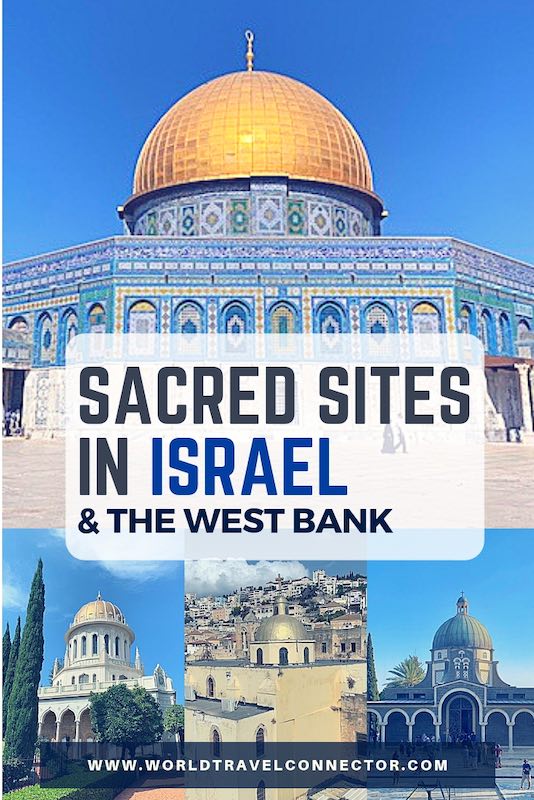
- Recent Posts
- Top 15 Best Things to Do in Rome, Italy - March 4, 2024
- 2 days in Rome itinerary: Top Things to Do in Rome in 2 Days - February 23, 2024
- Rome in a Day Itinerary: How To Spend One Day in Rome - February 12, 2024
Thursday 20th of December 2018
Amazing experience Milijana, this journey to Holy Sites is so enriching. Hope to do it some time.
Carmen Edelson
Friday 16th of November 2018
There is so much to see and do in Jerusalem that it can be overwhelming. I'm glad I went with a tour group but I'd like to go again on my own.I'll certainly use this guide when I do, thank you!
There are some truly beautiful sights here. It's always amazing to remember how much the major religions of the world share, despite the differences that seemingly drive them apart. I would love to make a visit here one day to learn more about all of the faiths. This is a great compilation and description of the sights. Reading thru them, I was especially intrigued by the Mount of Beatitudes and the Bahai Gardens and would especially like to visit those.
Erica Edwards
Thursday 15th of November 2018
Fantastic post, I learnt so much reading it! I'm so fascinated by this part of the world and have yet to explore it for myself, though I'm hoping to remedy that within the next two years. It's hard for me to even begin to grasp the very depth of history that must hide around every corner there. Excellent descriptions and thanks for putting so much detail into this post.
Bernie Jackson
That's such a comprehensive and beautifully pictured guide. I had not seen much of Capernaum before, and the beauty of the Greek Orthodox church there is incredible.
I was interested to see that Hebron became the highlight of your visit, and wondered what prompted that. There is clearly an immense amount of information to see and absorb in a visit like yours. I can imagine it would take a long time to sink in and be digested after your trip.
Search the Learning Center
Why do people travel to israel .
People from all around the world travel to Israel because it’s shocking how much it has to offer, despite its small size! You should visit Israel, because it is a treasure trove for history buffs, people of faith, nature lovers, fans of politics, technology geeks, sports enthusiasts, linguistic experts… and more!
Israel stretches from deserts to seas, from high mountains to rivers and forests. The high-tech world of Tel Aviv startups is less than an hour away from Biblical sites in Jerusalem. You can learn about the Middle East from locals or go for some beauty treatments by the Dead Sea.
You want to spend the whole day praying? No problem. Maybe you’d prefer to rest by hot springs or on a boat – easy! You’d rather go fine dining and shopping? Israel has you covered. And above all, Israel is where the Bible comes to life!
Should I travel to Israel if I’m a Christian?
Without a doubt! Every Christian should visit Israel at least once in their lifetime. (Fair warning: many get hooked already after their first visit and keep coming back whenever they can.)
Israel is where most of the Biblical events took place. You can follow in Jesus’ footsteps when you visit Bethlehem, Nazareth, the Galilee, and Jerusalem. But think bigger! This is the land God promised to Abraham, where Elijah called fire from the sky, Deborah led an army in battle, and where David killed Goliath.
As a Christian, you should visit this land to see your Bible in full color, but also to learn who the people of Israel are today.
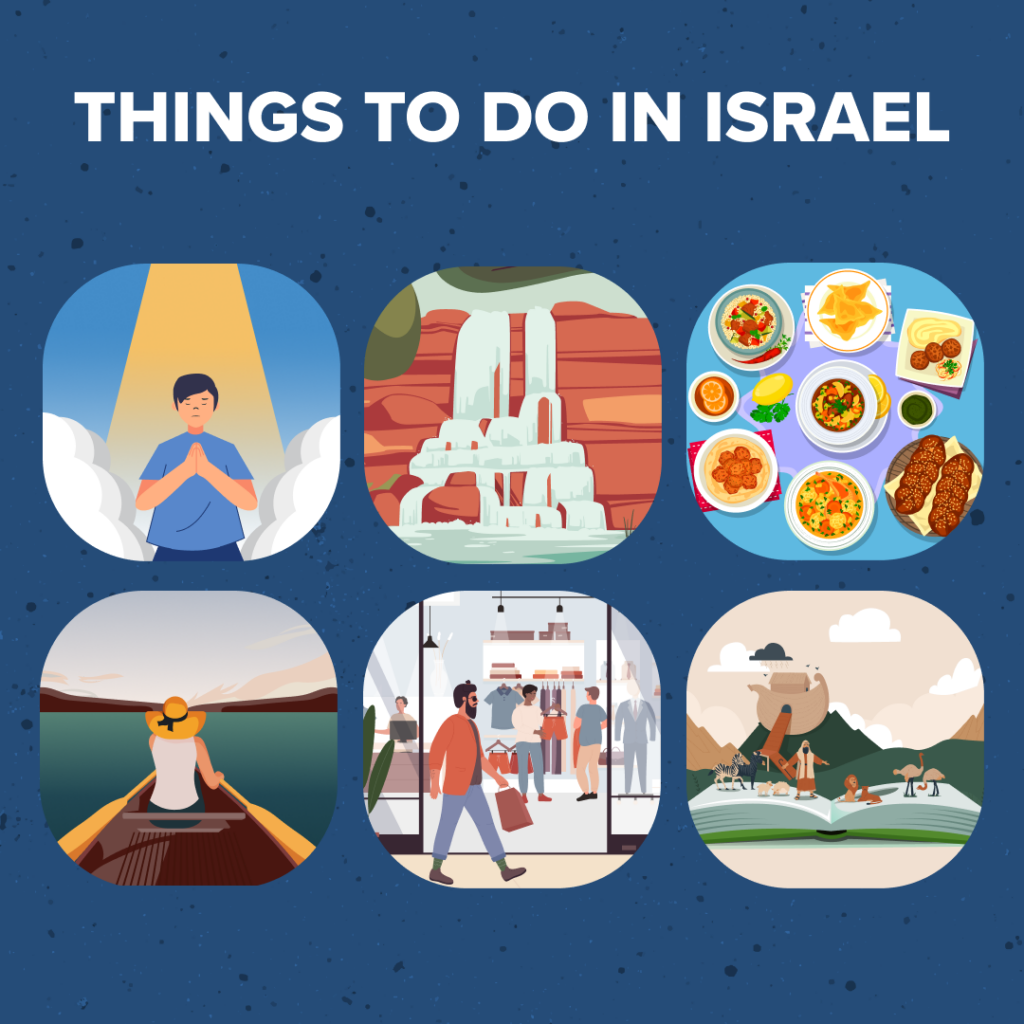
Is it safe to travel to Israel?
We want to simply say, “yes, it is safe” and leave it at that. But I’m guessing you probably want a longer explanation .
The reason you are asking is likely because of something you heard on the news. And yes, while it is a fact that dangerous things happen in Israel sometimes, it is also a fact that it is more dangerous to walk around Atlanta, GA or Dallas, TX than it is to walk around Jerusalem.
Hearing an emergency siren can be a stressful experience (still, not very likely if you are not by the Gaza border) but consider this: most of FIRM staff live and work in Jerusalem. We raise our children here. We host big tours and attend congregations.
Our daily lives could be categorized as very normal. And we would love to welcome you into our neighborhood!
Is Israel a country?
Why yes, thank you for asking! Israel regained her independence in 1948 and we’ve been celebrating it ever since! Israel is a part of the United Nations, has its own currency, government, and diplomatic relations.
And why do I say the independence was “regained”? That is because Israel today is the same nation (speaking the same language, worshiping the same God, and with the same capital) as the Israel of the Bible.
Sure, many things have changed over time, but Israel today still calls Abraham, Isaac, and Jacob their fathers.
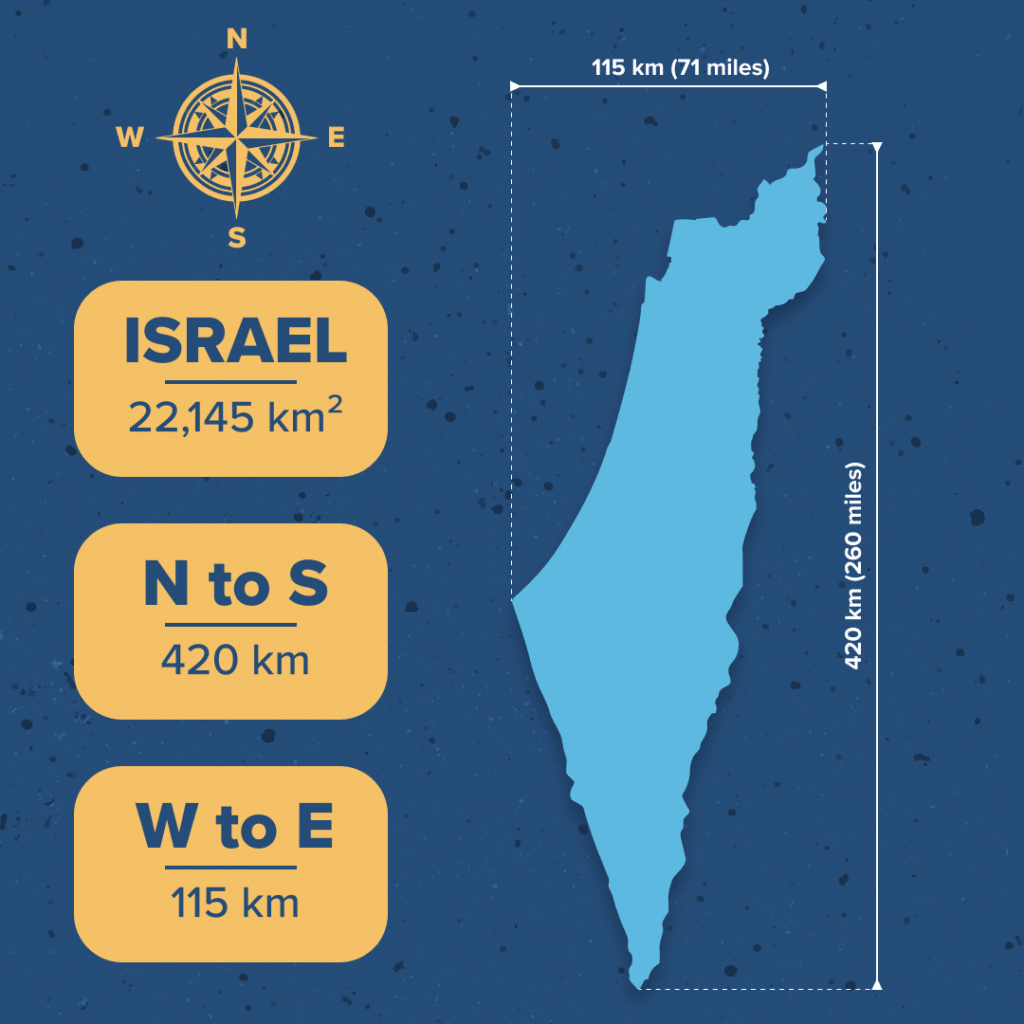
Where is Israel, what continent is it on? (Is Israel in Europe or Asia?)
Israel’s location is incredibly unique. You could almost call it an intersection of West Asia, the Middle East, Africa, and Europe. But which continent does it actually belong to?
I get it, following the European song contest called Eurovision could get you confused. Not to mention the numerous sporting events of Europe that often include Israel. But truth be told, Israel is located in the Middle East , which is part of Asia.
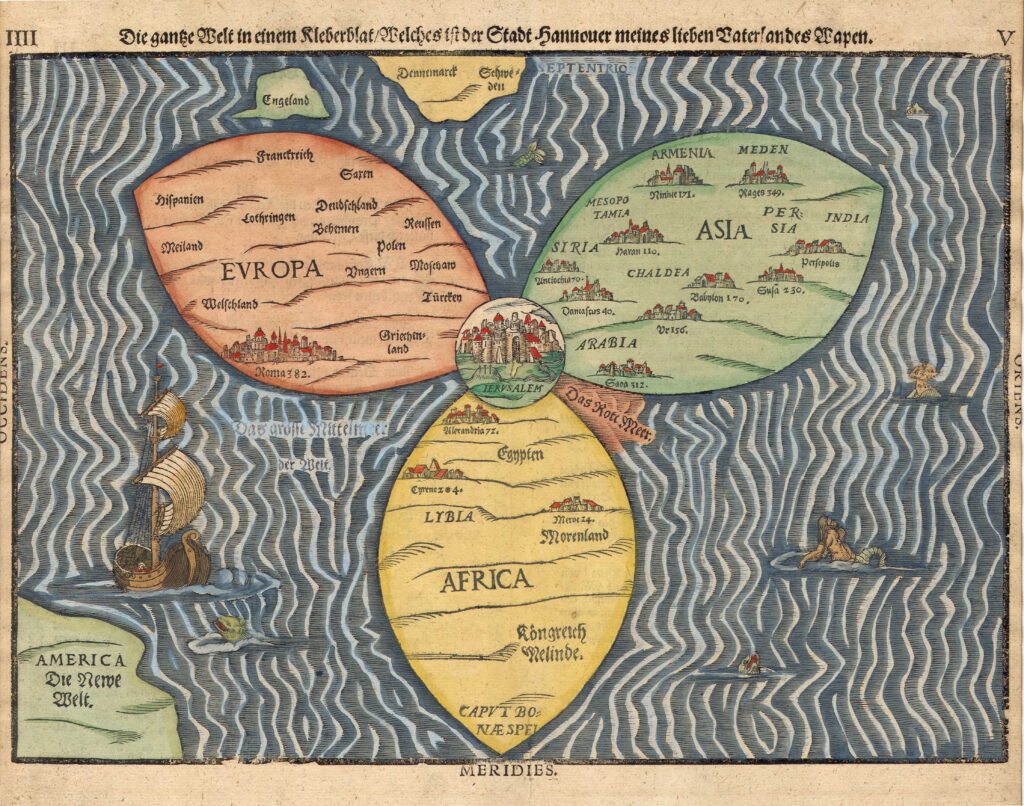
How big is Israel?
Today’s Israel is about the size of the state of New Jersey (North America), or Slovenia (Europe), or El Salvador (Latin America), or Djibouti (Africa). Since Israel is in Asia, we could skip the Asian comparison, but if you insist – it’s about half the size of Taiwan.
If you love numbers: Israel is 22,145 sq. km (8,630 sq. miles). It is about 420 km (260 miles) “long”, north to south, and only 115 km (71 miles) at the widest point east to west.
So, good news! This means you could hit all the major landmarks in just a week-long tour, if that’s all the time you’ve got.
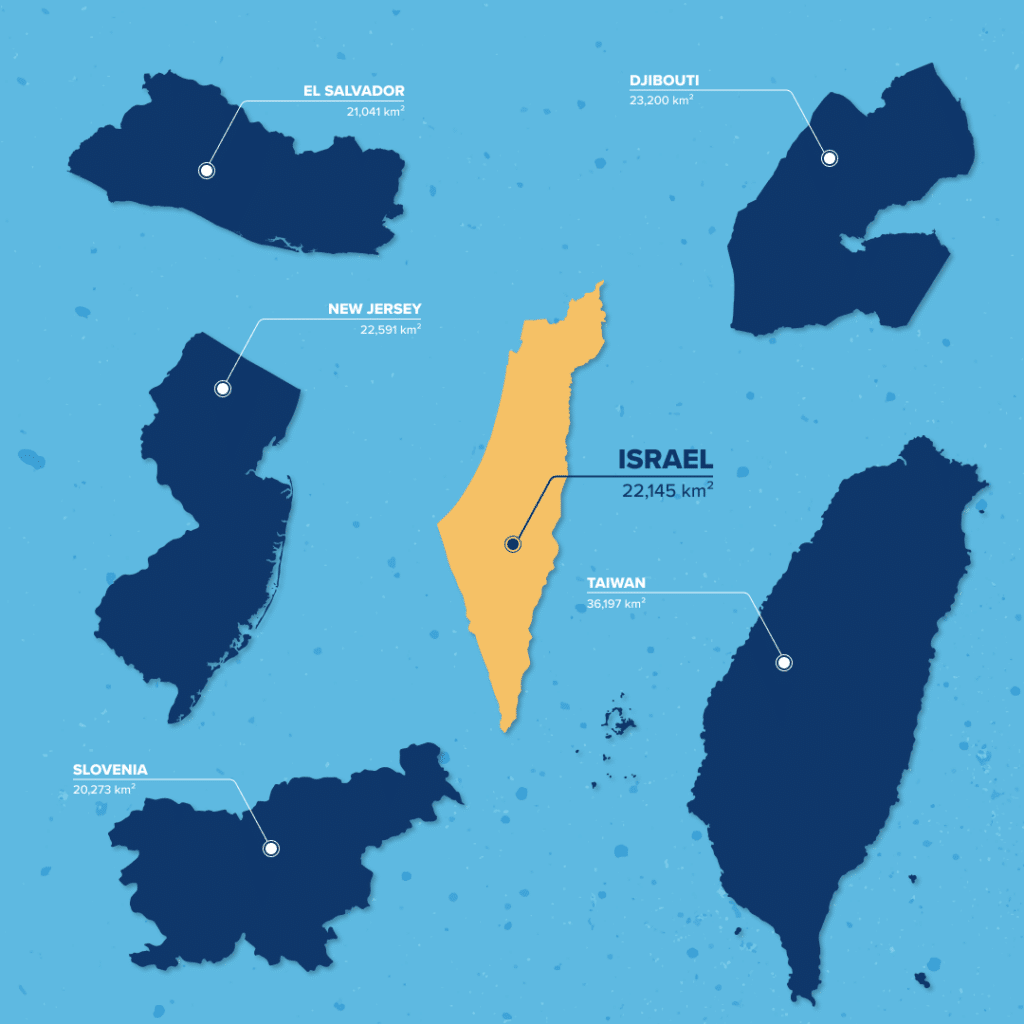
What time is it in Israel?
Right now, at the time of answering these questions? It’s almost noon. But I’m sure that’s not what you meant. Here’s a fun fact: Israel has its own time zone name (Israel Standard Time / Israel Daylight Time).
Israel is 2 hours ahead of UTC (Universal Time Coordinated), so that’s 2 hours ahead of London, UK (3 hours during daylight savings in summer). This also means it is 6 hours behind Tokyo, 7 hours ahead of New York City, and 10 hours ahead of Los Angeles.
So if it’s 7 a.m. in Los Angeles, 10 a.m. in New York City, 3 p.m. in London, 11 p.m. in Tokyo… It’s 5 p.m. in Israel.
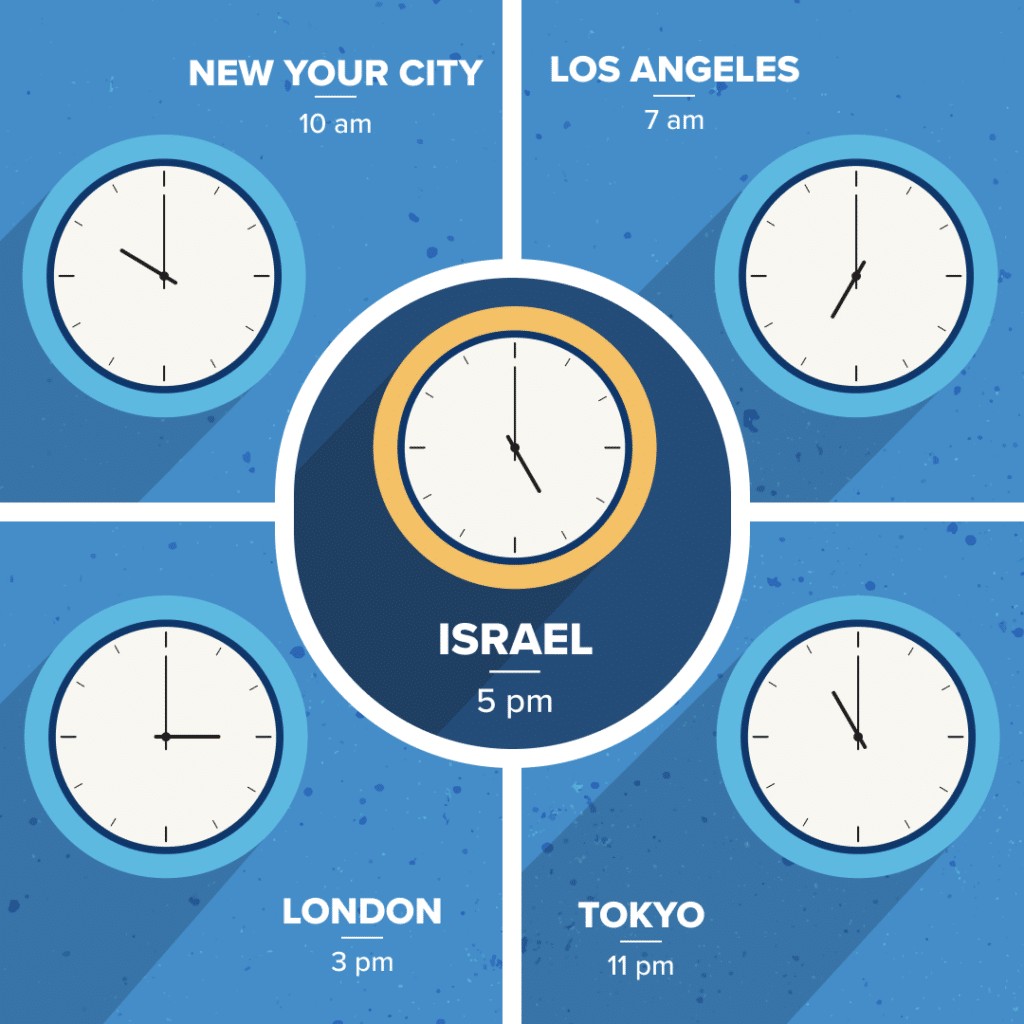
What do I need to travel to Israel?
You definitely need a passport, wherever you’re from. Make sure it is valid for another 6 months after the dates when you plan on traveling. And whether you need a visa – please check official regulations for your country.
USA, Canada, most of the European countries, and the majority of Latin America do not need visas to Israel. But for example, residents of Greenland do, despite the island being part of the Kingdom of Denmark (citizens of which do not need visas for Israel).
A vast majority of African and Asian countries do need visas. Meanwhile, Australia and New Zealand do not. The requirements for residents of the Pacific Islands are mixed, so again, check with your local government.
Bonus: here are some more packing tips for the Holy Land .

Transform lives in Israel through Gospel-centered ministries.
FIRM is your trusted partner for Gospel impact in Israel.
Do you have to be vaccinated?
No, Israel does not require any vaccinations prior to entry.
Is Jerusalem in Israel?
It is indeed! And you know what else? Jerusalem is Israel’s capital ! So when you plan your trip to Israel, make sure you include this extraordinary city on your itinerary!

Is Bethlehem in Israel?
Bethlehem is considered to be a part of the Palestinian Territories – which you can only visit by entering through Israel. So you can definitely plan on touring the Biblical town of Bethlehem when you travel to Israel.
However, please keep in mind that to enter Bethlehem you will have to cross a checkpoint. Plan to save some extra time for this, in case there’s lots of traffic, and don’t forget to bring your passport!
What should I see when traveling to Israel?
Well, that’s a big question! There is so much to do and see! Are you interested in Biblical sites? Recreational activities? Politics? You could build a completely different itinerary around each of these interests.
To get you started, let us introduce you to some noteworthy locations where Jesus walked and spent his days on earth.
What language do people from Israel speak? Do people in Israel also speak English?
Contrary to popular belief, Israel has only one official language, not multiple – and it is Hebrew. Yes, the Jewish people today speak the same Hebrew language the Jewish people in the Bible did (of course, it has been modernized over the years).
The second most used language is Arabic, popular mainly among the Arab and Druze population of Israel. But it is also used by the Jewish families who made Aliyah (immigrated) to Israel from Arabic-speaking countries.
You will be happy to hear that the third most common language in Israel is English (closely followed by the fourth: Russian!). In most places, the people of Israel will know at least some conversational English to help you out in any situation.
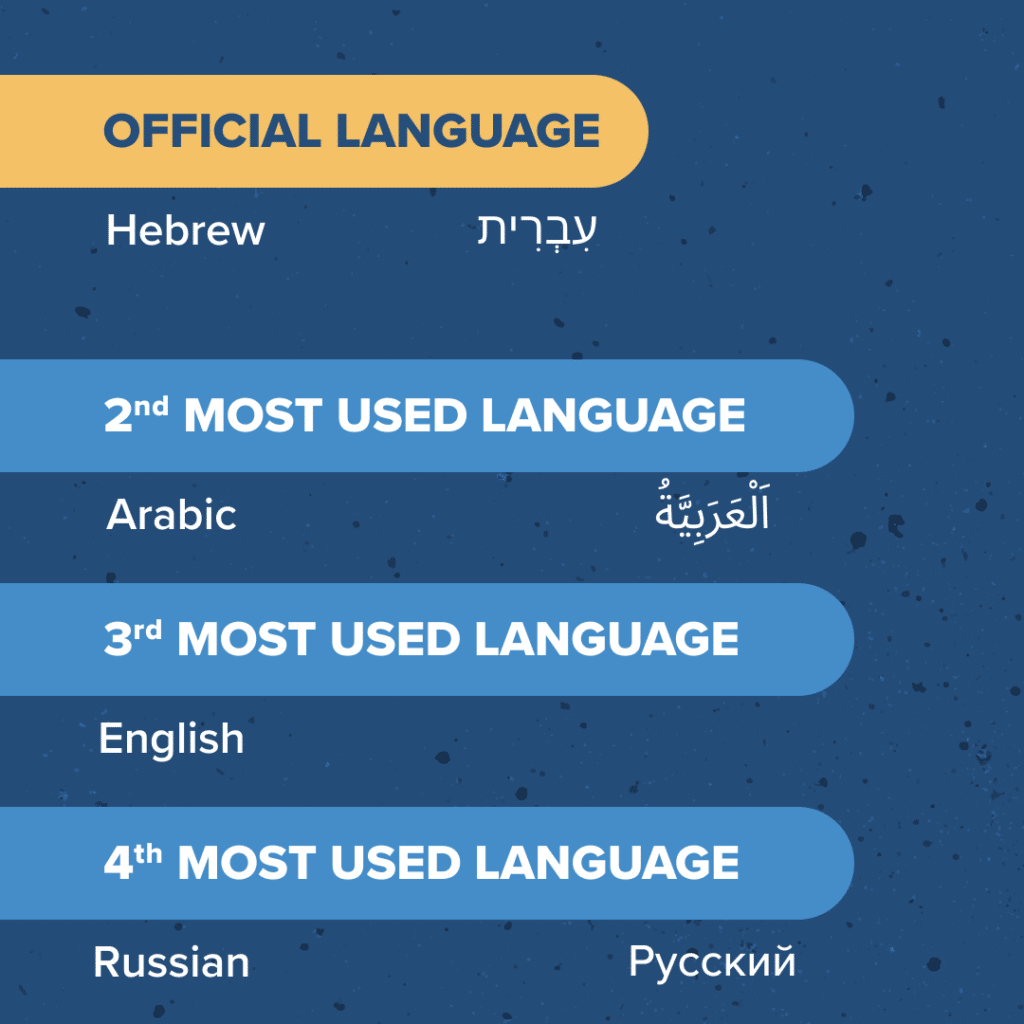
What’s the weather like in Israel?
In short: Israel’s weather is as diverse as her people. Overall, they say you can count on as many as 300 sunny days in a year when you’re in Tel Aviv. That’s a lot! And the temperatures only go up as you move south through the desert and onto Eilat.
However, the temperatures do get lower (and days can get wetter) as you move closer to Jerusalem. Meanwhile, if you head north, it will just get more humid. Unless you drive straight to the Golan Heights – then it may get windy, and in winter snowy! In many ways, Israel feels like a mini California.
You can also read more about the weather and climate in Israel here .

Does it snow in Israel?
Ah yes, I already spoiled the answer to this question in the previous one. YES! It does snow in Israel! In winter, you can actually go skiing on Mount Hermon and you’ll see plenty of kids sledding in the Golan Heights.
But what may surprise you is that it is not uncommon to see snow in Jerusalem , too! It usually doesn’t stick around for more than a few days, nevertheless it’s still a fun and welcomed experience by locals and visitors alike.
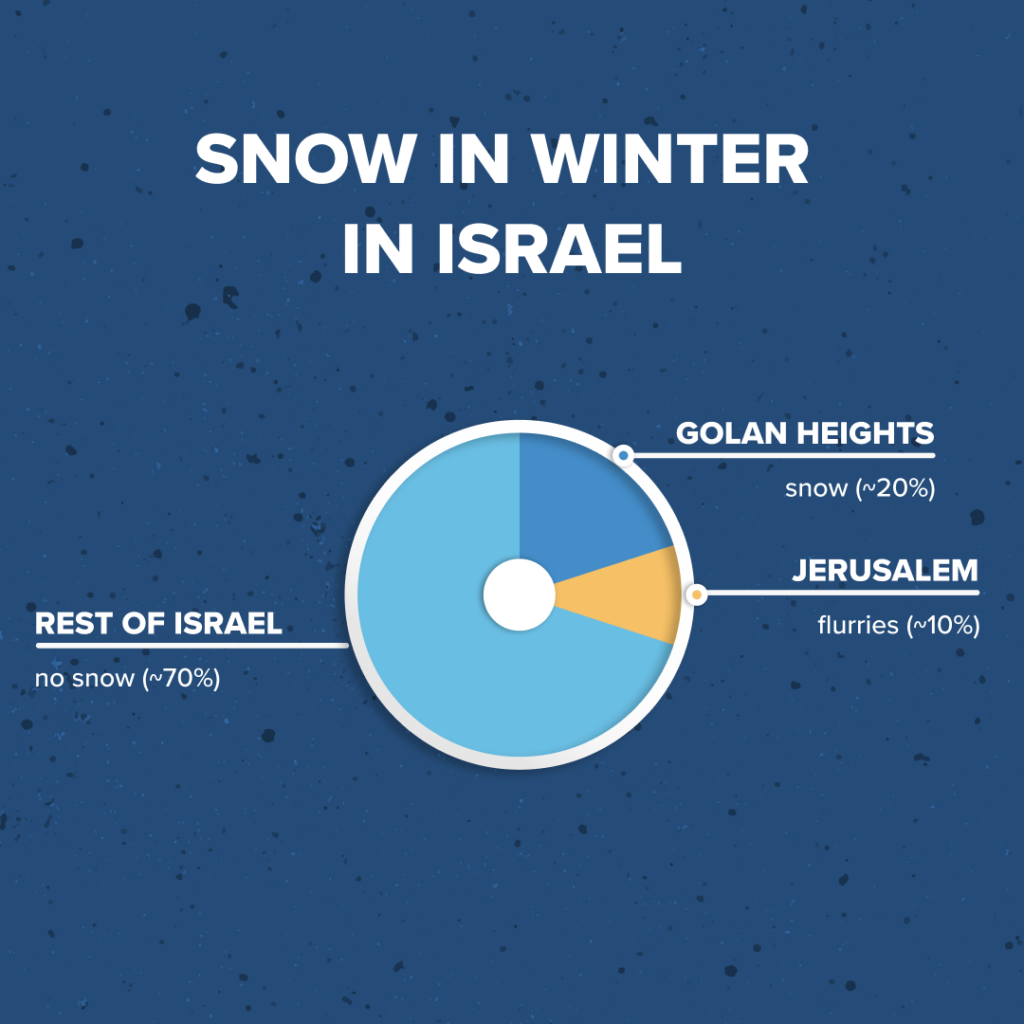
What countries border Israel?
Israel borders Lebanon in the north, Syria in north-east, Jordan in the east, and Egypt in the south. The entire western border of Israel is the Mediterranean Coast.
Fun fact: the most natural (and peaceful) border of Israel is with the Kingdom of Jordan. It runs along the Jordan River , then along the Dead Sea and moves onto the Arava Valley, all the way down to Eilat and the Red Sea.
Can I go visit Jordan and Egypt after traveling to Israel?
Yes, you can!
(Unlike Lebanon and Syria – Israel does not have a border crossing for visitors with these two countries.)
You can of course fly to Jordan and Egypt from Israel . But if you want to cross the border on land, you will have to plan ahead. You need a visa to enter both countries, so it is best if you obtain it while still in your home country.
If you spontaneously decide on a trip while already in Israel, you may have to obtain a visa first in Tel Aviv. Or, if you choose an organized tour from Israel, the guides will likely take care of the visa for you!
For more information about traveling from Israel to Egypt, go here . To travel from Israel to Jordan, go here . Both countries are easiest to visit via the border crossings in Eilat, at the very south of Israel.
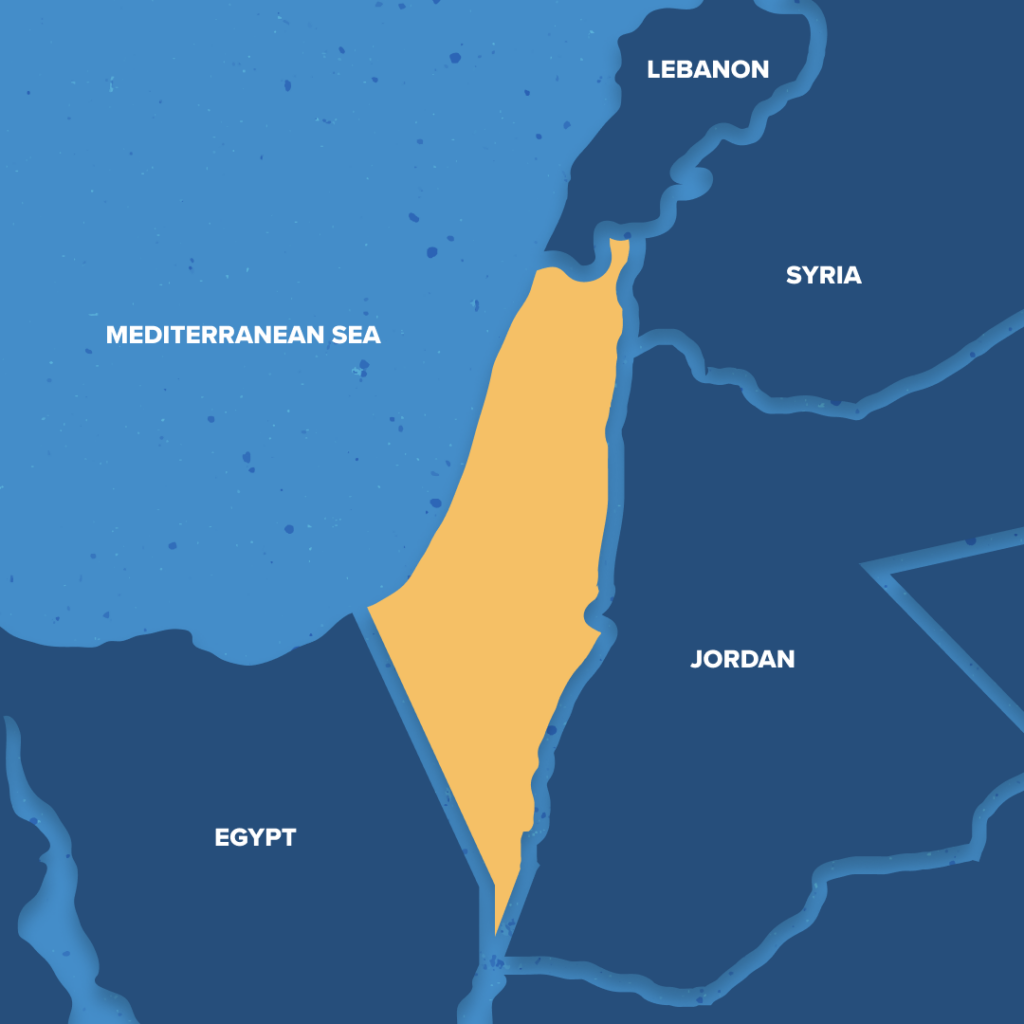
When can I visit Israel? When is a good time to travel to Israel?
Honestly? Any and every month in Israel can be a wonderful experience! You could come tomorrow if you like! Most tourists like to come during milder but sunny weather throughout the country, which is usually from April-June and September-November.
If you want to enjoy hotel pools (or the Mediterranean and Sea of Galilee) every day, go for the summer months. If you prefer cool temperatures, because you want to keep yourself warm by hiking and biking, winter is the right time for you. You want to see the blooming Rose Garden in Jerusalem and the desert turning green? Go in the spring! And how about those changing tree colors and bonfires in the Galilee? Then consider fall.
Another great thing to keep in mind, though, are the Biblical holidays or moedim that affect everyone’s life in Israel, whether they observe them or not.
Pesach (Passover, in the spring) and Sukkot (the Feast of Tabernacles, in the fall) are probably the busiest seasons of the year. If those days are meaningful to you or you just want to see how Israel celebrates, it is worth coming to Israel for the holidays. But if you hate crowds and get impatient with the entire country shutting down for multiple days in a row, skip them.
What is happening in Israel?
Good question! If you want to see our latest updates from the Land of Israel or you’re interested in a local perspective on what’s going on, find us on Facebook , Instagram , YouTube , and TikTok!
What do I need to know about planning my itinerary for travel to Israel?
When people visit Israel for the first time, they tend to pack their itineraries full with fun and interesting activities. Which is great, however please keep in mind that time flows differently in Israel and in the Middle East.
First of all, be aware that on Shabbat (the Sabbath ) and on all religious holidays most places will be closed. That includes restaurants and sometimes even gas stations. The buses don’t run, and taxis are more expensive. On Yom Kippur, the holiest day of the Jewish calendar, even the airport shuts down and many roads are blocked for traffic.
Keep in mind that both Shabbat and the holidays begin at sundown of the previous day. So if you need to get some shopping done for Saturday, make sure you do it early enough on Friday that you won’t get caught knocking on closed doors.
What should I pack for travel to Israel? What to wear in Israel:
This is the beauty of Israel – there are people who made Aliyah (immigrated) to Israel from practically every country in the world. Which means they brought their own traditions, but also styles.
So, on one hand, you could probably wear the same outfits you wear at home and not feel weird about it. However, not all places in Israel were “made equal.” You are probably aware that many in Israel are very religious. Which equals… modesty.
Think not only Orthodox Jews and Muslims… A lot of the Biblical sites (especially New Testament ones) have been preserved and are cared for by churches and monasteries. The rule of the thumb is: cover your knees and shoulders, and definitely no crop tops or see-through clothing.

What do people eat in Israel?
Although it is true that the many immigrants have also brought to Israel their own cuisine, they nevertheless adapted, too. You may wonder, why would they do that? Well, there are at least two big and valid reasons for it.
First, you simply make do with whatever grows and is available in the land you’re in. And second, the Middle Eastern-Mediterranean fusion is simply delicious! The local spices, olive oil, fresh fruit and vegetables… mmm, I hope your mouth is watering.
And good news for picky eaters (whether by choice or due to no fault of their own): Israel has options! Whether you are vegan, lactose intolerant, gluten-free, or the opposite of all of the above – there is a good chance you will enjoy your delicious days in Israel to the fullest!
Did we miss anything? Send your questions to [email protected] , if you want to know more about traveling to Israel!
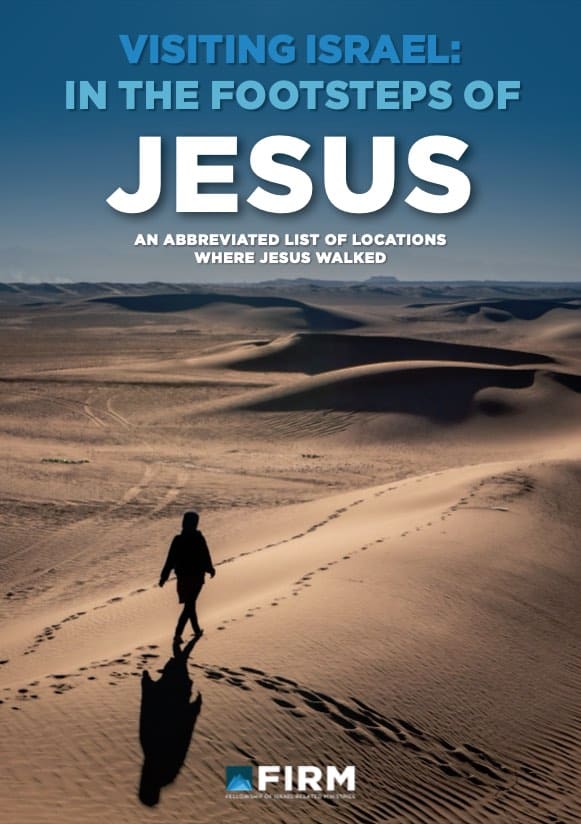
Visiting Israel: In the Footsteps of Jesus: Free PDF Download
It is quite exciting to think that while touring Israel you are walking on the same land that Jesus did.
Whether it is the reason why you came to Israel or not, it is worth noting which locations were significant to His life and ministry. God chose this piece of land to send His Son to live on earth. Many archeological findings confirm the locations mentioned in the Bible.
Articles Related to Travel to Israel and Visiting the Holy Land: 23 FAQs
- Top 7 Reasons You Need to Visit Israel
- Traveling to Israel – But is it safe? Preparing for a Trip
- Crossing the Jordan River and Its Spiritual Significance
- Visiting Israel: In the Footsteps of Jesus
- Jesus Born in Bethlehem – Is the Location Important?
Estimated reading time: 12 minutes
Share this with your friends

Visiting The Holy Land – A List of Holy Land Sites in Israel & Palestine
The modern day state of Israel and the Palestinian territories are home to a great range of Holy sites, known to be part of “The Holy Land”. There are also more sites in Lebanon, Western Jordan southwestern Syria, however most of the sites and those most prominent are located in Israel and in Palestine. Middle Eastern politics aside, this is a fascinating area to explore with so much history to offer, especially for Christians, Jews and Muslims. The birthplace of Jesus is here, as is his childhood town, many biblically referenced sites and so much natural beauty that I just couldn’t fathom all that was happening throughout my one week trip! Here’s a list of Holy Land Sites in Israel & Palestine to help facilitate your visit…
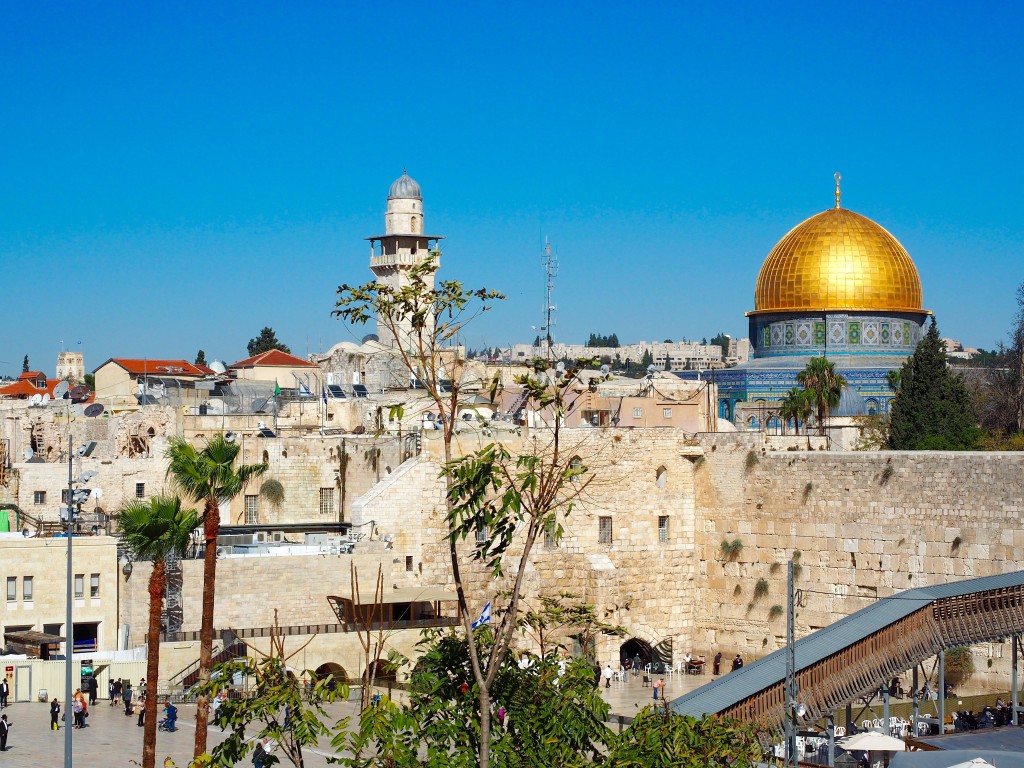
Jerusalem is an incredible place to be and is one of those cities you could never spend enough time, however it is not always safe to visit so be sure to keep yourself updated with current events. For Christians, the most important sites are the Church of the Holy Sepulchre, the Church of St. John the Baptist, and the Church of All Nations. Also be sure to look out for the Mount of Olives (easily in view from Jerusalem old town).
Church of the Holy Sepulchre – Believed to be the site of Jesus’ crucifixion.
Church of St. John the Baptist – This is where Jesus is believed to have said his last prayers before being betrayed by Judas.
Church of All Nations – The birthplace of St. John, known for having baptized Jesus.
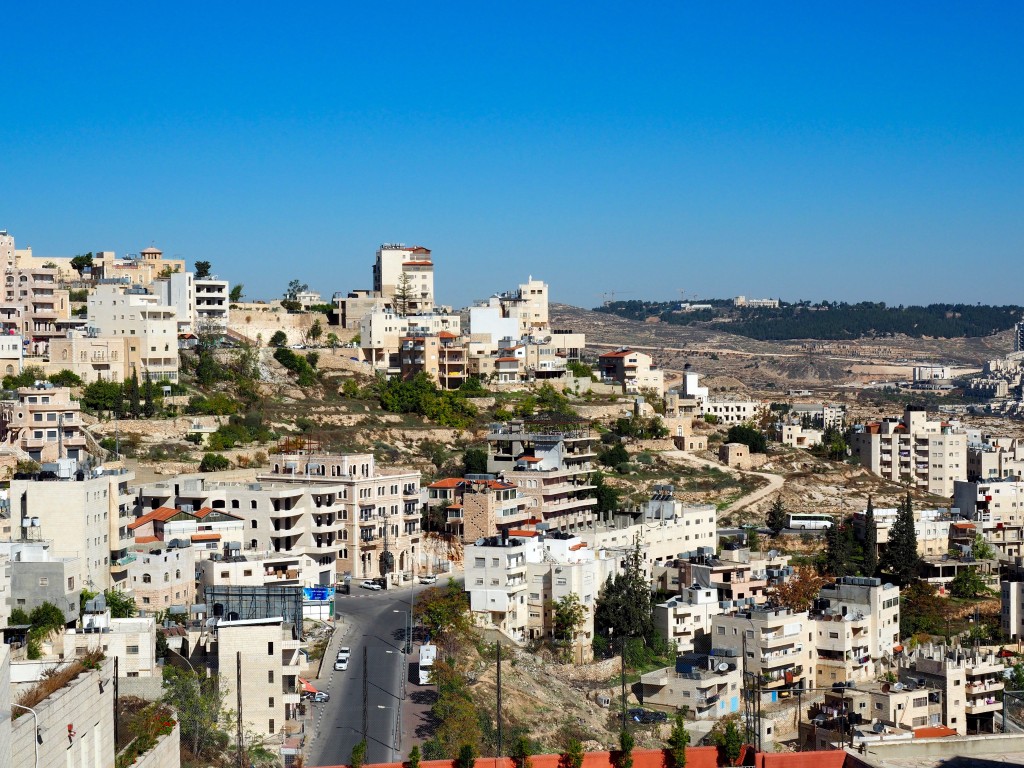
Bethlehem (Palestine)
Bethlehem is perhaps the most important place to visit in the Holy Land, as it is the birthplace of Jesus and home to the Church of Nativity (under which Jesus was born, marked by a 14-pointed star set in the ground). Before visiting, do note that it is easier to visit with a tour group as Israeli Nationals cannot enter Bethlehem given that it is located in Palestinian territories, so there is a check point you will need to cross (bring your passport!)
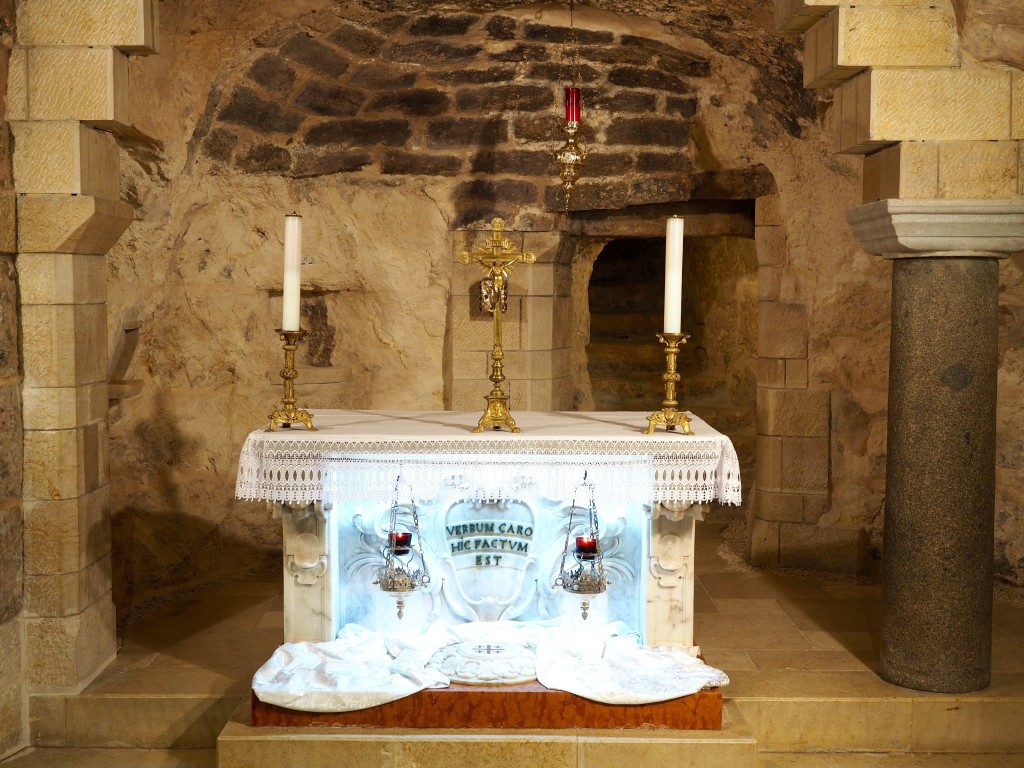
The name, “Jesus of Nazareth” is of course due to the city of Nazareth being where Jesus spent his childhood days, making this another very popular site for Christians visiting Israel. The main attraction in Nazareth is the Basilica of the Annunciation, the largest Christian Church in the Middle East.
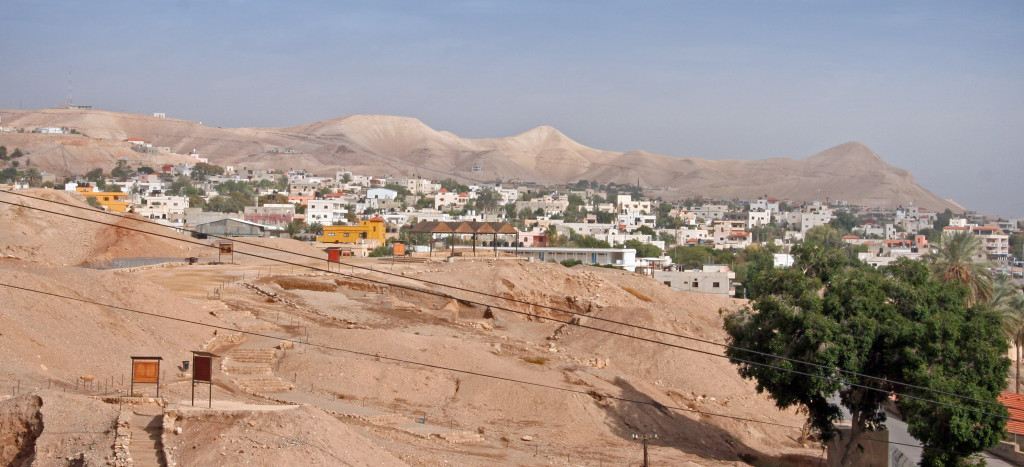
Jericho (Palestine)
Believed to be the world’s oldest city, Jericho is a whopping 10,000 years old and a major tourist destination for visitors to the area. Jericho is renowned for its’ biblical references, such as when Joshua fought Jericho “and the walls came tumbling down!” Remember to bring your passport if planning to visit Jericho, as it is located within Palestinian territories (Image via Tamar Hayardeni ).
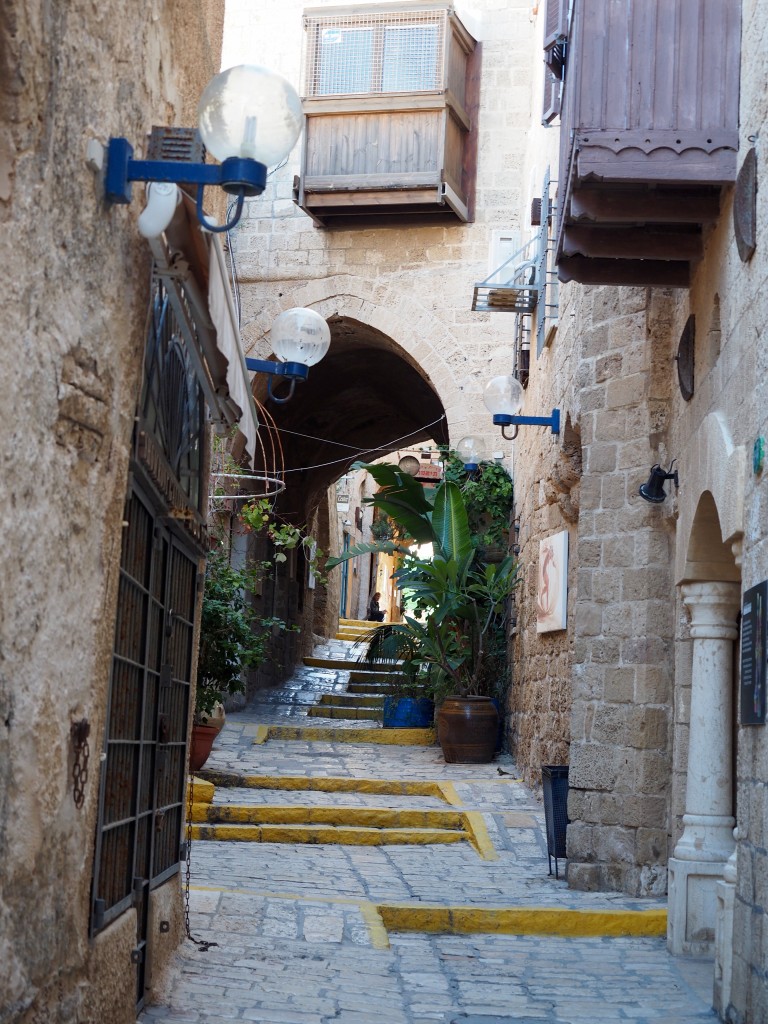
Old Jaffa, Tel Aviv
In modern day Tel Aviv it might be difficult to envision an old historic town like Old Jaffa (also known as Japho or Joppa). This old port town is referenced throughout the bible in stories of Jonah, Solomon and Saint Peter. It is busy and full of life on weekdays or choose to visit on Shabbat (Saturdays) for a deserted Jaffa.
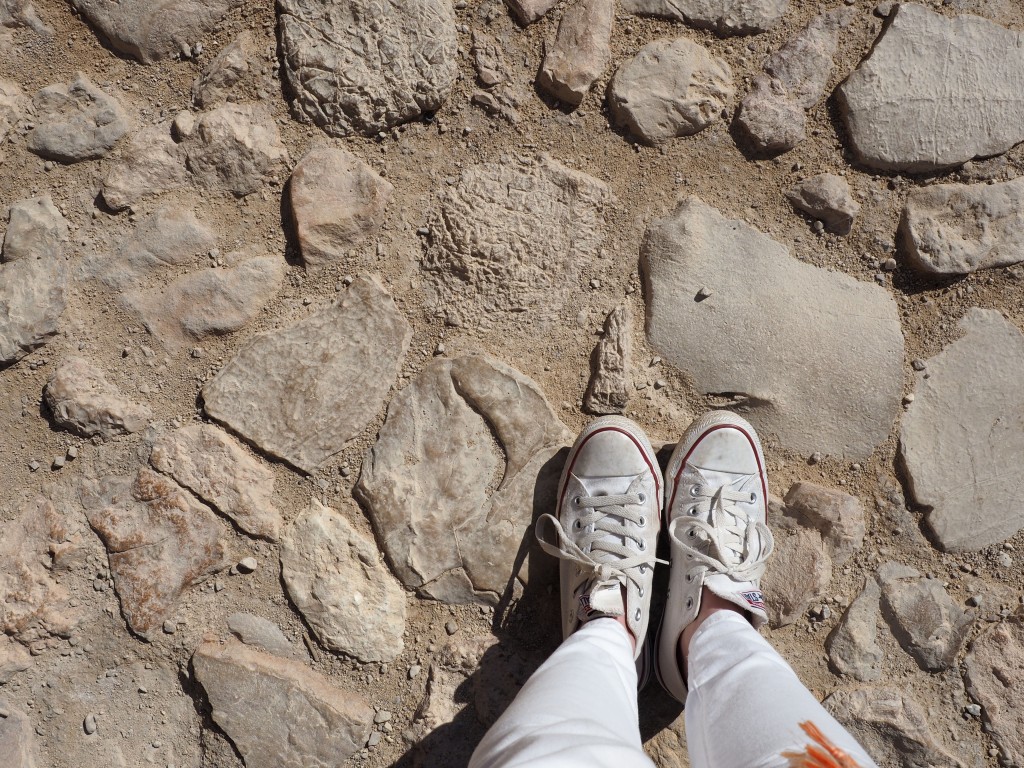
Other Holy Land Sites in Israel
Israel is full of biblical references everywhere you go. Because I was only there for a week, there simply wasn’t time to see and do it all. Here are some other highlights:
Qasr el Yahud – the site where John the Baptist baptized Jesus. The Jesus Trail – follows in Jesus’ footsteps in the Galilee, running from Nazareth to Capernaum. Now a hiking trail for visitors. Capernaum – “The town of Jesus”, how to a few churches and a museum celebrate the life of Jesus. Tabgha – the site where Jesus fed five thousand people (with five loaves and two fish). Bethsaida – home to the three Apostles, Peter, Andrew and Philip, and a number of miracles by Jesus.
I visited Israel with Go Israel , however all opinions are my own.
Brooke Saward founded World of Wanderlust as a place to share inspiration from her travels and to inspire others to see our world. She now divides her time between adventures abroad and adventures in the kitchen, with a particular weakness for French pastries.
Find me on: Twitter | Instagram | Facebook
Los Angeles
Plan a trip
First trip solo
Packing guide
20 Best Places for Solo Female Travel
Travel after a break up
20 Places in your 20’s
WAYS TO TRAVEL
Solo travel
Adventure travel
Luxury travel
Learn a language
Become a blogger

24 Things to do in Israel
By: Author Kate O'Malley
Posted on Last updated: October 23, 2022
Home >> Destinations >> 24 Things to do in Israel
Travel in Israel is an Amazing Journey Through the Holy Land
Table of Contents
About Travel in Israel
When you consider the history of Israel, you need to stop and contemplate in an attempt to try and comprehend it all. Israel is a long and complex story, one that requires much explanation, a little patience and a dash of open-mindedness.
The importance of this land to Muslims, Jews and Christians, combined with centuries of enduring conflict makes for a pretty compelling story and an amazing place to visit.
By discovering the best things to do in Israel, you may also unravel some of the country’s complex story. But don’t expect the norm here, there are a plethora of unusual and unique things to do in Israel.
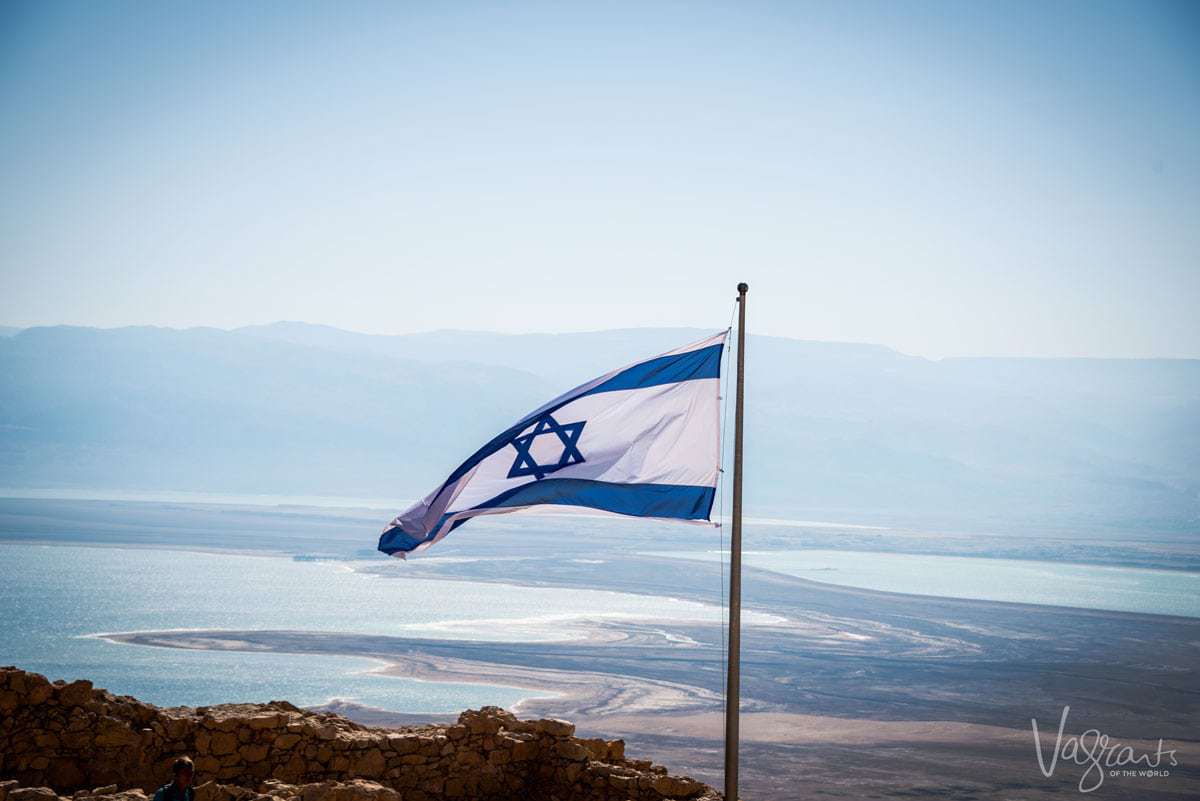
The Diversity of the Israel Experience
For a small and relatively new country, Israel brings together an incredibly eclectic and diverse group of people, some of the holiest and most revered sites in the world and a wide range of dramatic and beautiful landscapes.
Israel has a unique energy. It is both ancient and modern, with vitality and mystique that attracts millions of travellers and pilgrims each year.
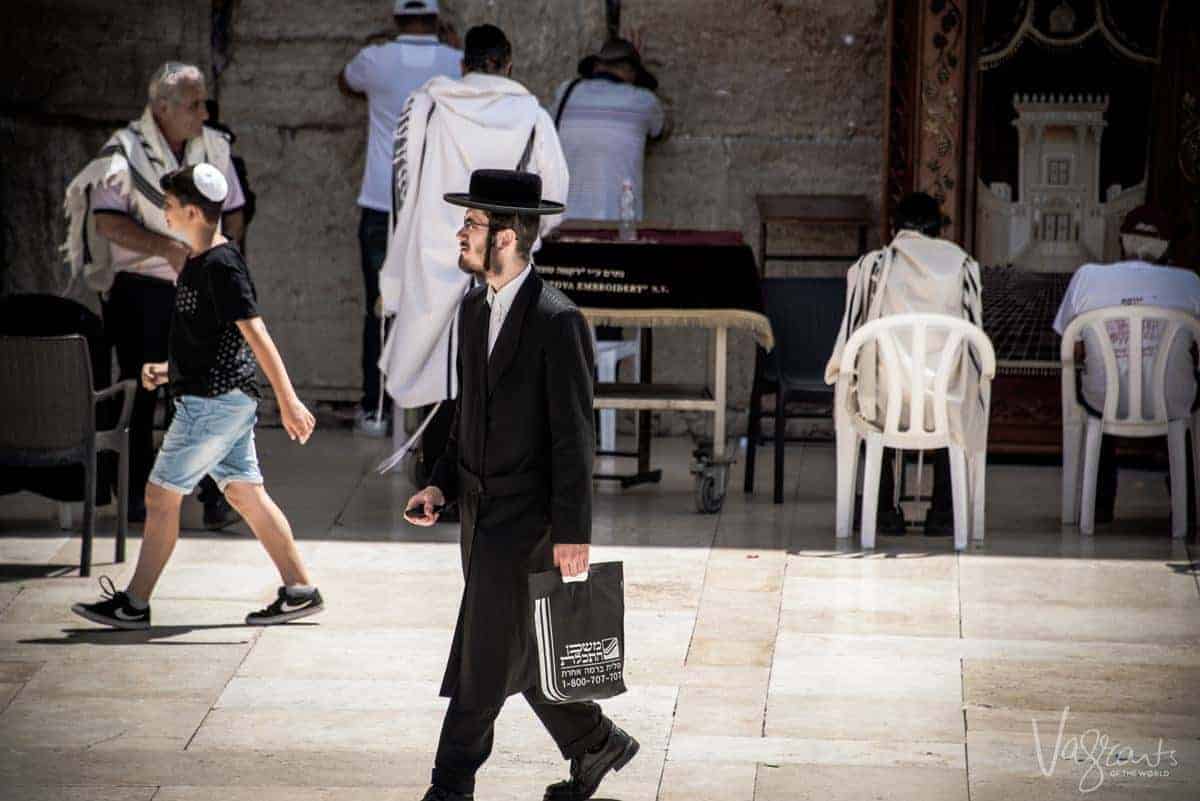
We spent a few weeks travelling through Israel, exploring the country’s most important sights, beautiful landscapes and exciting cities.
We hope to inspire others to see Israel beyond the conflict, beyond the politics and see a destination that is unique and extraordinary. A wonderfully complex country with so much to offer.
Discover More About Travel Through Israel
Old City Jerusalem. A Travel Photography Guide.
Small Group Tours of Israel – The Best Way to Tour Israel
The Best Things to do in Israel
Meet the people of israel.
The people of Israel give great insight into the complex story of the country. To use the old cliche, Israel is the veritable melting pot of culture. The immense historical and religious significance of this holy land brings with it a myriad of cultures calling this land their own.
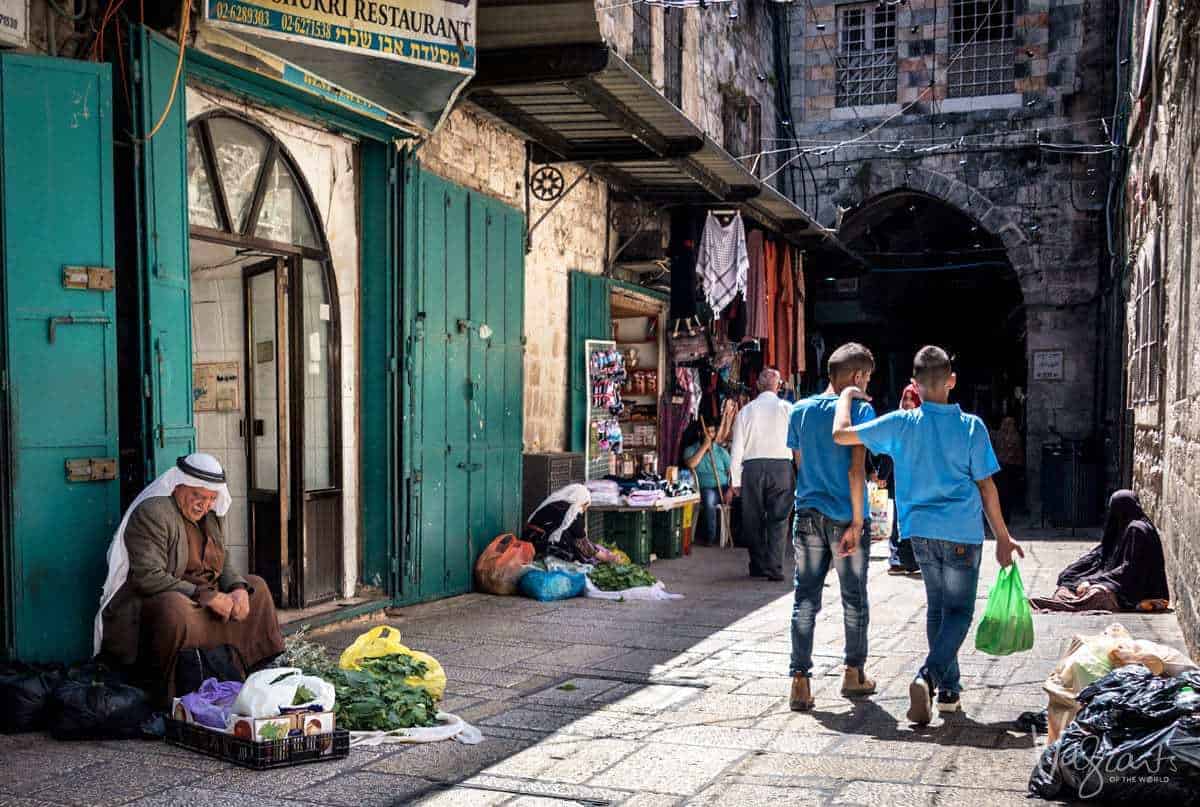
Israel’s diverse and vibrant culture is not merely a by-product of Israel’s complicated history but integral in shaping it. So, while you contemplate the extraordinary historical events that shaped this land over millennia, stop to admire the diversity of people who continue to influence the identity of this unique country.
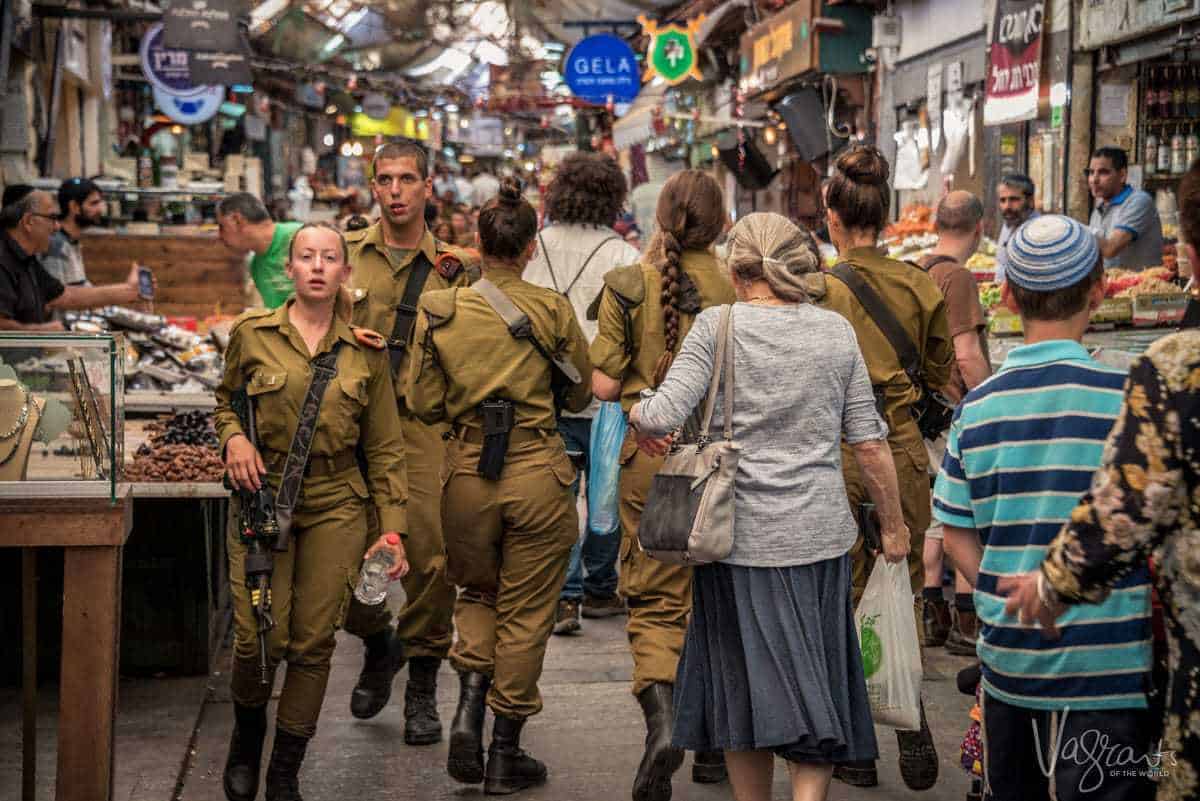
The Old City of Jerusalem
Visiting the Old City of Jerusalem is, without a doubt, one of the top things to do in Israel for both tourists and pilgrims. Israel is unique and complex, especially regarding faith and nowhere is it more complex than Old City Jerusalem.
While predominantly Jewish, faith in Israel comes in many forms and in the Old City of Jerusalem, it shares very close quarters.
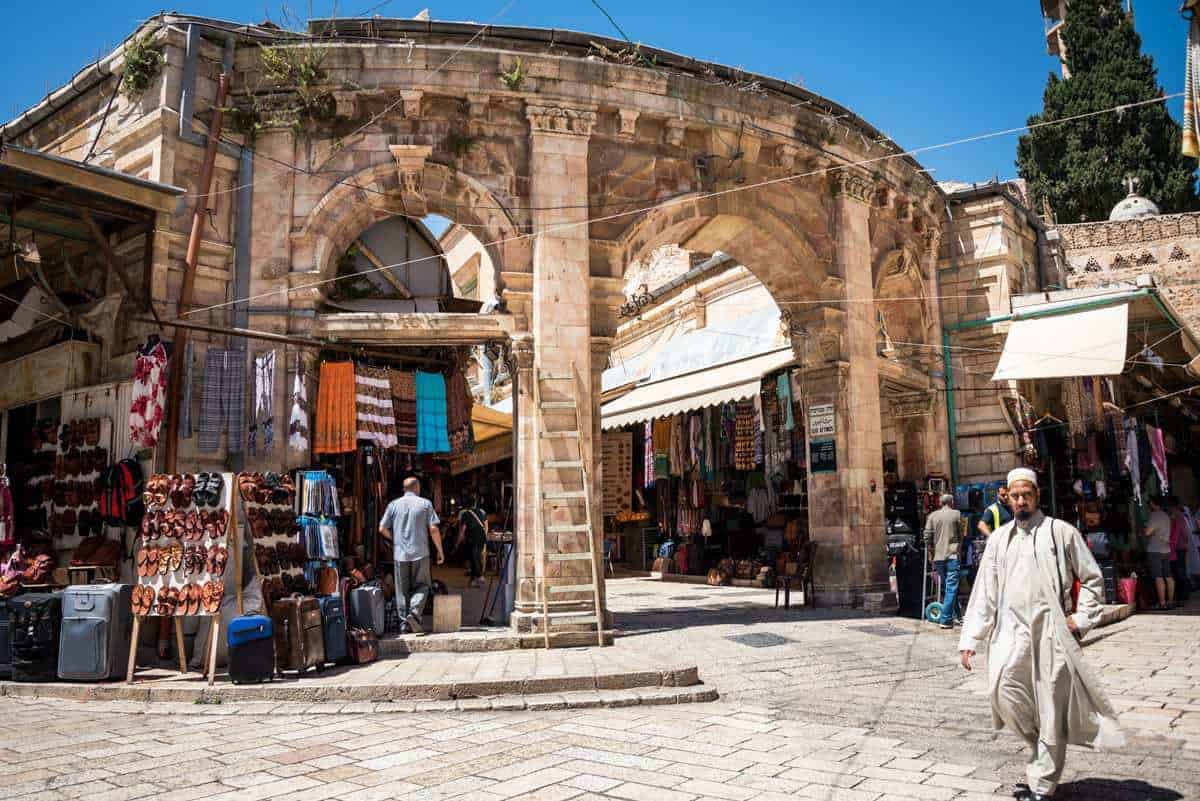
Within the walls of Jerusalem’s Old City; Christians, Muslims, Armenians and Jews share a small walled area of 0.9 square kilometres (0.35 square miles). Of each of these faiths, there are many denominations.
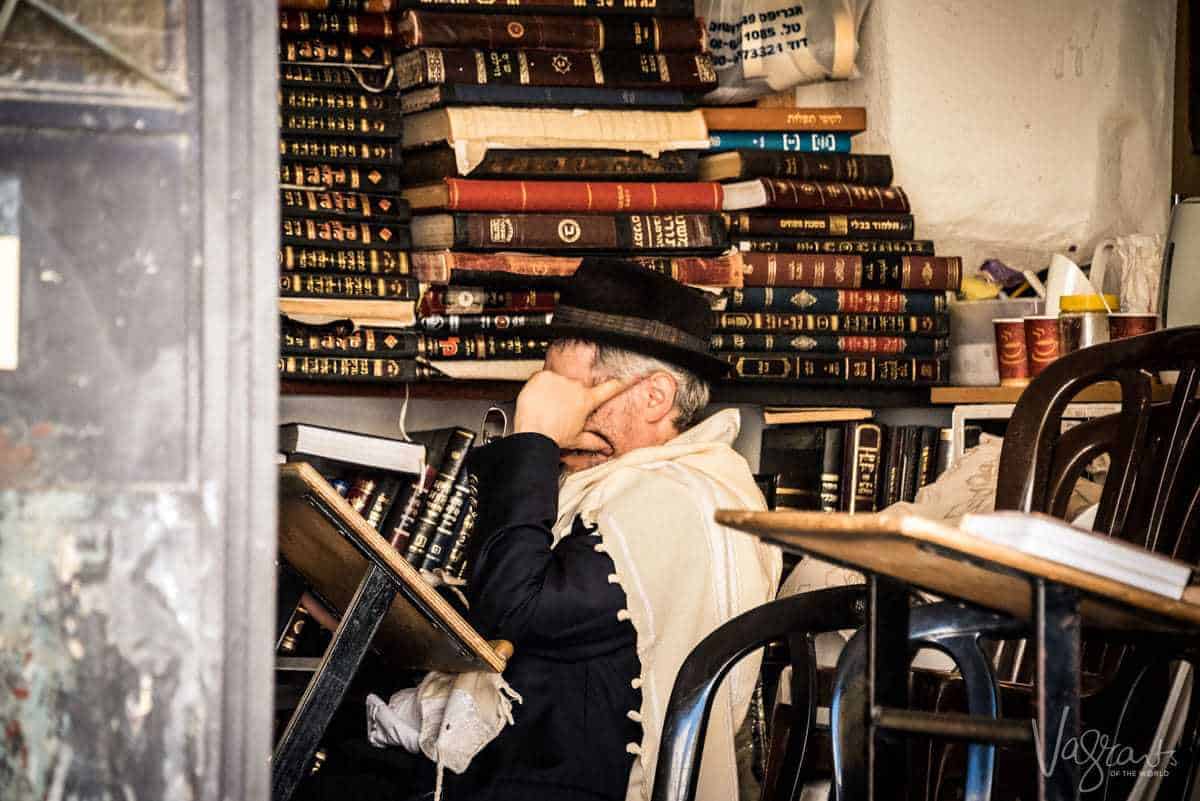
Pilgrimage to the Holy City
With a history deeply rooted in the Jewish, Christian and Muslim faiths, The Holy Land has been a focal point for pilgrims for millennia.
Jerusalem, deemed the holiest city in the world, attracts thousands of pilgrims yearly . They come to complete a spiritual journey, visit the sites Jesus walked, to see and touch the physical manifestations of their faith, and connect personally to the Holy Land.
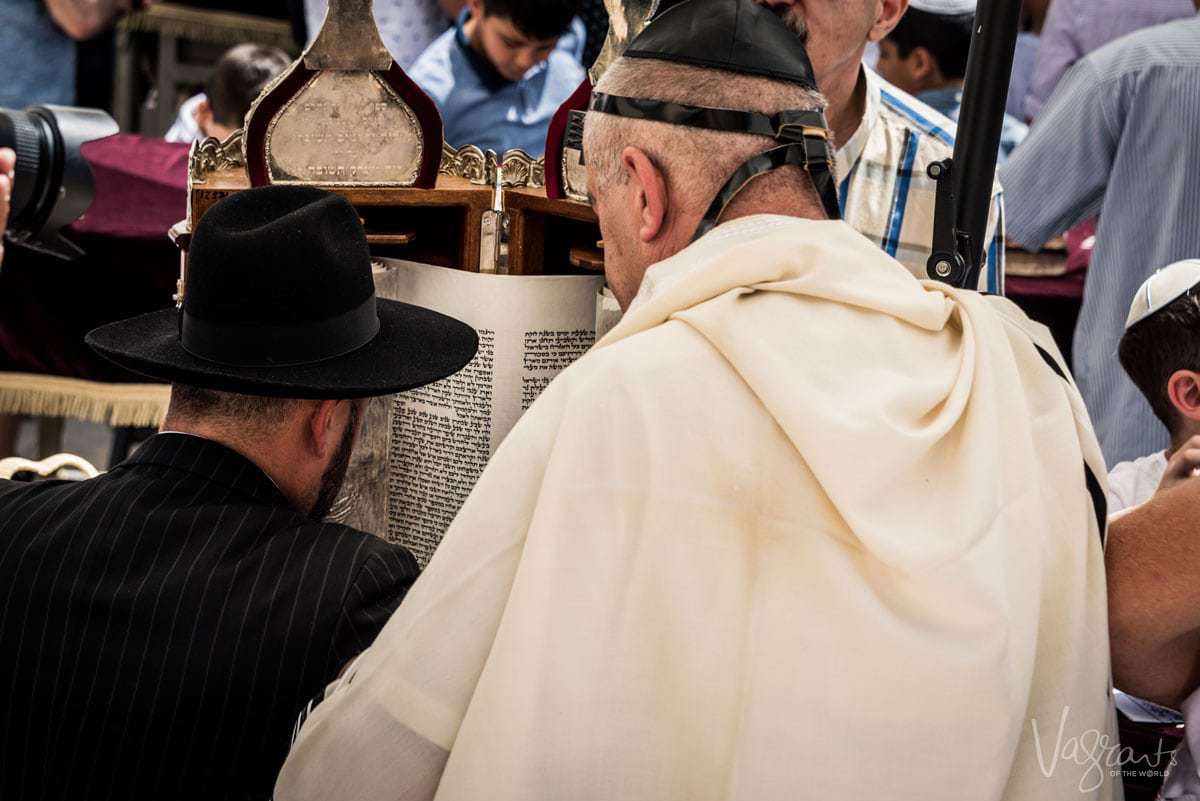
Visit the Most Important Holy Sites in Jerusalem Old City
Religion is an integral feature of Israel, and faith has played a central role in shaping Israel’s history as well as its current culture and lifestyle. Therefore, the most important holy sites in Jerusalem are what many come to Israel to see. These are some of the most revered sites in Jerusalem’s Old City.
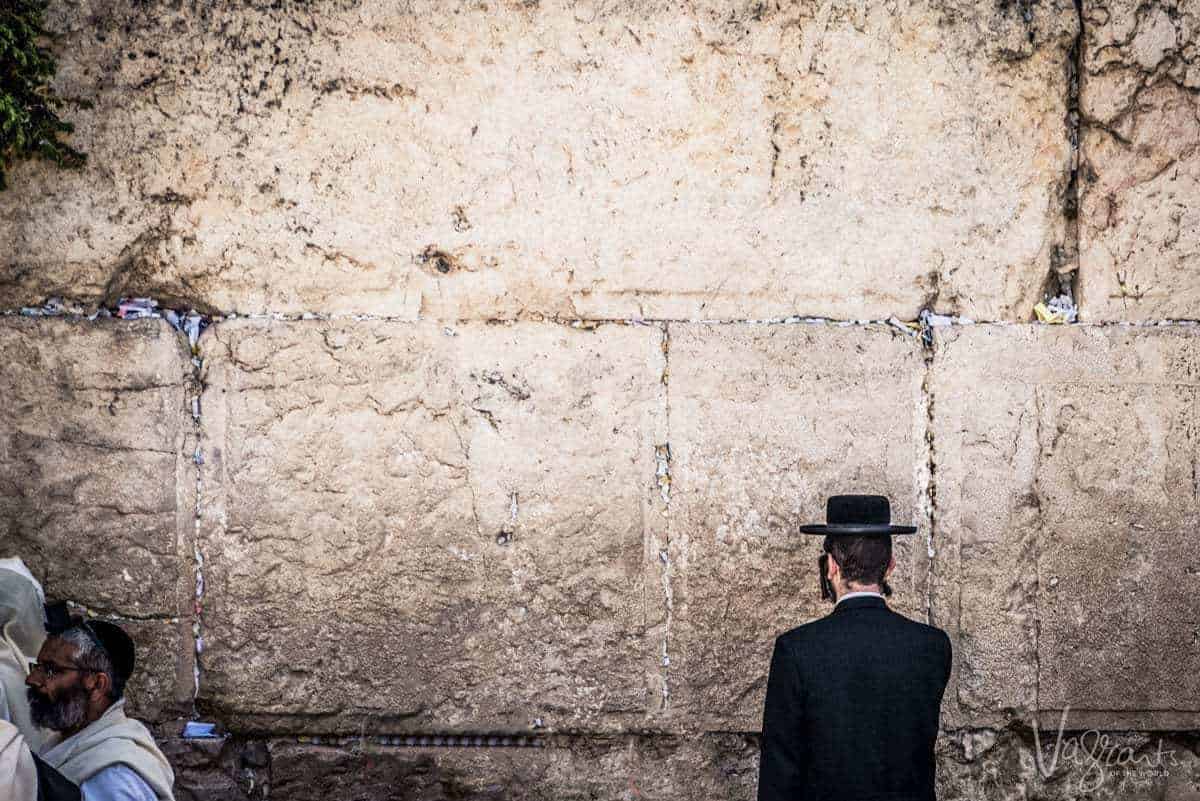
Temple Mount
Some of the holiest sites in Israel are considered sacred by multiple religions. The Temple Mount, known to Muslims as the Haram esh-Sharif (Noble Sanctuary), is one of the most important holy sites in the world. It has been revered as a sacred site by Jewish, Christian, and Islamic faiths for thousands of years. It is also a site of contention and sometimes conflicts.
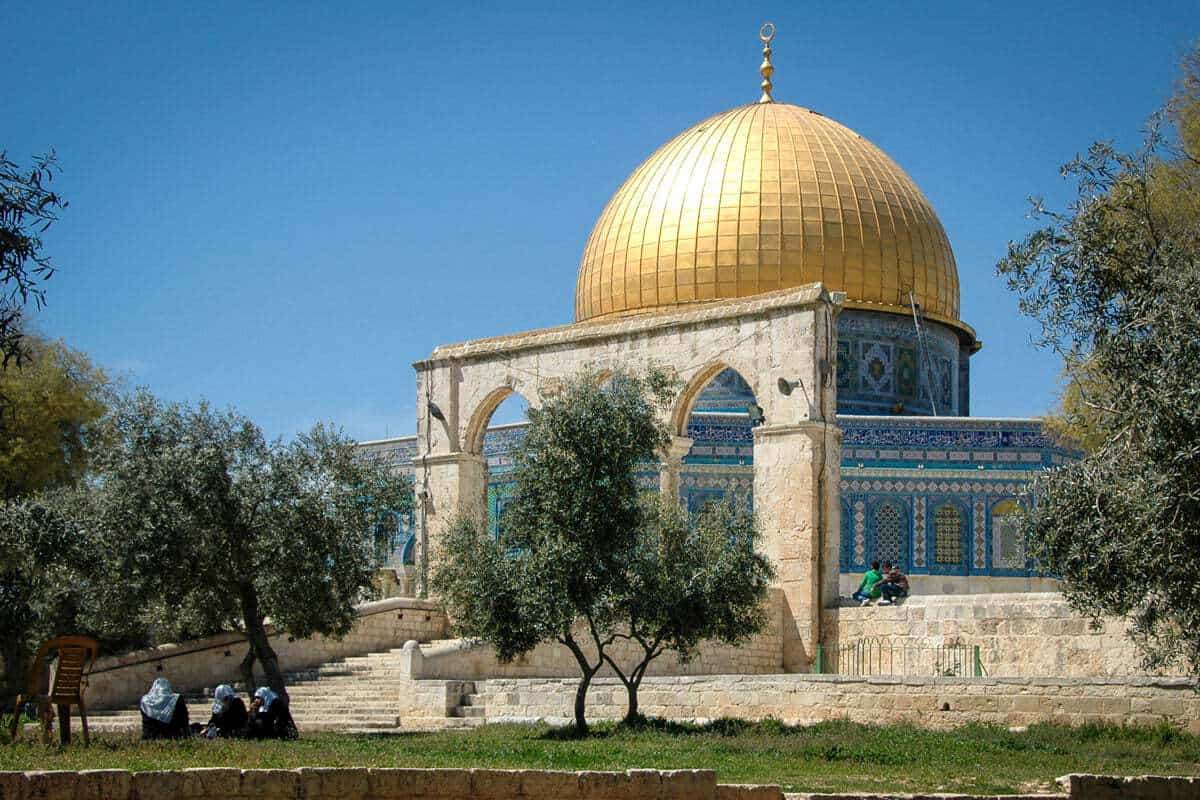
Dome of the Rock
The site of the Dome of the Rock holds great significance for both Muslim and Jewish faiths. The connection for both derives from beliefs around the creation of the world. For Muslims, it is the belief that the rock at the centre of the structure is where the Prophet Muhammad began his Night Journey to heaven.
In Jewish tradition , the rock is the Foundation Stone. The place where the world expanded into its present form and where God gathered the dust to create Adam, the first human. It is believed this is the place where God’s presence is manifested more than in any other.
Visiting Dome of the Rock
Non-Muslim visitors are not allowed to enter the Dome of the Rock but can view the exterior from the Temple Mount courtyard. See further on for details about visiting Temple Mount.
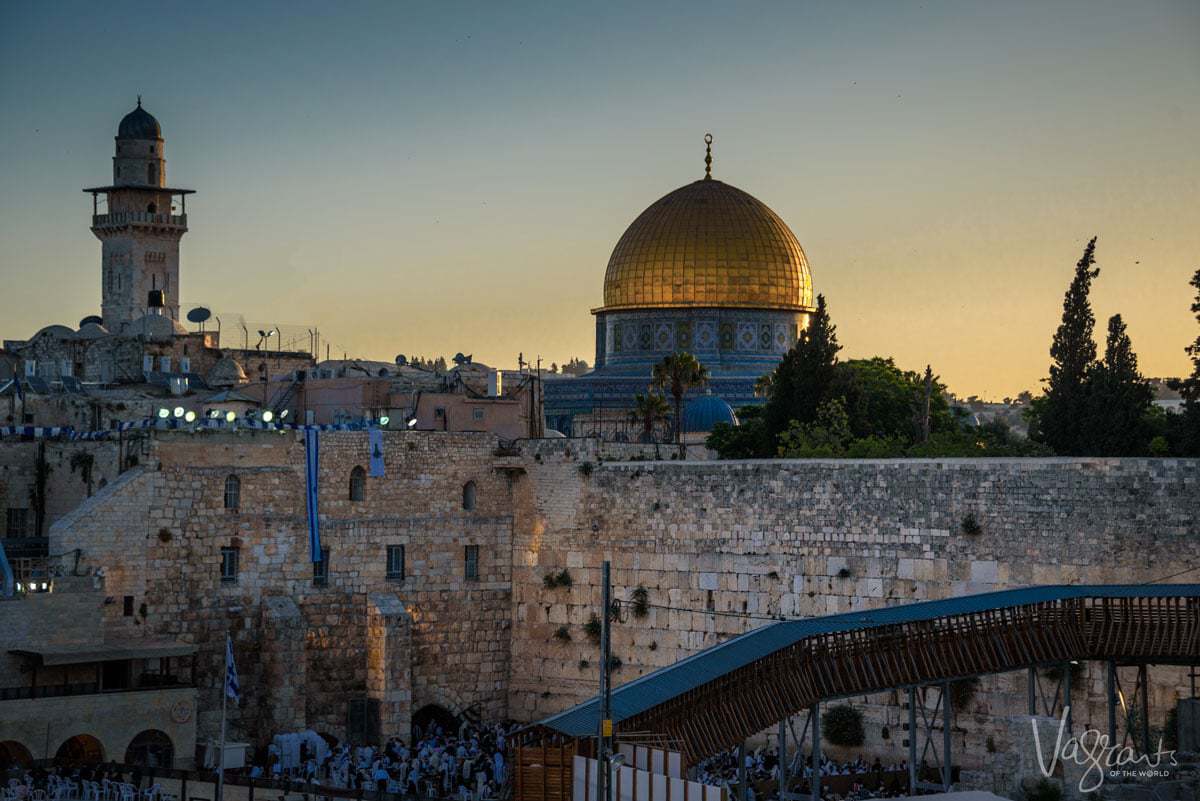
Al Aqsa Mosque (Qibly Masjid Mosque)
The Al-Aqsa Mosque or Qibly Masjid Mosque is the most significant mosque in Jerusalem. Often confused with Dome of the Rock which is actually a shrine, Qibly Masjid Mosque is the third holiest site in Islam after Mecca and Medina.
Visiting Al Aqsa Mosque
Al Aqsa mosque is on the southern end of the Temple Mount. Visitors must dress modestly, and women should cover their hair.
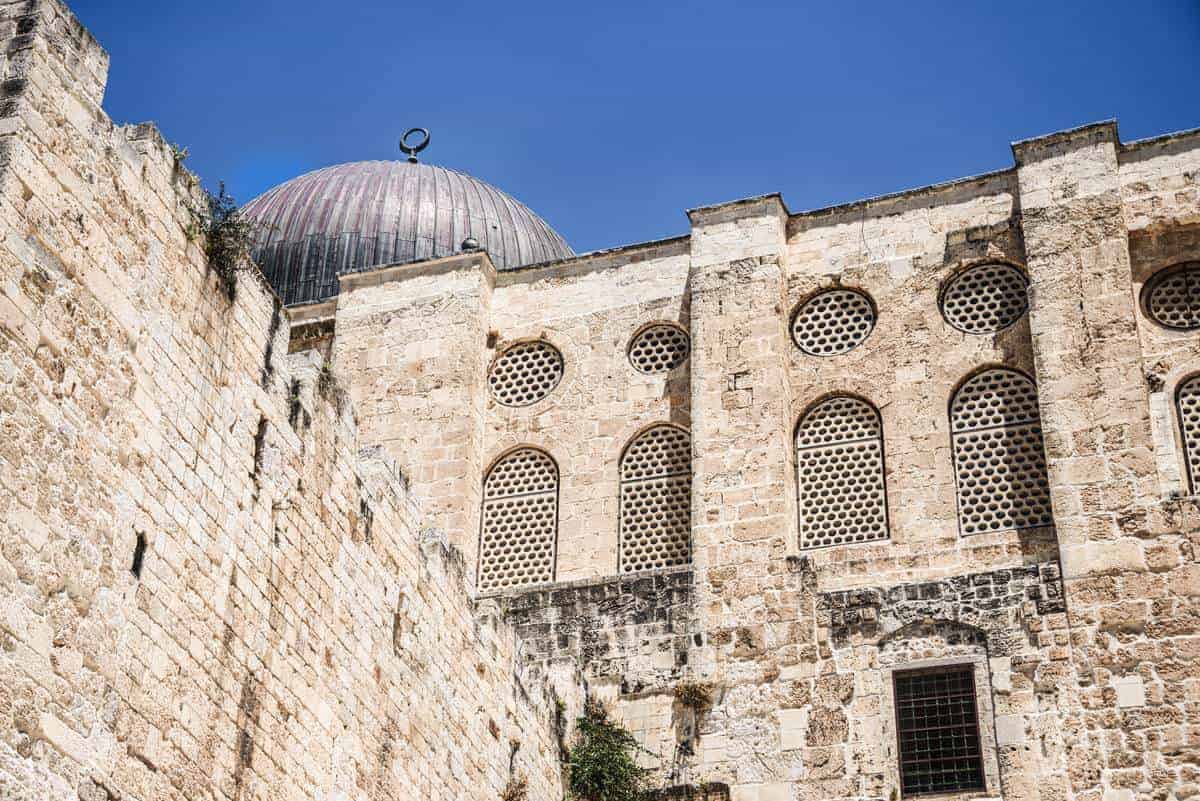
Visiting Hours for Temple Mount
The Temple Mount is closed to visitors on Friday and Saturday. At times the site may be closed without notice even during scheduled opening times.
Visiting Hours for Monday – Thursday:
- Winter: October – March 7:30 am – 10:30 am and 12:30pm – 1:30 pm
- Summer: April – September 8:30am – 11:30am and 1:30pm – 2:30pm
Be prepared for long queues. You may not bring any religious paraphernalia into the site; electronic devices may also be banned for this reason. Once inside Temple Mount, prayer of any form is prohibited.
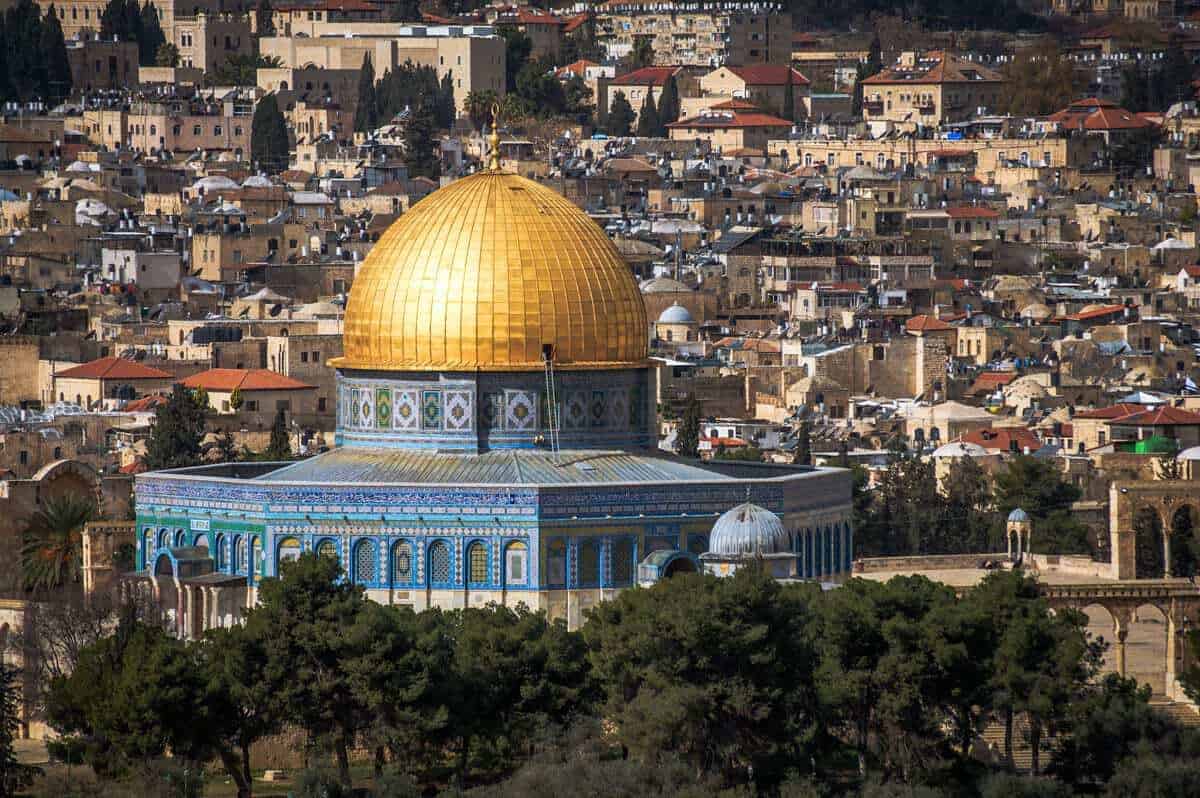
Western Wall – Kotel
The section of wall known as the Western Wall, or Kotel surrounding the Temple Mount is a retaining wall built when the Second Temple was constructed over 2000 years ago.
The Western Wall is considered the holiest site for prayer by the Jewish faith given its proximity to the original temple and the gates of heaven.
Pilgrimage to this area was not possible for Jews during the time East Jerusalem was under Jordanian control between 1948 and 1967. The Western Wall now attracts millions of pilgrims every year who come to pray or hold Bar Mitzvah ceremonies.
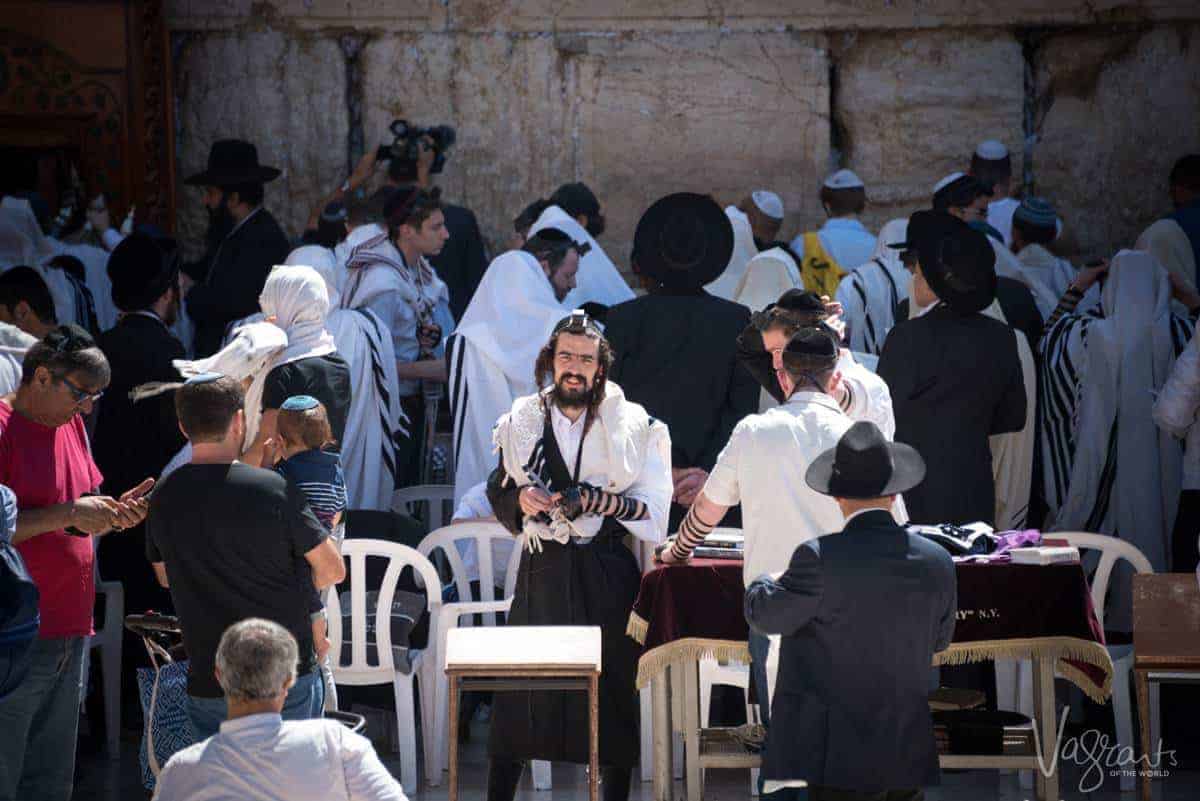
Prayer at the Western Wall
It is common for people who come to pray at the Western Wall to place prayers written on small pieces of paper into the many cracks in the wall.
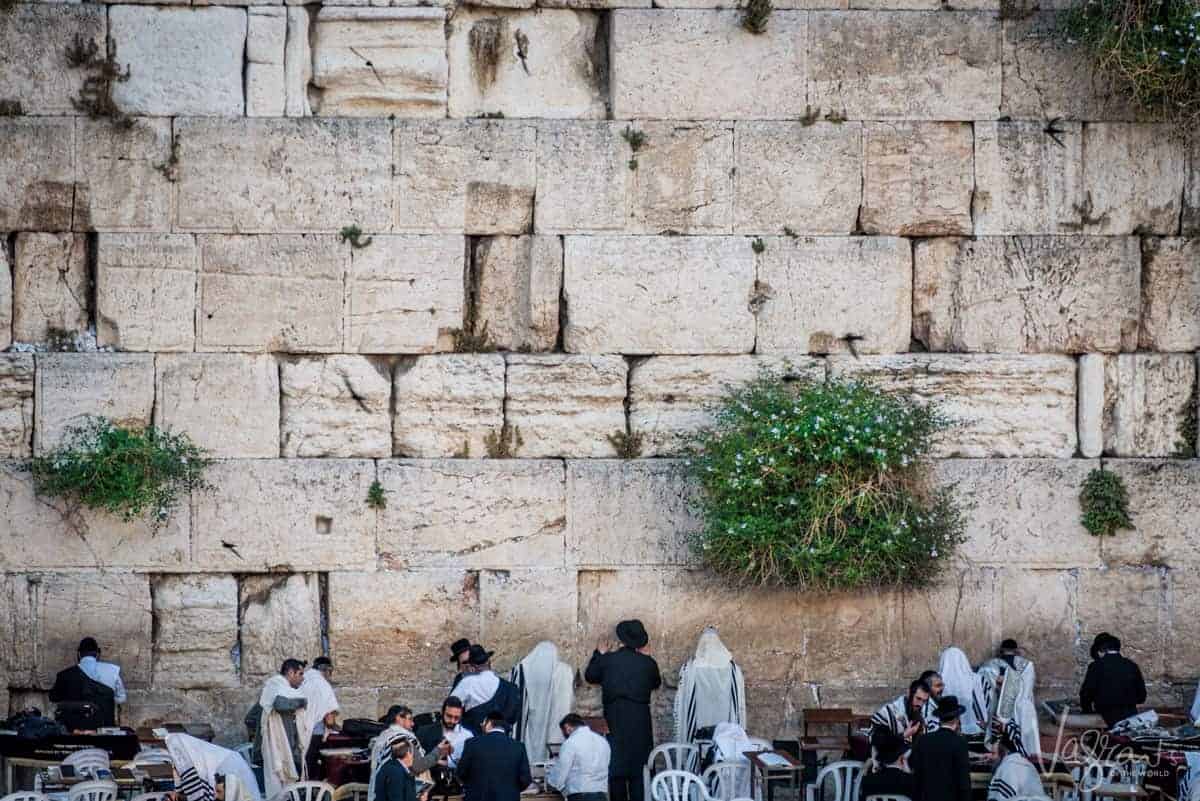
Visiting the Western Wall
You may visit the Western Wall at any time; it is open 24 hours a day.
The Wall is divided into two sections; men to the left and women to the right. Visitors of all religions are welcome to pray at the wall but are asked to observe modesty requirements.
Men must have a head covering. If you don’t have one, they are available for free at the entrance. Likewise, the women may borrow shawls to cover legs or shoulders.
Security at the Western Wall
When entering the Western Wall Plaza, you will have to go through a security screening similar to an airport screening where all bags and belongings will be x-rayed.
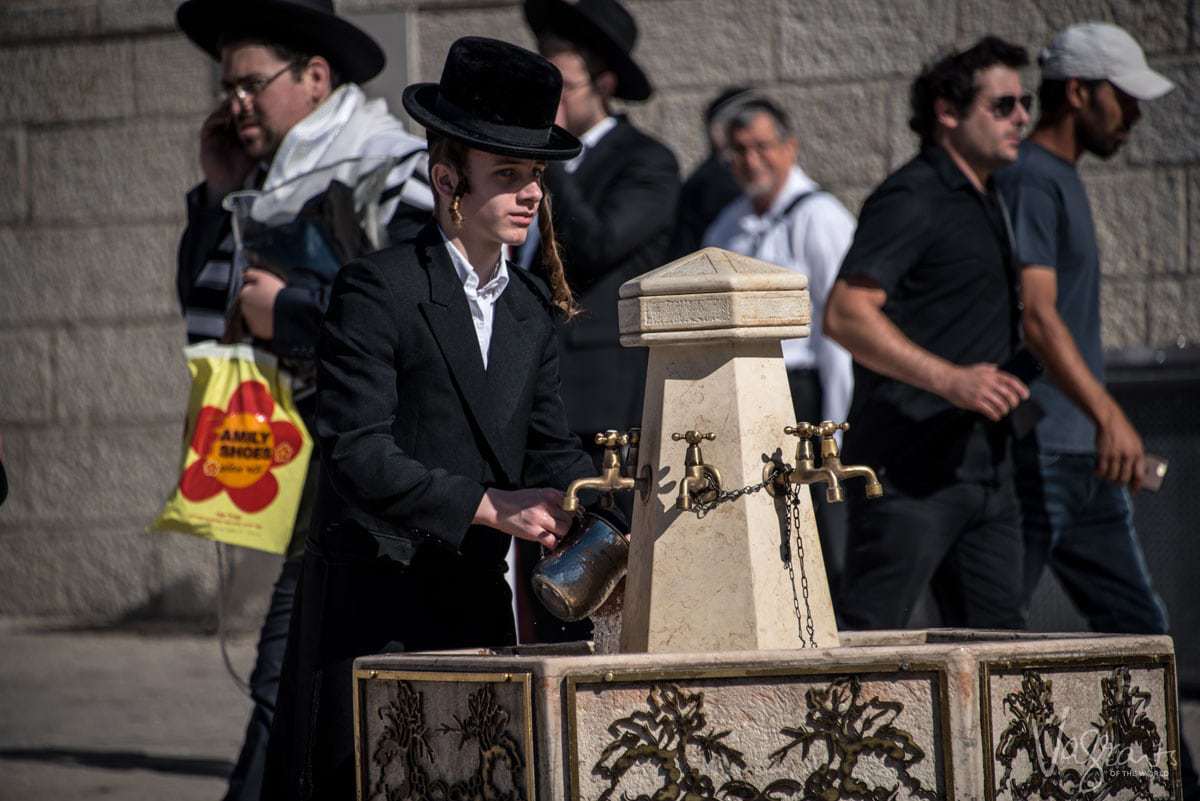
Western Wall Tunnel
The Western Wall Tunnels run along approximately 488 meters along the Western Wall. One of the most revered places inside the tunnels is the part of the Western Wall traditionally considered closest to where the Holy of Holies used to be on the Temple Mount.
The Holy of Holies, where the Foundation Stone and the Dome of the Rock are located, is the holiest place for Jews. There is a small synagogue at this spot in the tunnels where Jews come to pray.
Visiting the Western Wall Tunnel
Sunday – Thursday: 7:20 am until late at night Friday: 7:20am – 12pm
Tour of the Western Wall Tunnel is only possible when accompanied by a local guide.
The Church of the Holy Sepulchre
In the Christian Quarter of the Old City is the Church of the Holy Sepulchre. The site of the crucifixion and burial of Jesus Christ and the holiest site in the Christian faith.
The Church of the Holy Sepulchre is the headquarters of the Greek Orthodox Church of Jerusalem, but control of the church itself has been shared by several Christian denominations and secular entities for over 160 years.
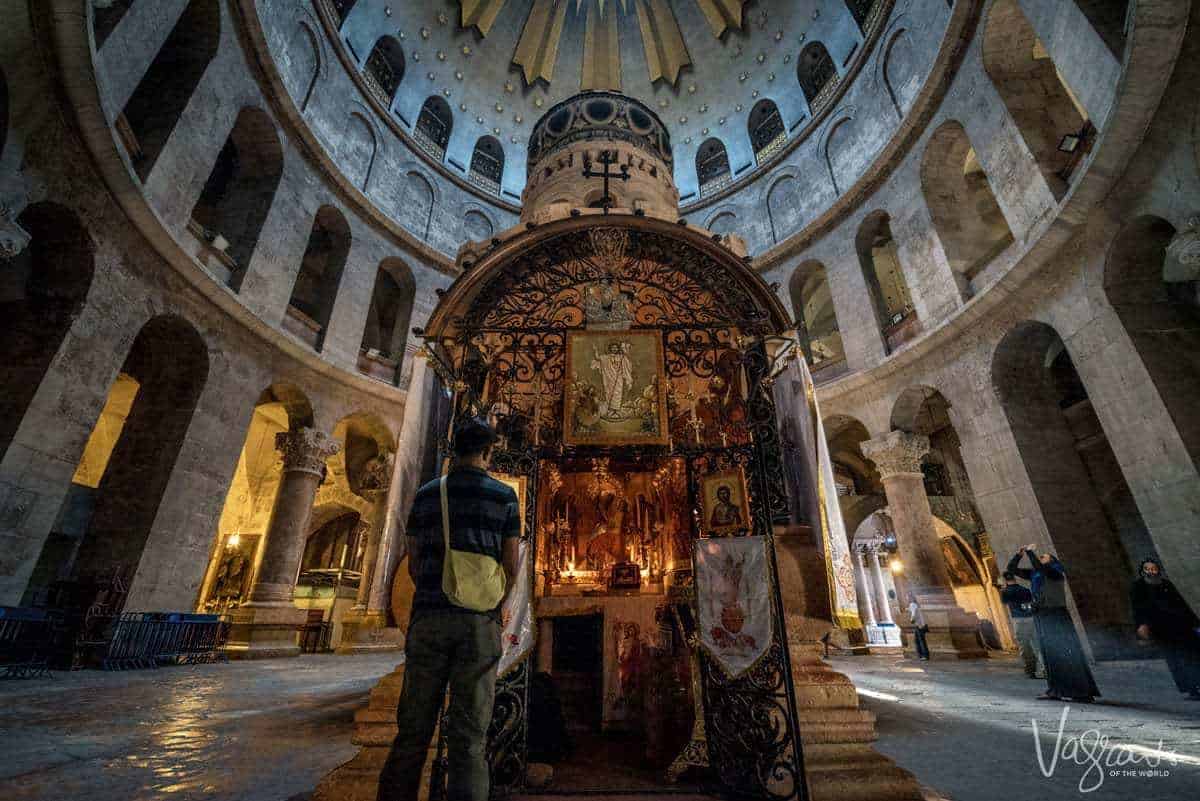
Masses of people from all over the world make the pilgrimage to witness the place where Jesus was crucified, buried and more importantly, resurrected.
It is customary for pilgrims to kiss The Stone of Unction, the place where Christ’s body was laid down in preparation for burial after being removed from the crucifix.
Tip for Visiting the Church of The Holy Sepulchre
If possible, arrive very early in the morning. The church is one of the most popular sites in Old City Jerusalem and becomes very crowded with both tourists and pilgrims from around 7-8 in the morning.
The church is open from 5.00 am and well worth an early start.
We arrived at 6.00 am, and the first tour and pilgrim groups had started to arrive.
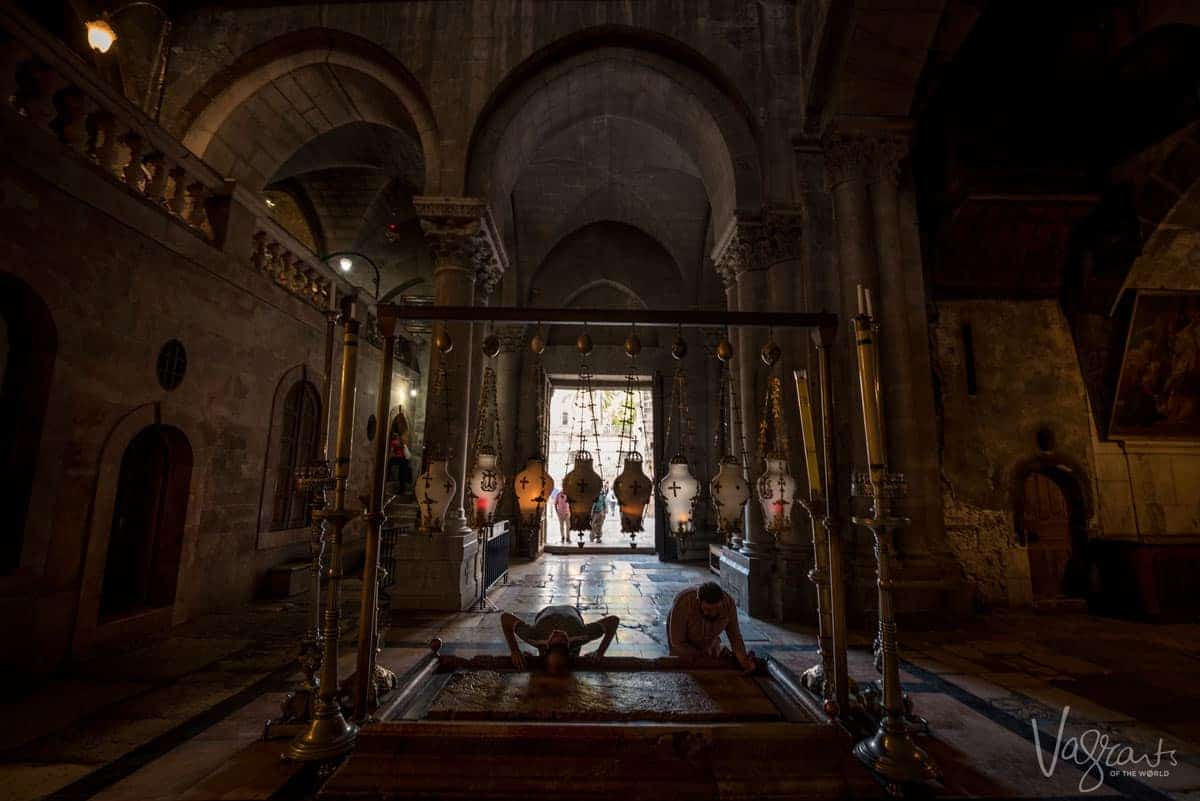
The Via Dolorosa
For Christian pilgrims, the most important and meaningful thing they will do in Israel is to walk the Via Dolorosa. This 600-meter stretch of road through the Old City is said to be the route Jesus took between his condemnation by Pilate, his crucifixion and his burial.
The Via Dolorosa pilgrimage is an important pilgrimage for Christians of many denominations, but chiefly Catholics and Orthodox.
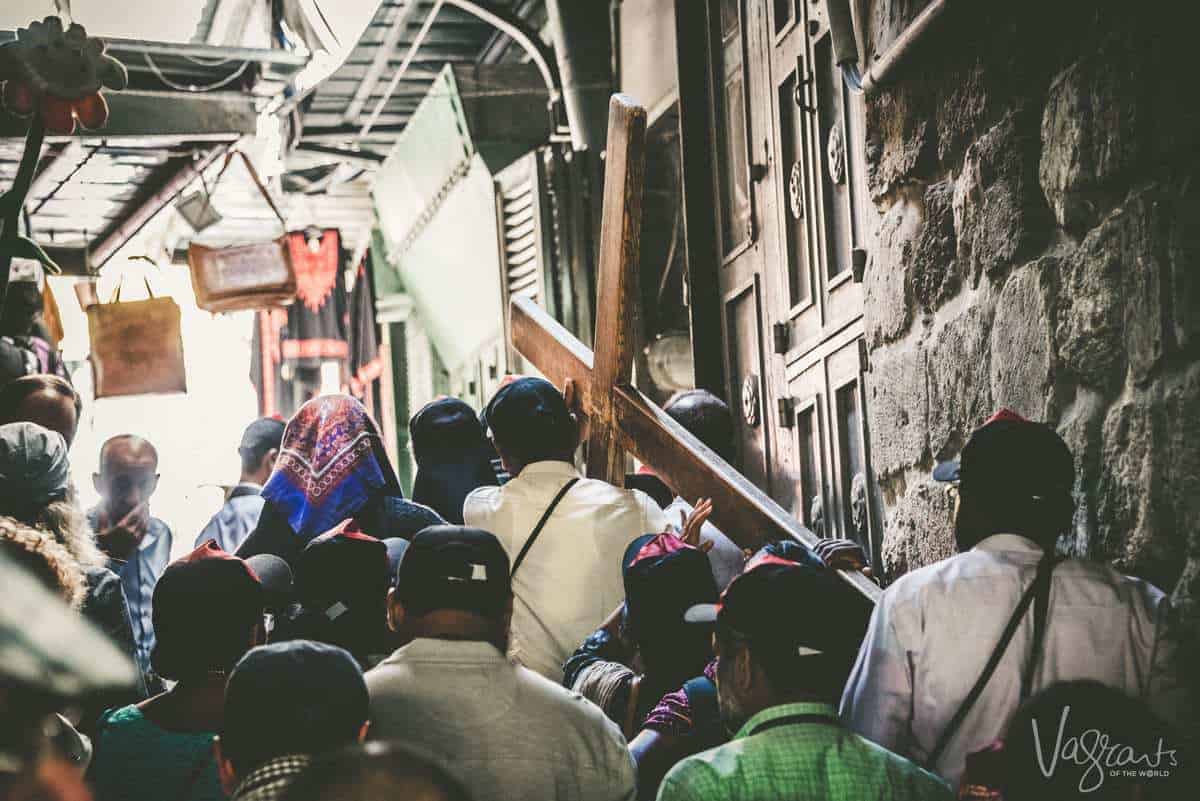
Walk The Wall of Jerusalem Old City
You can walk around the old city ramparts from the Jaffa to Damascus gates for a different view of Jerusalem. To be honest; this was not the most interesting or scenic rampart walk we have done but worth the small fee.
From the top of the ramparts, you can get some lovely views of the city of Jerusalem outside the old walled city. You will also come across a few good elevated views of life within the walls of Old City Jerusalem.
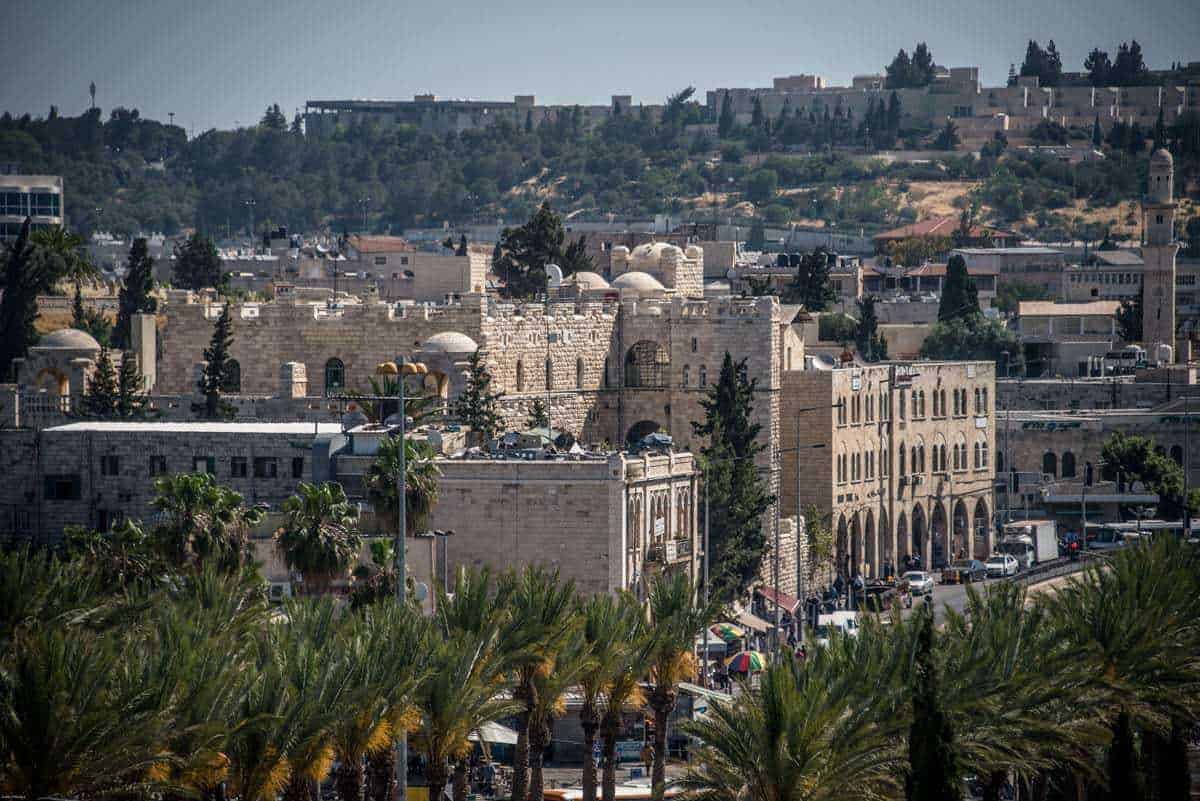
Tickets and Opening Hours to Walk the Ramparts
Tickets can be purchased at the ticket office next to the information centre at Jaffa Gate.
Opening Hours:
Between 9am-4pm.
During the summer months, the southern side is open until 7 pm and the north side until 5 pm.
Recommended Day Tours of Jersalem
Jerusalem: Holy City Tour – 4 Hrs
Full-Day City Tour of Jerusalem – 10 Hrs
Jerusalem, Dead Sea & Bethlehem Full-Day Tour – 1 Day from Tel Aviv
Yad Vashem World Holocaust Memorial
This official memorial site to the millions of victims of the Holocaust, the Jews who fought against the Nazis and the Gentiles who selflessly aided the Jews.
The memorial is a must-see while visiting Israel as it speaks not just for the lives lost but for the many who survived and resettled in Israel.
Visiting Yad Vashem
Opening hours.
Sunday – Wednesday: 8:30 am – 5:00 pm Thursday: 8:30 am – 8:00 pm Fridays and Holiday eves: 8:30 am – 2:00 pm Yad Vashem is closed on Saturdays (Shabbat) and all Jewish Holidays.
Entry to the Holocaust History Museum and all other sites is free.
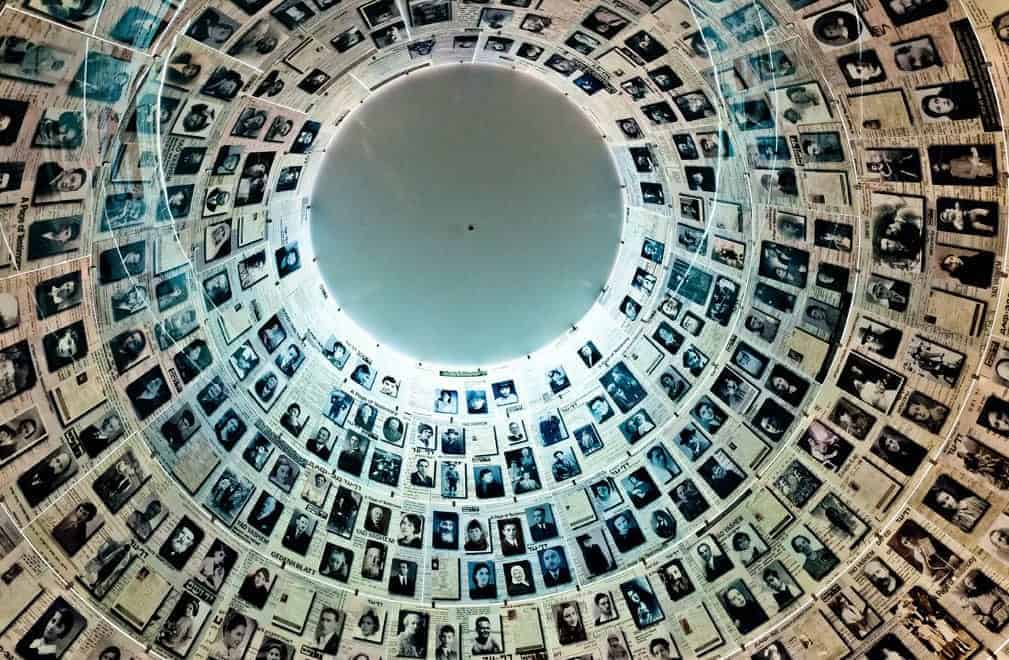
Cities of Israel
Israel boasts many vibrant cities, rich in atmosphere and culture. Modern living set against the old world atmosphere of Israel’s millennia of history. Each city has a unique vibe, and cultural atmosphere and each has a different story in history to tell.
City of Jerusalem
Jerusalem, The Holy City, is an elegant combination of ancient history, mixed culture and the day-to-day of modern life. While many come to Jerusalem to visit the Old City, a lot is happening around New Jerusalem.
Whether exploring the markets, sampling some of the fantastic restaurants and bars or just people watching on the famous Ben Yehuda Street, Jerusalem has a wonderful atmosphere and is worth exploring beyond the Old City.
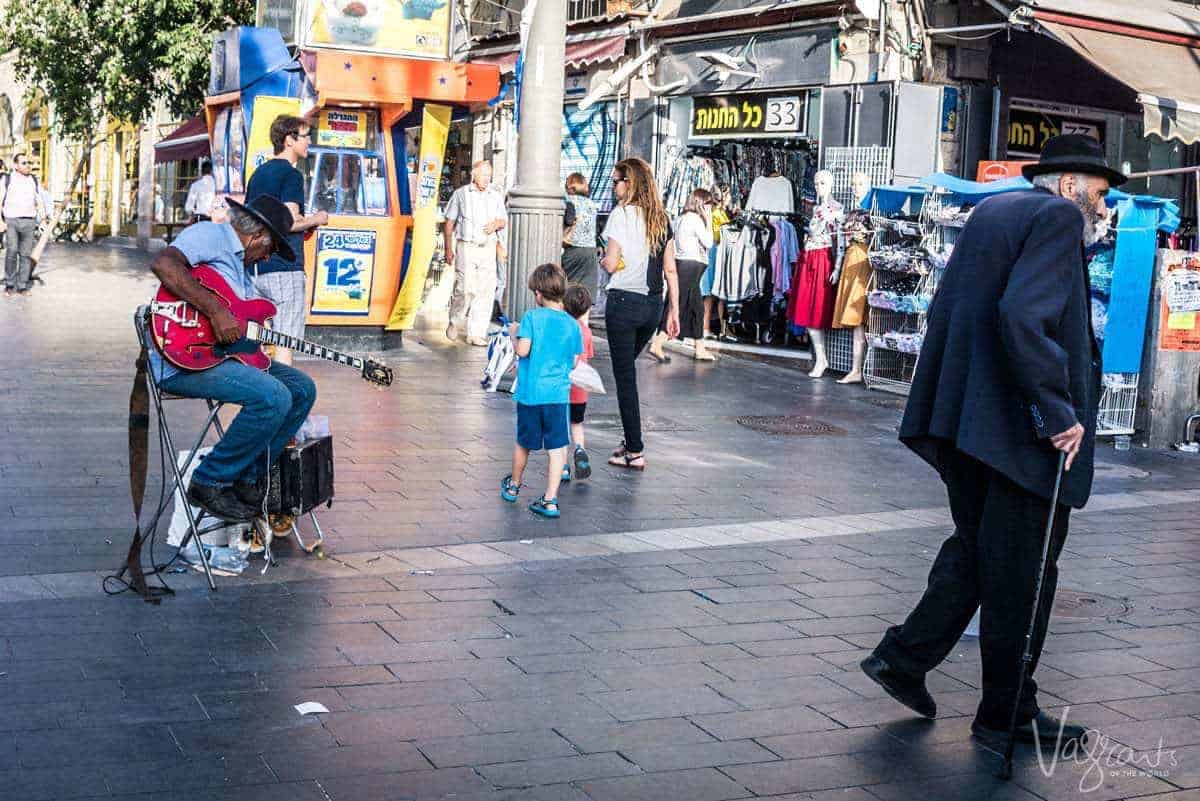
Machane Yehuda Market
The largest market in Jerusalem and the oldest in the country, “The Shuk” as it is known is the other “must-see” in Jerusalem. Dating back to the late 1800s; the Machane Yehuda Market began as a simple marketplace for locals where Arab farmers and Jewish housewives haggled over prices.
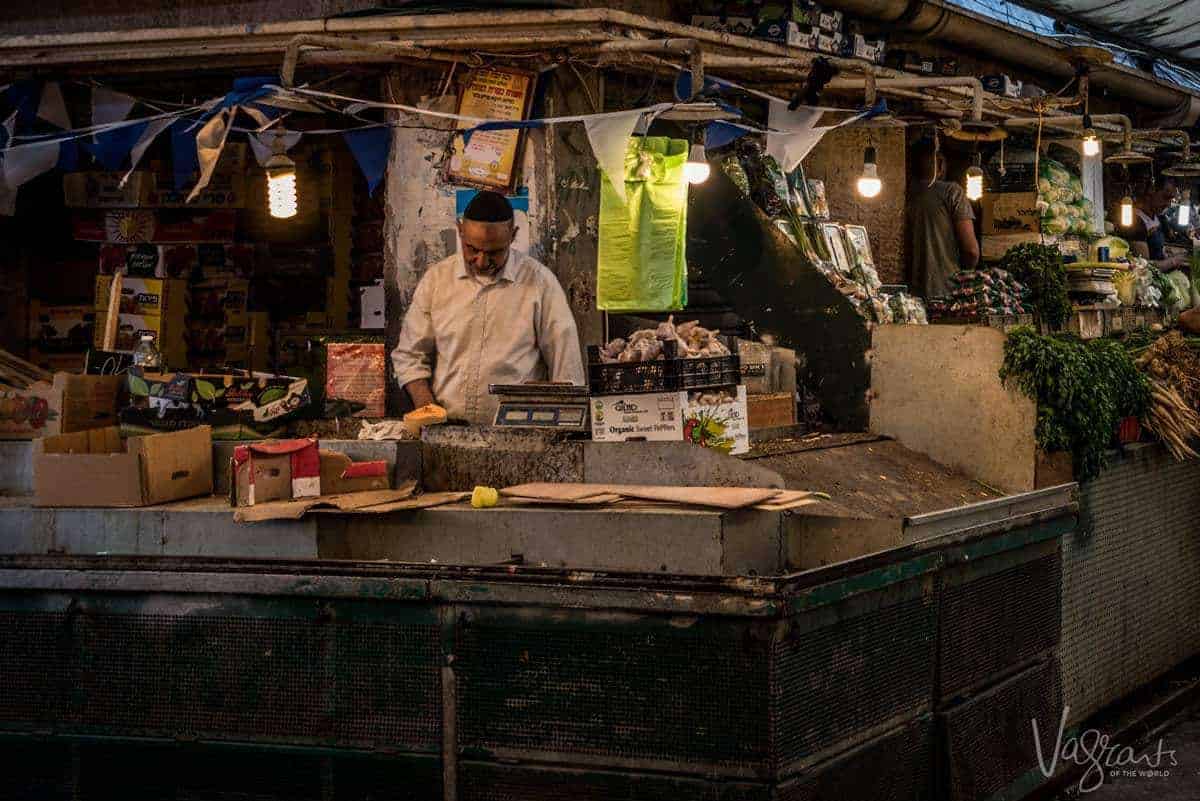
On that front, not much has changed. Although the market now boasts over 250 stalls and has done an excellent job progressing with the times. Pop in during the day and enjoy the daily trade of fresh produce and homewares. Come back in the evening after the stalls have closed for a very different take on the market.
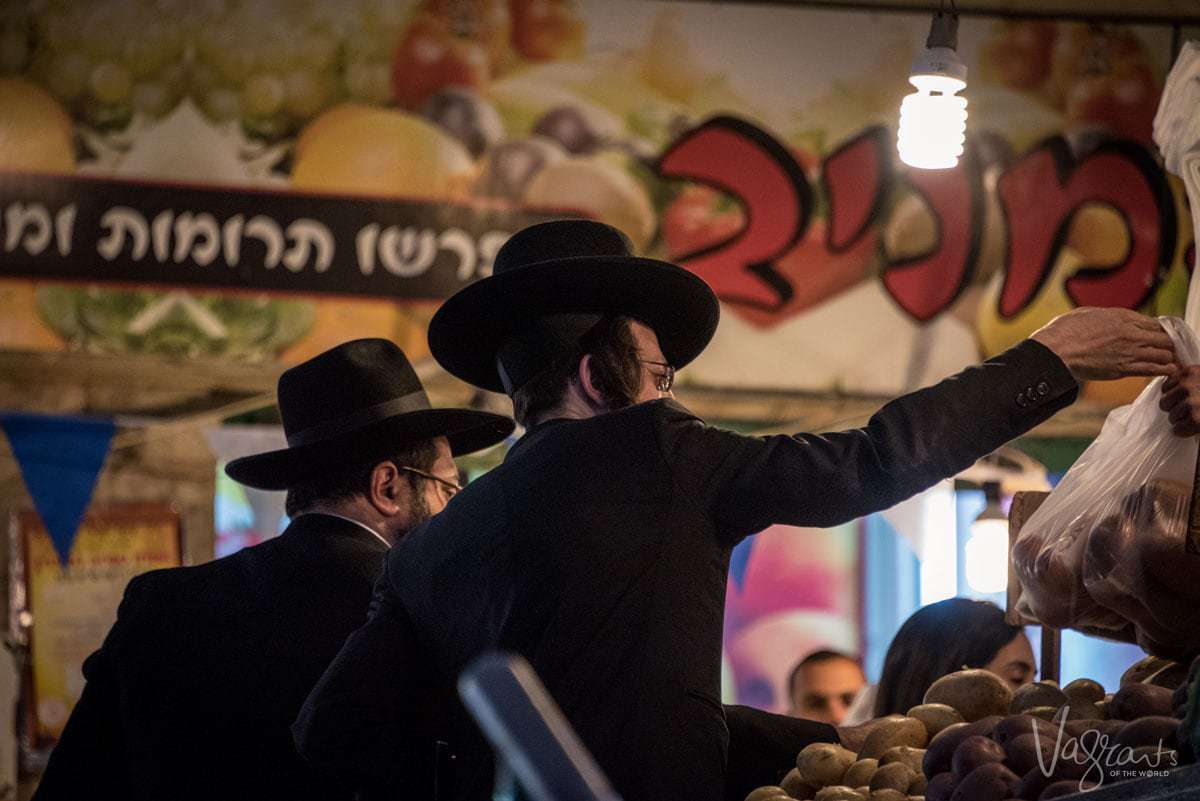
Spend an Evening at Machane Yehuda Market
Small pop up bars, cafes, hip food outlets and restaurants are becoming the norm in the ancient marketplaces. Markets such as Jerusalem’s Machane Yehuda market, have become major focal points of Israeli nightlife.
Bars and restaurants will stay open long after the vendors have gone for the day attracting a new breed of marketplace clientele. It’s a great place to head for dinner.
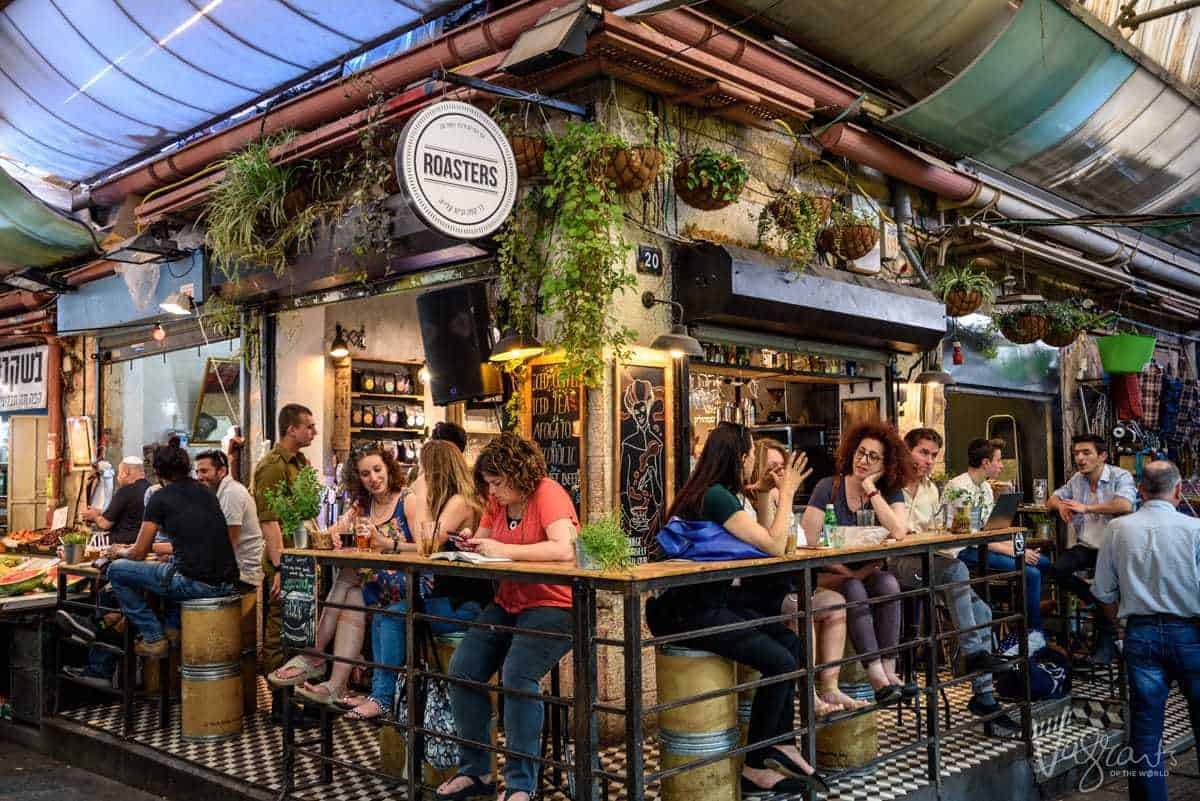
Machane Yehuda Market Tours
Famous for its beach lifestyle and hedonistic nightlife, some say if Jerusalem is the holy city, Tel Aviv is Babylon. Tel Aviv often surprises first-timers with its modern outlook and lively social scene. You will never be short of things to do in Tel Aviv .
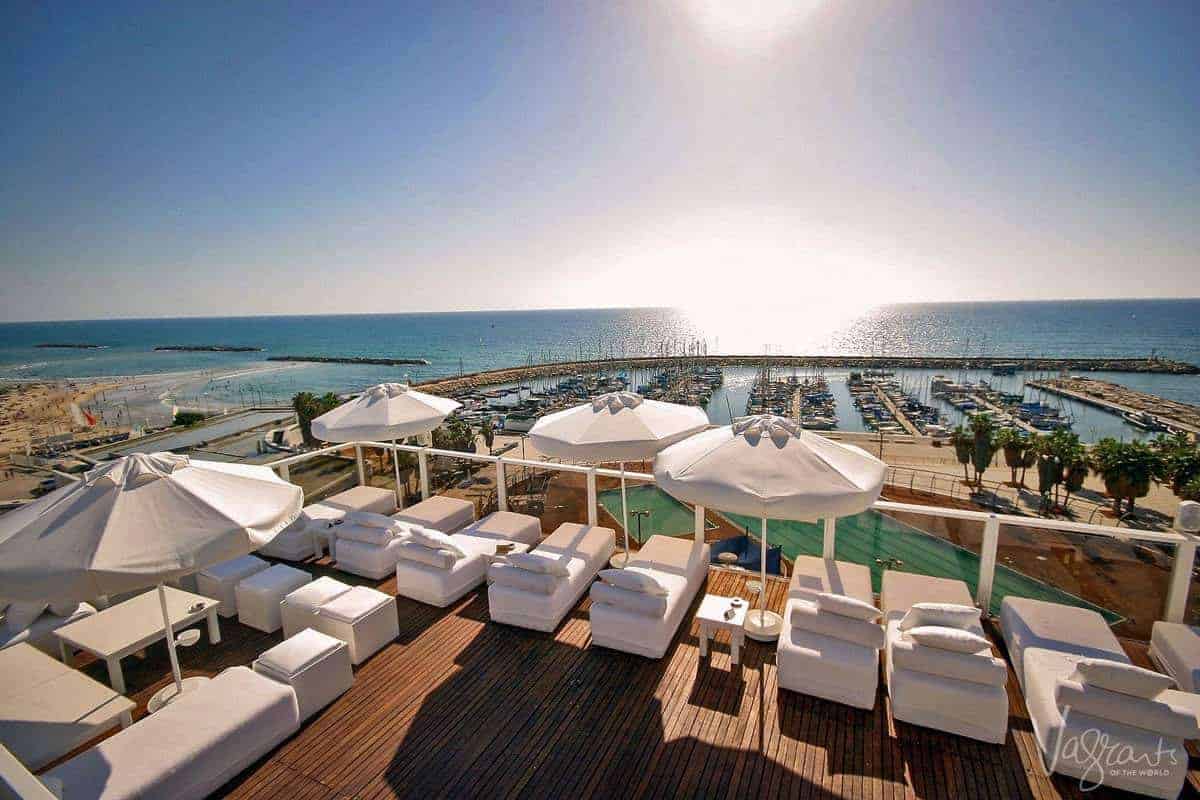
Neve Tzedek – The Soho of Tel Aviv
Commonly known as the “Soho” of Tel Aviv. South West of Tel Aviv, Neve Tzedek was the first Jewish neighbourhood built outside the old city of Jaffa. It is now considered one of Tel Aviv’s prettiest and most fashionable districts.
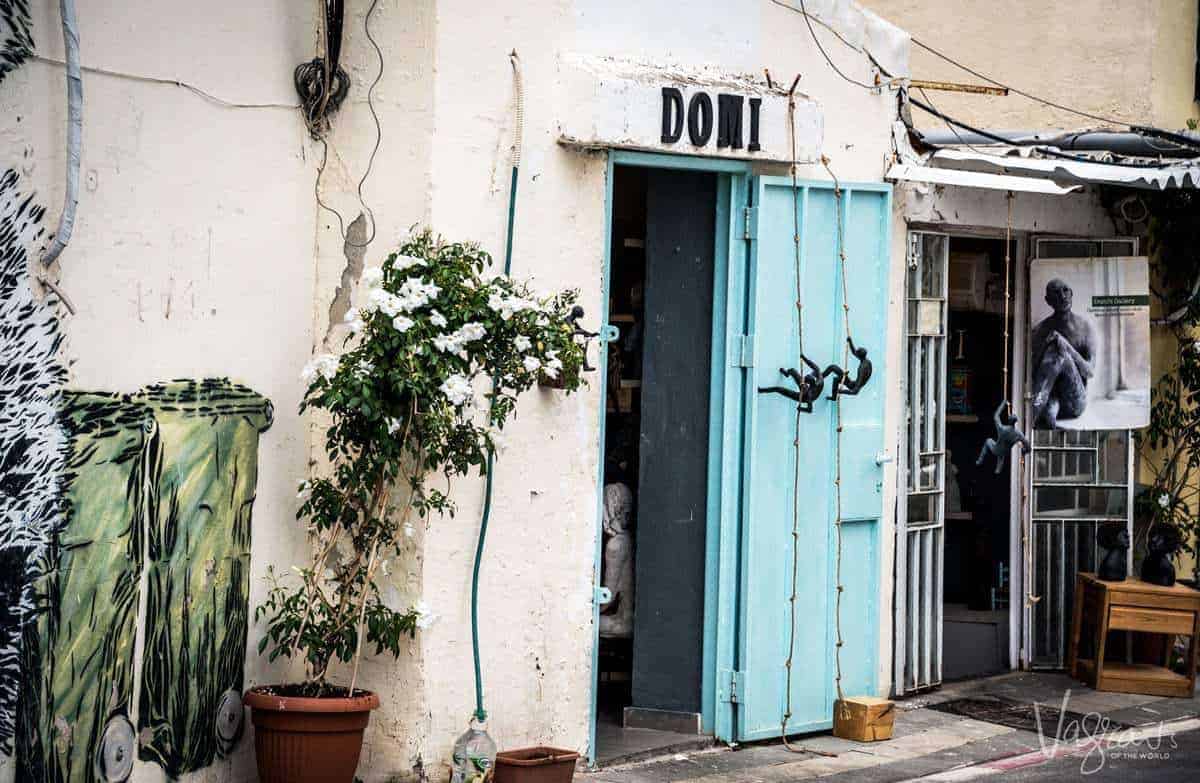
Explore Jaffa
An ancient Arab seaport is considered the oldest part of Tel Aviv. Old Jaffa is a highlight with ancient cobblestone streets, galleries and busy waterfront eateries. A recent restoration of the area has brought new life to Jaffa and is now an exciting extension of Tel Aviv’s urban scene.
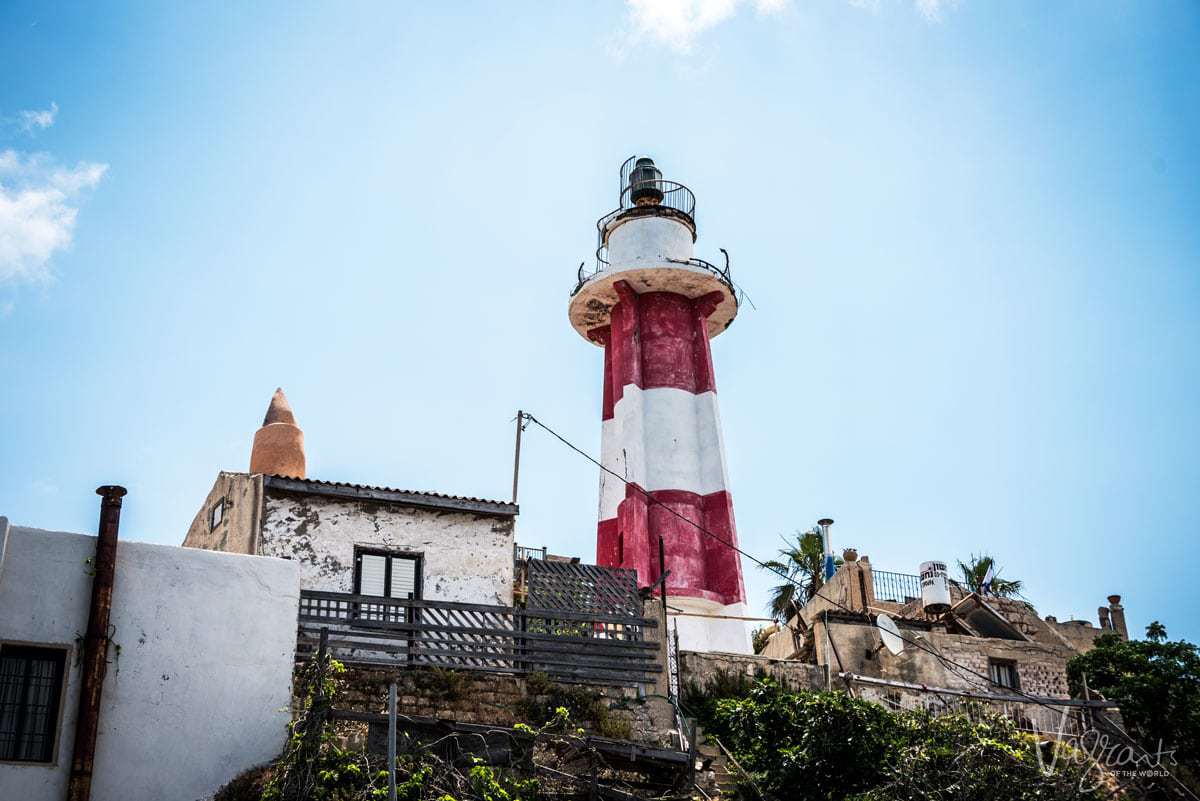
The historic city has been revived and is now one of the most vibrant places to enjoy the waterfront lifestyle of Tel Aviv.
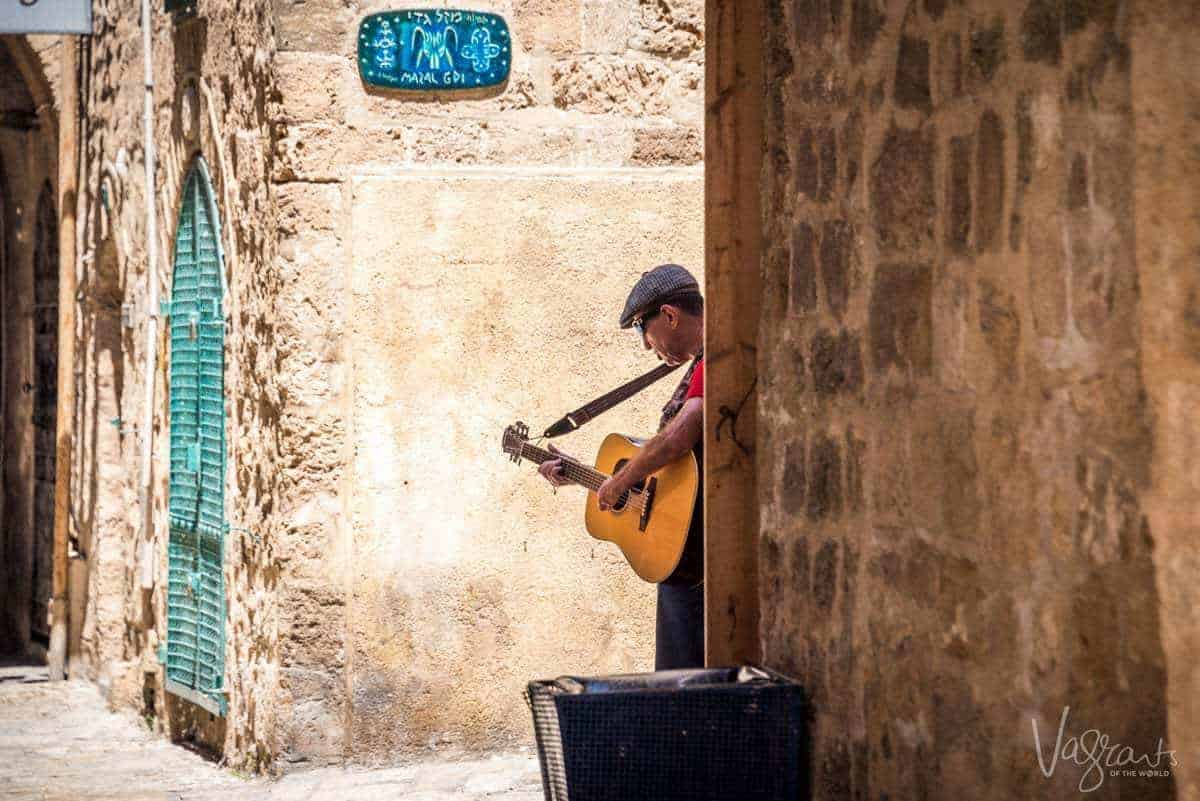
The biggest attraction of the northern seaport city of Haifa, other than its fabulous ocean vistas, is the Baha’i Shrine. The second holiest shrine of the Baha’i faith and the immaculately landscaped terraces of the Baha’i Gardens attract tourists and pilgrims alike. A serene monument to the founders of the religion and a World Heritage site.
At the foot of the Baha’i Gardens , you will find the German Colony, with shops, galleries and restaurants in 19th-century buildings. A lovely place to window shop, stop for coffee or a relaxing dinner.
Visiting the Baha’i Gardens
The Baha’i gardens are open daily between 9.00 am and 5.00 pm. The Baha’i Shrine welcomes visitors between 9:00 am and noon daily.
It is free to visit the gardens. Modest dress is expected.
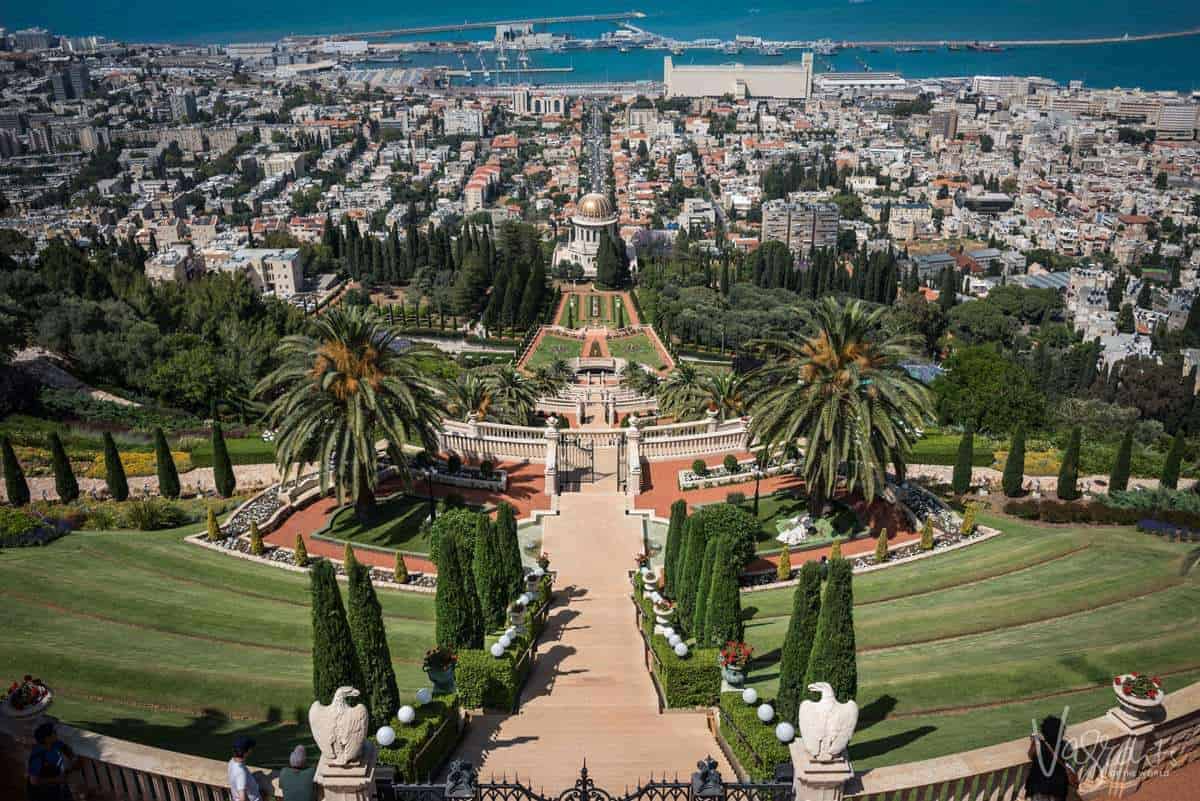
The Mystical City of Safed, Galilee
Safed is one of the four holy cities of Israel, the spiritual centre for Kabbalah and a renown artist colony. Many refer to Safed as a mystical place. It is also a very unique place to visit in Israel.
Located in the Northern District of Israel it is the highest city in the Galilee and Israel. Set in the dense pine forests of the Upper Galilee, overlooking Tiberias and the Sea of Galilee, t he old city of Safed is a tourist hot spot.
A city steeped in mystical symbolism. Narrow lanes where doors and windows are painted blue to confuse evil spirits. Along with devout Kabbalists, the old city has also been a haven for artists which created the Artists Quarter full of shops and galleries.
Safed is also loaded with museums and ancient synagogues. Remember to dress modestly.
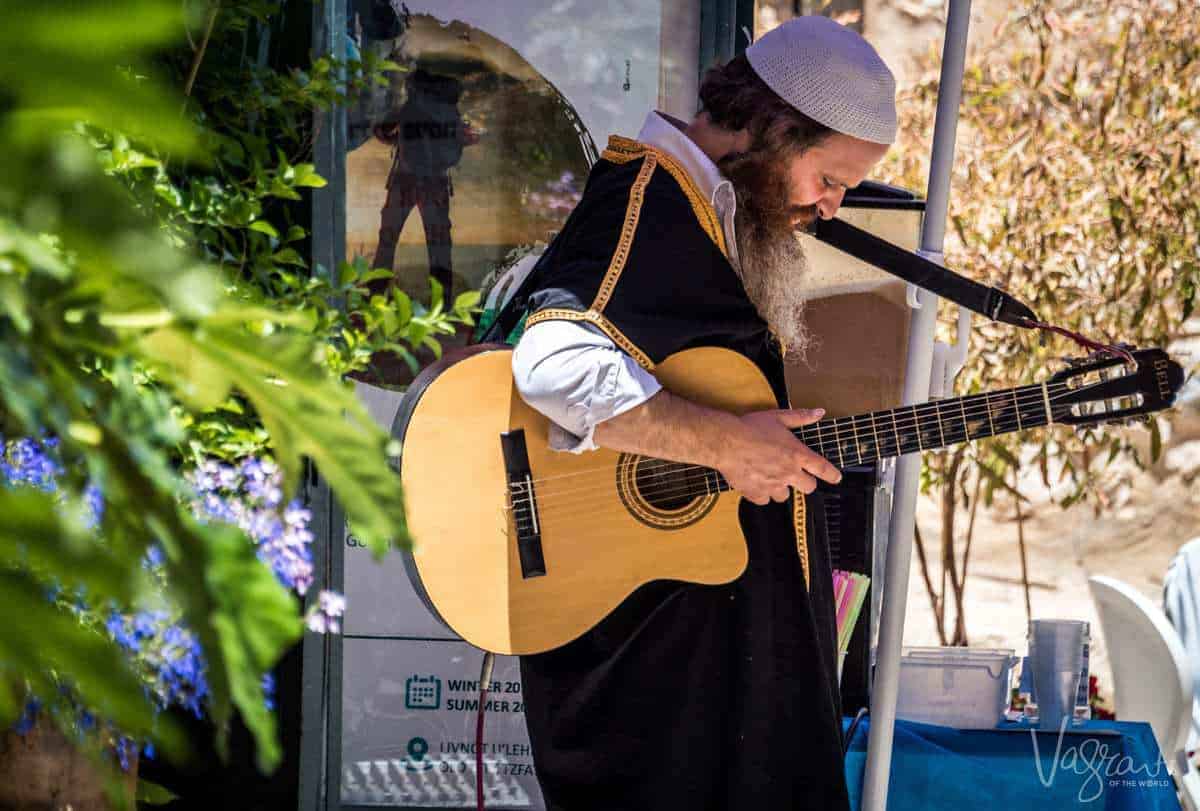
Village of Nazareth
The town of Nazareth is where Jesus spent his childhood; it now boasts the largest church in the Middle East – The Basilica of the Annunciation. The church houses a cave-dwelling said to be the home of Mary and the place where the arc angel Gabriel appeared to her.
Ten minutes from the centre of town you will find Nazareth Village, a recreation of Jesus’ hometown and farmlands where Jesus and his family would have lived and worked. Visitors are given a first-hand experience of how life during the time of Jesus would have been.
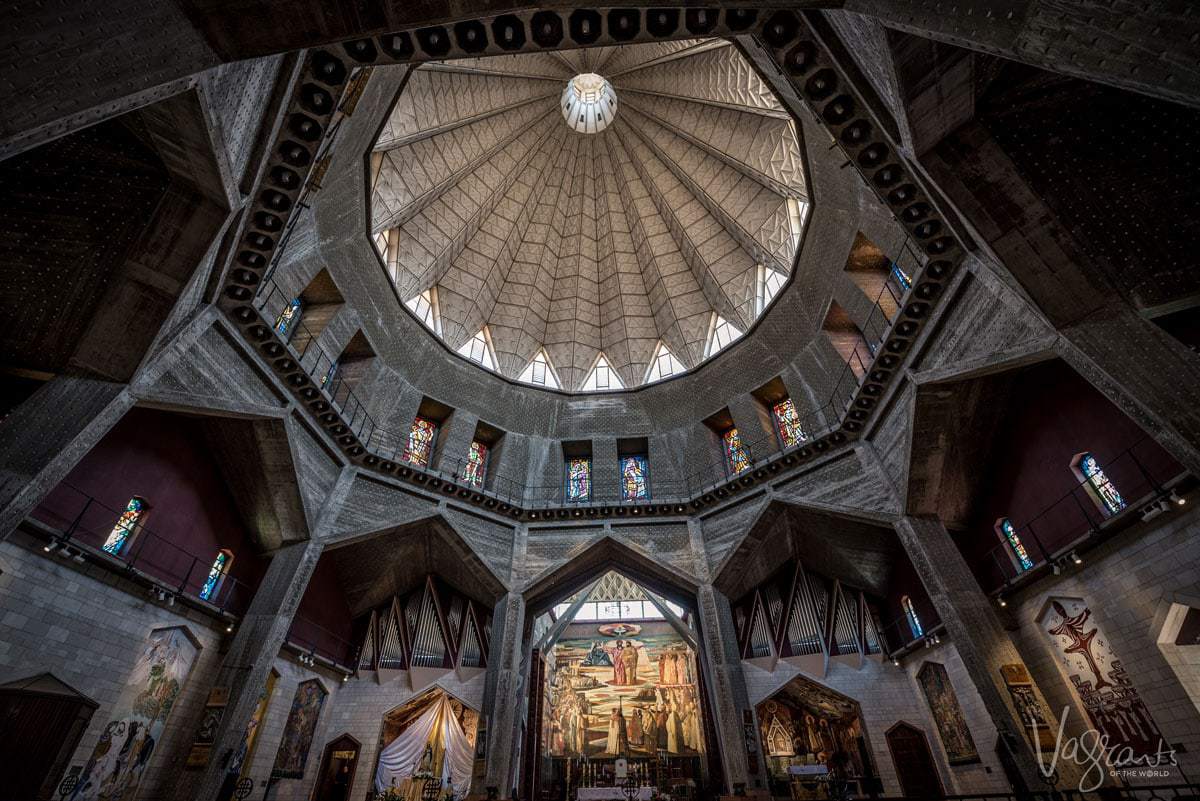
The birthplace of Jesus and one of the most popular destinations in Israel for Christian tourists who come to visit the Church of the Nativity. Only 20 minutes from Jerusalem, Bethlehem is a great half day trip.
While Bethlehem is close to Jerusalem getting there can be tricky, so it usually recommended visiting with an organised tour or guide .
Crossing the Border to the West Bank
Bethlehem is located close to the border in the West Bank which is part of the Palestinian Territories. Tourists may cross the border between Israel and the West Bank very easily. However, Israeli citizens cannot enter the Area A zone in the West Bank where Bethlehem is located. Entry into Israel for Palestinian citizens is also very restricted.
Hire cars from Israel may not cross the border nor can taxis from Jerusalem. There is a bus from the Damascus Gate in Jerusalem although this is quite slow. You can organise a private car if deciding not to go with a tour guide.
Important – You will need your passports for returning to Israel.
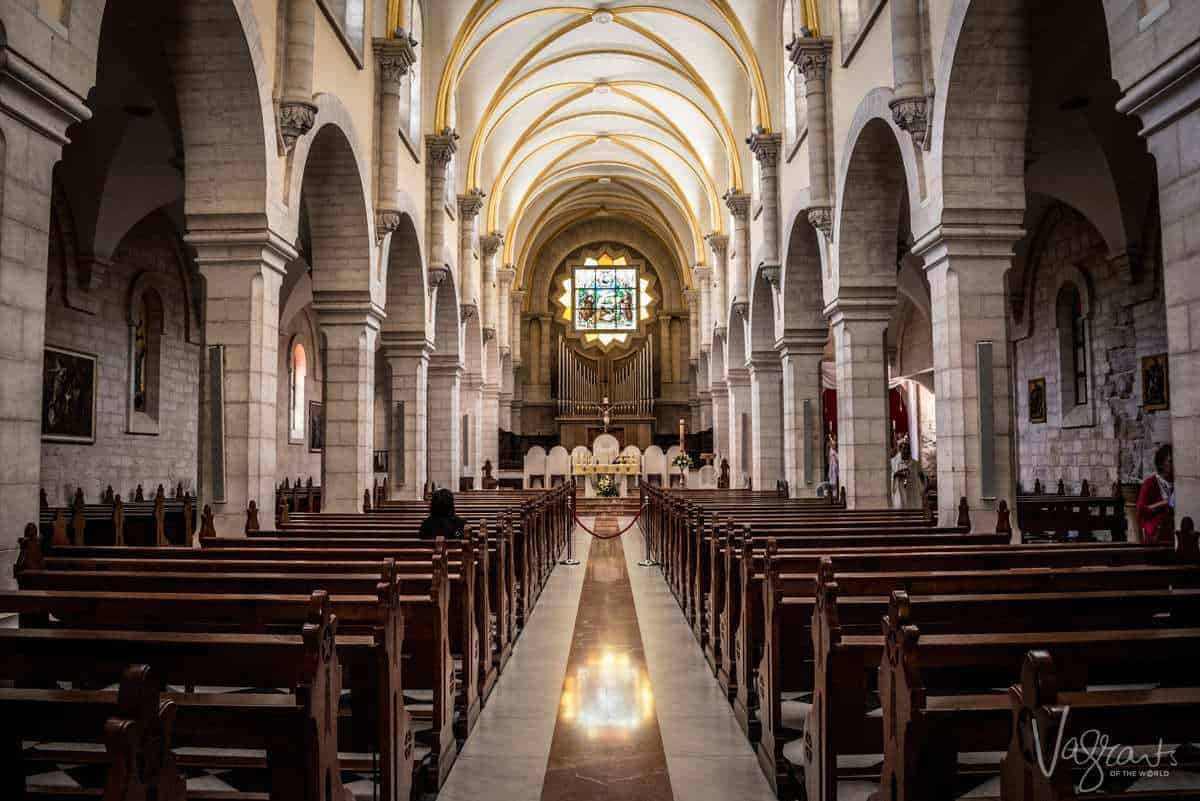
City of Acre
Acre is a port city on the Mediterranean coast in the north-west. While not high on the list for all tourists to Israel, Acre lays claim to one of the richest archaeological sites in the country. The walled city of Ottoman-era alleys and ancient souks cover an astoundingly intact Crusader city.
The Unesco World Heritage site has been compared to Pompeii as continued excavations are revealing a complete city.
Visiting the Old City of Acre
Check the official Old Akro site for visiting hours and prices as these will vary greatly depending on which sites you would like to visit.
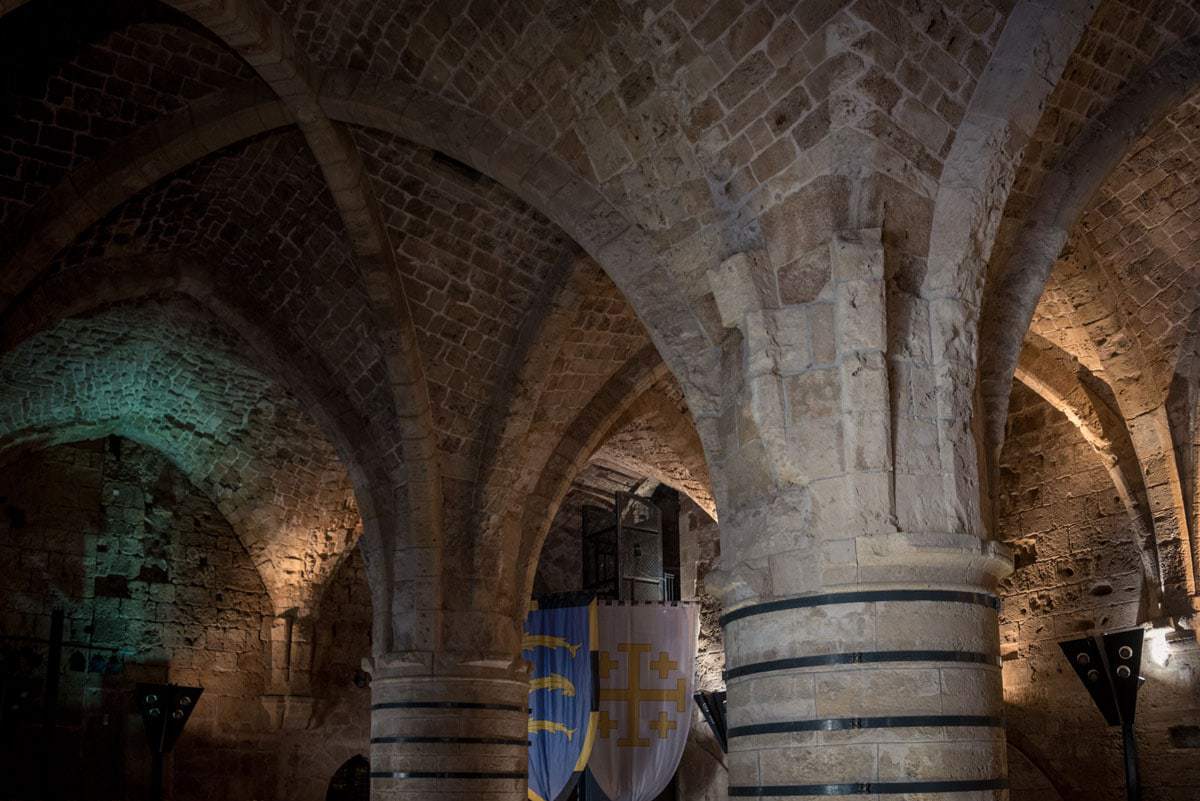
Beyond the World Heritage Site of the Crusader city, there is plenty to see in Acre. The colourful Ottoman souk still trades as it always has. There is the possibility for boat tours from the ancient port and lots of very popular Arabic style restaurants specialising in locally caught fish.
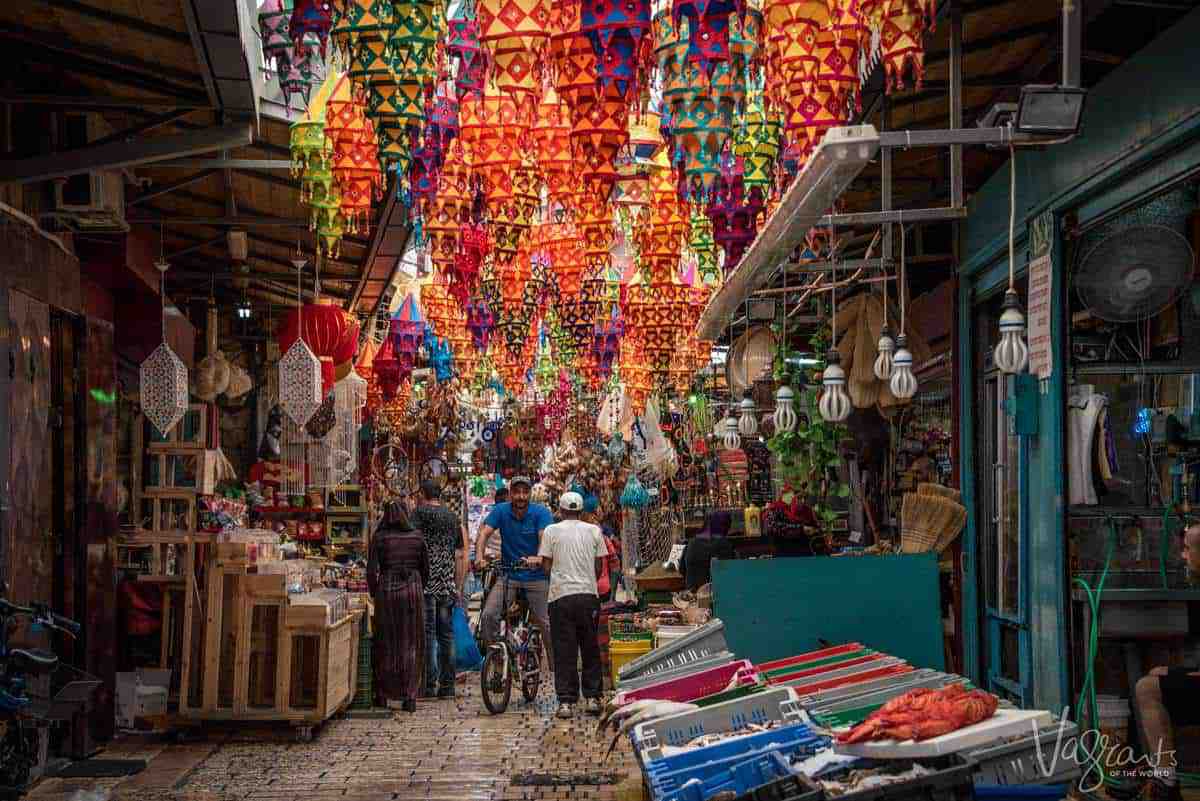
The Natural & Historic Beauty of Israel
Israel has an incredibly beautiful and varied landscape. The Mediterranean Coast, the lush green agricultural lands of the Golan Heights and the Dead Sea and the surrounding Judaean Desert. Israel’s natural beauty is as steeped in history and cultural significance as its ancient cities and towns.
Swim in the Dead Sea
The Dead Sea, one of the world’s natural wonders , is the lowest and one of the more unusual places on earth. Surrounded by desert mountains, it is also one of the most striking landscapes in Israel. Floating in the Dead Sea is one of those “Must Do” fun things in Israel and the perfect opportunity to rejuvenate and relax.
There are many spa hotels around the dead sea focused on the restorative powers of the world’s saltiest body of water. Float your cares away, whatever you do just don’t put your head under – Ouch!
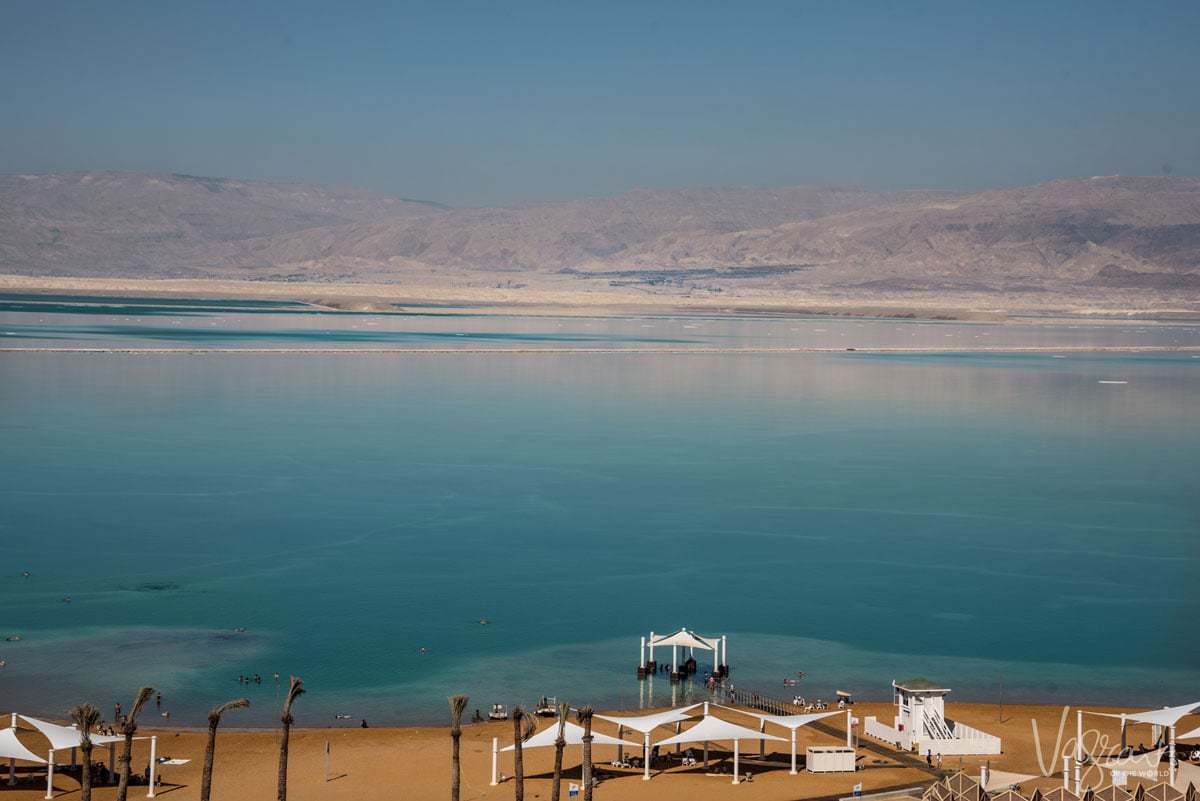
Hula Valley Wetlands
One of the most important nature reserves in the world, this unique ecosystem provides a critical resting place for migrating birds. Depending on the season, the wetlands provide sanctuary for thousands of migratory birds such as cranes, storks, pelicans and flamingos.
Hula Valley Wetlands attracts bird watching and nature enthusiasts from all over the world.
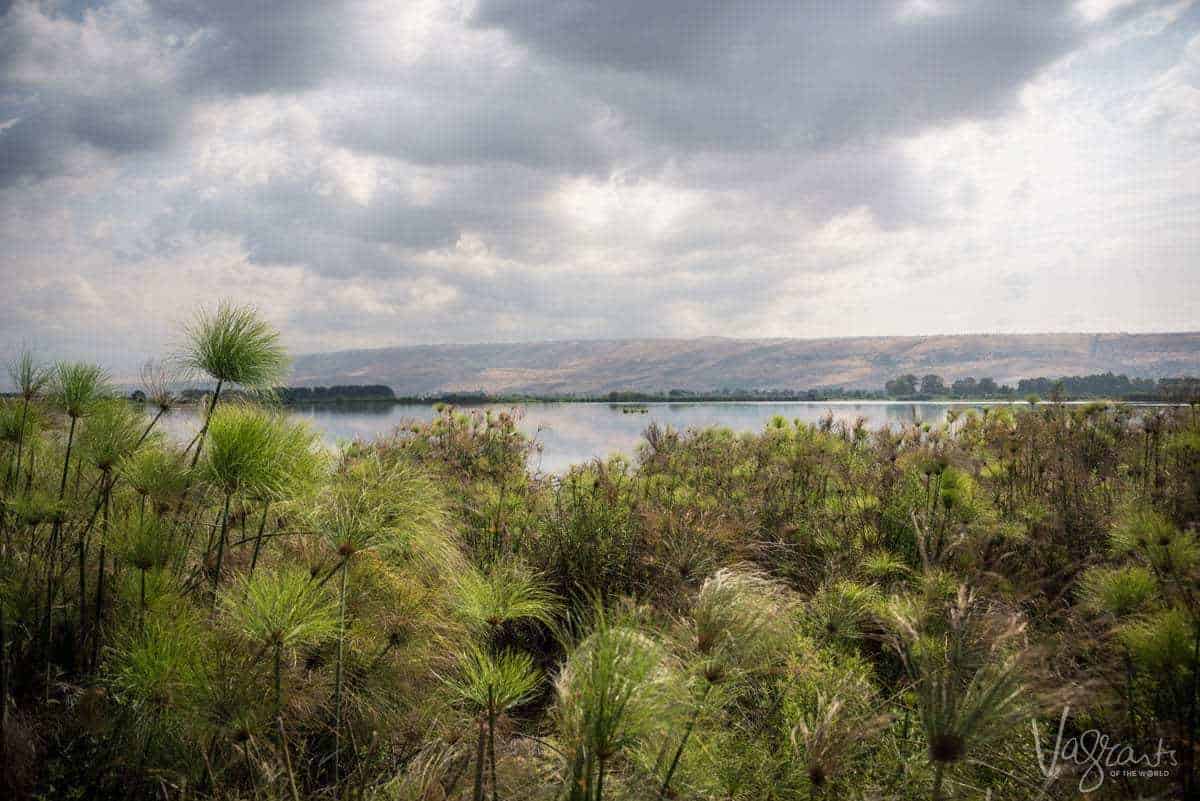
Jordan River Baptismal Site
Winston Churchill said the Jordan River was “a narrow stream with great PR”. The river has great significance for both Christians and Jews as it was the site where the Israelites crossed into the Promised Land and where John the Baptist baptised Jesus Christ.
The baptismal site “Yardenit” on the Jordan River attracts over half a million tourists every year and is a must-visit place for any visitor or pilgrim. Many are pilgrims coming to be baptised in the same place where Jesus Christ was baptised.
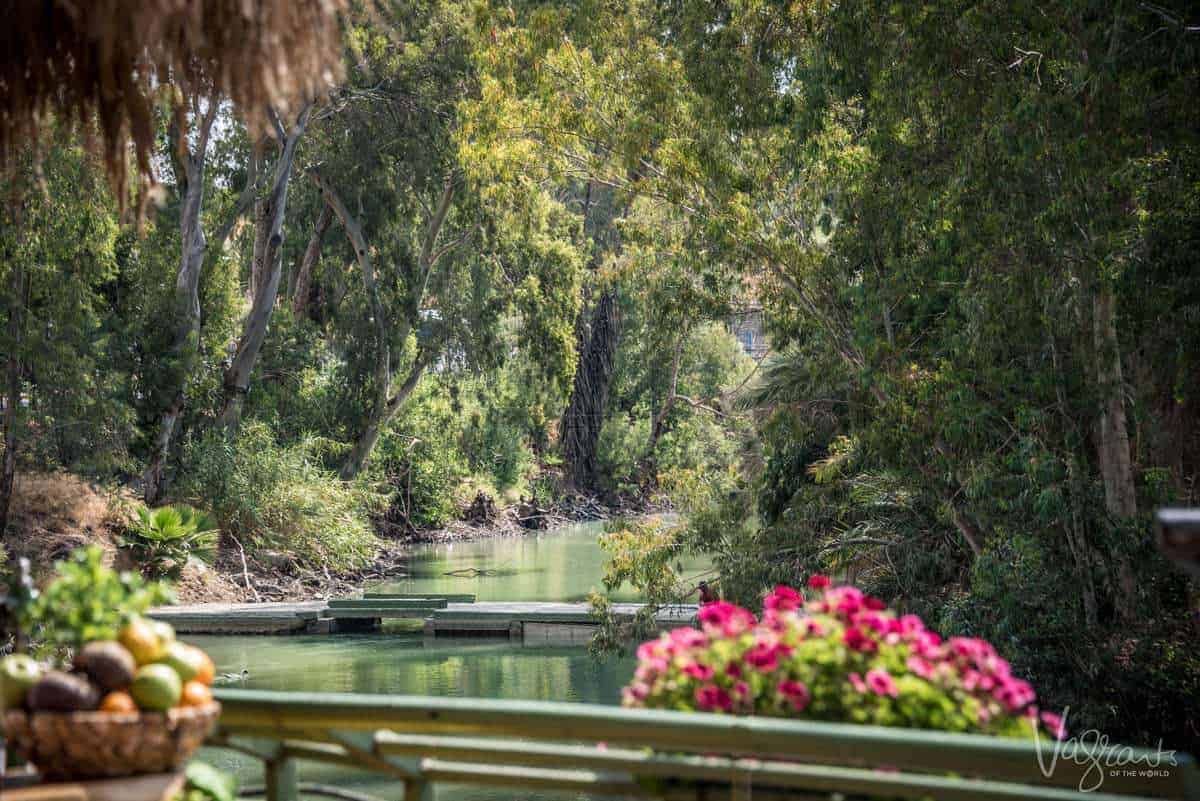
Rosh HaNikra
At the northernmost tip of Israel at the border of Lebanon are the gleaming white cliffs of Rosh HaNikra. Descend by cable car, the steepest in the world, to discover astonishing underwater grottoes and sea caves.
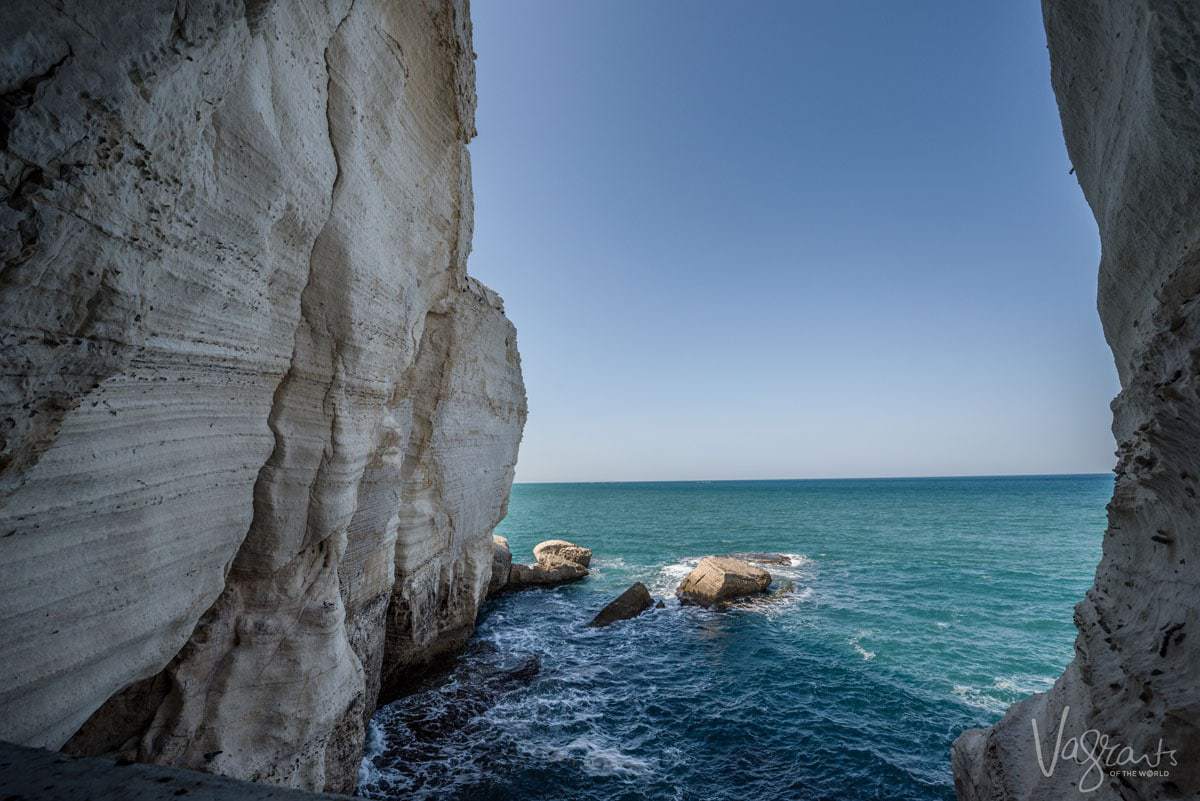
Visiting Rosh HaNikra
- Summer Weekdays: 9:00 am – 6:00 pm
- Winter Weekdays: 9:00 am – 4:00 pm
- Friday Holiday Eves:9:00 am – 4:00 pm
- Saturdays and Holidays:9:00 am – 6:00 pm
- Holiday Eves: 9:00 am- Midday
Entrance Fee:
- Adult: 45 NIS (~$12.50 USD)
- Child: 36 NIS (~$10.00 USD)
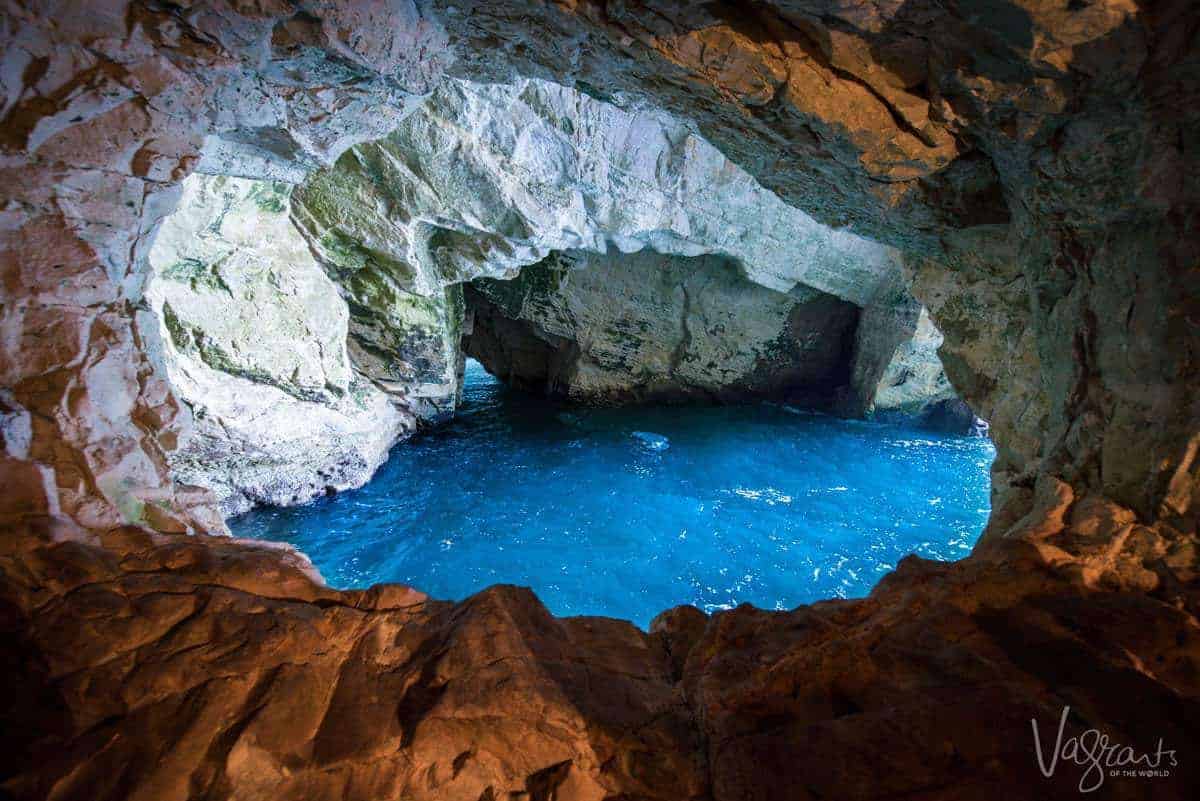
The Dead Sea from Masada
Masada is one of Israels biggest tourist attractions. Take a hike to the top of the fortress of Masada for one of the most beautiful views in Israel. For the less adventurous, the cable car provides a lovely way to take the view on the ride up.
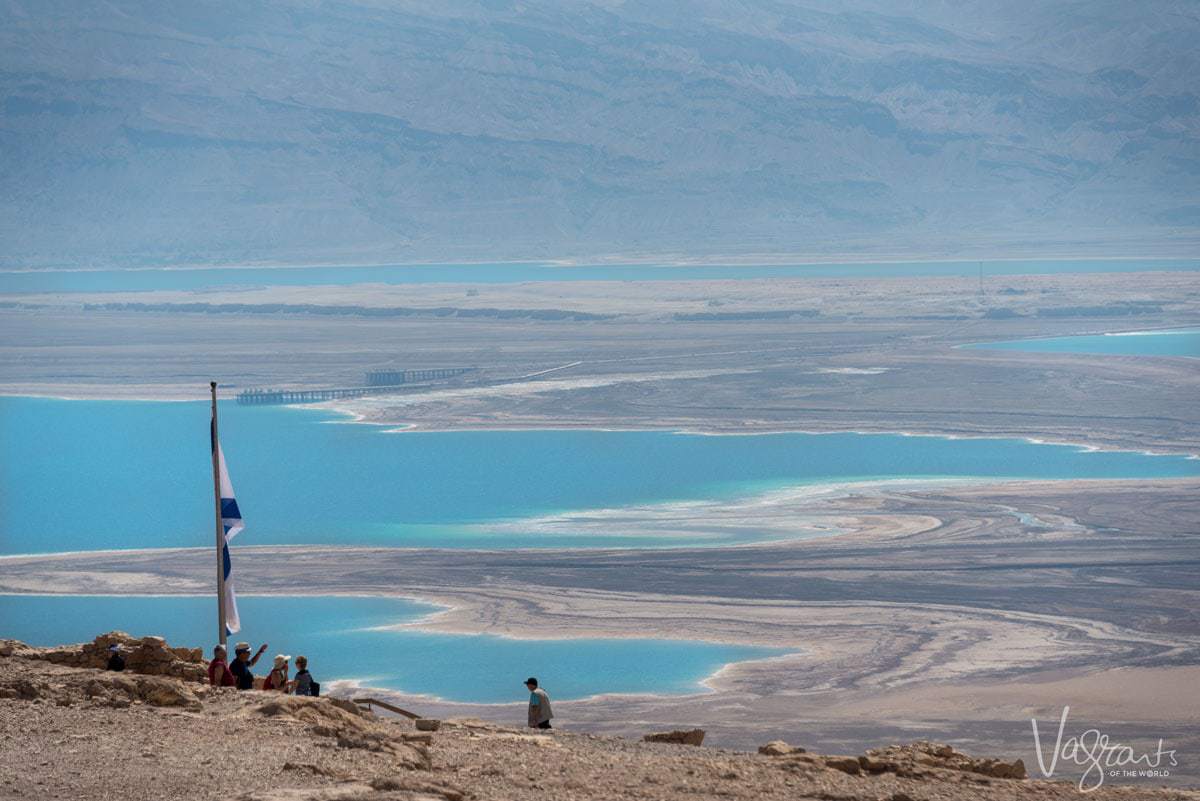
Masada is one of the greatest archaeological sites in Israel and, perhaps, in the world. The fortress of Masada, built by Herod the Great was where 1000 Jewish rebels and their families chose suicide over surrender to the Romans in 73 AD.
The remains of the fortress of Masada are well-preserved, but perhaps the most impressive is the ruins are King Herod’s Palace covering three rock terraces. Among the other buildings at the site, is an impressive Roman-style bathhouse decorated with murals and colourful mosaic floors.
Visiting Masada
Masada is very high, so many will take advantage of the cable car. However, those who would like to climb Masada can ascend by foot via the winding “snake path” . It has become somewhat of a tradition to climb Masada at sunrise for the spectacular view of the Moab Mountains and the Dead Sea.
Opening Times
- April – September: 8.00 am – 5.00 pm
- October – March: 8.00 am – 4.00 pm.
- On Fridays and holiday eves the site closes one hour earlier than above although the park is open on Saturdays (Shabbat)
The Snake Path Hours:
- Opens approx. One hour before sunrise although will be closed in extreme weather.
Cable Car Hours:
- Sat – Thurs: 8.00 am – 4.00 pm.
- Friday and holiday eves: 8.00 am.-2.00 pm.
- Yom Kippur eve: 8.00 am – Midday
Entrance Fee:
- Eastern Dead Sea side entrance plus cable-car two ways: Adult: 76 NIS | Child: 44 NIS
- Eastern side entrance and climb Snake Path: Adult: 29 NIS | Child:15 NIS
- Masada National Park Combination Ticket -entrance and cable-car one way: Adult: 58 NIS | Child: 30 NIS
- Cable car one-way: Adult: 29 NIS | Child 15 NIS| Cable-car round trip: Adult 47 NIS | Child: 29 NIS
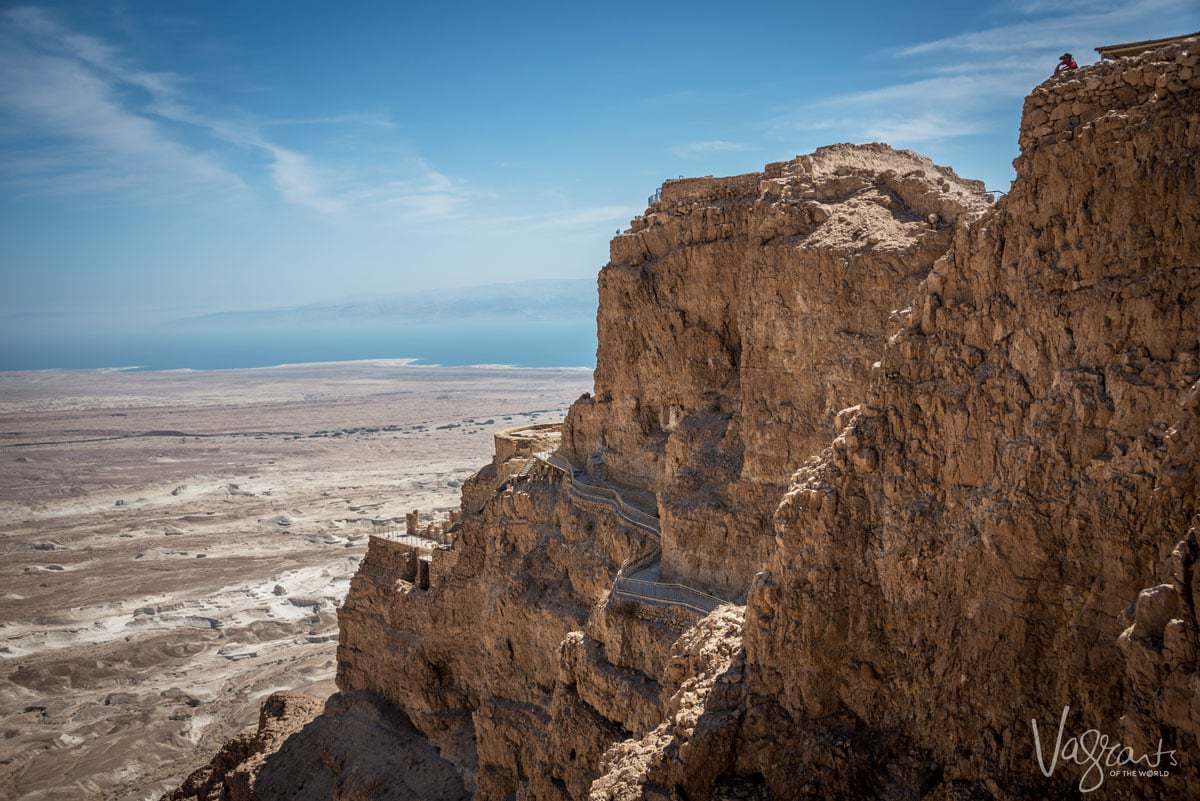
Golan Heights
The Golan Heights in the far north of Israel is famed for its lush scenery, stunning natural attractions and fertile wine regions. Golan Heights is where people of Isreal escape for a reprieve from the cities to indulge in good food and wine and the great natural beauty of the area.
From Mount Bental you can stop for coffee and enjoy views across Israel’s Galilee, Lebanon and the flat plains of Syria. At the site, you can see the former Syrian bunkers and gain some understanding on the strategic importance of the Golan Heights and its recent history.
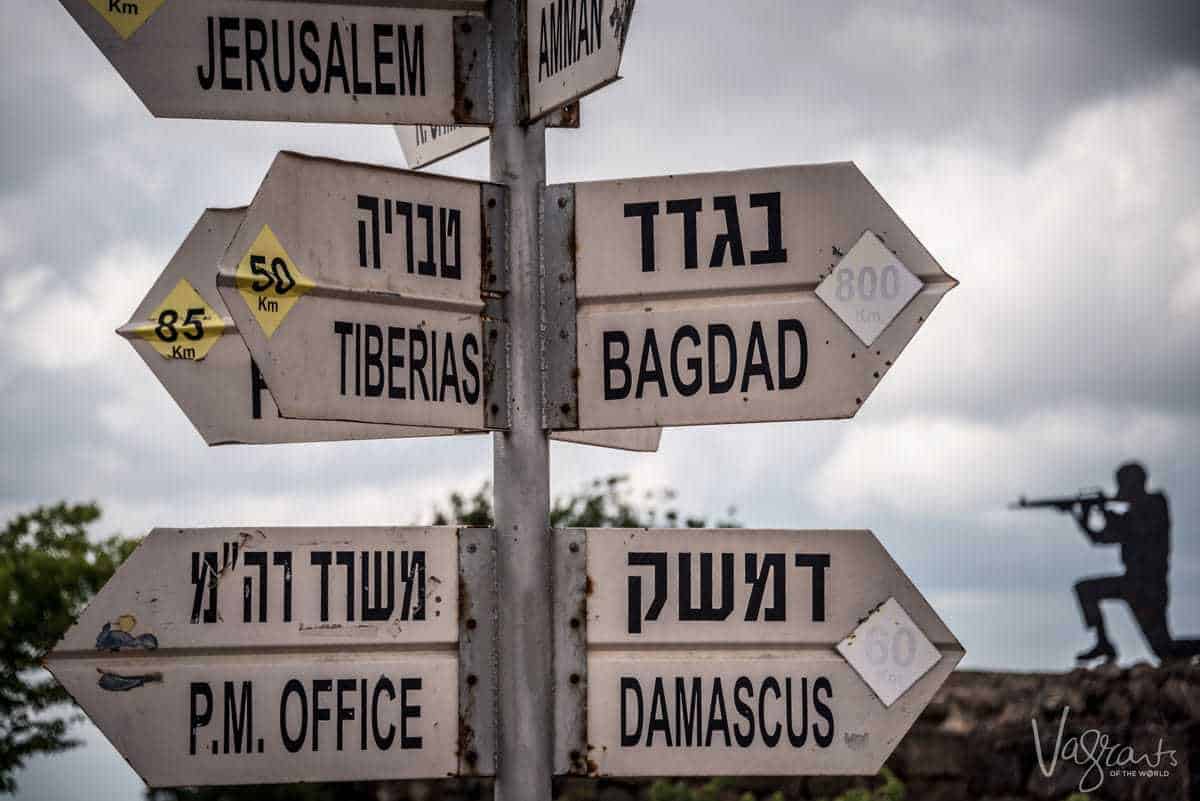
Beit Alfa Synagogue
Located at the foot of the northern slopes of the Gilboa mountains near Beit She’an the 5th-century Beit Alpha synagogue is famous for its miraculously well preserved mosaic floor. The intricate artistic detail vividly portrays the Binding of Isaac, the Zodiac, and the Temple of Jerusalem.
Visiting Beit Alfa National Park
- Summer: Sunday – Thursday and Saturday: 8:00 am – 5:00 pm | Fridays and holiday eves: 8:00 am – 4:00 pm
- Winter: Sunday – Thursday and Saturday: 8:00 am – 4:00 pm | Fridays And holiday eves: 8:00 am – 3:00 pm
- New Year’s Eve and Passover Eve: 8:00 am – 1:00 pm
- Yom Kippur: 8:00 am – 1:00 pm
- The park entrance closes one hour before the times listed
Entry Fees:
- Adults: 22NIS
- Child: 9 NIS
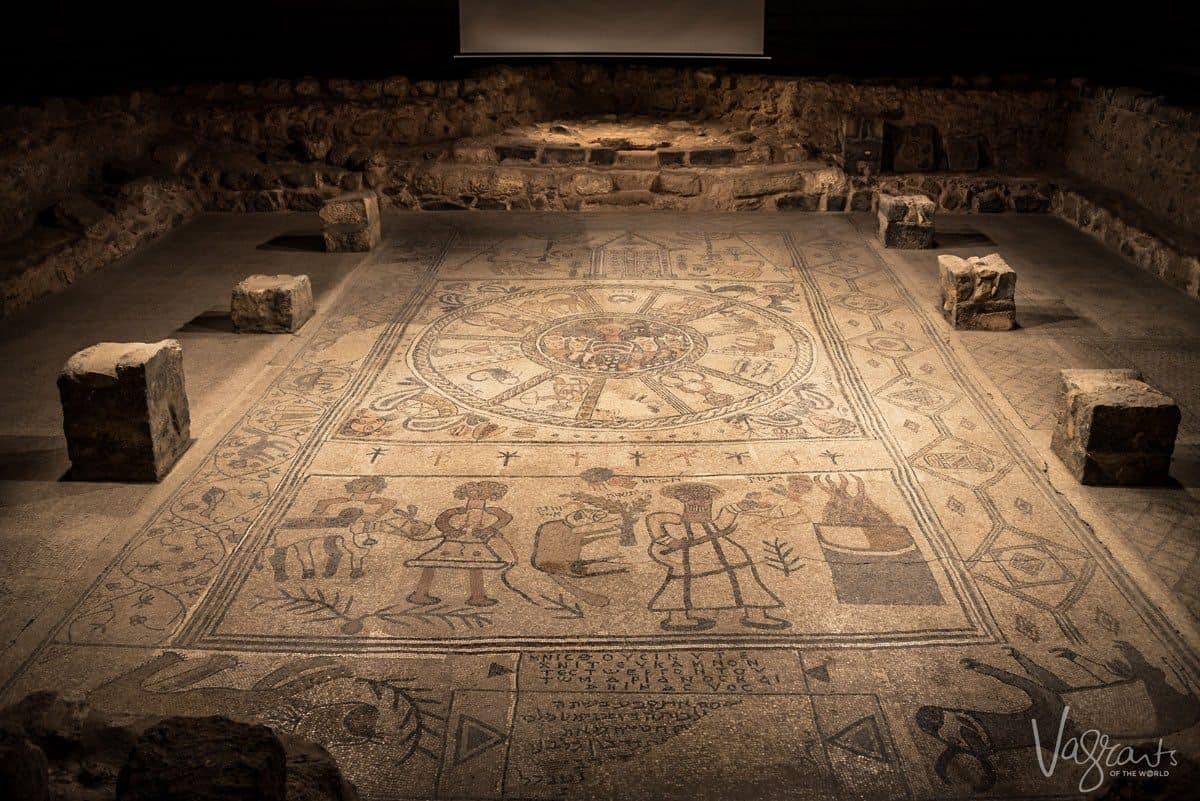
The Mount of Beatitudes
The Mount of the Beatitudes is believed to be the setting for Jesus’ most famous speech – the Sermon on the Mount.
Overlooking the northwestern shore of the Sea of Galilee, it offers beautiful vistas of the lake and across to the cliffs of the Golan Heights. The chapel and gardens of the Mount of the Beatitudes offer one of the most beautifully serene places in Israel.
Visiting the Mount of the Beatitudes
Hours for the gardens on the Mount of Beatitudes and the Church
Summer: Every day – 8:30 am and 12:00 pm and 14:30 pm to 5:00 pm
Winter: opening hours are the same for winter. Closing time is at 4.00 pm
Entry is free although there is a charge for parking.
Ancient City of Caesarea Ruins
North of the country, halfway between Haifa and Tel Aviv on the Mediterranean coast, is Caesarea, named in honour of Augustus Caesar. A magnificent and prestigious port city established by King Herod the Great, during the Byzantine period. The port ruins include a restored Roman Amphitheatre which hosts concerts in the summer months, a Hippodrome horse racing arena, and impressive Roman Aqueducts.
Underwater Museum Dives
Caesarea National Park also has the world’s only underwater museum where you can dive through the underwater ruins of the ancient city.
The City of Caesarea
The Old City of Caesarea has a range of boutiques and restaurants. The new town boasts a luxurious neighbourhood of villas and the Caesarea Aqueduct Beach which is renowned as one of the best beaches in Israel.
Visiting Caesarea
Caesarea can be difficult to visit without a car, so many will visit by way of a tour to Caesarea .
- The museum is open- Summer April-September- 8.00 am – 6.00 pm | Winter until 4.00 pm.
- The site itself and restaurants remain open until later into the evening.
- Adult: 38 NIS (~$10.50 USD)
- Child: 23 NIS (~$6.50 USD)
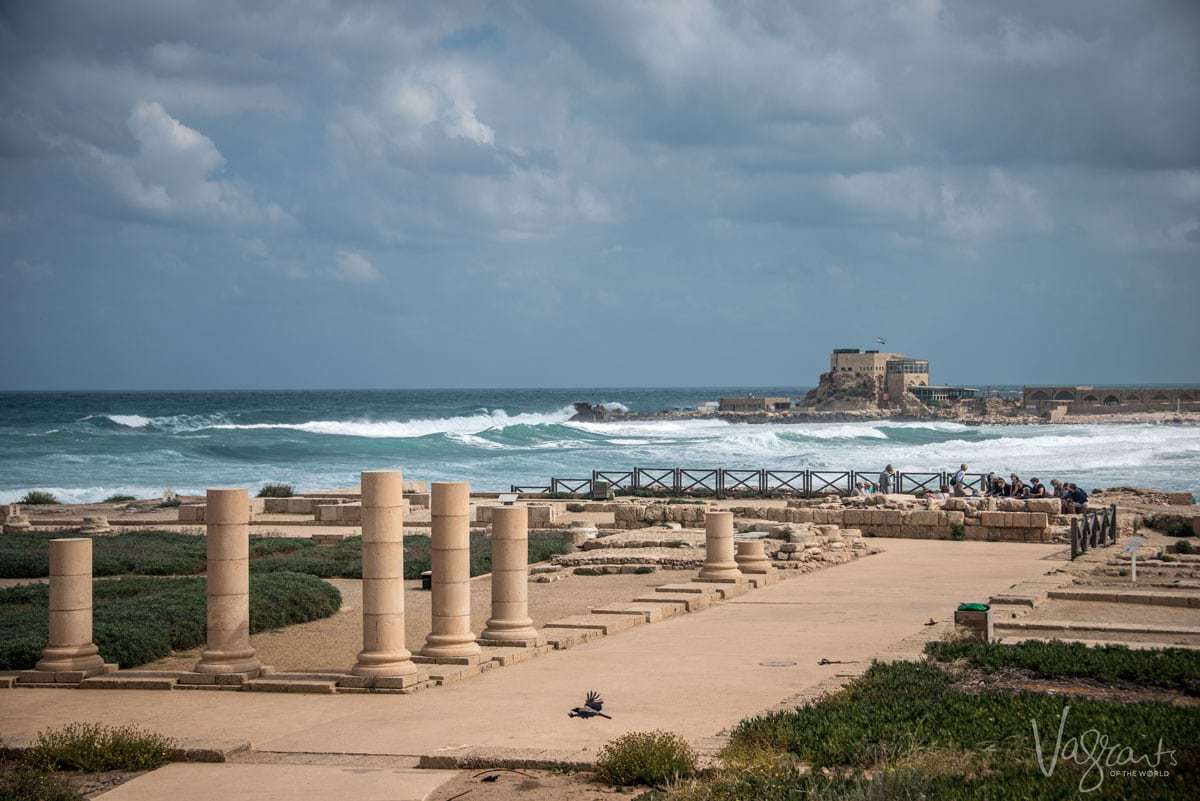
Atlit Detention Camp
During the British Mandate, “Illegal” Jewish immigrants fleeing from Nazi persecution in Europe were incarcerated at Atlit Detention Camp 20 km’s south of Haifa.
The site tells their astonishing story of survival and the conditions survivors endured during their transport to Israel.
Visiting Atlit Detention Camp
- Sunday -Thursday: 9.00 am to 5.00 pm
- Friday: 9.00 am to 1.00 pm
- Adults: 32 NIS
- Child and Seniors: 27 NIS
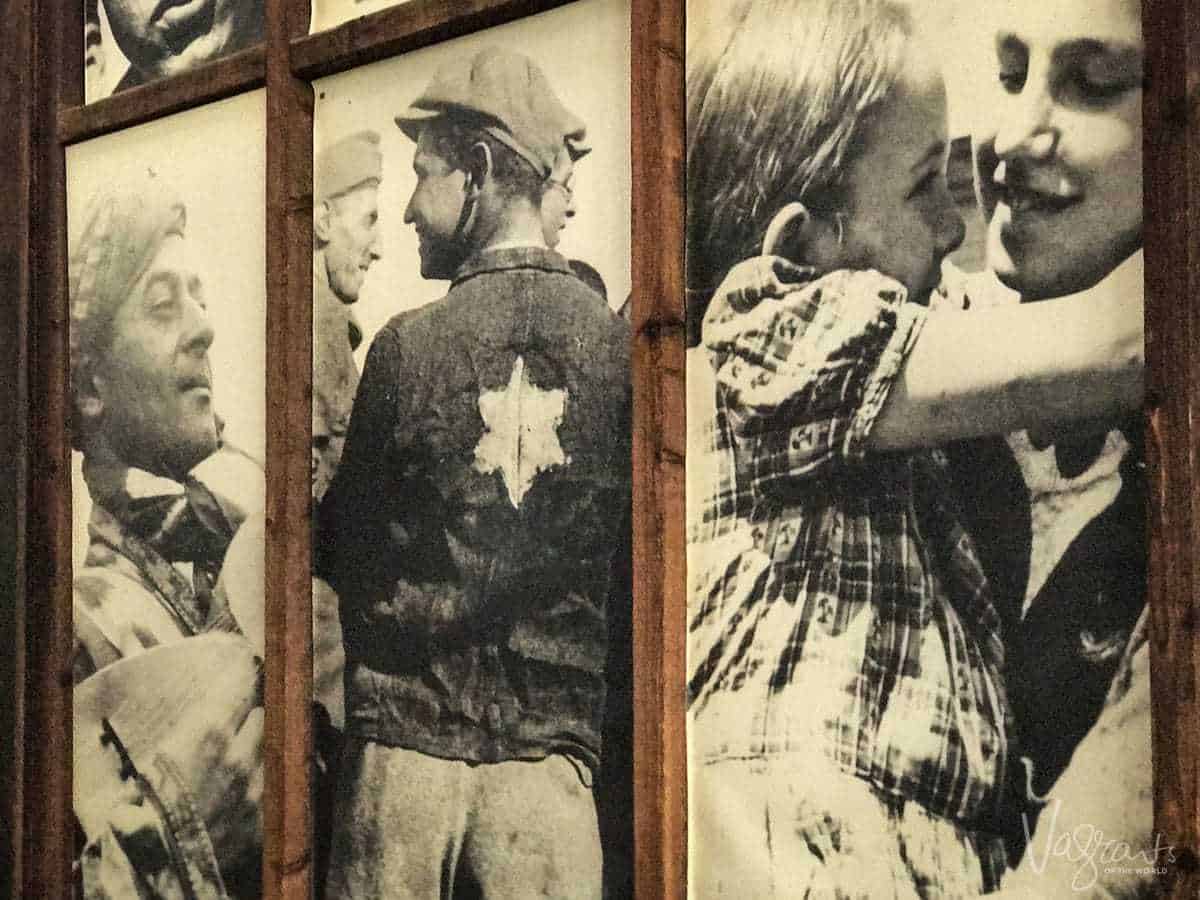
Beit She’an National Park
Beit She’an is one of the oldest cities in Israel. Located in the Galilee region of northern Israel where the Harod Valley and Jordan Valley meet, Beit She’an offers the most extensive archaeological site in Israel, with some of the best-preserved ruins in the Middle East.
Ongoing excavations and restorations in the large archaeological park dating back to the Roman and Byzantine period reveal an ancient city from the time of King Saul.
Visiting Beit She’an
- April-September: Saturday-Thursday 8.00 am-5.00 pm, Friday 8am-4pm
- October-March: 8am-4pm
- Adult: 38 NIS (~$10.50 USD)
- Children: 23 NIS (~$6.50 USD)
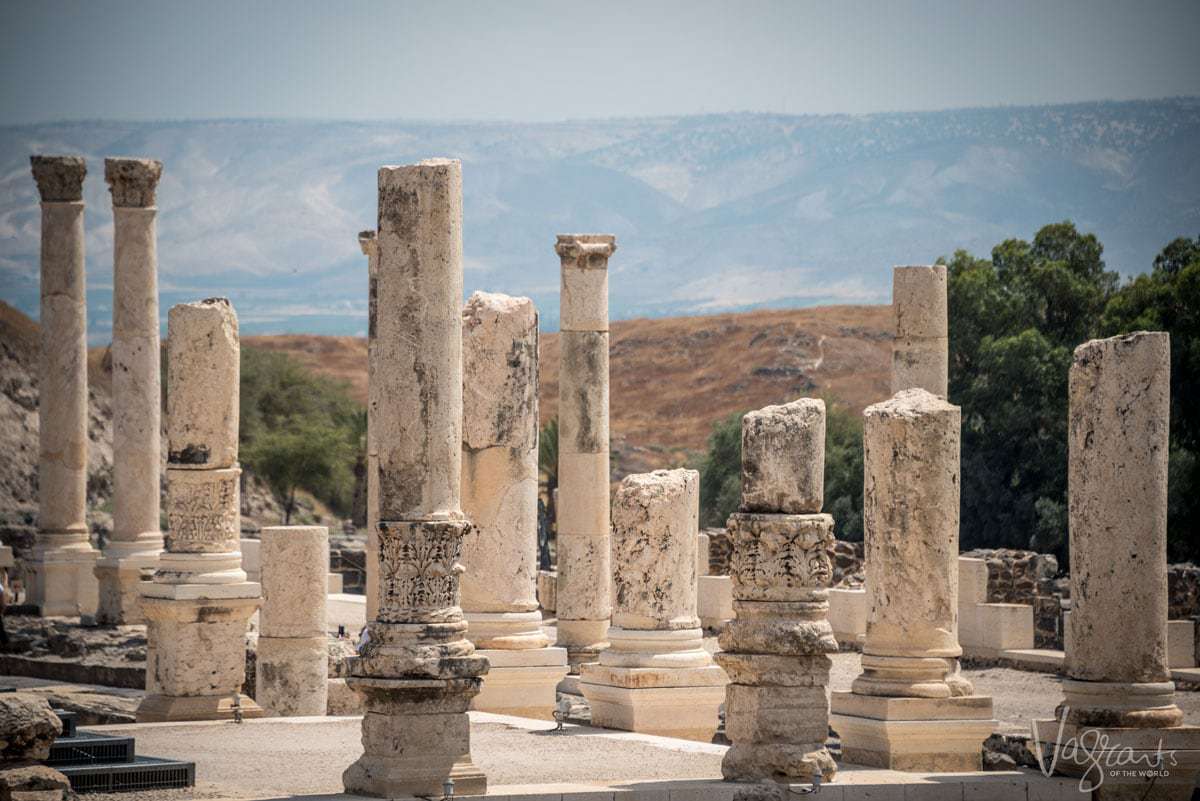
The Tastes of Israel
Israel has one of the most exciting culinary landscapes we have come across. Cuisine in Israel is predominantly a mix of Mediterranean and Middle Eastern influences. Although, immigration over the years has also had a significant influence on Israeli cuisine.
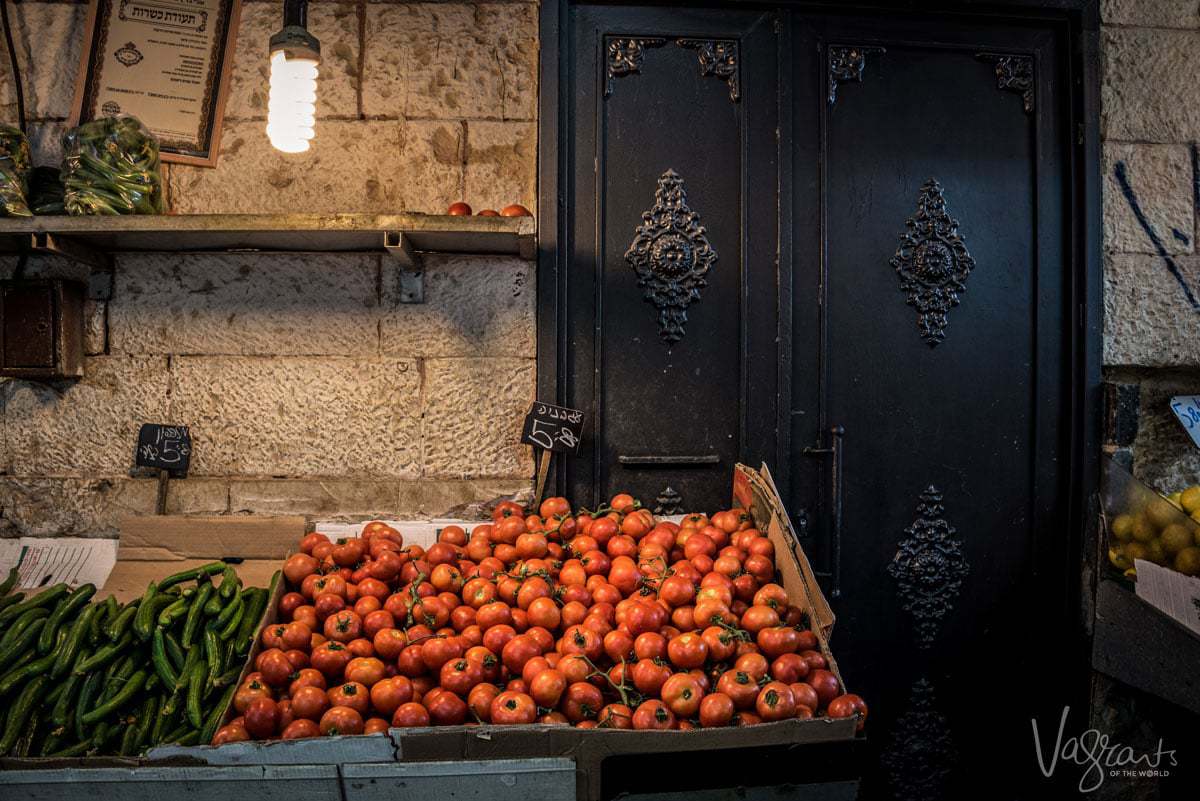
Dishes from Eastern and Central Europe, Russia, North Africa and Turkey have played a role in influencing cooking styles and fashions. Religious beliefs and holidays also play a vital role in Israel’s culinary repertoire.
For centuries spices have been traded as valuable commodities, they are no less important today, and integral to Middle Eastern cuisine.
30 Dishes You Must Try in Israel
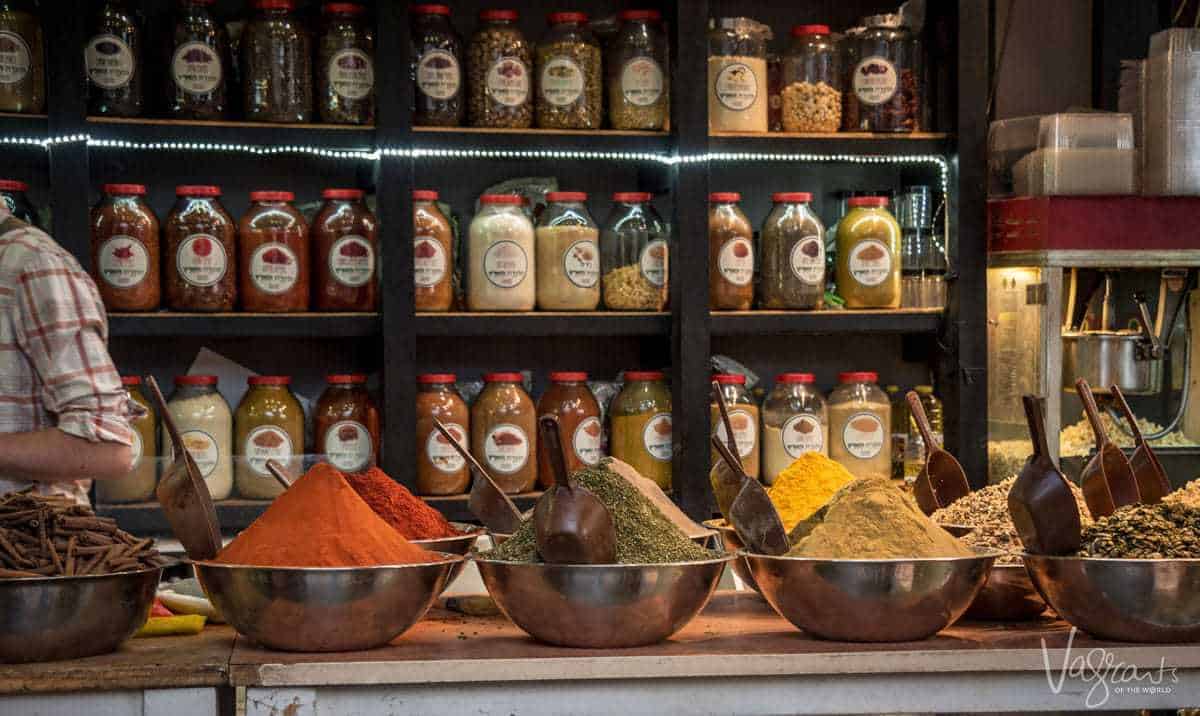
Small family restaurants in the Machane Yehuda Market cater to droves of local shoppers and tourists with large pots of home-cooked meals prepared as a daily menu.
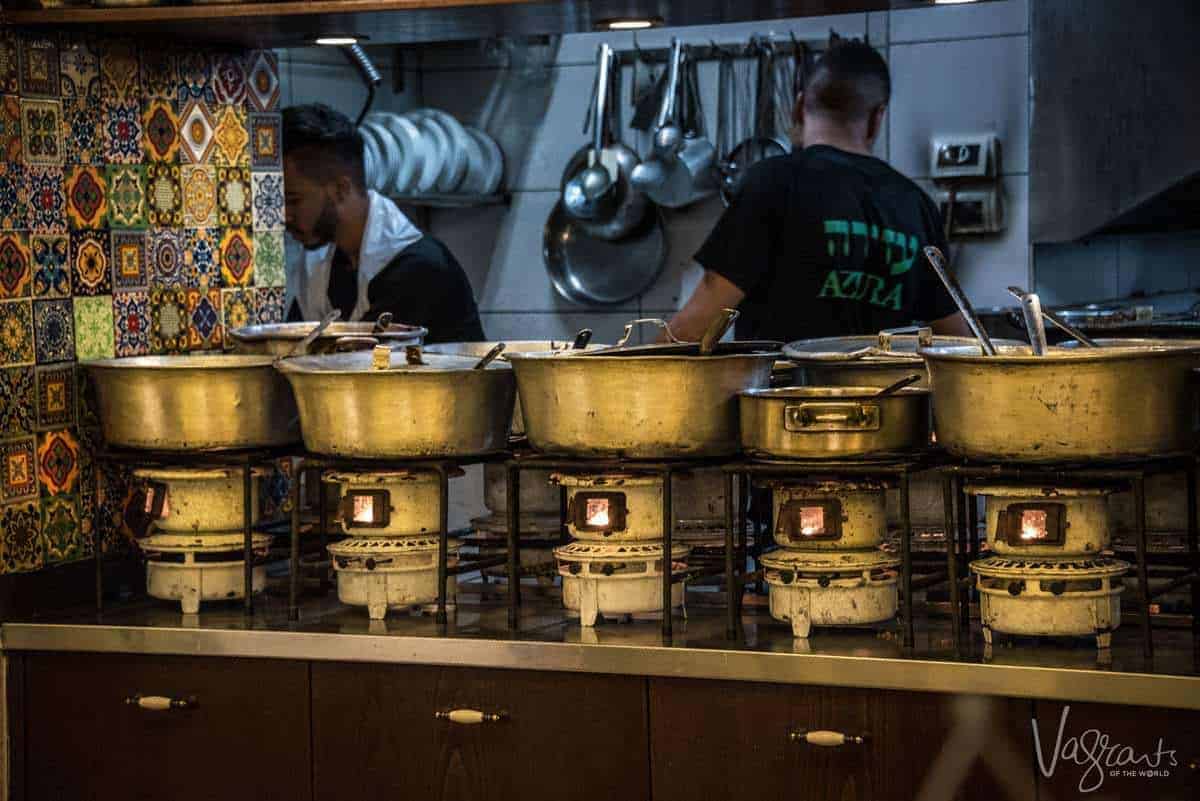
Like many cultures, bread is a staple bought fresh each day from the local baker. Middle Eastern and Mediterranean cuisine favour flatbread and pitas. You will often find bread and pastries sprinkled with Za’atar a favourite herb and spice mix used throughout the Middle East.
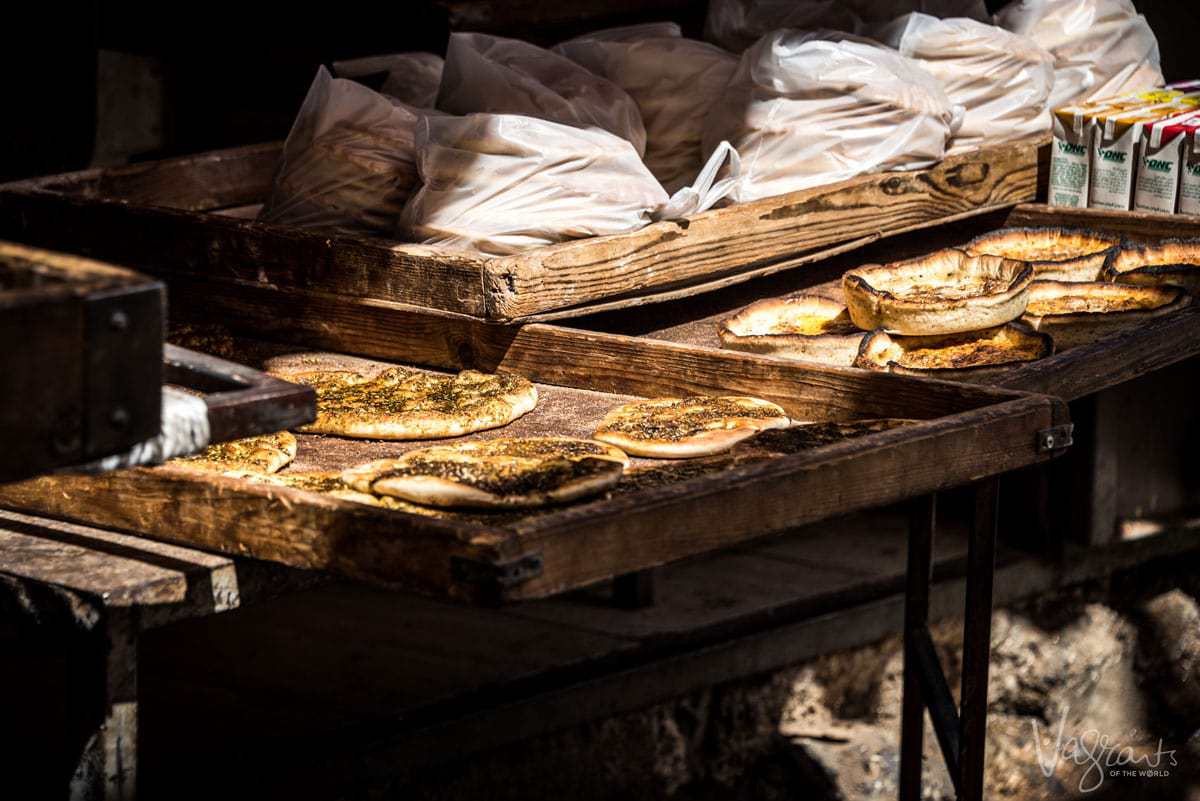
Small Dishes
Lots of small dishes are typical in Israel, like this lunch prepared in a Druze Village.
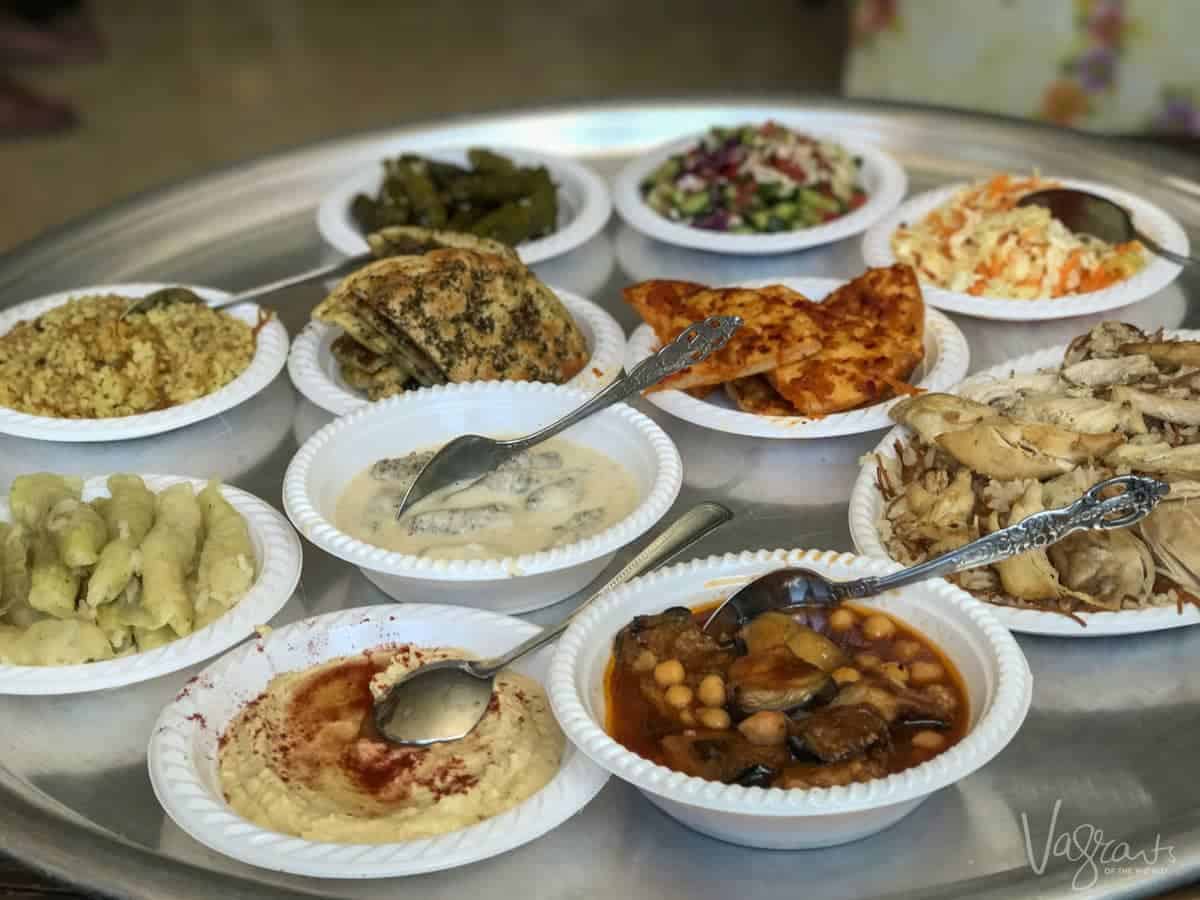
The Fascinating Culture of Israel
The culture of Israel is as eclectic as its people and history. While we may automatically look towards long-held traditions for insight into a culture, it is in the day to day life where a country’s culture shines through.
As a meeting place between East and West, Israel has a unique cultural atmosphere. Whether it be the da ily life in an ancient marketplace, young people enjoying a beer at the new place to be seen or the devout stocking up on supplies in preparation for Shabbat. A blend of influence from the Middle East and traditions brought with immigrants from Europe brings together an interesting mix of cultures in Israel.
From inside the walls of the old city of Jerusalem to the heady nightlife of Tel Aviv, daily life in Israel is as normal as it is fascinating.
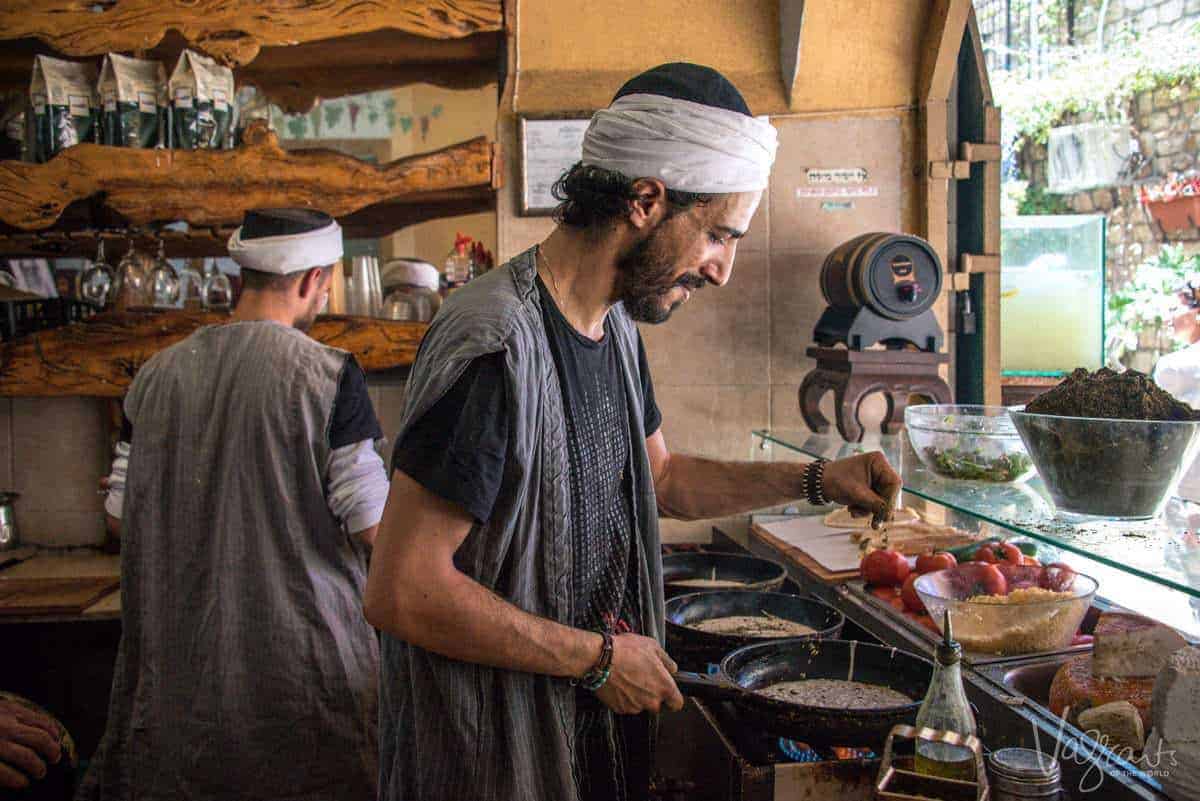
Israel Travel Facts
Is it safe to travel to israel.
Understandably, anyone planning to visit Israel wants to know; is it safe to travel to Israel. Despite the complexity of the current political situation, there are just so many fascinating places to visit in Israel; people aren’t shying away from travel to Israel just yet. In fact, travel to Israel is on the increase.
We would always advise caution and recommend keeping an eye on any travel warnings for Israel and be aware of any areas of potential risk.
We would also recommend considering a guided tour of Israel. Aside from having the added security of a local guide, an experienced guide will only enhance your experience. We go into this in more detail in our article about small group guided tours of Israel.
Languages: Hebrew, Arabic, English. Most people in Israel speak very good English.
Currency: New Israel Shekel (NIS)
Best Time to Visit Israel:
- Low Season: Winter – Dec–Feb.
- Shoulder Season: Fall – Oct, Nov | Spring – Mar-Jun.
- High Season – Summer- Jul- Aug.
Always remember the best time to visit Israel will be dependant on what you want to see and do. But always be mindful when planning your trip to Israel that you take into account the major Jewish celebrations such as Passover, Hanukkah and Yom Kippur.
The best time to visit Jerusalem
April through to May and from October through to November is the best time to visit Jerusalem. The weather is milder and there are fewer tourists which makes the city much more enjoyable and the main sites easier to access.
The best time to visit Tel Aviv
March through to April and September through to November is the best time to visit Tel Aviv. Once again the weather will be more agreeable and fewer crowds.
Cheapest time to visit Israel
Spring and Fall are most probably the most reasonably priced times to visit Israel. These times are quieter tourist wise and hotel prices are cheaper. Airfares are more reasonable from November to early March.
Main Airport: Ben-Gurion Airport (Tel Aviv)
How we Travelled Israel.
We spent four nights in Jerusalem and then joined a small group tour of Israel – The 12 Day Israel, Ancient & Modern Culture Tour with Discovery Tours by Gate 1 Travel.
Prices start at $2349 for land only packages and $3319 for land and air if travelling to Israel from the US. Check Discovery Tours by Gate 1 Travel for a more comprehensive list of pricing and inclusions.

- Philippines
- Czech Republic
- Scandinavia
- Historical Sites
- Solo Travel Paris – How to make the most of the French Capital
- Solo Travel Brussels – The Ultimate Guide
- Solo Travel Belgium – The Ultimate Guide
- Solo Female Travel in Poland – The Ultimate Guide
- Morocco Travel Tips – Is Morocco safe for Female Solo Travel?
- Solo Travel Greece – The Ultimate Guide
- Solo Travel Philippines – Everything you need to know
- The Ultimate Solo Female Travel Guide to England
- Solo Travel Israel – The Ultimate Guide
- Cambodia Solo Female Travel Guide
- Work with Me
Popular Posts
Highlights of the holy land israel.
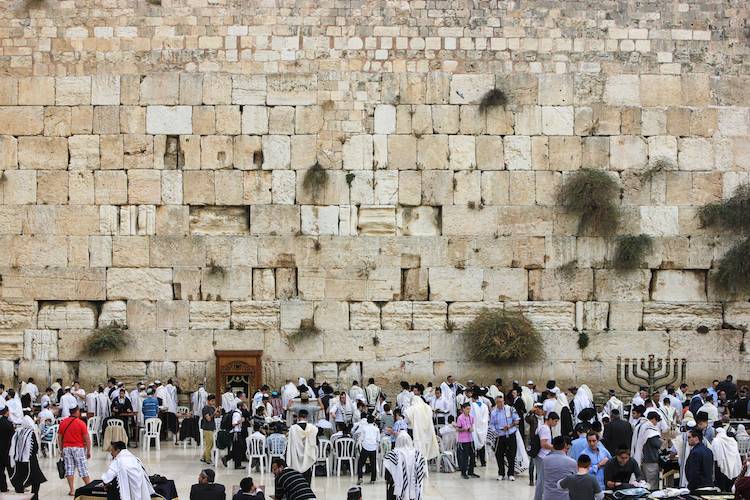
My top place to travel for temple seeking, as you probably know, is Israel. There are many reasons to visit the Holy Land due to its stunning historical and religious sites for three main world religions: Judaism, Christianity and Islam.
Never in my life have I visited a city so spiritually and archaeologically astounding as Jerusalem itself. Archaeologists are continually excavating to find new discoveries, many of which confirm the footsteps of Christ and Biblical canon.
I found it to be safe and easy to visit the Holy Land, although a little on the expensive side (you may want to read about a budget for Israel ). I would highly recommend the Holy Land for anyone interested in religious history and looking to combine this with solo travel. Here are my highlights of the Holy Land, Israel:
Visit the Holy Land – Highlights of Israel
1. jerusalem old city.
The Old City of Jerusalem itself is home to three key religious sites. The Western Wall is worshipped by Jews as the oldest remaining temple wall, from the second temple period.
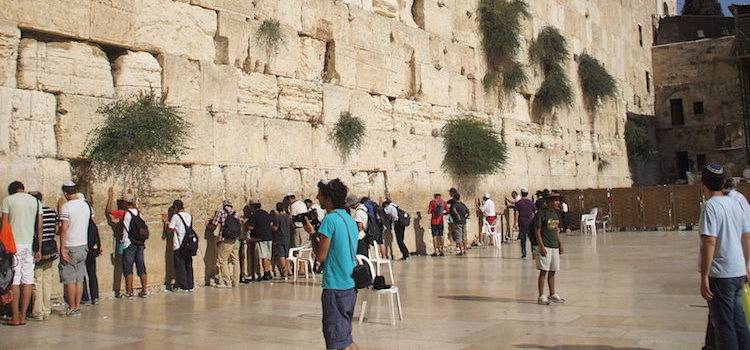
Temple Mount itself is seen by Jews as the spot of both the first and second temples, but this area is also claimed by Muslims for the Dome of the Rock – the golden guilded dome is built on the spot where Muslims believe that Mohammed’s night journey to heaven commenced on this exact location.
Jerusalem is also home to the Al-Aqsr Mosque, the third holiest site in Islam.
#blueskies over the #AlAqsr #Mosque in #Jerusalem. #islam #tbexjlm #travel #sacred #religion #travelgoals #photography A post shared by Templeseeker (@templeseeker) on Apr 2, 2017 at 4:23am PDT
Christian pilgrims flock predominantly to the Church of the Holy Sepulchre, the Church built on the spot of Golgotha, where Jesus was crucified, and also housing the empty tomb of Jesus.
Domes of the #Church of the #HolySepulchre. #jesus #bible #christian #god #christianity #lord #pray #christ #holyspirit #jesuschrist #Saved #jesuslovesyou #travel #goals A post shared by Templeseeker (@templeseeker) on Aug 9, 2017 at 2:12pm PDT
The Old City of Jerusalem itself is divided into four quarters: The Christian Quarter, the Jewish Quarter, the Armenian Quarter and the Muslim quarter. The contrast in cultures is to such an extent when you transfer between quarters, that you almost feel like you are walking from Italy to Morocco within minutes.
2. Mount of Olives
The Mount of Olives , to the East of the Old City, is home to the largest and most important Jewish graveyard in the world. It offers the opportunity to visit key scenes from the passion of Christ including the garden of Gethsemane (Church of All Nations) and the place of Jesus’ weeping. You can also visit the Church of Mary Magdalene (it’s not open every day, so check times in advance.
After exploring the Mount of Olives I highly recommend that you return to the Old City via the Kidron Valley , which host ancient Jewish tombs and is the valley that the Bible states Jesus walked through to his arrest.
3. City of David
Few tourists realise that the real ancient city of Jerusalem does not lie within the city walls, but at the City of David at the base of the Southern slope of Mount Moriah. This 3000 year old archaeological site unveiling David’s fortress was the Jerusalem mentioned in the Bible. The area is still continually being excavated and restored today.
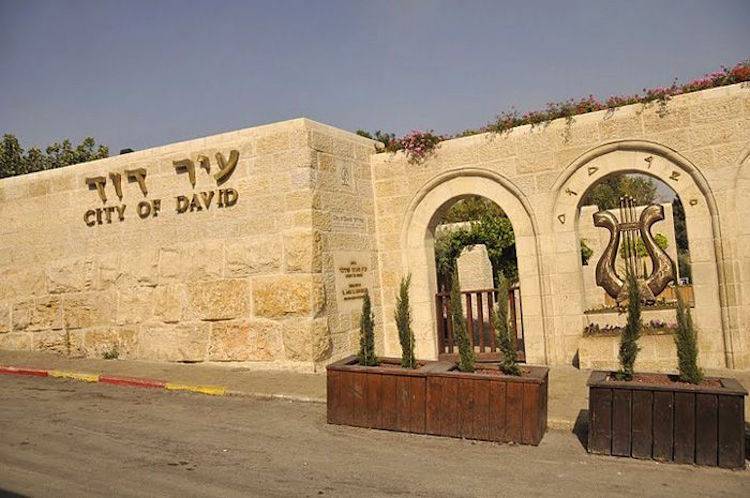
4. Mount Zion
When you visit the Holy Land, be sure to explore Mount Zion to discover Dormition Abbey (shrine to Mary), the room of the Last Supper and the Church of St Peter in Gallicantu. You will also find a statue of David and David’s tomb (sacred in Judaism).
5. Bethlehem – Birthplace of Christ
Visit Bethlehem, the birthplace of Christ to visit the Church of the Nativity, the Milk Grotto and the field of Shepherds. It is also a chance to explore Palestine (West Bank) and see the contrast from Israel. Spend at least a full day exploring Bethlehem. If you have time, you can always visit or stay in the Banksy Walled Off Hotel .
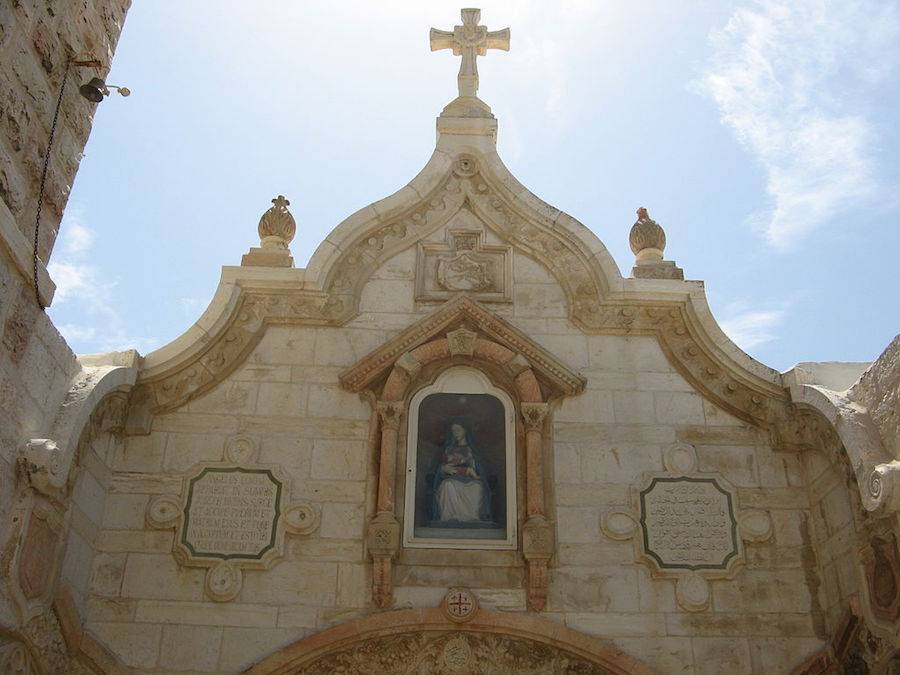
6. Jericho – The World’s Oldest City?
Visit Jericho near the River Jordan to experience what is arguable the oldest city of the world. Drink from Elijah’s spring and explore ancient ruins excavated from the stone age, bronze age and iron age. If time allows, you can visit the Monastery of Temptation built into the cliff and overlooking Jericho. The cave here is said to be that where Jesus spent 40 days and 40 nights in the wilderness.
7. Qumran – Dead Sea Scrolls
Visit Qumran to find the secret of the Dead Sea Scrolls , discovered by a Bedouin shepherd over 2000 years after they were buried. The Dead Sea Scrolls were ancient texts written in Hebrew by the Essenes, a Jewish sect who arrived at Qumran in the second Century BCE. Archaeological excavation of the area revealed the whole site of the Essenes settlement including a kitchen, aqueduct and Mikveh (ritual baths for bathing).
New #blog out today on the secret of the #DeadSeaScrolls in #Qumran. #israel #tbex #tbexjlm #travel #archaeology #DeadSea ??? A post shared by Templeseeker (@templeseeker) on Mar 22, 2017 at 1:14am PDT
I travelled to Bethlehem, Jericho and Qumran with Tourist Israel .
Masada is an ancient archaeological site located on the edge of the Judaean desert. It’s famous for the final battle between the Roman Empire and the Jewish rebels. Masada was occupied by King Herod held back in 31 BC.
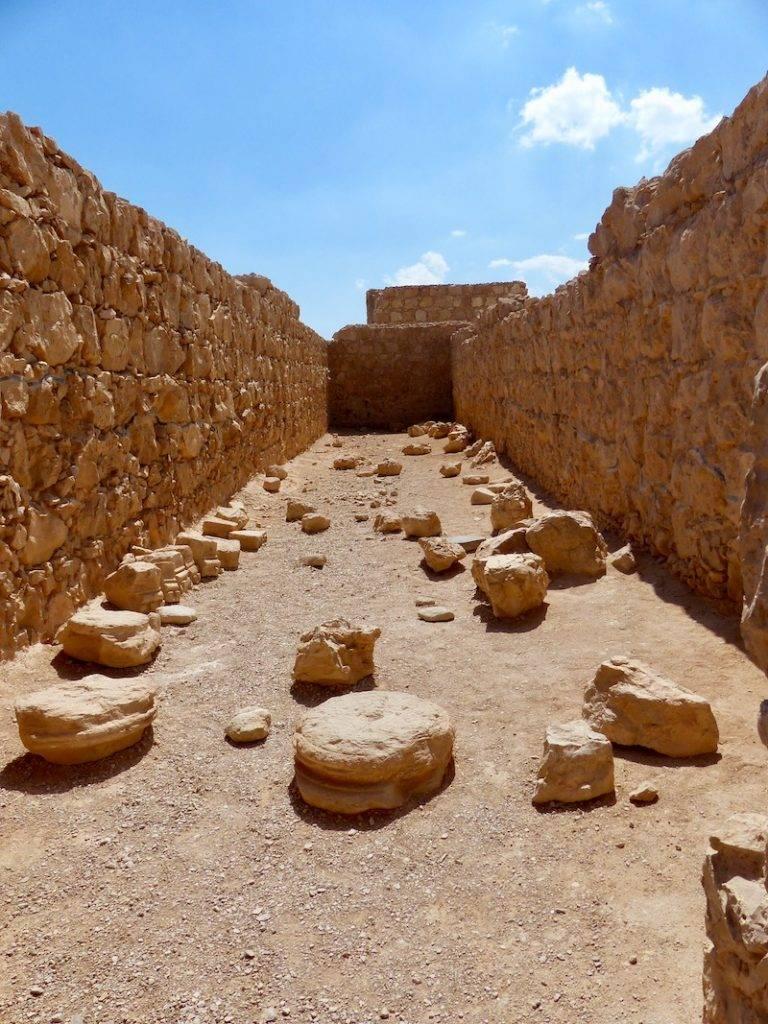
9. Jaffa Old Town
When staying in Tel Aviv, be sure to visit the Old Town of Jaffa , around an hours walk along the promenade from the modern city. The Old Town contains Biblical snippets, including Simon the Tanner’s house, where St Peter supposedly raised Tabitha from the dead. Also, be sure to visit the Seafront Mosque, the Armenian Church and St Peter’s Franciscan Church.
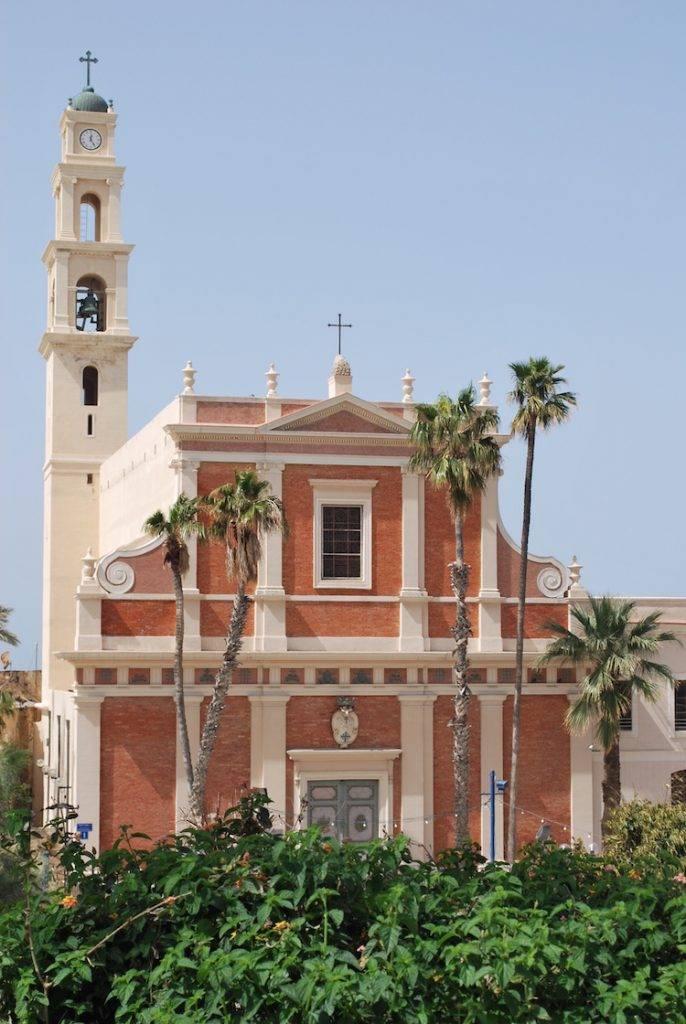
Haifa is a Northern city that most people head towards for one of the most beautiful and sacred Baha’i temples in the world. The shrine of the Bab houses the Bab’s remains (forerunner to Baha’i-ullah, founder of the Baha’i faith) and stunning garden terraces that lead to up to the dome.
For ideas and recommendations for when you visit the Holy Land Israel, visit Tripadvisor .

Templeseeker
Hi, I'm Amy and I have over 25 years of travel experience. I love seeking out temples, Churches and other religious and historical buildings. My BA (Religions and Theology) and MA (South Asian Studies) were gained from the University of Manchester. When I'm not blogging about Europe, Asia and the Middle East you will find me at home in Liverpool with my husband and Blake the Patterdale terrier! Come and join me on my templeseeking journey around the world!
Leave a Reply
Your email address will not be published. Required fields are marked *
This site uses Akismet to reduce spam. Learn how your comment data is processed .

12 Best Places To Visit In Israel For An Extended Tour Of The Holy Land
Experience the spiritual and historical significance of the Holy Land with a tour of the 12 best places to visit in Israel. Discover the ancient fortress of Masada. Float in the healing waters of the Dead Sea. Walk in the footsteps of Jesus in Jerusalem, Nazareth, and Bethlehem.
Explore the vibrant culture of Tel Aviv, the charming old town of Jaffa, and the natural beauty of the Sea of Galilee and Eilat. Make your tour of Israel truly unforgettable.
1. Sea of Galilee
When planning an extended tour of the Holy Land, a trip to the Sea of Galilee is an absolute must locate in the northern region of Israel. This large freshwater lake is a sacred place for many Christian and Jewish faiths, as it was once inhabited by Jesus Christ himself. Rich with the beautiful and majestic scenery that’s been affected by both natural and manmade elements over centuries. Seeing the Sea of Galilee allows travelers to discover a bit of history while exploring all around its 26-mile shoreline.
Numerous cities and towns dotting the area offer visitors exciting and varied experiences that are perfect when taking in some longer sightseeing days. Prized viewpoints such as Mount Arbel Cliffs or Capernaum give amazing panoramas ideal. For those wanting to escape out into nature’s beauty while learning more about religious culture sites can be done at nearby Safed and Tiberias. No matter what type of experience you’re looking for on your holy land extended tour. Be it spiritual insight or simply ecological exploration – there’s something for everyone at the Sea of Galilee!
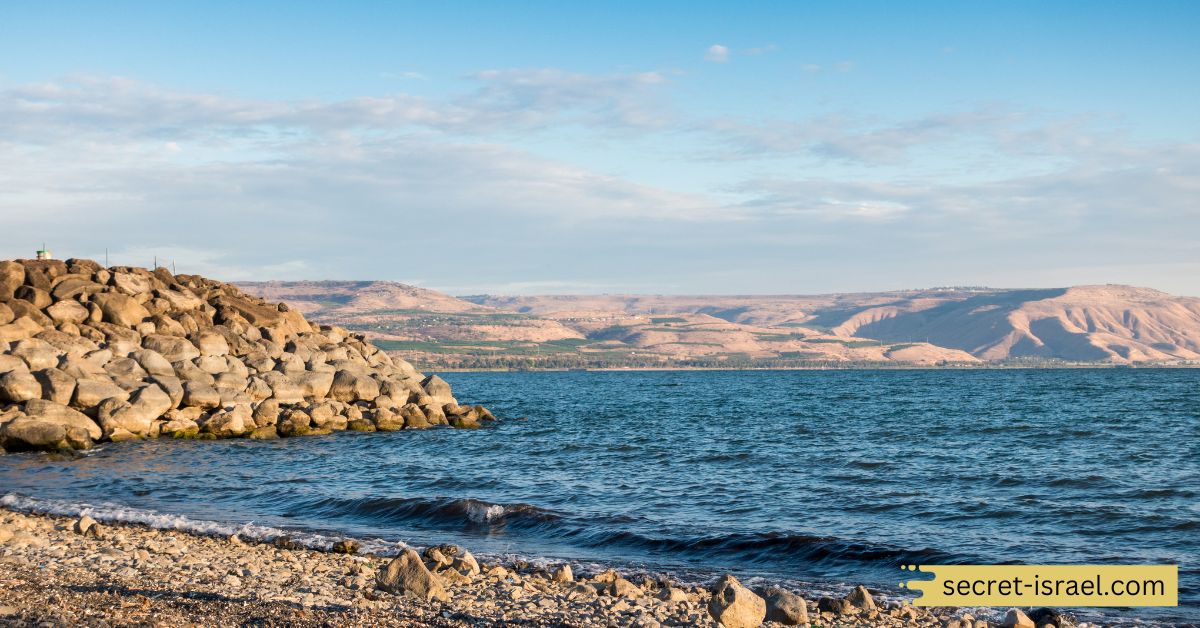
2. The Dead Sea
Set along the Jordan River on the West Bank, The Dead Sea is an amazing place to visit for a taste of Biblical history and culture. This region has been around since at least the times of Moses in Exodus. Making it a truly special place to explore and experience. With its incomparable mineral-rich waters that are four times saltier than regular seawater. The Dead Sea is known as one of the world’s most important spas.
Visitors can take advantage of its variety of healing treatments, as well as enjoy swimming in its peculiar waters–the extreme salinity makes bobbing atop like a cork a breeze! Both locals and tourists alike flock to this stunning landmark for its gorgeous views, boosting leisure activities such as sunbathing on the beach. Camping at narrow ravines throughout the landscape, or taking hikes along ancient biblical trails. It’s no wonder why this fantastic destination is one of Israel’s best spots for an extended tour.
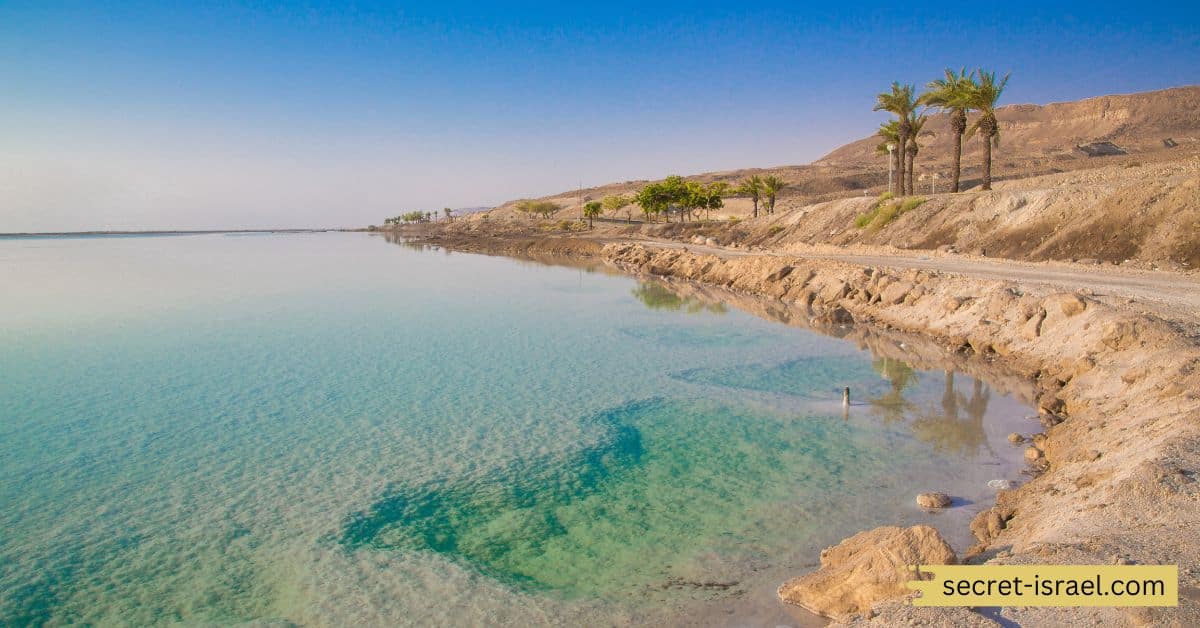
Masada is a must-see destination for those taking an extended tour of the Holy Land. Located near the Dead Sea in Israel, it’s an ancient fortress that stands as a testament to Jewish pride and resilience. Climb up to the breathtaking plateau and explore what remains of this fascinating ruin while admiring views over the surrounding desert landscape.
Take your time to learn about Masada’s complex history or join an audio guide tour available in multiple languages. Either way, you’ll be moved by its beauty and important significance to Jewish culture and heritage.
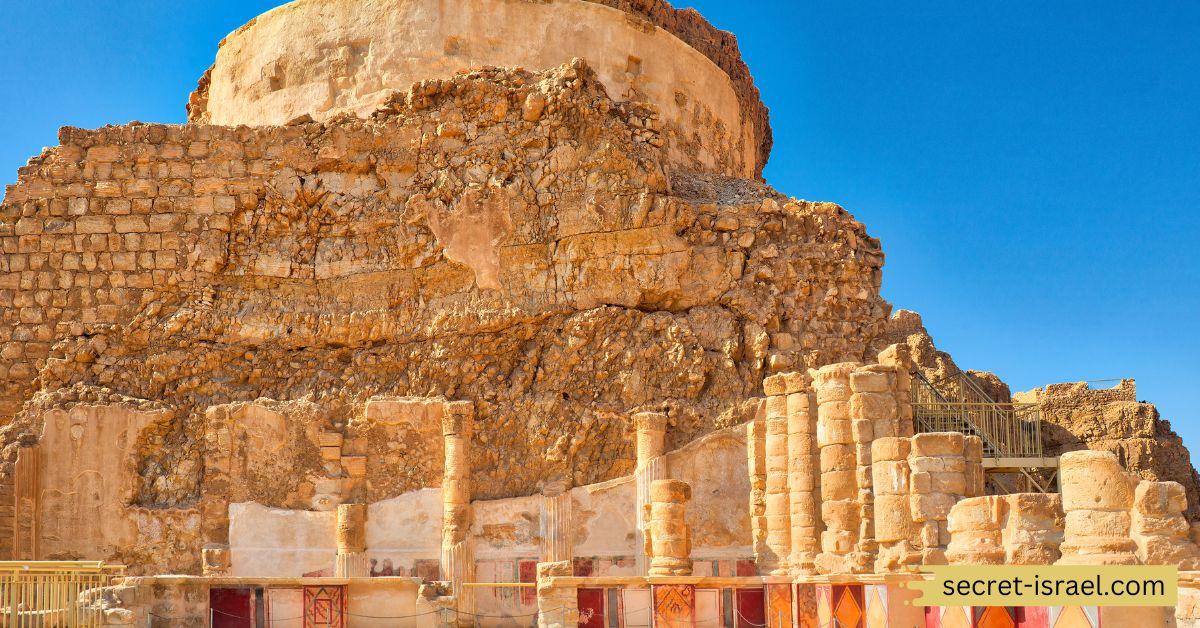
4. Tel Aviv
With its sunny beaches, modern architecture, and vibrant nightlife, Tel Aviv is a must-see during any extended tour of Israel. Located along the Mediterranean coast, visitors to Tel Aviv get to experience incredible views of the endless blue seaside while enjoying the city’s contemporary arts and culture scene.
Home to some of the world’s best hummus restaurants, many love to explore Tel Aviv’s delicious culinary offerings. The city also plays host to a huge selection of festivals all year round, allowing visitors to engage in local culture and traditions. With so much on offer in this diverse city, it would be impossible not to include it on your itinerary.
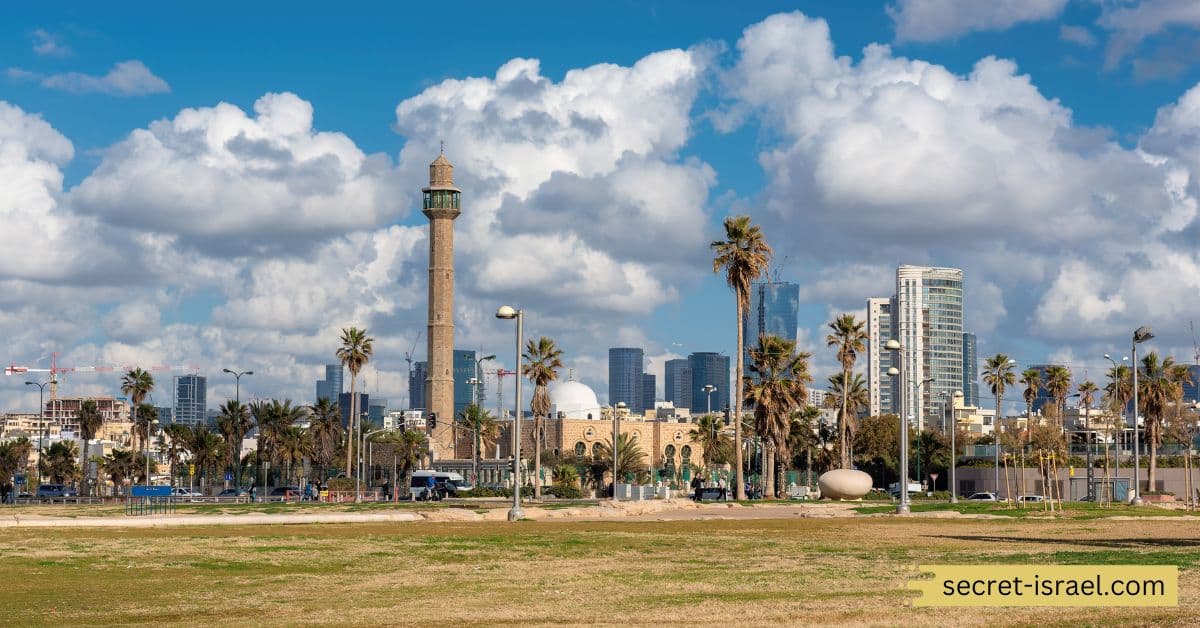
5. Nazareth
For those looking for an extended tour of the Holy Land, Nazareth is an absolute must-see. This city in northern Israel holds special significance for many religions as it is said to be the childhood home of Jesus Christ. Despite its small size, Nazareth has a lot to offer tourists. From historic churches and monuments to holy sites such as Mary’s Well and The Church of Annunciation, there is something for everyone here.
The local marketplaces are filled with souvenirs and crafts that you can bring home as memories of your visit to Israel. Food lovers will enjoy sampling delicious Israeli cuisine like hummus and shawarma on their visit as well. It’s no surprise that visiting Nazareth adds a unique element to any extended tour of the Holy Land!
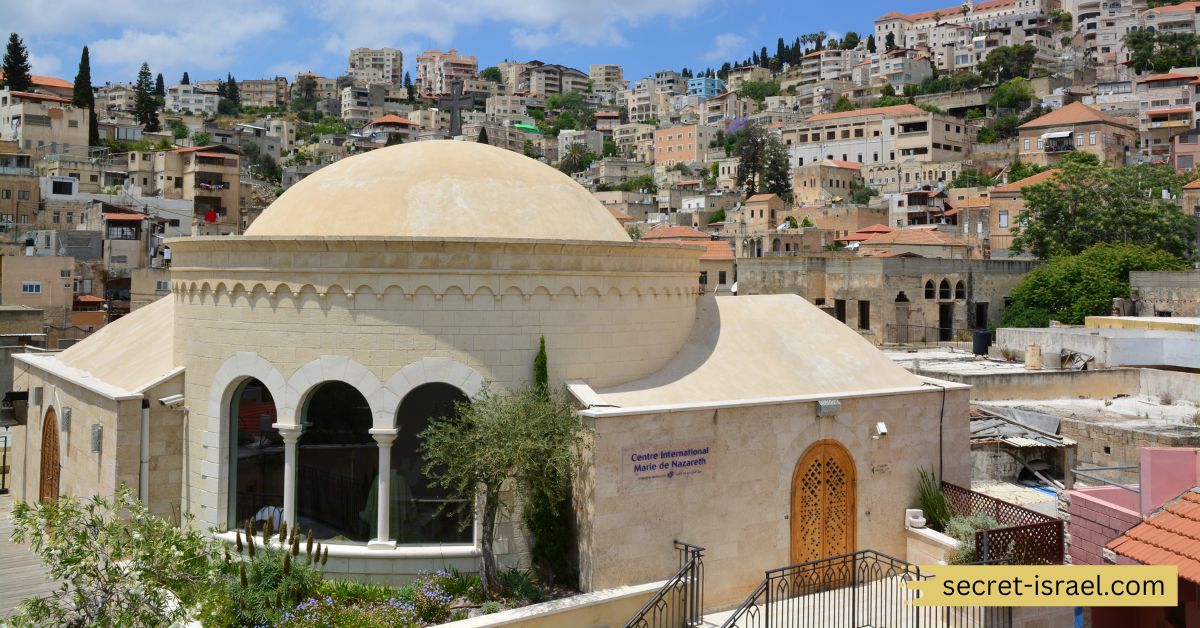
Haifa is a stunning coastal city in Israel and an ideal destination for those seeking an extended tour of the Holy Land. From its breathtaking Bahai Gardens to its array of museums and galleries, there’s so much to see and do in this vibrant port city.
History lovers will be spoilt for choice with the countless archaeological sites spread throughout Haifa:
- Bahai Gardens
- Elijah’s Cave
- Stella Maris Monastery
For those looking for some retail therapy, ample markets are showcasing the unique flavors of Israeli cuisine and culture.
Culture buffs can enjoy performances from internationally acclaimed art institutions or visit one of the popular festivals occurring throughout the year like the SoundWave music festival or the Red Sea Jazz Festival. All in all, Haifa is a must-visit destination that should not be missed when exploring the spectacular Holy Land on an extended tour!

7. Bethlehem
With over 4,000 years of history, Bethlehem is an essential destination for any pilgrim to the Holy Land. The city holds many centuries-old churches and ancient sites that give insight into its colorful past. From the Church of Nativity and UNESCO World Heritage Site to Rachel’s Tomb and Shepherds’ Field, there are plenty of timeless attractions to explore.
Other recommended places include Milk Grotto Chapel, where tradition says that Mary fed baby Jesus while they were hiding from Herod’s soldiers. The Manger Square outside the Church of Nativity provides a stunning backdrop to remember this traditional story. No matter what your travel plans are in Israel, a visit to Bethlehem is essential to fully embrace the history and spirituality of this unique part of the world.

8. Tiberias Hot Springs
Tiberias Hot Springs is one of the best places to visit in Israel for an extended tour of the Holy Land. Located right on the shore of the Sea of Galilee, visitors can enjoy soothing spa services while basking in the sun and marveling at stunning views of the Lake.
The naturally warm thermal waters provide a tranquil and tranquilizing experience that reaches far below the surface. For extra indulgence, you can try mud baths while also trying out special massages with essential oils, herbs, and clay. Plus, it’s a great spot to take a boat ride or rent your kayak! Overall, whether you’re looking for a relaxing getaway or some fun outdoor activities, Tiberias Hot Springs has something for everyone and no trip to Israel would be complete without a visit here.
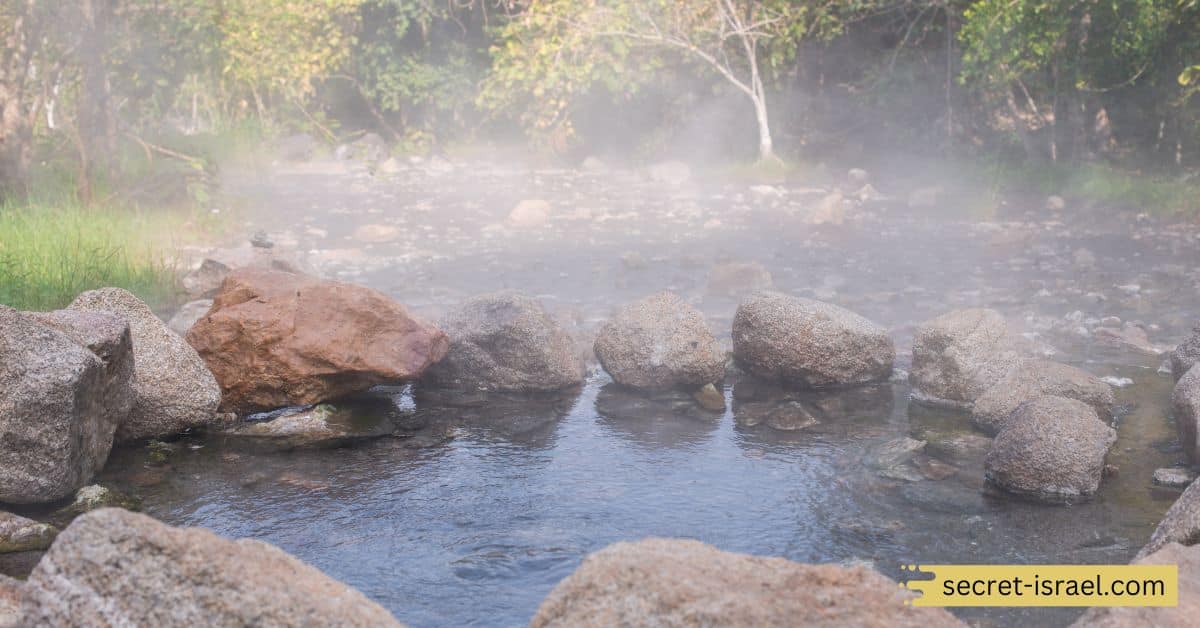
Eilat is one of the best places to visit in Israel for those looking to get a more extended look at the Holy Land. Located on the Red Sea, Eilat offers plenty of activities, from beachside relaxation to spectacular nature reserves, to vibrant nightlife.
There are attractions such as:
- Kitesurfing
- Wakeboarding
Sites filled with colorful and diverse marine life! Accessible by air or land, you can easily spend an entire day touring Eilat’s breathtaking Coral Beach Nature Reserve.
But that’s not all – you won’t want to miss out on visiting the underwater observatory marine park either! This is a great way to experience both worlds. Above and below sea level without having to get your feet wet. With so much to do in and around Eilat, there’s something for everyone who wants a more comprehensive tour of the sacred nation of Israel.
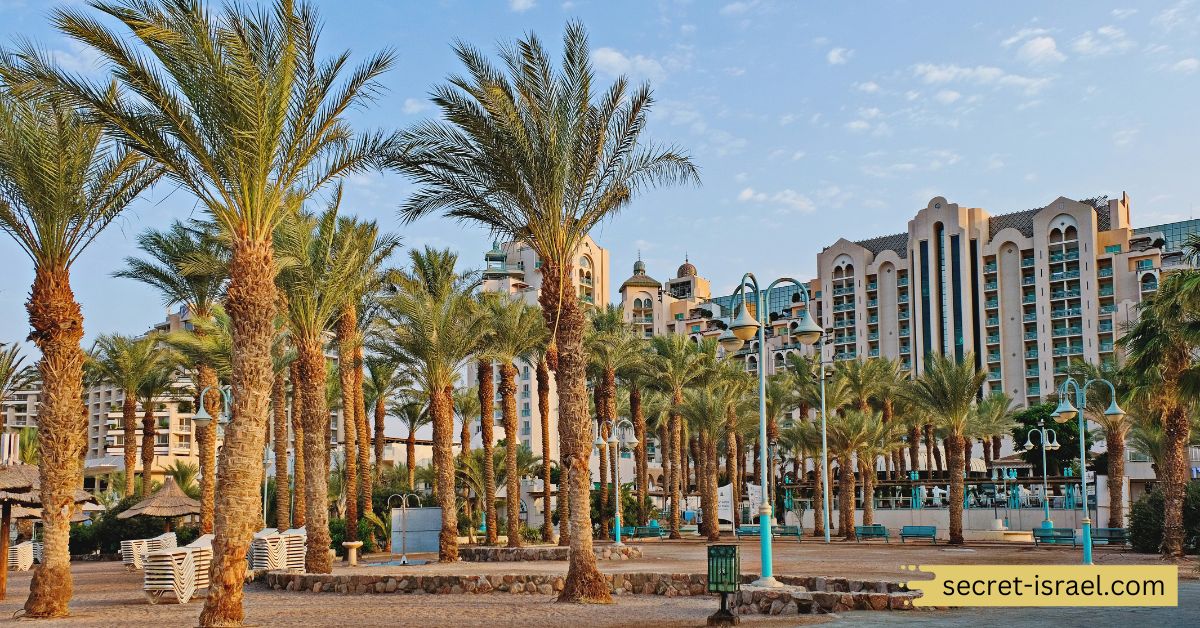
10. Caesarea
One of the best places to visit in Israel for an extended tour of the Holy Land is Caesarea. This ancient port city is located on the Mediterranean Sea and was built by King Herod over 2000 years ago. It has a rich and checkered past, having frequently been conquered by various empires throughout history.
Today, tourists can visit sites like the harbor, Roman theater, Hippodrome, Crusader halls, and baths. Remains of an aqueduct marking the division between old & new cities, as well as a well-preserved moat around its defenses. While there is plenty to learn about Caesarea’s history while visiting these sites. Visitors also have an opportunity to relax at local beach resorts or take part in activities from camel riding to deep sea diving or sailing trips. When planning your extended tour of Israel’s Holy Land, be sure to stop by this breathtaking destination for a memorable experience!
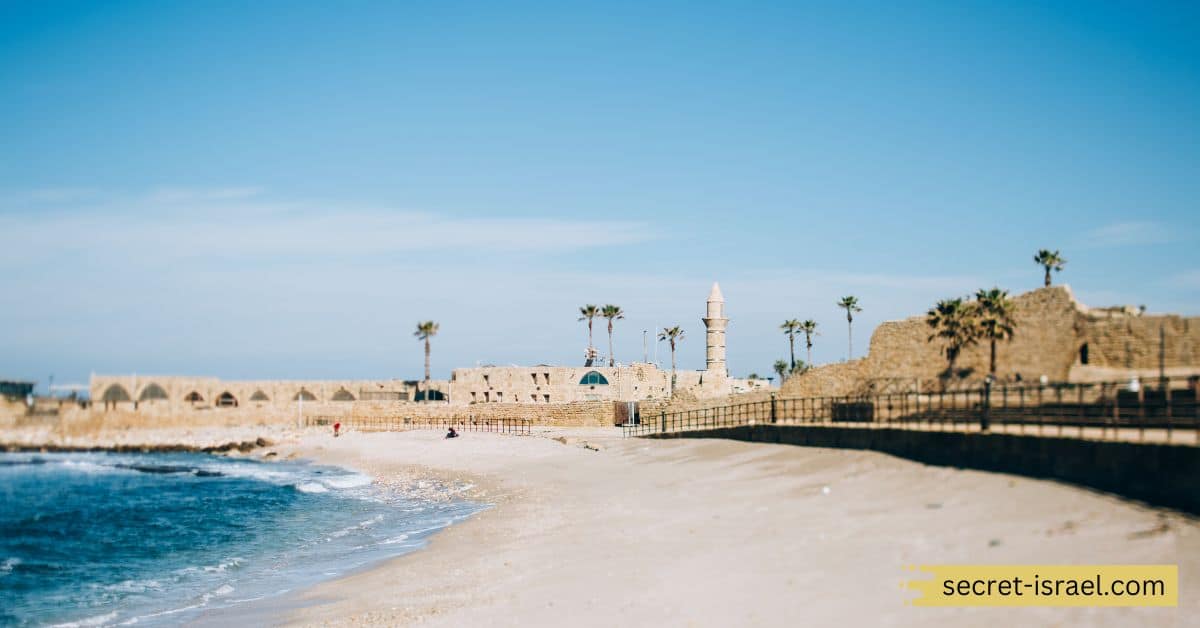
While Israel’s singular most sacred site – the Temple Mount in Jerusalem – cannot be missed for its spiritual and historical significance. Jaffa should also not be overlooked for a comprehensive tour of the Holy Land. A Tel Aviv suburb and one of the oldest port cities in the world. Jaffa is a very modern city with strong traces of antiquity as seen through both ancient structures and culture.
Its main attraction, Old Jaffa, is loaded with remnants from diverse historical eras. It also houses a vast range of alleyways bustling with art shops, galleries, and more. Local restaurants offer you a delightful range of Mediterranean-style dishes. While nearby beaches are perfect to take a break from sightseeing and revel in the beauty of nature that this vibrant town has to offer.
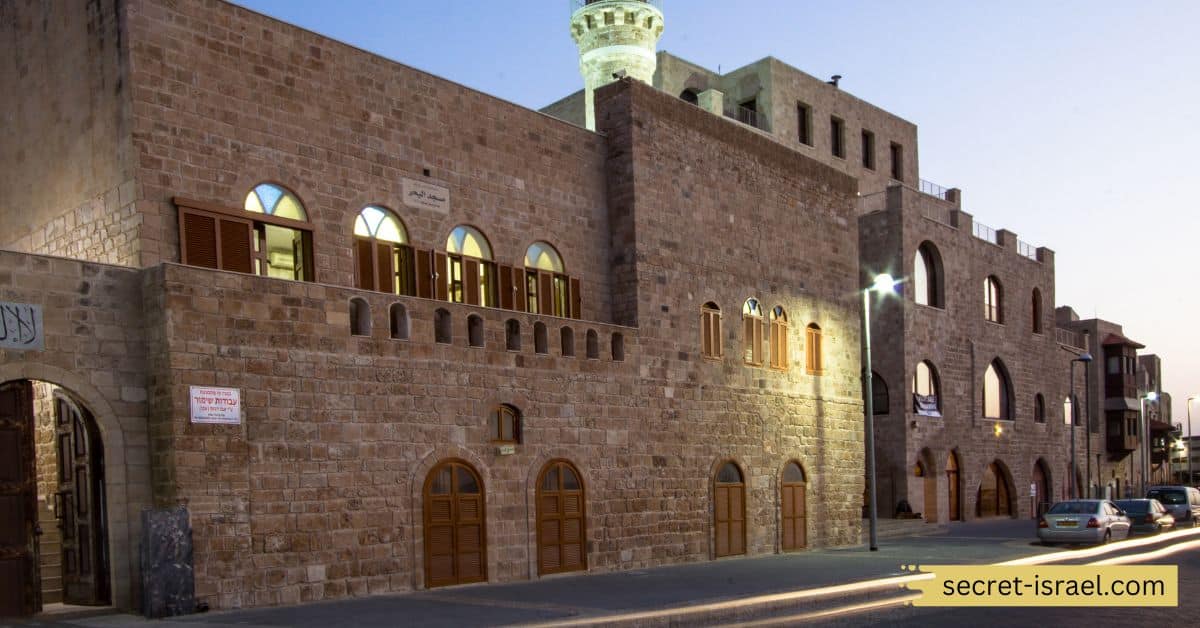
12. Jerusalem
Visiting Jerusalem is an experience like no other. This massive, storied city is truly one of the most fascinating destinations on Earth.
When visiting stop in at some of the many characteristic landmarks like:
- Old City Walls
- Dome of Rock
- Temple Mount
- Church of Nativity
- Western Wall
Be sure to check out some of the fabulous museums around town like:
- Yad Vashem Holocaust Memorial Museum
- Tower of David Museum of the History of Jerusalem
- Bible Lands Museum
Guided tour is recommended so you can appreciate all that there to see in this holy city.
For those looking to stay a bit longer in Israel than just a few days. Jerusalem can provide an unforgettable experience if explored further. Be it for history or religion – even enough for a whole extended vacation!

In conclusion
A visit to the Holy Land is an experience like no other. From ancient ruins and sacred sites to modern cities and nature reserves, Israel has something for everyone. Whether you’re looking for spiritual insight or simply some relaxation time in the sun. There are plenty of places to explore during an extended tour of the Holy Land.
From Nazareth and Masada to Eilat and Tel Aviv, Israel is full of must-see destinations that make for an unforgettable journey. So, if you’re looking for a long-term tour of this sacred nation, don’t hesitate to check out all the wonderful sights Israel has to offer!
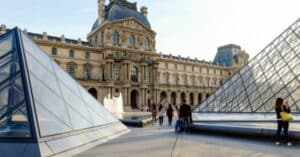
Europe’s charm lies not just in its stunning architecture and historical treasures but also in the myriad of adventures
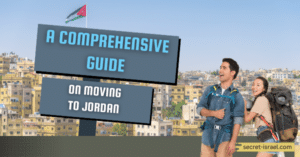
Are you considering relocating to Jordan? This small yet vibrant middle-eastern country has a rich history and culture, making

Jordan is a country in the Middle East that has been making significant strides in the education sector. With
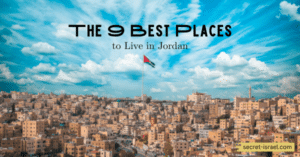
Jordan is a beautiful country in the Middle East, known for its ancient historical sites, diverse landscapes, and warm

Experience a dreamy elopement in Jordan, where ancient wonders meet modern romance. Exchange vows at Petra by Night, dive

Jordan offers a dreamy elopement paradise with its historic wonders, breathtaking landscapes, and vibrant cities. From the ancient splendor
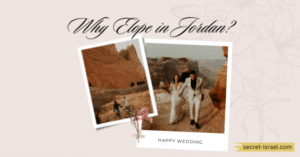
Eloping in Jordan is a dream come true. With its safety, rich history, and natural beauty, it’s the ideal

Discover the unique marriage traditions of Jordan, a country where religious laws heavily influence its legal system. Learn about
Welcome to Jordan, a country situated at the crossroads of Asia, Africa, and Europe. As a country with strong
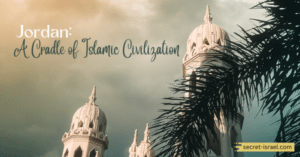
Join us on a journey through time to discover the hidden gems of Jordan – a country that holds
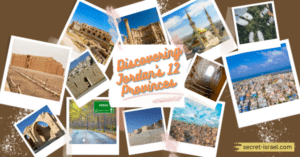
Explore Jordan’s 12 provinces, a fusion of history, culture, and beauty. From Amman’s historic citadel to Jerash’s Roman ruins

In this guide, we’ll take you through the top budget-friendly hostels to luxurious hotels in Zarqa, ensuring your stay
History | July 2019
Two Tour Guides—One Israeli, One Palestinian—Offer a New Way to See the Holy Land
With conflict raging again in Israel, a fearless initiative reveals a complex reality that few visitors ever experience
:focal(2161x919:2162x920)/https://tf-cmsv2-smithsonianmag-media.s3.amazonaws.com/filer/21/ee/21ee120b-041a-4604-8a0c-06b06664d5a6/julaug2019_j01_dualnarratives.jpg)
Geraldine Brooks; Photographs by David Degner
In the fierce morning light of Caesarea, we hike down the beach, following the line of a ruined aqueduct that dates from the era of Herod the Great. The golden sand is littered with tiny russet tiles. Peering up into the dunes, we shade our eyes as our guide points out their source—the crumbling floor of what’s believed to have been a diplomat’s home when this Mediterranean port was an administrative center for the Roman occupation of Judea, some 2,000 years ago. Farther on, we see evidence of the Muslim conquest of the city 600 years later, ushering in Arab rule that lasted until the Crusades. Later, in 1884, Bosnian fishermen settled this shore, and the minaret of their mosque now punctuates a lively tourist precinct beside the leafy and affluent Israeli town where the Israeli prime minister, Benjamin Netanyahu, makes his home.
It’s our first morning in Israel, and already we’ve covered thousands of years of overlapping cultures, a perfect introduction to this tiny notch of land, so long inhabited, so often fought over and brimming with stories that have shaped the world. The group I’m with, mostly members of a Lutheran church in Lake Forest, Illinois, outside Chicago, is part of a tourist boom that last year brought four million visitors to this nation of fewer than nine million people. At many stops, we are surrounded by a babel of languages, representing visitors from every corner of the world, all drawn to this land and its stirring history. But our experience differs from that of most visitors. Instead of one guide, we have two—an Israeli and a Palestinian—and each gives a dramatically different perspective on everything we see. During the next week, we will travel from places of worship to archaeological sites and into private homes, crossing and recrossing Israeli military checkpoints and the approximately 285-mile separation barrier that divides much of this society.
Our Israeli guide is Oded Mandel, 38, the son of Romanian Jews, whose father survived the Holocaust as a child. Oded’s parents immigrated to Israel in the 1970s, after the Jewish state reportedly made cash payments to the oppressive regime of Nicolae Ceausescu in exchange for exit visas. Oded serves as a reserve officer in the Israel Defense Forces. Bearded and bespectacled, he describes himself as “proud in my military service, in being Jewish, proud in my parents and what they did to come here.”
Aziz Abu Sarah, also 38, a Palestinian Muslim, lives under occupation in his birthplace, East Jerusalem. He was 9 years old during the first Palestinian Intifada, when Israeli soldiers burst into his bedroom one night to arrest his older brother, Tayseer, who was accused of throwing stones. Tayseer went to prison and, after his release nine months later, died from injuries he sustained there.
I first visited Israel and the occupied Palestinian territories during that uprising, in the winter of 1987. I was a young correspondent for the Wall Street Journal , dodging stones and rubber bullets to interview boys like Tayseer as well as reservists like Oded. I empathized with the Palestinians, many still children, risking their lives to protest poverty and daily indignity. But I also felt the crushing anxiety of Israelis, especially Holocaust survivors and terror victims, and I sympathized with soldiers, many of whom despised their new duties skirmishing with civilians. I also grew frustrated, in the safe comfort of European and American cities, with the smug certainties of friends who could feel sympathy for only one side. Either all Israelis were brutalizing oppressors or all Palestinians were bloodthirsty terrorists. I wished my acquaintances could spend even a week doing what I did, listening to stories from both sides that were often equally harrowing.
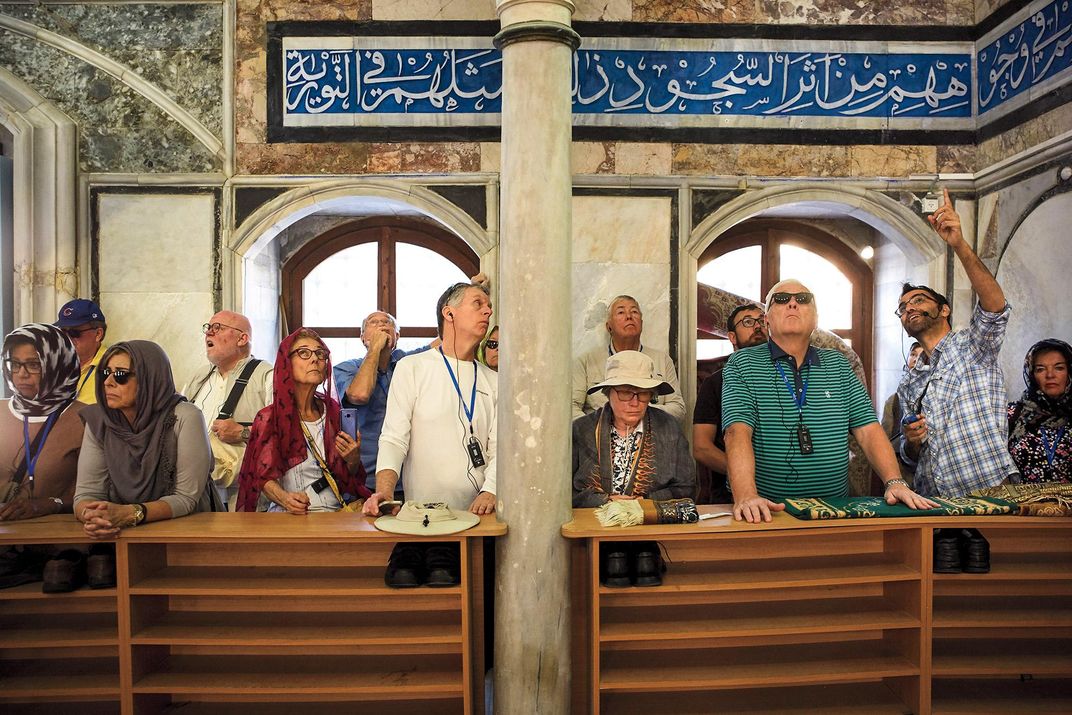
Aziz Abu Sarah created Mejdi Tours to offer just such an experience. He was well aware that most visitors receive just one view: Jewish tourists and many Christian groups focus heavily on Jewish history and rarely visit the West Bank or interact with Palestinians. Palestinian tours, by contrast, focus on difficulties of life under occupation and the Christian pilgrimage sites in Palestinian towns such as Bethlehem, while millennia of Jewish history is ignored.
Aziz, like an archaeologist at one of the country’s celebrated tels , or archaeological mounds, had the idea to present visitors with the multiple narratives of the people who share this land, digging down layer by layer and story by story, undaunted by complexity—indeed, reveling in it.
Arriving in Nazareth feels like crossing an invisible border into an Arab country. Minarets stud the skyline, mixing with church spires. Clutching falafel sandwiches, we wander past neon signs in Arabic and women wearing colorfully embroidered Palestinian dresses. In the market, spice sacks gape open, revealing bright saffron and paprika. Cardamom and coffee scent the air.
The Chicagoans I’m with are a well-traveled group, mostly professionals, but only a few have been to Israel before. They lob questions at our guides. Though Aziz’s and Oded’s perspectives are not aligned, they share an easy, bantering relationship. Aziz, wearing a pearl-buttoned Western-style shirt that signals his love of country music, is naturally ebullient, with the affect of a stand-up comic. Oded, affable and measured, says he likes the Mejdi Tours approach “as a way to challenge what I am thinking.” Frequently, each offers the same caveat before answering a question: “It’s complicated.”
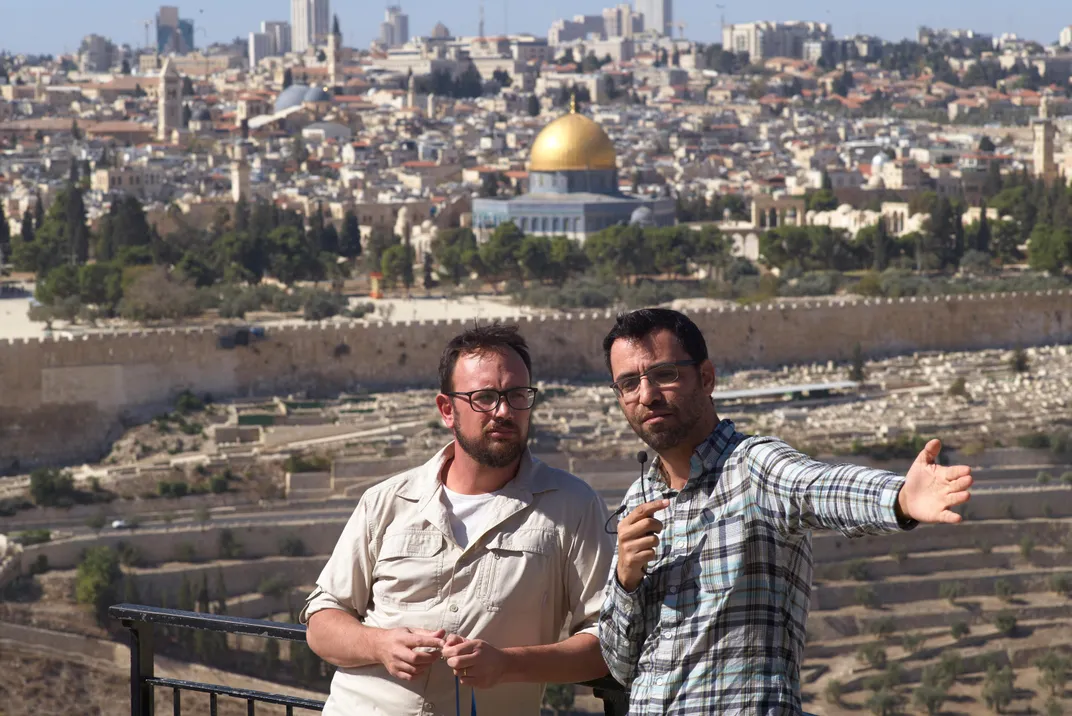
Now some in our group are struggling to understand the legal status of the people in Nazareth, which is one of the largest Palestinian communities within Israel. Arab Israelis, or Palestinian citizens of Israel, as most prefer to be called, make up 21 percent of Israel’s population. They carry Israeli passports, can vote in national elections and send Palestinian members to the Knesset, or Parliament. Why, one traveler asks, did some Arabs stay inside the new State of Israel while so many others fled during the Arab-Israeli War of 1948?
Oded gives the Israeli narrative, explaining how European Jews, fleeing pogroms and discrimination, began to return to their ancient homeland in the 19th century, when it was under Ottoman and later British rule. Occasional acts of violence between Arabs and Jews turned to outright conflict when Jewish migration accelerated during and after the Second World War, as displaced refugees and survivors had few other places to go. In 1947, as the British mandate was ending, the United Nations voted to partition the land into separate homelands for Jews and Arabs. “The Jewish side said, ‘Yes, we need a state right now.’ We tried to live here in peace, we acknowledged partition,” Oded says. “But the Arabs said ‘No,’ and in 1948 we had to fight five different Arab armies” during what Israelis call the War of Independence.
When Aziz takes up the narrative, he uses the Palestinian term for the 1948 war: al-Nakba , the Catastrophe. He describes the killing of Palestinian civilians by Jewish paramilitaries. “People were terrified,” he says. Arabic radio broadcasts fanned the panic, warning of massacre and rape. In fear for their lives, huge numbers fled to the West Bank and Gaza Strip as well as to Lebanon, Jordan and Syria. “They thought the fighting would end in a few days, and they would come back to their homes. They were not allowed to, and those who fled—at least 700,000 people—became refugees.”
Oded interjects that more than 800,000 Jews were themselves forced to flee Arab countries such as Egypt, Syria, Iraq and Yemen following violent reactions to Israel’s founding.
“I don’t accept that parallel,” counters Aziz. “What Egypt did is not the Palestinians’ responsibility.”
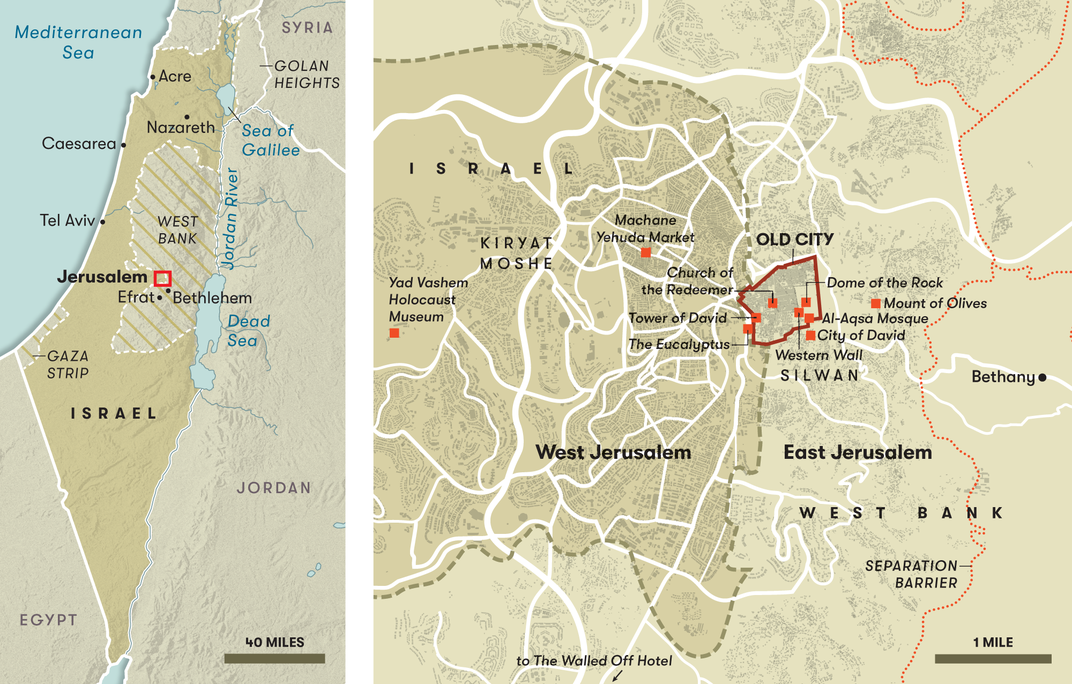
The discussion is interrupted when our bus rounds a curve on an olive-studded hillside and a shimmering sheet of water comes into view. “ That’s the Sea of Galilee?” exclaims one incredulous Midwesterner. “It looks like a little lake in Wisconsin!” This issue of scale will come up again and again—the trickle of water that is the “mighty” Jordan River, even the size of the disputed land itself, which is slightly smaller than New Jersey. It is vividly on display in the Golan Heights, in Israel’s far north, where barbed wire surrounds an army post that looks into Syria. A sign indicates that Damascus lies just 60 kilometers, or 37 miles, away.
For a long time after the death of his brother, Aziz would not have listened to an Israeli perspective like Oded’s. A self-described radical bent on revenge, Aziz refused to learn Hebrew because it was the “language of the enemy.” But, after graduating from high school, he couldn’t get a decent job, so he joined a class at a language center designed for recent Jewish immigrants. For the first time, he met an Israeli who wasn’t a soldier. His teacher was sensitive and welcoming. “Since I didn’t know enough Hebrew to argue with her, we had to become friends first,” he tells me.
That experience kindled a new curiosity. Aziz went to work for a Jewish ceramics company in the ultra-Orthodox Jerusalem neighborhood of Mea She’arim (“My employers were very good to me”), and attended an Evangelical Christian Bible college in Jerusalem. (“I didn’t want to know what Muslims think Christians believe. I wanted to understand from Christians what they believe.”) Aziz then joined a support group for those who had lost a family member in the conflict; members shared their stories and discussed reconciliation.
In front of often-hostile audiences, he retold the story of Tayseer’s death alongside an Israeli with his or her own tragic tale of violence and bereavement. He saw that such stories had immense power to change people’s thinking, and he expanded on that experience by creating a radio program, in Hebrew and Arabic, in which Israeli and Palestinian guests would each speak about a dramatic change in their life or attitude. Eventually, Aziz’s activism brought him to the attention of Scott Cooper, then a director of George Mason University’s Center for World Religions, Diplomacy and Conflict Resolution in Fairfax, Virginia, where Aziz was recruited to create programs in interfaith outreach, peace-building, negotiation and government reform, which he then led in person in Afghanistan and Syria and in online courses for Iranians.
In 2009, Aziz and Cooper created Mejdi Tours, adhering to strict principles of social and environmental responsibility. The company has spent more than $900,000 in the communities it visits, and its tours and tourists have spent $14 million at local businesses. Groups are almost never booked in chain hotels and are encouraged to shop at small stores or fair-trade co-ops. The company offers similar multinarrative tours in Northern Ireland, Bosnia and Herzegovina, Iraqi Kurdistan and other places that have experienced conflict.
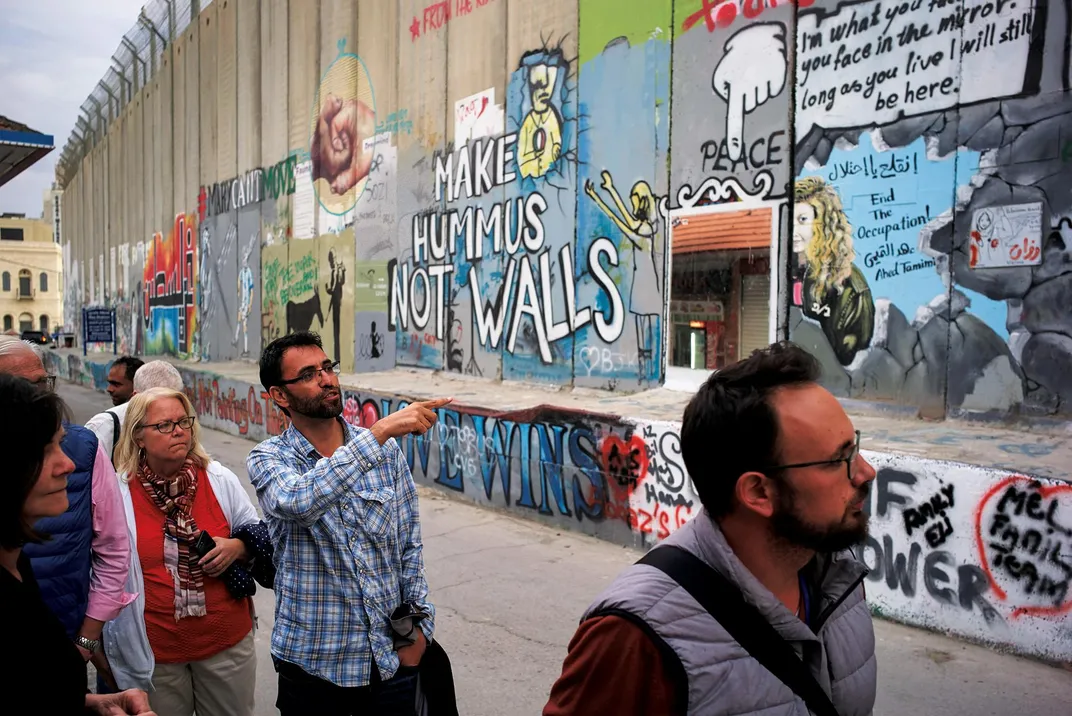
“In a place like Barcelona, people can’t stand tourists, because they don’t connect with the locals,” Aziz says. “We’re all about making connections.” He quotes the 14th-century Moroccan traveler Ibn Battuta: “Travel makes you speechless, then it turns you into a storyteller.”
On Friday morning, as we prepare to explore the ancient port city of Acre, a mixed Jewish-Arab city on the northwest coast, Aziz mentions the widespread view that the city has the country’s best hummus. “Personally, I don’t agree with that,” he adds.
“Me neither,” says Oded.
“Finally, we have one narrative here,” Aziz quips.
We visit the green-domed Al-Jazzar Mosque just as worshipers are arriving for Friday midday prayers, the week’s most important communal observance. Most of the travelers have never set foot in a mosque. They gaze at the intricate tilework adorned with calligraphic inscriptions from the Quran. Since Islam regulates every aspect of a believer’s life, Aziz explains, the imam’s sermon may extend beyond the spiritual, touching on some matter of daily existence—diet, say, or finance. Or the sermon might be intensely political, which is one reason demonstrations often erupt on Fridays after prayers.
Later, on the road to Jerusalem, Oded remarks that Friday is special for Jews as well, as sunset marks the beginning of Shabbat , the Sabbath. “You’ll see that the traffic is going to get lighter. Religious people will be walking to synagogue.” Soon we are walking ourselves, having left the bus behind at the entrance to Kiryat Moshe, an Orthodox Jewish neighborhood where driving is discouraged between sundown Friday and sundown Saturday.
At the apartment of Rabbi Joshua Weisberg, we squeeze around a table, humming along as his family sings a traditional song to greet the Sabbath. “And now,” says the rabbi, “I’m going to bless my children. It’s going to take a while.” There are eight children, ranging in age from 3 to 20. The eldest, a daughter, is away, studying at a religious seminary, but one by one the others come to the head of the table, snuggling against their father as he embraces them and whispers the ancient Israelite blessing: “May God shine his face upon you and show you favor....”
Over dumpling soup and platters of chicken, Rabbi Weisberg tells us that the same blessing was found etched onto a 2,800-year-old silver amulet excavated at an archaeological site only a few miles from the apartment. “A parent in Isaiah’s Jerusalem probably put that amulet on his child, expressing the same hopes and concerns, in the same Hebrew I prayed tonight,” he says. “That’s one of the reasons it’s important for me to be here—to feel that continuity of Jewish life in this place.”
When the rabbi’s two eldest daughters finished high school, they chose to do two years of national service, working with disadvantaged and disabled kids, which is an alternative to military service open to religious youth. But the third daughter plans to join the army, a controversial choice among Orthodox girls. “Israel defends me,” she told her father. “I won’t serve?” To the rabbi, that independence of mind is welcome. “I want my children to be Jewish, and to have a connection with God—I’d be devastated if they didn’t have that. But for the rest, they will decide.”
On the way back to our hotel, Aziz, who had not met Rabbi Weisberg before, is enthusiastic about his humor and openness. “I told him I’d like him to be involved with more of our groups. He said, ‘Are you sure you want me? I’m a right-wing guy.’ I told him, ‘That’s why I want you—I know plenty of leftists already.’”
The West Bank settlement of Efrat, about an hour south of Jerusalem, consists of red-roofed residences slung across seven hilltops, and is surrounded by long-settled Palestinian villages. Efrat is populated mainly by traditional religious Zionists, many of whom believe they have a national and spiritual imperative to settle the biblical lands of Judea and Samaria. But lots of residents, says Shmil Atlas, who directs development in the settlement, move there for other reasons, too. He cites the settlement’s proximity to Jerusalem, good schools, a well-educated professional community, as well as cost: a three-bedroom house, for example, can be bought for about the same price as a one-bedroom apartment in Jerusalem.
Efrat is now home to about 12,000 Israelis, and the community plans to grow by 60 percent over the next few years. Part of the settlement is in lockdown this morning, because of suspected infiltrators detected by electronic sensors. When we arrive, security personnel are searching house to house. Palestinians who usually work here have been banned from entering. (No infiltrators were found.)
Despite the heightened tension, Atlas paints a sunny picture for us of the settlement’s relationship to its Palestinian neighbors. Nearby villagers, Atlas says, are glad of the work the settlement offers—around a thousand jobs, mostly in construction, maintenance and agriculture. Since most of the Israeli residents commute to work in Jerusalem, he jokes that by day the mayor of Efrat is “the mayor of a Palestinian city.” One woman in our group is clearly taken with Efrat—the crisp, luminous air of its hilltop setting, the charming villas splashed with bougainvillea.
But the cost to Palestinians of ongoing settlement expansion is on stark display less than ten miles north, where the town of Bethlehem is being slowly choked by military checkpoints and is unable to grow because of the looming separation barrier. “The whole town is essentially walled in,” the Rev. Dr. Mitri Raheb, president of Dar al-Kalima University College of Arts & Culture, tells the group. When Raheb’s mother was hospitalized for cancer treatment in East Jerusalem, he was able to get a permit from Israel to visit her; his mother’s sisters were denied. When his father-in-law was suffering a heart attack, a border guard required him to exit the ambulance and walk through the checkpoint. He died a few days later.
“We have no room to grow,” Raheb laments. “It is destroying the character of the little town, and its economy.” A quarter of Bethlehem’s work force is unemployed, and the need to use every inch of land means little green space. “Our kids don’t know what spring looks or smells like,” he says. But Raheb, a Palestinian Christian, paraphrases a comment attributed to Martin Luther, on the essential need to retain hope: “If the world is ending tomorrow, go out and plant an olive tree.” He fulfills that ideal by leading the sole Palestinian university dedicated to arts and culture. “We are educating the next generation of creative leaders in Palestine,” he says proudly.
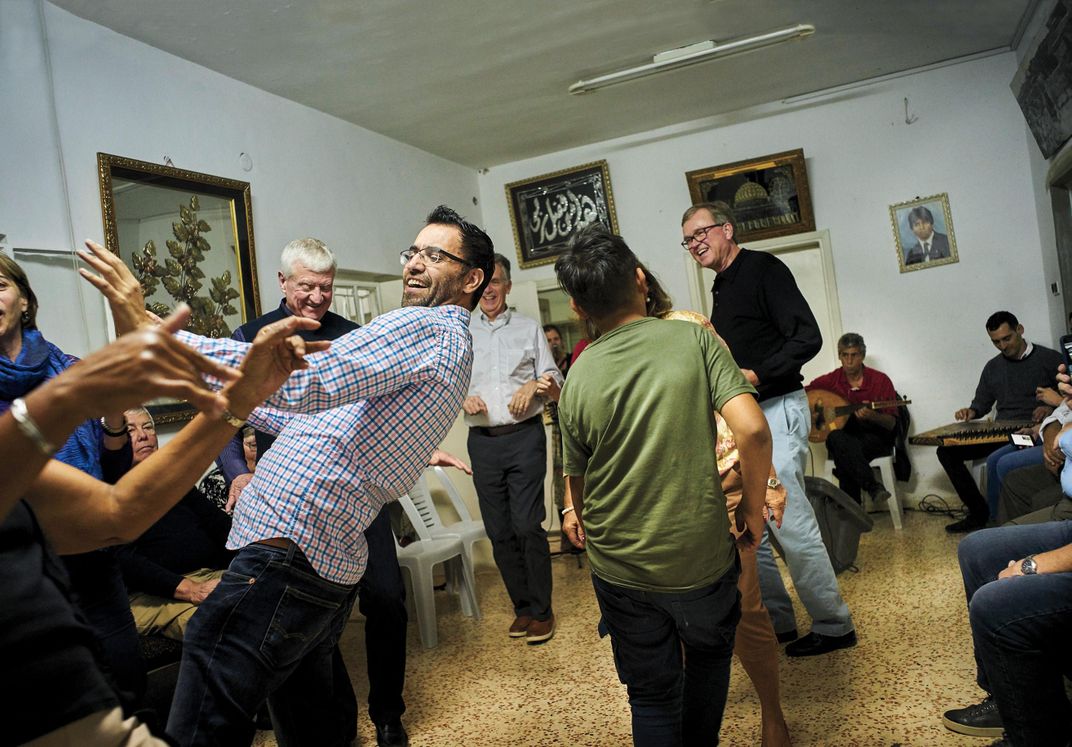
Snarled in traffic at a checkpoint, the traveler who had earlier been drawn to Efrat now works through her feelings. “I thought, I’d like to live there: It’s intellectual, it’s a mix of young and old, it’s a really pretty community. But then in Bethlehem you see how suffocated they are. It’s like a ghetto.”
To Aziz, this is how a Mejdi trip is supposed to work. “Most people who come here will hear only one of these two narratives,” he says. “If they come here already very pro-Palestinian, I’ll say, let me push you a bit harder to see the other side. Same thing if they’re very pro-Israel. Being able to see the other side doesn’t mean you have to agree with it.”
One morning, we find ourselves on the Mount of Olives—picking olives. It’s a volunteer effort for the beleaguered Augusta Victoria Hospital, a Lutheran institution that cares for about 700 patients a day from Gaza, the West Bank and East Jerusalem, specializing in oncology and nephrology. The gray-green olive groves cover the hillside, and the Chicagoans climb into tree branches to harvest ripe fruit onto waiting tarps. Oil from these 800 trees will be sold to raise funds for the hospital, which has been under severe financial pressure, especially since the Trump administration halted aid to the Palestinians. Previously, such aid covered almost a quarter of the hospital’s bills, explains Pauliina Parhiala of the Lutheran World Federation. “There are USAID stickers on a lot of the equipment.”
Money isn’t the only challenge. Palestinian hospital staff who live in the West Bank are sometimes delayed at checkpoints. Not quite two-thirds of the Gazans who apply to come to the hospital receive permission to enter Israel, and sometimes the parents of children who need dialysis or chemotherapy are denied entry on security grounds. Still, Parhiala says, medicine is a bright spot of Palestinian and Israeli cooperation. Palestinian doctors receive overwhelming support from Israeli colleagues, training together and working side by side. “Even in the most difficult times, this has continued, and that’s a ray of hope for me,” Parhiala says.
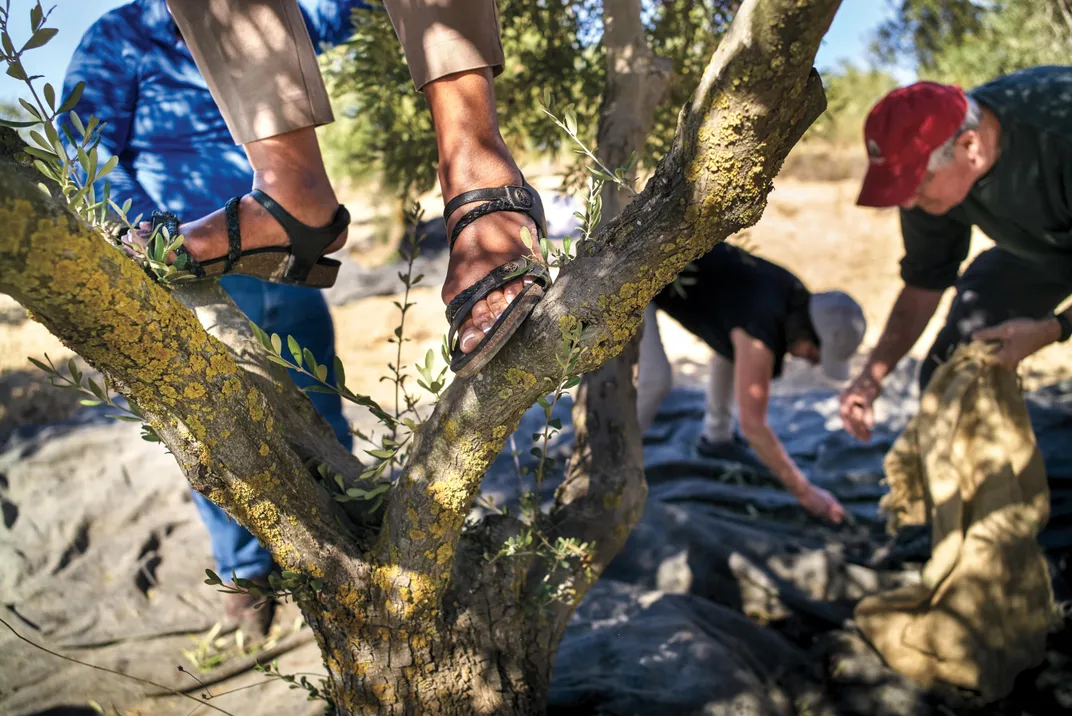
Later, as Oded and Aziz lead the group through the narrow alleyways of Jerusalem’s Old City, Aziz unfolds his story as a Jerusalemite. Although born here, he is merely a permanent resident, not a citizen. After the Six-Day War in 1967, when Israel captured the
West Bank and Gaza Strip, it annexed East Jerusalem and 28 surrounding Palestinian villages, home to some 70,000 Palestinians, including Aziz’s family. Those Palestinians were not granted citizenship, and though they are eligible to apply for it, the process is difficult. Even Aziz’s tenuous residency status can be revoked if the government determines he is not “centering his life” in the city. That’s a risk for someone who runs an international travel company, has lived in the United States, and works on conflict resolution around the globe.
Last September, Aziz announced that he would run for mayor of Jerusalem, intending to take a case to court to test the right of a noncitizen to do so. But he was assailed from both sides before he could even file suit. He learned that his Israeli-issued residency permit was suddenly under review. Activists linked to the Palestinian Authority threw eggs at him and threatened his life for breaking with a long-standing election boycott and “legitimizing” the Israeli occupation. (Only about 2 percent of Palestinians who are eligible to vote in Jerusalem’s municipal elections actually do so.) Aziz eventually withdrew, but he still thinks his strategy was the right one. “Our leaders aren’t pragmatic,” he laments. “Instead of opening a discussion, they resort to violence and threats.”
One evening, our group visits Aziz’s family home, in the village of Bethany, just beyond the area annexed by Israel. Aziz’s father built the large house himself, and planted trees and gardens, only to learn that living in the house would disqualify the family as residents of Jerusalem. The family faced a choice between staying in the home and losing the right to travel freely to and from the city of their birth, or moving into a cramped apartment within the city lines. They chose the apartment, to protect their status. Today they may only visit the home in Bethany, never sleep there.
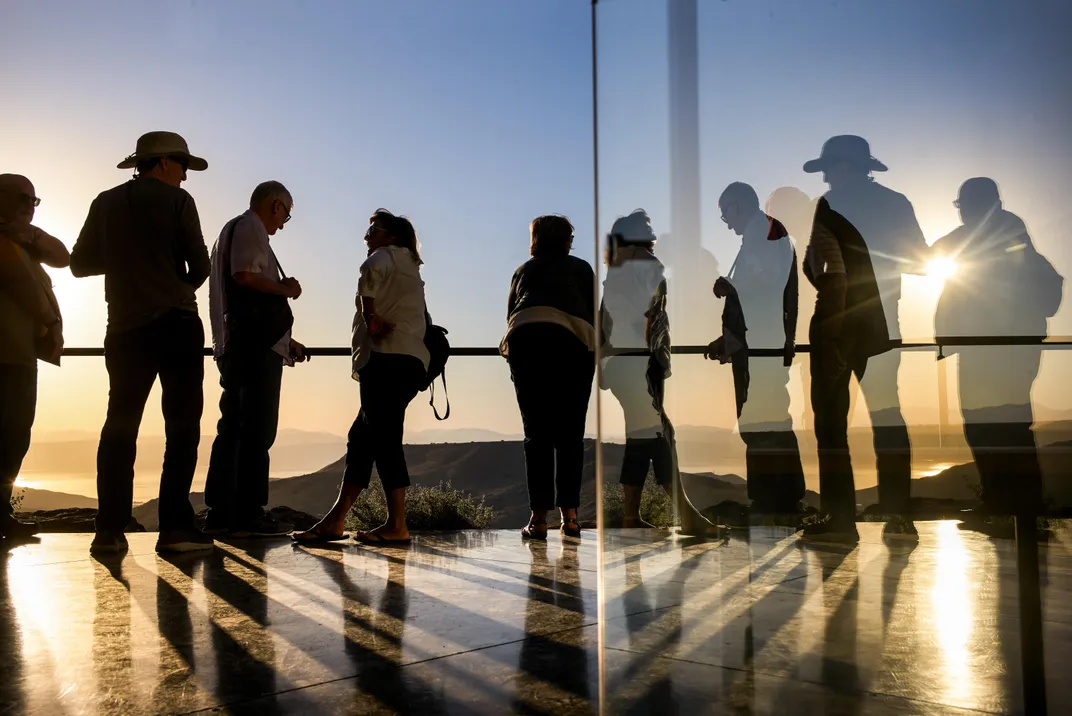
On the wall of the house’s main salon is a photograph of Aziz’s brother, Tayseer. When 19-year-old Tayseer was released from prison, in 1991, he was vomiting blood. His family rushed him to the hospital, but it was too late. Aziz reflects that it was hard to abandon a desire for revenge, but demonizing and dehumanizing the enemy, he says, only serve to fuel the conflict. He realized he had a choice to defy that impulse.
From the kitchen, Aziz’s mother, aunts and sister-in-law emerge with huge pots of maqluba , “upside down” in Arabic. With great flourish, they invert the pots and present perfectly layered towers of rice, chicken and vegetables. A band whose members are Israeli and Palestinian performs songs reflecting both traditions. Aziz and his nephews teach us some Arabic dance moves while his parents, clad in traditional Palestinian robes, look on in amusement.
On Sunday morning, we make our way through the teeming alleys of the Old City, where merchants pushing handcarts cry out for right of way through processions of Franciscan monks in rope-belted robes and hordes of tourists. Hidden behind a high wall, we find the 19th-century Church of the Redeemer. Its cool, geranium-decked courtyard is an unexpected oasis from the bustle of the ancient city.
After a church service, Oded brings us to the Western Wall, the last remnant of the Second Temple, which was destroyed by the Romans in A.D. 70. Known as the Kotel, it is the most sacred space in Judaism. As the midday sun beats down on the ancient stones, Oded holds up a copy of a famous photograph. It shows young Israeli soldiers in the Six-Day War who were the first to fight their way through Jordanian troops and minefields, uniting the city under Jewish control. The soldiers’ faces are battle-weary, but their expression as they gaze up at the wall is filled with awe. “Two thousand years of yearning in this photograph,” says Oded.
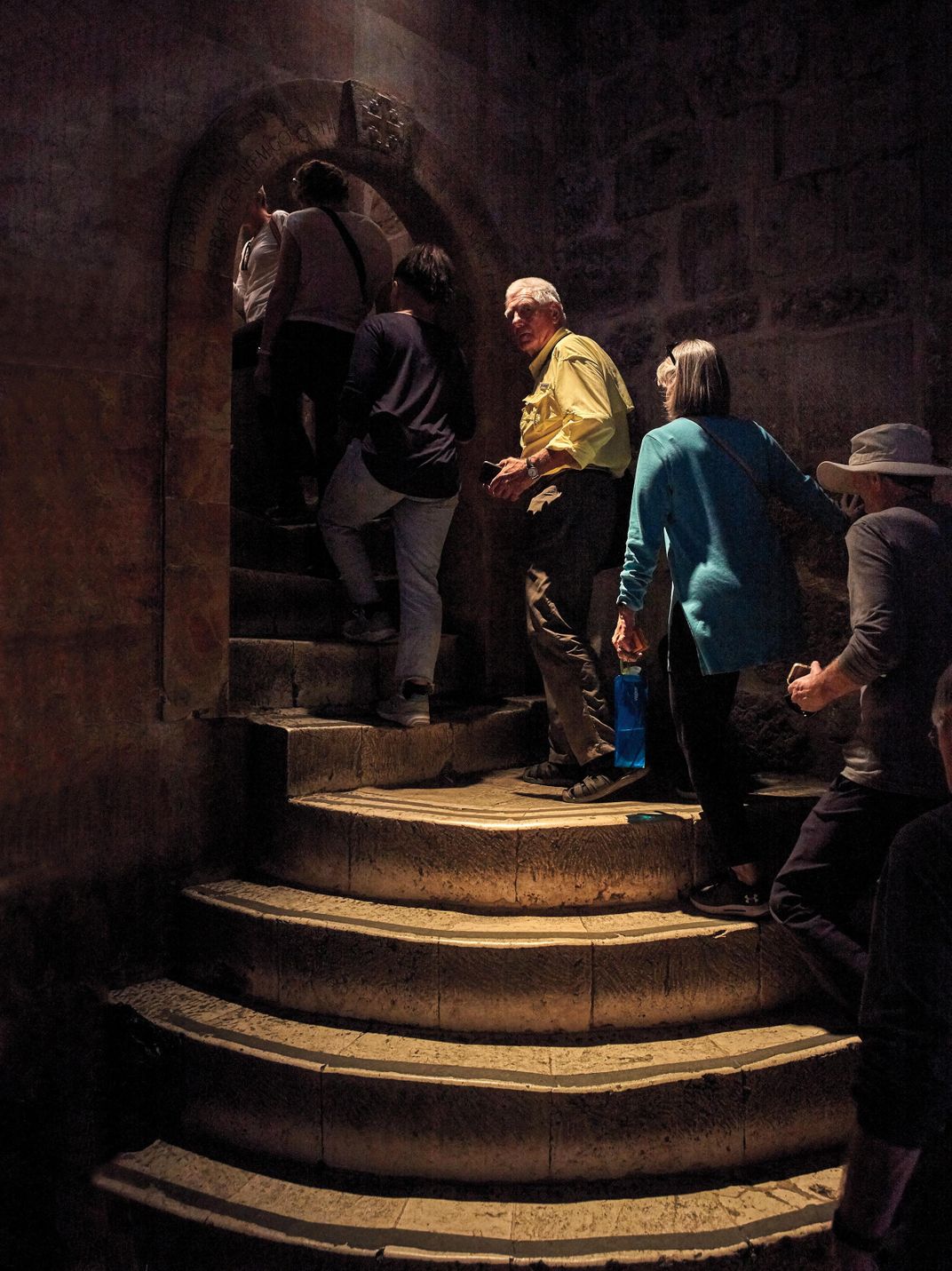
Oded outlines the evolution of Israel’s military vision, from the euphoric invincibility born of that swift victory in 1967—when Israel pushed the Syrian Army back from the strategic Golan Heights, drove the Egyptians out of the Sinai Peninsula and Gaza and the Jordanians out of the West Bank and East Jerusalem—to the beginning of the military occupation there that continues more than 50 years later. Then he explains the attempted reversal in 1973, when Egypt and Syria launched a surprise attack on Yom Kippur, the holy day when Jews fast and pray. It took hours to contact key reservists and several days to mobilize the unready forces. “We thought we were on the verge of the third temple destruction,” says Oded, meaning that it seemed possible the Jewish state could be wiped out, as it was in ancient times.
That afternoon is spent at Yad Vashem, Israel’s Holocaust memorial and museum. I wander outside, to the Garden of the Righteous Among the Nations, in search of a plaque honoring Dervis and Servet Korkut, Muslims who sheltered a Jewish girl during the Nazi occupation of Sarajevo. Dervis Korkut, an Islamic scholar and the national museum’s chief librarian, also saved a masterpiece of medieval Judaica, a rare illuminated codex known as the Sarajevo Haggadah.
In 2008, I wrote a novel, People of the Book , based on the journey of that haggadah, imagining the stories of those who carried it to safety over hundreds of years. The haggadah was created in Spain before the Inquisition, at the time of La Convivencia , or The Coexistence, when Muslims, Christians and Jews lived peacefully together until violent Catholic bigotry forced Muslims and Jews into exile. The haggadah was saved from Catholic book burning by a priest in Venice in 1609, and, by the 19th century, had made its way to Sarajevo, where in early 1942 Korkut saved the book from Nazi looters, hiding it among Qurans in a mosque. Fifty years later, Sarajevo’s own celebrated convivencia was ripped apart by ethnic cleansing during the Bosnian War. This time, another Muslim librarian rescued the haggadah as the museum was being shelled. For many, the book has come to symbolize how an ideal of multiplicity—of religion, of ethnicity, of culture—can survive, if only enough people care.
Novelists live by imagining the unlikely, and walking in Yad Vashem’s sun-dappled, pine-fragrant shade, my mind drifts to an alternate narrative in which that Syrian border in the north isn’t filled with skeins of razor wire, and a person of any background or creed could hop in her car and drive those 37 miles for dinner in a peaceful Damascus. It’s the kind of reverie that feels irresistible when visiting this place.
Back in 1991, when I was still a foreign correspondent, I asked people across the region to play this mind game with me on the eve of the Madrid Peace Conference, the first time Israeli and Palestinian officials sat down publicly to speak about an accord. At first, everyone shrugged off my question: Peace was impossible, the hatred ran too deep.
But when I prodded, they began to unspool wondrous visions of a golden age of friendship and prosperity, a convivencia for a new era. A Palestinian shipping magnate exiled in Jordan dreamed of plunging into the surf at Caesarea, as he used to as a child. A Syrian man longed to visit the place his parents had honeymooned on the West Bank. An Israeli cartoonist told me he just wanted to “sit and schmooze over coffee, like normal neighbors.”
It was bittersweet to recall those conversations, yet it seemed apt to reflect on such possibilities at Yad Vashem. Israel and Germany had become staunch allies less than half a century after the Second World War. Who had a right to say peace was unthinkable?
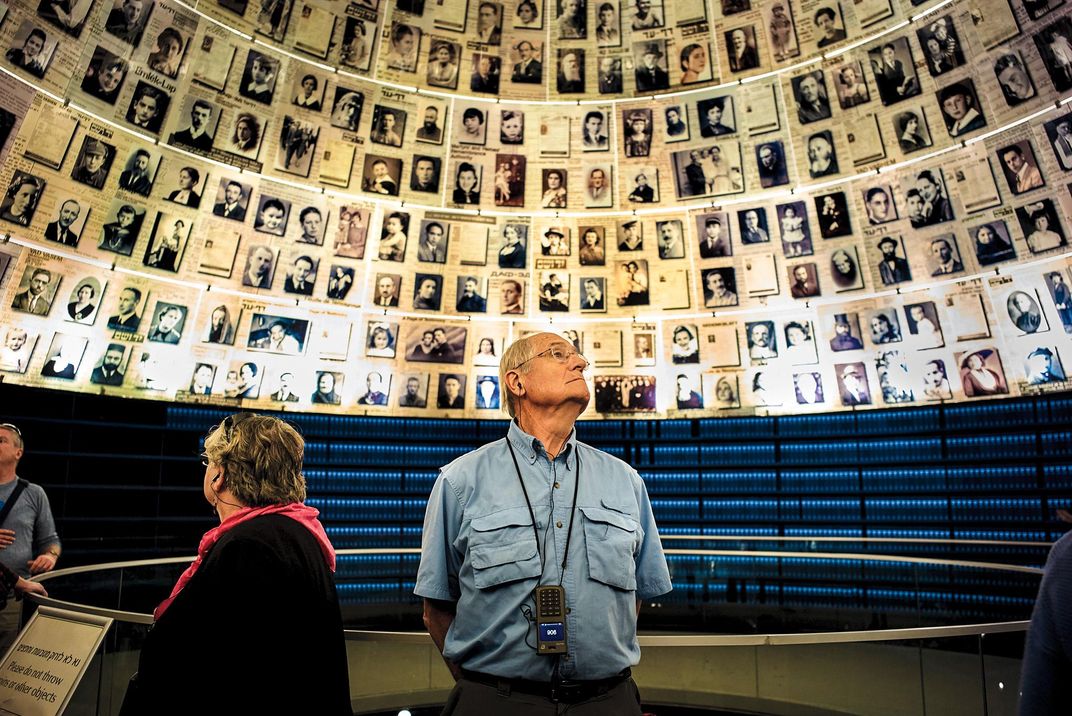
When I rejoin our group, they are meeting with Berthe Badehi, a Holocaust survivor who spent her childhood hiding from Nazis among French farmers. After the war, she immigrated to Israel, and she recalls her astonishment the first time she went to the bustling food market of Jerusalem’s Machane Yehuda. “There were Jews everywhere,” she says. “I had been in hiding all my life. Finally, here was a place to be myself.”
But there was a high price. In 2002, her oldest grandson was killed at 22, when he was part of an army unit attempting to free Israeli soldiers trapped inside Palestinian leader Yasser Arafat’s besieged compound headquarters during the Second Intifada. She shows us a picture of the young man, and Oded gasps. He recognizes him. He embraces Berthe, and tells her that he lives in the same community as another of her grandsons, where every year they commemorate her elder grandson’s death. It is another reminder of the intimacy and interconnectedness of this society.
The next morning, we visit the “City of David,” an extensive and glossily presented archaeological dig just outside the southern wall of the Old City. Excavations have uncovered the ruins of a large palace possibly built during the Davidic era (c. 1000 B.C.), as well as the probable source of the ancient city’s water supply. I had been here before, researching The Secret Chord , a novel I wrote about the life of King David. Then, as now, the excavations fueled my imagination, conjuring the city as it is described in the Bible, rising up out of the crumbled stones, peopled with musicians and artisans.
Our guide to the site, a British immigrant to Israel, is a practiced presenter who radiates enthusiasm as he describes a recent discovery: a processional way closely matching details from the story of young Solomon, mounted on his father’s mule, anointed king by Tzadok the priest and Nathan the prophet—a ceremony still enacted at every British royal coronation.
For a person like me, who excavates the past for fiction, it’s easy to get swept up by all of this. But I am shaken from my daydream when we tour Silwan, the predominantly Palestinian village that sits atop the excavations. Our guide here is neither practiced nor fluent in English, just an old man in a dingy robe who fears for his neighborhood. Many of the humble dwellings here are cracking, undermined by the excavations, and others have been occupied by Jewish settlers. There is palpable tension, as Palestinians sidle warily past armed Israeli guards to reach their homes, while Israeli school buses have mesh over the windows to protect against stones, Molotov cocktails, or worse. If this was, indeed, the site of David’s city, I imagine he would despair to find it in such a state.
Our final stop is a close-up look at the separation barrier, which, when it is completed, is designed to carve the landscape for 440 miles. The first sections were built in 2003, at the height of the Second Intifada, when, Israel says, it was necessary to prevent suicide bombings, which have practically ceased since. But for Palestinians, the wall has meant further loss of land; in some places, families have been separated, and many farmers have lost access to their own fields.
In 2017, the British artist Banksy opened the Walled Off Hotel, not far from Bethlehem. Billed as the hotel with “the worst view in the world,” it is hard up against a soaring concrete section of the Palestinian side of the barrier, which has become a canvas for portraits of Palestinian resistance figures and for sarcastic graffiti: “In my previous life I was the Berlin Wall. The beer was better there.” “Make hummus not walls.” The hotel is part political statement, part immersive artwork, with edgy décor like the bullet-strafed water tank that fills the hot tub in the presidential suite. A sardonic multimedia account of the conflict, delivered in a plummy British-colonial accent, concludes with the line: “If you are not completely baffled, then you don’t understand.”
Visitors nod in agreement.
We share a farewell dinner at the Eucalyptus, a kosher restaurant in Jerusalem, where the Israeli chef, Moshe Basson, explains how he uses indigenous ingredients, including many frequently mentioned in the Bible—hyssop, dates, pomegranate, almonds.
Over an array of fragrant dishes, the guests share the lessons of an intense week.
“Before I came, I didn’t know what I didn’t know,” observes Kim Morton.
“I came thinking I was going to hear two sides,” says Roger Bennett. “Now I’ve figured out there are many more than two sides.”
For Craig Linn, the most enlightening moment came in Yad Vashem. “The need for security is so great,” he says. “When Berthe says, ‘I just wanted a place where I could be myself.’” He pauses, recalling the emotion of the moment. “But then, the Palestinians feel that, too....”
Cathy Long, who is a generation older than our guides, takes a personal tone. “I’m leaving all of this feeling you two are my sons,” she says, her voice catching. “I just wish there was an answer, something we could do, so that your kids could be safer.”
Oded, who has two small children, is clearly moved. “I hope that next time you come, there will be something more positive to show you,” he says. “But you help by keeping an open heart, and by being curious about everything.”
Aziz concludes the meal by quoting the poem “Tourists,” by the celebrated Israeli poet Yehuda Amichai. The poem is shot through with bitterness about the way some tourists see his country, connecting more with its edifices than its people. In the last lines, a tour guide fixates on a Roman arch not far from the Tower of David, in the Old City.
Redemption will come
Only if their guide tells them,
“You see that arch from the Roman period?
It’s not important:
But next to it, left and down a bit,
There sits a man who’s bought fruit and vegetables for his family.”
The tower Amichai mentions is one of the most prominent features of the city’s ancient wall. When I was a young reporter covering the conflict, I would often sit in the evenings on a bench in the lovely old neighborhood across the valley, and gaze at the tower as the moon rose behind it, turning the stones pearly against a blushing sky. In those days, it provided a moment of solace after witnessing so much violence.
The morning after our final meal, as the group disperses to catch flights homeward, I visit the tower again. There is no weary man with his vegetables resting there today. In fact, as I climb the steps to the base of the tower, the area is unexpectedly deserted. For a few minutes, I’m alone.
When I was writing my novel about King David, I wanted to set a scene inside the tower that bears his name. But my research quickly revealed that the striking stone structure had nothing to do with him. King Hezekiah may have built the first tower on the site, long after David’s era. In time, that tower fell, and other structures rose in its place, as Jews, Romans, Byzantine Christians, Arabs, Crusaders and Ottoman Turks bled and died for control of these stones. The graceful edifice that stands today is actually a minaret—the remains of a mosque built in 1637.
And that makes it the perfect symbol of this land’s many-layered narratives, the inspired fictions we cling to and the painful truths we bury.
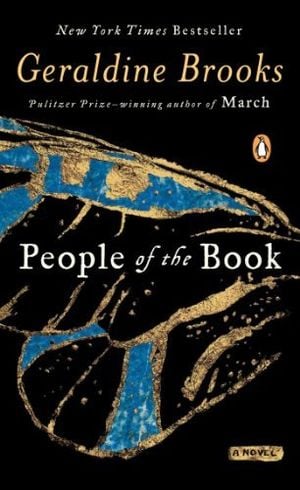
People of the Book
Inspired by a true story, People of the Book is a novel of sweeping historical grandeur and intimate emotional intensity by an acclaimed and beloved author.

The Secret Chord: A Novel
Peeling away the myth to bring David to life in Second Iron Age Israel, Brooks traces the arc of his journey from obscurity to fame, from shepherd to soldier, from hero to traitor, from beloved king to murderous despot and into his remorseful and diminished dotage.
Get the latest History stories in your inbox?
Click to visit our Privacy Statement .
A Note to our Readers Smithsonian magazine participates in affiliate link advertising programs. If you purchase an item through these links, we receive a commission.
Geraldine Brooks | READ MORE
Geraldine Brooks is the author of several books, including the Pulitzer Prize-winning novel March .
David Degner | READ MORE
David Degner is an editorial photographer based in Boston, Massachusetts.
Find Us On Facebook
Follow Us On Instagram
Join Our Mailing List
Life-changing Tours Since 1987 - Call Us Toll Free: 800.322.0788
Tours to the Holy Land: Trips & Israel Tour Packages 2024, 2025
"Every place we visited was breathtakingly beautiful, with stunning landscapes and rich historical and cultural heritage. We highly recommend visiting Israel to anyone who wants to experience an unforgettable journey. We had a life-changing time there and are already planning to return." Simon L. and Beatriz G. – Tour to Israel/Egypt/Jordan February 2024 "I had a wonderful time in Israel. I felt while I was there the precautions that were taken for our safety were well in hand. I still got to experience many holy sites and be blessed by walking the path that Jesus walked. Every day was started in prayer, singing, or scripture reading which also extended the blessing of the trip." Quincie L. – Tour to Israel/Egypt/Jordan February 2024
Our Israel tours & Holy Land tours of 9-24 days for the Evangelical Protestant Bible believer are what Pilgrim Tours does best. Prepare yourself for a life-changing journey to walk where Jesus walked and visit Jerusalem, Galilee, & Samaria. Each of our Israel tours is led by a local guide who is an experienced expert on the historical, cultural, scenic, and spiritual history of the Holy Land. If you travel with 10 or more people, a private group tour can easily be arranged. Pilgrim Tours can customize an itinerary to fit your group needs with many options to choose from.
Concerned about safety? As a Christian tour operator, the staff at Pilgrim Tours takes a Biblical perspective regarding the current situation in the Middle East. We do not believe that peace in Israel is something that will occur until the Prince of Peace comes to restore His kingdom. Please do not make a reservation with us based on the hopes of a calm future. If you long for the special blessings only available in Israel, we will take you there. An expert driver and guide will carefully keep you from any areas that could present a problem and treat you to the riches of Israel as our special guest.
Below is a large variety of Israel tour packages departing in 2024 and 2025 year-round.
View Our New Israel Tour Highlights Video! Click Here
Reserve your tour at least 6 months in advance for an early booking discount, groups and parties of 6 or more click here for special rates, scheduled 2024 & 2025 israel tours.
View our Israel tours ranging from 9-24 days.
Take a tour of a lifetime and bring the Bible to life.
Featured Sites in Israel
Explore a vast selection of beautiful historical and Biblical locations throughout Israel with our Israel Holy Land tour. You can visit Jerusalem, Galilee, and parts of Samaria, getting the life-changing opportunity to see where Jesus and many other Biblical figures lived and walked. We even offer Holy Land tours that allow you to see the Dead Sea, the Garden Tomb, and the Jordan River Baptism Site. Like all of our Europe tours , our Israel Holy Land tours are led by local guides who have extensive knowledge of the area and its history. If you want to experience the history of Israel and see the Bible come to life, our Holy Land tours give you that opportunity.
The city of Jerusalem offers a unique convergence of Judaism, Christianity, and the Muslim faith. For Christians who visit Jerusalem, you will learn about many stories of the Bible while walking her streets. Many actors in the Bible such as Abraham, King David, King Solomon, the twelve disciples and Jesus all lived, visited, or spent time there. The Passion week of Christ will be highlighted during our stay as we visit the Mount of Olives, the Garden of Gethsemane, the Western Wall, the Way of Suffering, and the Garden Tomb.
Sea of Galilee
Nowhere in Israel does the Bible come to life more than along the shores of the Sea of Galilee. Pilgrims who visit the Galilee region have the opportunity to imagine what life was like 2,000 years ago and what Jesus and the twelve disciples experienced while fishing on the Sea of Galilee. The peaceful setting and the natural wonders of the Golan Heights to the east and Mt. Arbel to the west make for a great way to start your morning in quiet reflection. During our tour, we explore the Biblical towns of Capernaum, Magdala, and Nazareth and take a meaningful cruise on the Sea of Galilee.
The Dead Sea is not only the lowest and most lifeless lake in the world, but also nearly 10 times saltier than the ocean. Travelers will enjoy the beautiful colors of the blue water and the red mountains of Jordan to the east. Take time to enjoy a once-in-a-lifetime Dead Sea “float” either in the sea itself or at one of the warm salt water pools at our hotel. The Dead Sea experience is truly a bucket list visit you won’t want to miss!
Garden Tomb
Our visit to the Garden Tomb and its surrounding gardens is normally one of the highlights of our tour to Israel. The Garden Tomb is a rock-cut tomb in Jerusalem that was unearthed in 1867 and is considered by some Protestants to be the site of the burial and resurrection of Jesus. Our visit offers a unique time of prayer, reflection, communion, and praise, which will be a special life-long memory for many travelers.
Jordan River Baptism Site
The Jordan River Baptist Site or “Yardenit” is a baptism site located along the Jordan River just south of the Sea of Galilee in northern Israel. This site is frequented by Christian Pilgrims who enjoy imagining the setting of the baptism of Jesus. For anyone who would like to be baptized in the Jordan River, Yardenit has been developed to be a peaceful setting with beautiful gardens, clean colored water, changing facilities, showers, and a nice souvenir shop.
Caesarea Philippi
To many Pilgrim travelers, Caesarea Philippi is a special surprise while on their tour. Located along the rushing springs of Mt. Hermon, the beautiful and natural setting is where Jesus asked his disciples “Who do men say that I am?” He asked this question while observing the pagan worship of the god Pan as worshipers offered their sacrifice at the “Gates of Hell.” Our time at Caesarea Philippi is one of many opportunities throughout our tour to see the lessons and message of the Bible come to light in a special way.
Israel Tours: Frequently Asked Questions
What is the best month for the Holy Land tour?
Taking a trip to Israel during the spring or fall offers the most enjoyable weather of the year but normally has the largest crowds. If you want to enjoy a peaceful tour with fewer crowds, consider visiting between December and February or June and August. We offer Israel and Jordan tours throughout the year, so you can select a trip that works for your schedule.
How many days do you need for a Holy Land tour?
We offer several types of tours of the Holy Land, so the duration of your tour depends on the tour package you choose. The Best of Israel Tour is our most basic offering and includes a Sea of Galilee boat ride, a trip to the Jordan River Baptism Site, the Dead Sea, and many opportunities to walk on the same land Jesus walked on. This is our shortest trip at just 9 or 10 days. Our most involved trips allow you to experience a wide range of historical locations over the course of a few weeks. Egypt tours are included in some of these packages, as well as tours in Greece and other countries. These tours can take up to 24 days, giving you the chance to spend an extended period of time learning about and visiting different parts of the world. From our Turkey tours to all of our Israel Christian tours, all of our tours feature a first-class hotel rating for the country you visit. We do offer some upgraded tours that offer better lodging options. You can review our hotel categories at https://www.pilgrimtours.com/company/hotelcomparison.htm . Check out any of our tours to view a day-by-day itinerary and see what amenities are included with each tour.
What is the dress code in Israel?
The dress code in Israel is different from other parts of the world. There are a few dress code basics you should understand before booking Israel tours: When you’re in Israel, there is no strict dress code. You can wear what you feel comfortable wearing. However, both men and women should try to dress conservatively and cover their shoulders and knees when visiting any of the religious sites throughout Israel. Generally speaking, it’s best to avoid tank tops and shorts. Men need to cover their heads when visiting the Western Wall. Pilgrim Tours provides a Pilgrim Tours ball cap upon arrival in Israel, but you might consider purchasing an affordable kippa that you can bring when you visit Jewish sites. Some places may offer a free kippa, but these are generally low quality. (Women are not required to cover their heads at any sight.) You can figure out what you need to pack and how to dress each day by looking at the itinerary for our Holy Land tours. Guides normally offer guidance on how to dress for the next day while on tour. We also suggest looking at the extended weather forecast as you prepare and pack for your trip.
Is there a lot of walking involved on an Israel Tour?
Our Israel tours do require a significant amount of walking each day and you should be able to walk unassisted 3-4 miles per day on average. Make sure you have a comfortable pair of shoes that provide adequate support. While there are bus and boat rides during these tours, you have to walk quite a bit to explore some of the Biblical sites. Our tour guides normally give the group a few options at sites for those that have physical limitations. One thing to keep in mind is that there are many hills and valleys in Israel which can make walking even more taxing. The amount of walking you have to do may vary based on the tour you take, so look at the itinerary before choosing your tour. The good news is that Israel is a beautiful country to see on foot, and you’ll have several opportunities to sit down and give your feet a rest. As long as you have a good pair of shoes and comfortable clothes, it’s easy to forget about all the walking you’re doing and enjoy the tour.
What passport & visa information do I need for your Israel tours?
U.S. citizens need a valid U.S. passport with at least six months validity beyond their intended stay to enter Israel. Make two photocopies of your passport. Leave one copy at home and carry the other separately from your original. Israel: U.S. and Canadian Citizens do not need a Visa when entering Israel. Non U. S. /Canadian Citizens are responsible to fulfill appropriate entry requirements of destination. Contact your Consulate office for requirements.
What common languages will be spoken during your Israel tours?
Hebrew, Arabic and English.
What currency can I use on your Israel tours?
The U.S. dollar is widely accepted across Israel, and we suggest bringing about $30 for each day you’ll be on tour. U.S. dollars are recommended for use for small purchases and lunches. Lunches typically cost $15-20. It is important to bring about 20 $1 bills as some bathrooms charge a small fee for use. Credit cards may also be used for larger purchases. ATMs in Israel are all connected to European and American banking systems. Please be advised that the ATM machines dispense money in SHEKELS – NOT U.S. DOLLARS. Please notify your bank before traveling overseas.
Do I need to bring a converter for the Israel tour?
Israel uses the European plug with two round pins. You will need to bring along the necessary converters and adapters to operate any 120 volt appliances such as hair dryers and electric razors as well as camera and cell phone chargers. Electricity in Israel is 220 volts 50 Hz.
What is the time zone for your Israel tours?
The time zone for Israel is seven hours ahead of EST and two hours ahead of GMT.
What climate should I expect during your Israel tours?
In Israel the climate is temperate, and temperatures all year-round are reasonable. Israel has two main seasons: winter (from November to March) is cold and rainy in most parts of the country; summer (from April to October) is hot and dry with little or no rainfall. The desert areas can be extremely hot in summer time.
Recent Reviews on Trustpilot, BBB, & Google
View what others are saying about our Israel tours on Trustpilot , BBB , and Google !
"Pilgrim tours is who I'll be recommending people to travel with. We've been trying to get to Israel for two years and finally made it!! Great company from booking to on the ground with great guides. All details taken care of with great hotels, bus, and the best guides!! Wonderful experience!"
"We had a great experience in Israel with Pilgrim Tours. Everything went very well and there were no glitches or problems of any kind. The bus and driver were top notch as were the hotels and daily breakfast buffets. Our tour guide was great as his depth of knowledge of the people, history and languages Israel was quite amazing. We will very likely use Pilgrim again in the future."
"We have toured with Pilgrim Tours three times and what a blessing. Accommodations, excursions, information and food were all high quality. Post pandemic, we were so thankful to return to Israel."
"I couldn't have asked for more for a trip to the Holy Land than what Pilgrim Tours provided me. It was the perfect balance of spiritual reverence, history, geography, and social issues. I am so grateful for the experience that I had on this trip."
"Our church group just returned from taking a "Best of Israel" ten day tour. It was one of the best experiences of my life. I am so glad we chose Pilgrim tours. From our excellent hotel accommodations, to our wonderful tour guide, we enjoyed everything. Our trip exceeded our expectations. I would recommend Pilgrim Tours to anyone who is planning a trip to the Holy Land. We definitely plan to travel with them again."
View some of the sites from our Israel tours!
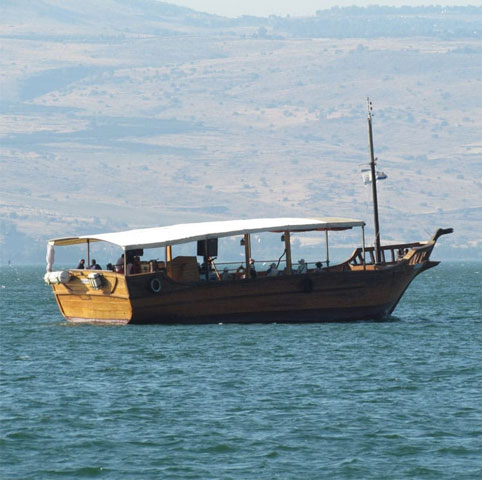

Israel Travel & Adventure Blog
By noah tours.
- Holy Land Tour: How to Plan an Unforgettable Journey
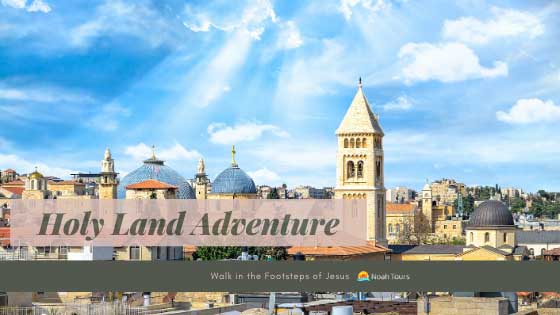
Find Out Everything You Need to Go on a Spiritual Trip to the Holy Land
Did you ever dream of walking in the footsteps of Jesus Christ? There is nothing better than seeing the sites from the Old and New Testament with your own eyes. A Holy Land tour may be the perfect way to do so. Going on a Holy Land tour with a local, professional guide that has dedicated her/his life to learning about the Holy Land can be a great way to learn more and make the most out of your visit to Israel. Though this can be done on a private basis, you can also organize your own group and go on this journey with your own spiritual community.
To help you start planning, we’ve made a list of the top 10 tips you must know before visiting.
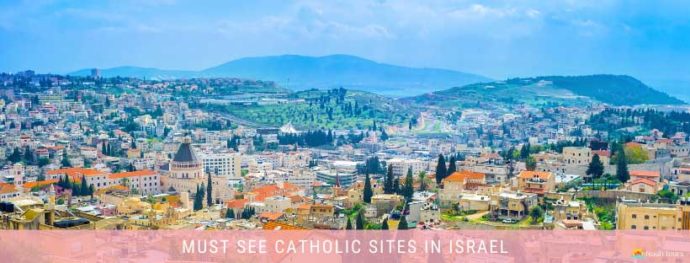
Nazareth, Israel
1. What are the Must See Sites in the Holy Land?
There are so many significant sites to visit during your tour to Israel. With so many options, it can get pretty difficult to choose, but don’t worry – we’ve made a list of 11 sites you must visit.
Nazareth and the Church of Annunciation is an important place to Christians from different denominations and should not be missed, as Jesus of Nazareth spent a lot of time in this area.
Cana is famous as it is the place where the miracle of Jesus turning water into wine took place. Additionally, it is home to the popular “Wedding Church” where many happy couples renew their vows to this day.
Magdala is the place where Mary Magdalene was born. It is now possible to visit the remains of the ancient city and feel what it was like to live during Jesus’s time.
Mt. Beatitudes , where Jesus gave the “Sermon on the Mount”, also offers a beautiful view of the area. Look around and enjoy the view Jesus saw with his own eyes when giving the sermon!
Mt. Tabor , on the top of this beautiful mountain, is The Church of Transfiguration. It was built in honor of the transfiguration of Jesus himself, which according to tradition, took place right there.
Jericho is perhaps the oldest city in the world, located in the scenic Judean Desert. This is the place where the devil attempted to tempt Jesus Christ. Don’t miss the opportunity to ascend Mt. Temptation and witness it with your own eyes.
Bethlehem is a must. The Church of Nativity located at Manger Square is said to be built right where Jesus was born.
Mt. Olives is a cemetery that once was covered in olive groves. Now, it overlooks the Old City of Jerusalem and offer a breath-taking panoramic view of the city.
The Garden of Gethsemane is the very place where Jesus prayed and his disciples slept the night before his crucifixion.
Via Dolorosa , the Stations of the Cross, is where you will literally walk in the footsteps of Jesus. Make your way past the very places Jesus saw on his way to the cross.
Church of the Holy Sepulcher , where Jesus was crucified, is another site to visit when in Jerusalem.
2. What Hotels are Best Suited for Pilgrims?
No tour can be complete without the right accommodation. Choosing the right hotels is a crucial part of any tour and can add a lot to the experience.
So what would our team recommend? There are many good accommodation options to choose from. If you would like to stay at traditional hotels, check out our post about hotel classes in Israel . If you would like a more authentic pilgrimage experience, these are our top 3 choices:
Magdala Guesthouse
The Magdala Guesthouse is located in beautiful Magdala and offers a pleasant home to any pilgrim.
Mt. Beatitudes Guesthouse
Clean, calm and full of kindness – this is a lovely way of experiencing the Galilee.
Notre Dame of Jerusalem
What better way is there to experience a historical city than to stay at a historical building? Notre Dame of Jerusalem has been welcoming guests since the end of the 19th century. Many pilgrims enjoyed the guesthouse’s hospitality and its excellent location, right next to the Old City’s walls and the New Gate.
3. How to Decide on your Group’s Size
We offer both Private Holy Land Tours for small group and individuals, as well as an option to organize a group and visit with your church and community. A private tour option is most recommended for couples and families, as it gives more flexibility when choosing sites to visit and determining a certain pace. Bigger groups, on the other hand, though less flexible, are often very meaningful for the participants. It lets a community unite in a beautiful, mutual experience, which is different than the regular routine at home.
Once you decide which option suits you best, simply contact our team and one of our experts would love to assist with organizing a tour for you and your loved ones.
4. Guides and Spiritual Leaders
We recommend that the group come with its own pastor/leader rather than searching for a local one. This will ensure that you will be accompanied by your own spiritual leader who resonates with you. It gives your Holy Land tour a warmer feel. Additionally, you will not need to depend on local clergyman in case you would like to have a Mass, baptize in the Jordan River or renew your vows in Cana.
5. How to Book Masses in the Holy Land
The one crucial factor to booking masses is very simple: book in advance to secure availability at your preferred churches. From our experience, masses are booked many months prior to arrival and availability becomes quite scarce as your arrival grows nearer.
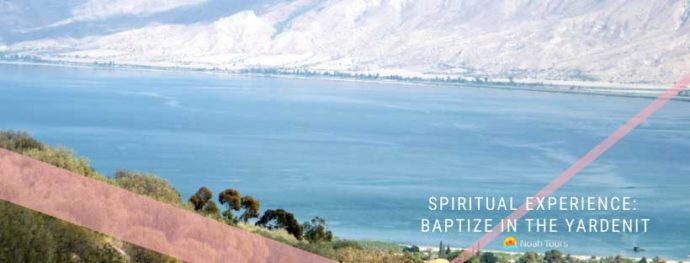
The Galilee Sea, Israel
6. Where is the best Baptism Site?
A “literal” way of walking in the footsteps of Jesus is to baptize in the Jordan River. This is a great way of reconnecting and having a spiritual moment, though we may recommend reconsidering it in case you arrive during the cold winter…
The most popular baptism site to visit is the Yardenit , right near the Galilee Sea itself. It is a well-established site that’s been welcoming pilgrims for quite a while now. This site is considered one of the most important sites in the Galilee and we also include this in our Israel tour packages , which are suitable for all faiths. Another great option is the rising Qasr al-Yahud baptism site, located further to the South of the Jordan River, near Jericho.
If you plan to baptize in any of these sites, another important thing to keep in mind, there isn’t always a pastor available. It is best to have your own spiritual leader with you so you won’t rely on others for the ceremony.
7. Couples Activity: Renewal of Vows in Cana
One of the most meaningful moments of our lives is the day one marries a beloved partner. Sometimes, daily routine may make us forget why we decided to share our lives together. A great way to remind ourselves of the reasons is to renew the vows we took all those years ago. And what better time is there to do this than right now, in the Holy Land, where Jesus walked?
We are always thrilled to help our guests renew their vows at the Wedding Church in Cana. If you do not have a pastor travelling with you, we recommend booking this in advance, in order to secure avaialbiltiy for a clergyman. Let us know your preference and our team will handle the booking. Happy renewal!
8. How to book your Christmas Holy Land Tour
Christmas is one of the most popular times for pilgrims to visit. Going on a Holy Land tour during this time is definitely an unforgettable experience. Christmas trees are being lit in Nazareth, Jerusalem and of course, Bethlehem, Jesus’s birthplace. What better way to celebrate Jesus’s birth than to visit the very place he was born?
Many of our travellers find this a meaningful experience, whether they go on a private tour or join one of our Israel Chritmas tour packages – now available for 2020-2021 !
9. What to Know when Visiting during “Holy Week”?
Visits during Easter has its benefits and draw-backs. Visiting the holy sites during a holiday is certainly a unique experience. A big bonus is that the weather during Spring in Israel is usually perfect for travelling at this time: warm, but not too hot.
As Easter usually falls at the same time as Passover, a national Jewish holiday, the Holy Week is is a very busy time to visit Israel. Pilgrims and Jews love to visit during this time. Many sieze the opportunity to enjoy the nice weather so holy sites and nature reserves alike tend to be very crowded. Additionally, due to the large amounts of visitors, some churches may be closed for visitors.
10. Should You Take Pictures of you and your community, or Focus on Sites?
In today’s world, taking pictures is becoming a norm of everyday life. We recommend making your pictures personal: rather than taking pictures of a location that have been photographed time and time again, make sure to have your picture with loved ones taken there. This will transform the picture into a precious memory you’d love to look at when you’re back home.
11. Don’t Go Home Empty Handed! Pilgrimage Certificates through Noah Tours
We’d love you to take home some great memories from your Holy Land tour and what better way than a souvenir? Noah Tours arranges for a pilgrimage certificate for all of our pilgrim groups.
Any questions? Don’t be shy! Our team would be more than happy to speak with you. Contact us here for further information regarding Holy Land tours.
No Comments Yet
Please leave a comment in the box below
Your Comment is Appreciated Cancel reply
Save my name, email, and website in this browser for the next time I comment.
Recent Posts
- 7 Best Luxury Hotels in Egypt You Don’t Want to Miss!
- 8 Best Luxury Hotels in Jordan You Must Know
- 10 Best Luxury Hotels in Israel: Find Out Where to Stay!
- Milos Dead Sea Hotel
- Kind David Stables, Jerusalem
- February 2020
- January 2020
- December 2019
- September 2019
- January 2019
- November 2018
- November 2017
- October 2017
- August 2017
- Israel Private Tours: Best Luxury Hotels in Egypt
- Israel Private Tours: Best Luxury Hotels in Jordan
- Israel Private Tours: Best Luxury Hotels in Israel
- Best Israel Hotels
- Israel Travel Guide
- How to get a visa to Israel Jordan and Egypt easily
- Mizpe HaYamim Hotel
- Beresheet Hotel
- King David Stables
- Makhtesh Ramon
- Qasr al-Yahud
- Movenpick Resort Petra
- Western Wall Tunnels
- Bahai Gardens
- Kempinski Hotel Ishar Dead Sea
- Fairmont Amman Jordan
- The Scots, Sea of Galilee
- The Noah Tours' Experience
- 14 Israel Tour Essential Insider Travel Tips
- King David Hotel, Jerusalem
- The Jaffa, Tel Aviv-Jaffa
- Exciting Israel Activities
- The Setai Sea of Galilee, Tiberias
- Israel Family Tours: Ultimate Family Activities in Israel
- The American Colony, Jerusalem
- The Efendi Hotel, Akko
- Herods Dead Sea Hotel
- Kibbutz Ein Gedi
- Mamilla Hotel Jerusalem
- The Norman Tel Aviv
- Memories of Aicha Camp, Wadi Rum
- City of David, Jerusalem
- Exhilarating ATV Experience
- Druze Culinary Experience
- The Israel Museum, Jerusalem
- Marina Divers, Eilat
- Tower of David, Jerusalem
- Yad VaShem Holocaust Museum
- Top Israel Tourists Attractions
- Akko, Capital of the Knights
Posts by category
Recent posts.
- EXPLORE Random Article
How to Visit the Holy Land
Last Updated: April 9, 2023 Approved
wikiHow is a “wiki,” similar to Wikipedia, which means that many of our articles are co-written by multiple authors. To create this article, 22 people, some anonymous, worked to edit and improve it over time. wikiHow marks an article as reader-approved once it receives enough positive feedback. In this case, 91% of readers who voted found the article helpful, earning it our reader-approved status. This article has been viewed 66,477 times.
A trip to the holy is the trip of a lifetime! Many people prefer to embark on such a quest via a "guided tour"- but what if you're looking for a more unique experience? While it may seem daunting to consider from half a world away, it is possible to travel quite safely in this area, and bring home a different set of memories than a guided tour could provide.

- Unless you are comfortably well off, hotels are going to take a big bite out of your budget in a hurry. Consider staying in hostels, which can still run you up to $60 a night or so, in Jerusalem, less elsewhere; they are a much better way to soak up the local color, anyway.

- The average starting wage in Jerusalem is about $8 an hour; A small two bedroom apartment is about $1000 a month, or more. Most people work; 6 days a week, 12 hours a day is common. They are mostly all smiling- you will see very few dejected people here.
- The statement that they are "all" broke is possibly misleading, as this applies more to the younger set, which is typically less affluent anywhere. Even most of the younger set manages to have in home internet, possibly a car, etc.

- Dinner in east Jerusalem with Palestinians met in Old Town, Jerusalem, at the bazaar, was memorable. Unless you are of Arab descent, you probably won't go to the West Bank, or get into the Dome of the Rock; but, unless you're black, you probably wouldn't go to Watts or Compton, either, and they are both larger and more violent.
- It is against the law to carry even a pen-knife in Israel.

- You can save considerably by grocery shopping, but this isn't always practical when traveling. Their "grocery stores" are little Jewish or Arab quickie-mart sized places, but there the similarity ends. Still expensive by American standards, expect a great selection of nuts (20 different kinds is common; raw or...fry-glazed?), stuff that looks like Slurpees, only real fruit, and delectable, and they most amazing flavors of fruited gelato.
- The Arab stores are much more interesting, but don't bring Arab food to hang out with Jewish people; it's not like it causes a scene, but Jewish people eat kosher, so you may not be able to share- and sharing is a big part of this whole experience. Veggies, fruits, and nuts are kosher anyway, but they prepare them differently. Kosher food is great, too, but simpler.

- Israel is a country, while Jewish is a religion; there are also Muslims, and Christians here, all Israelites. Their government is Israelite, and they pretty much all feel about their government the same way you might feel about yours; it's their religion that plays a more central role- however, although you will certainly see Orthodox types, don't be expecting to be constantly bumping into people reading their holy book, or anything; this is a private matter to them, and there is no proselytizing here- and that means you.
- It all combines very delightfully, actually, to provide a distinct sense of spirituality, and a notable lack of religiousness.

- Expect communal dining and hostel-type accommodations; simple but solid, run by young Jewish interns; they pretty much grow everything- think combination plantation/farm.
- The only reason you'll ever want to leave is because it's pretty warm during the day (although quite dry), even in high season, and the Red Sea is calling you- you should bring empty suitcases for shopping in the Sinai, even if you're a nomadic type; the stuff there is just too cool, and too cheap.
- Air conditioned rooms with mosaic floors surround charming little courtyards with lots of palms and Bedouin style open tents for evening gatherings, for about $20 a day for two, or even less. The room held $3000 worth of musical instruments and previously purchased souvenirs, and the padlock, unused, was unnecessary.
- The Bedouins are easy-going, like the Egyptians, and will set you up with a driver to Mt. Sinai if you're so inclined. Little Bedouin girls (that speak whatever language you speak) sell you clever shell and wood jewelry for a dollar while you sit under a tent smoking a Sheesha by the Sea, waiting for your grilled seafood.
- Average per capita income in the Sinai is high for Egypt, about $130 a month, and the living is easy. Lease a brand new, sea-front condo for about $400 a month or less, if you decide not to return. Your whole trip, from America at least, is visa-free, too!

- This is a very spiritual way to see the holy land; walking with mostly Jewish pilgrims, listening to their stories- simply an experience you will never forget. You have to be willing to let go to do this, and be willing to roll with things; anecdotal stories here are precious things, however, and you will be glad to have your own to tell, if you wish.
- This is not for the faint-hearted, and you should be in decent shape when you start; you'll definitely be in amazing shape when you're done. Enjoy your trip to the Holy Land.
Community Q&A
- Realize, if you go to Jerusalem, that it is a holy city for three of the world's largest religions: Christianity (Jesus taught here), Judaism (this has been their holy city for literally thousands of years) and Islam (the Dome of the Rock is here). Many people of many ethnic and religious backgrounds will converge here, and you must be tolerant. Thanks Helpful 2 Not Helpful 0
- Israel, and more particularly the Sinai, tend to get "seconds" or even thirds in everything; things like fishing line and fishing stainless steel, BIC lighters, anything basic and solid you may take for granted that you bring can help pay for your trip. If you're planning on going as far as the Red Sea, 60-120lb fishing line and heavy-duty hooks will make you popular. Thanks Helpful 1 Not Helpful 0
- If you are a female, make sure to cover up as your skin could be offensive to some. Thanks Helpful 7 Not Helpful 6
You Might Also Like

- ↑ lonelyplanet.com -- Get a travel guide beforehand: "Israel and the Palestinian Territories"
About this article
Reader success stories.
May 9, 2017
Did this article help you?
Aug 20, 2023
Ken Rullestad
May 28, 2017
Luis Alvarez
May 26, 2017
Judith Armor
Jul 9, 2017

- About wikiHow
- Terms of Use
- Privacy Policy
- Do Not Sell or Share My Info
- Not Selling Info
Get the Hottest Deals First!

Iconic Israel
About this tour.
Discover the ancient world of Israel, where legendary stories of humanity’s collective history blend with the thriving dynamic of modern life. Your adventure starts in Tel Aviv, the chic center for spirited luxury and captivating nightlife. Get a taste of the local flavor during a home-hosted lunch in a Druze community. Step into the past and enjoy a cruise on the Sea of Galilee. Visit UNESCO World Heritage sites, including Jerusalem’s Old City. Gain a new perspective as you ascend the ancient walls of Masada by cable car. Float in the tranquil waters of the Dead Sea. From historic Nazareth to the sophisticated bustling hub of Tel Aviv, experience the all-encompassing essence of Israel.
Your Tour Includes
- 3 Handpicked Accommodations
Included Highlights
- Carmel Market Food Tour
Your Tour at a Glance
8 Breakfasts
Travel Style
Customize your tour.
$1,399.00 pp
Optional Excursions
Starting at $65.00
Activity Level
- Level This Tour
For specific details about this tour's activity level and other info to know before you book your trip, click here.
Extension Style
Travel styles, highlights and inclusions.
Must-See Inclusions:
Sail on the tranquil waters of the Sea of Galilee aboard a replica boat reminiscent of the 1st century.
Explore the Old City of Jerusalem including the Western Wall and the Via Dolorosa – the Way of the Cross.
Venture to the 2,000-year-old ancient Roman city of Caesarea.
Cultural Experiences:
Connect with the Orthodox Jewish community at a home-hosted dinner in Jerusalem.
Engage in a conversation with a Holocaust survivor at Yad Vashem.
Enjoy 2 nights in Tel Aviv, Israel’s dynamic and thriving strip of metropolitan life.
Culinary Inclusions:
Sample wines integral to Israeli traditions at a vineyard in the Galilee region.
Enjoy a traditional Druze lunch and learn about this Arab-Israeli community.
Get a taste for Israeli cuisine on a walking food tour in Carmel Market.
- Winery Visit
- Sea of Galilee
- Druze Lunch
- Mount of Olives
- Home-Hosted Dinner
- The Western Wall
- Holocaust Survivor Discussion
Book with Confidence
* With Insurance Purchased
- *No Hassle Refunds
- Traveling Well Safety
- No booking fee, *no change fees
- Top Rated Travel Protection
Share This Tour
Looking to add your itinerary for friends and family? Share your Itinerary
Getting Prepared
Know before you go, travel tips, enhance your tour.
Pre and Post Tour Extensions
Pre and Post Night Stay
Unique Experience
Cultural Experiences
Enhance Your Trip
- Tour Extensions

Extend your stay with 3 nights in Cairo – an ancient city with an intriguing past. Get a glimpse into the lifestyle of a pharaoh in the Grand Egyptian Museum, where you will peruse the relics and treasures from King Tutankhamun’s tomb. Wander along rows of antique charms, shiny pendants, and unique goods at the Khan el Khalili Bazaar. See the Egypt you’ve always imagined with a day trip to Giza – home to the iconic Great Sphinx and the renowned pyramids. Your other option is to booked pre night stay? Guided You’re accompanied by a Tour Manager throughout the extension, except for any time that’s set aside for independent discovery.
- Overnight Flight
- You’re on your way to Egypt. Step back in time and explore thousands of years of history, legend, and lore as you walk amongst timeless wonders.
- Cairo, Egypt - Extension Begins
- Settle into Cairo, an ancient city with an intriguing past. This evening, connect with your fellow travelers and get a taste of local cuisine at a welcome dinner.
- Start your day by exploring the remarkable collections of the Grand Egyptian Museum.* See the statues, reliefs, sarcophagi, and treasures from the tomb of Tutankhamun. Walk along el-Moez Street, admiring the elegant Islamic architecture of Historic Cairo (UNESCO) and enjoy some free time to shop in the world-famous Khan el Khalili Bazaar. Peruse colorful trinkets, hand-painted crafts, polished pendants, and more.
- Cairo - Giza - Cairo
- Fulfill a lifelong dream and head to nearby Giza (UNESCO). Embark on an in-depth visit to the Pyramids of Giza,** one of the 7 ancient wonders of the world. Marvel at the iconic Great Sphinx, one of the world’s oldest and largest monuments. Take advantage of some free time to explore these ancient temples on your own. The remainder of the day is yours.
- Cairo - Tel Aviv, Israel
- Wish Egypt goodbye as you depart for Israel.
Explore more of this amazing region. Extend your adventure with a 3-night Jordan Extension. Tour the incredible stone-carved city of Petra. Experience the desert life of the Bedouin people in Wadi Rum and the unique buoyancy of the Dead Sea waters. Visit historic sites such as Madaba and gaze upon the Promised Land from Mt. Nebo, where Moses stood at the end of his journey. Your other option is to book a post night stay? Guided You’re accompanied by a Tour Manager throughout the extension, except for any time that’s set aside for independent discovery.
- Jerusalem - Border Crossing - Petra
- This morning, travel to the Jordan Valley, crossing the border* into Jordan. Upon arrival, embark on an afternoon-long bus ride through the desertic countryside towards the ancient city of Petra. Arrive in Wadi Musa, Petra’s modern-day settlement, for a 2-night stay. This evening, experience the flavors of the region during dinner at a local restaurant.
- Early this morning, travel the short distance from your hotel to the archeological site of Petra (UNESCO). Enjoy a full day walking tour of this remarkable stone-carved city, one of the new Wonders of the World. This remarkable treasure of the ancient world remained “hidden” behind rugged mountains prior to its discovery in 1812 after being lost for over 500 years. Explore these breathtaking ruins, carved from sandstone by the Nabataeans and learn about the importance of Petra to the ancient trade routes, the history of its prominence and decline, its rediscovery, and efforts at preservation.
- Petra - Wadi Rum - Dead Sea
- Depart for the immense desert of Wadi Rum, stunning in its natural beauty and home of the famous film, Lawrence of Arabia. Experience desert life and learn about the fascinating history of the Bedouin people who have lived for generations in the Wadi Rum’s stark, fragile and unspoiled desert. Pause for lunch at a local campsite before relaxing on an afternoon-long transfer to the Jordanian shore of the Dead Sea. Arrive in the late afternoon and enjoy sunset overlooking the Promised Land.
- Take advantage of your hotel’s private access to the beach and enjoy a morning at leisure to experience the Dead Sea’s natural buoyancy. Then travel to Madaba, the “City of Mosaics.” Meet the local community during a home hosted lunch and savor traditional Jordanian hospitality as you connect with your hosts over a traditional meal. In the afternoon, visit the church of St. George to see the famous 6th-century Byzantine mosaic map of the region, one of the oldest in existence. Then pause at Mt. Nebo, where Moses saw the Promised Land – present day Israel – and is believed to be laid to rest.
- Dead Sea - Depart for Home
- Transfer to the Queen Alia International Airport for your flight.
Hotel-Isrotel Sea Tower Hotel Tel Aviv
Hotel-Dan Panorama Jerusalem
Discover the treasures of Jerusalem by night, a beacon of three faiths. By bus, enjoy stunning views of the Old City walls, Temple Mount and Mount Zion. On foot, walk through Jaffa gate to the Old City (UNESCO), which combines ancient beauty with timeless allure, and visit the Citadel (also known as the Tower of David). The walls of the Citadel serve as a stage for a “Night Spectacular” show which is a celebration of sight and sound. Amidst the archaeological remains in the Citadel’s courtyard and set to the sound of original music, the story of Jerusalem unfolds through giant breathtaking, virtual reality images celebrating Jerusalem's spiritual and historical role across the centuries.
Venture to the Judean Hills and spend your afternoon in the city of Bethlehem. This historic city is known as the birthplace of Jesus. It is also regarded in Judaism as the hometown of King David and where he was crowned as the king of Israel. Make your way through the town on foot with an expert guide, feeling as if you’ve stepped into another time. You’ll visit the historic Church of the Nativity – built upon the site of where Jesus was born. The church was constructed in the 4th century, and its weathered stone facades allude to its age. Return to Jerusalem in the evening.
Accommodations
Arrive earlier.
Pre Night: Isrotel Sea Tower Tel Aviv From $160 per night
Isrotel Sea Tower Tel Aviv
Leonardo plaza hotel tiberias, dan panorama jerusalem, stay longer.
Post Night: Dan Panorama Jerusalem From $200 per night
Need More Information?
We're here to help
Call us toll free at 800.340.5158
Trip reviews.
Live, Unedited, & Independent Traveler Reviews

Filter Reviews: All

Fellow Travelers on Tour
Related blog content, 8 travel takeaways about everyday life in japan, wanderlust in a bowl: the magic of vietnamese pho, meet the ama pearl divers in japan, you, me, and retracing japanese history, similar tours, treasures of egypt.

Spectacular South Africa

Cultural Treasures of Japan

Greece: In the Footsteps of Paul the Apostle featuring a 3-night Greek Islands & Turkey cruise

Spain & Morocco
Not seeing the date you want? We can help!
Call our Customer Care Team to inquire about dates beyond what's currently listed and to make an advanced reservation. You can find our full terms and conditions here .
Request a Quote
Please fill out the form below, and a Collette Expert will contact you shortly.
- Yes, I'm a Travel Professional
- Yes, I am working with a Travel Professional
- I am traveling with 8 or more travelers
Find a Travel Agency
Once you've found the perfect Collette tour, your local travel agent can assist you in making reservations. To find a preferred travel agent in your area, please enter your 5-digit zip code, then click Search.
Enter a Whole or Partial Zip Code
Please tell us everything, we want it all.
We really value your feedback, please be open an honest. Tell us where we can improve, how we can get better. This feedback is anonymous, but if you would like us to get in touch with you regarding an issue provide your email address as part of your feedback and we will get right back to you.
Talk to an Expert
View or download.

Before you go, check this out!
We have lots more on the site to show you. You've only seen one page. Check out this post which is one of the most popular of all time.
Where is the Holy Land? Is it Israel?
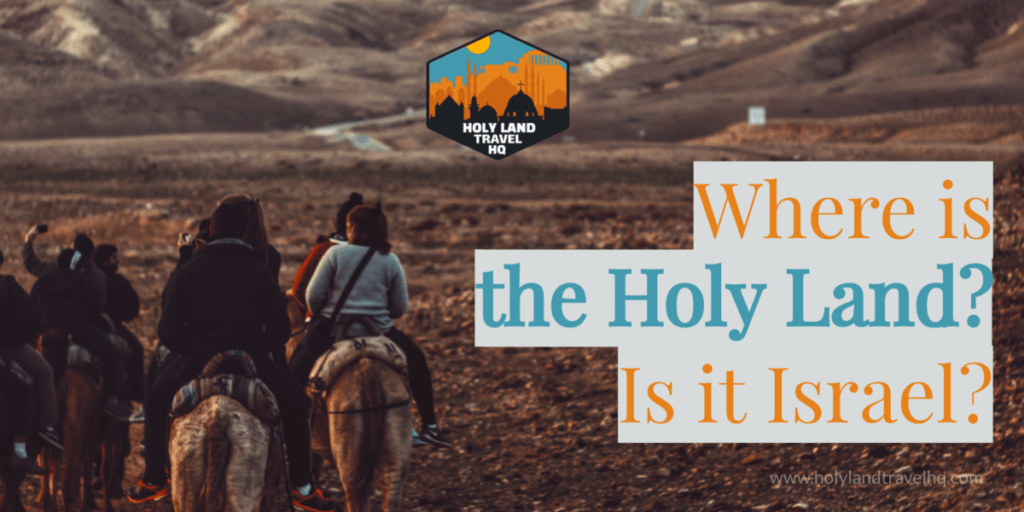
After leading the Israelites out of Egypt and through the desert for forty years, Moses climbed up Mount Nebo and peered out across the Jordan River. He saw the Promised Land and it was good. Today the phrase “promised land” more often refers to a goal that we believe will bring happiness. And we refer to the land Moses was looking at as the Holy Land , which begs the question…
I s Israel the Holy Land? The Holy Land is the space between the eastern edge of the Jordan River Valley and the shores of the Mediterranean Sea. It spans south through the Sinai Peninsula and north to Lebanon and Syria. Better put… modern Israel. This definition also includes parts of Egypt, Lebanon, Syria and Jordan.
Christians sometimes refer to Christian tours through Turkey, Greece, Italy, Jordan, and Egypt as Holy Land tours . And there are other locations in the Middle East that Muslims consider holy , such as Medina and Mecca. But when we hear the phrase Holy Land , it means Israel.
Why is Israel the Holy Land?
Israel is the Holy Land because it is where God interacted with His people. This is fact and history for nearly 2/3 of the world’s population (Jews, Christians, and Muslims).
For Jews, the Holy Land has meaning because significant events in the course of God’s relationship with them occurred there. Both before and after the exile to Egypt and exodus.
This relationship plays out in the first 5 books of the Old testament. What Jews call the Pentateuch . In the 6th book, The Book of Joshua , the story of the Israelite conquest of the Promised Land is told.
Christians consider Israel the Holy Land because of it’s Old Testament history. But also because it’s where Jesus conducted his ministry and died for our sins on the cross.
Jesus was and is the next step in the relationship God has with His people. Even though we do not apply spirituality to these locations, they are the Holy Land because of what happened there.
In Islam, Jerusalem is where the profit Mohammad supposedly ascended to heaven to pray with the former prophets. Muslims call Jerusalem Al-Quds, which is literally translated to The Holy . Even if we, as Christians, reject the teachings of Islam, Muslim reverence for Jerusalem says something about God.
Whether we are Christian, Jew, Muslim, or none of the above, something of immense importance happened in this land.
What were the original boundaries of the Promised Land?
In Exodus 23:31 God tells Moses, “I will establish your borders from the Red Sea to the Mediterranean Sea, and from the desert to the Euphrates River” (NIV). So, pretty much today’s states of Israel, Jordan, Lebanon, Syria and parts of Egypt.
In the ancient world, borders were not much of a thing. Boundaries were set by city walls and terrain features. Both the desert and the sea were considered to be equally treacherous. And mountains, ridge lines and rivers were impediments to invading armies.
When the Israelites eventually settled in the Promised Land, they didn’t fill in that whole area. What the borders of the State of Israel encompass today is roughly where Joshua and the 12 tribes settled. With the exception of the 2 and a half tribes that remained east of the Jordan River.
Why didn’t the ancient Israelites settle everything God gave them? Because what they did settle was enough. Plus, the land was filled with Canaanites, Philistines, and other pagan people groups. It was advantageous to stay close in order to survive.
Ultimately, the Israelites weren’t able to drive out the entirety of pagan societies from the land. And foreign invasions were a consistent problem.
Who were the Canaanites?
In the Bible, the Promised Land is often referred to as the Land of Canaan. And the people of the land were called Canaanites. Though it would be a stretch to refer to them as a single ethnic group with a unified name. Or even a claim to the land as a kingdom would have.
What scholars know about the Canaanites mostly comes from research done on the societies Canaanites dealt with. For the most part, they were not a single society. They had no unified kingdom but rather distinct and separate cultures. They also worshiped different and opposing deities. Like Dagon, who is mentioned in Judges and 1 Samuel.
Other Canaanite deities include Ashtoreth and Baal-Zebub.
Calling someone a Canaanite back then was akin to calling someone European today. Or African. It included a large swath of varying communities. Except the term also brought with it a connotation of paganism.
For context before we move on, Joshua lead the Israelites into the Promised land in the late 15th century BCE.
Who were the Philistines?
The Philistines were not Canaanites, but they lived in Canaan. Dr. Carl Rasmussen notes, in his Zondervan Atlas of the Bible , that in the 12th century BCE, a new people group arrived. This is roughly the time of the Judges. Rasmussen states that Egyptian sources called this group the Sea People .
Based on Archaeological evidence, the Sea People traveled by sea from what we know today as Greece. Like the Canaanites, they weren’t a single people group. They were many and they landed in Egypt, Lebanon, Syria and southern Turkey.
The Egyptians defeated their invaders and sent them packing. This group moved north by land and sea into Canaan. Other groups from the Lebanon/Turkey/Syria invasion moved south into Canaan.
Though there were several groups within the Sea People , the most significant and treacherous were the Philistines.
The Philistines mainly settled along the coast at Gaza, Ashkelon, Ashdod, Gath, and Ekron.
What happened to the Canaanites and Philistines?
In essence, these societies dissipated over time as a result of invasions.
Throughout the conquest of the Promised Land and into the period of the Judges (14th and 15th centuries BCE) the Canaanites were the main adversary. It’s no surprise though that these people groups did not last long due to their fractured nature.
When the Sea People arrived, it was pretty much game over for the Canaanites. By the time of the united kingdom under the rule of King Saul and then King David, the Canaanites were a historical talking point.
In fact, after the book of Judges, when there is mention of the Canaanites, its in reference to the past. And usually a sinful past.
Although the Philistines were much more unified, they too have a hazy transition into history.
Starting in the 8th century BCE, during the time of the divided kingdom, invaders from the east began to conquest the land. ( Note: the Israelite kingdom split when Solomon died in the 10th century BCE. )
The Assyrian invasions under the leadership of Shalmaneser, Tiglath-Pileser, Sargon, and Sennacherib were brutal and devastating. The Philistines, who lived on the coast and in the plains, were extremely susceptible to attacks.
By this time the Israelites were split into two kingdoms. The southern kingdom, made up of the tribe of Judah. And the northern kingdom, made up of the remaining Israelite tribes.
The northern, or Israelite, kingdom was at risk as much as the Philistines were. It was basically the gateway into the Promised land. In the book A Biblical History of Israel (Provan, Long, and Longman) the authors state that Tiglath-Pileser III is “regarded as the rod that broke Philistia.”
It’s clear in the Bible that the Assyrian invasions were the beginning of the end for the Philistines and the northern kingdom. Where these people ended up is unclear.
There is no record of the aftermath available like there is for the Kingdom of Judah. Which is basically everything in the Old Testament after the book of Lamentations.
What was the land called before the State of Israel?
For almost 2,000 years, up until the recognition of the State of Israel in 1948, the region was benignly known as Palestine. I say benignly, because today the name Palestine conjures up political and religious strife. And even resentment.
After the Bar Kokhba revolt in the 2nd century CE, the Romans were done with the Province of Judea. And the so-called Jewish troublemakers. Rome looked to rebrand the region.
The Romans renamed Jerusalem Aelia Capitolina and called the land the Province of Syria Palaestina . The name was derived from the population that had lived in the region 900 years before, the Philistines. To the Romans, anything that was not Jewish in nature was welcomed.
Over the years the name went through many iterations, and by the 20th century CE it was Palestine. And the people residing in it were Palestinians, including Jews.
Obviously today, Palestine and its people, the Palestinians, refer to the group of Muslims who live within the borders of the State of Israel.
Recent Posts
What is the Via Dolorosa?
Every year, millions of Christians make the pilgrimage to the Holy Land to walk in the footsteps of Jesus. One of the many attractions they will experience is the Via Dolorosa. Or The Way of the...
How to Rent a Car in Israel and The West Bank
One of the questions I get asked the most is how to rent a car in Israel. But more specifically, can you take that rental car into the West Bank.

- Company Profile
- Raphael Ben Hur
- Israel Guarantee Departures
- Israel & The Fine Art of Travel
- Christian Israel tours
- Israel Tours Jewish
- Israel, land of many wonders
- Israel Tour Packages
Israel Tours 2015
Israel & jordan tours.
- Footsteps of Jesus
- Christian tours to Israel
Bible Tours
- Tour in Israel
- Feast of Tabernacles
Evangelica Itinerary
- Israel Itinerary
Feast of Tabernacles – 2015
Featured destinations.
Evangelica Itinerary – 9 days, 8 nights DAY ONE: ARRIVE IN ISRAEL, Our representatives will met you and walk you through customs. We’ll then drive you to the hotel in Tiberias for dinner and overnight stay DAY TWO: NAZARETH, GOSPEL TRAIL, SEA OF GALILEE, On this day we will start with the Gospel Trail at the Mt of Precipice at Nazareth. The Gospel Trail offers the opportunity to discover the cradle of Christianity by experiencing both…
Christian Tours to Israel Israel Holyland Travel offers an array of Christian Tours to Israel to satisfy every curiosity. Travel through the Holy Land to explore the sites of the Bible or combine it with a regional tour. From Israel, continue on to see the sites in Bethlehem and Jericho, Jordan, or Egypt. Israel Holyland Travel has different packages so you can see them all. Christian Tours offered by Israel Holyland Travel include: Holy Land Pilgrimage…
Israel Holyland Travel
Chat with us
“Then the survivors from all the nations that have attacked Jerusalem will go up year after year to worship the King, the Lord Almighty, and to celebrate the Festival of Tabernacles. If any of the peoples of the earth do not go up to Jerusalem to worship the King, the Lord Almighty, they will have no rain.” Zecharia 14/16 JOIN US and register now for The Feast of Tabernacles, an opportunity to be part of unique…
Jewish State 14 Day Tour
Past to the Future The Highlights of the Jewish State 14 nights Day 1 – Thursday, Arrival Our representative will meet you after passport control upon your arrival to Ben Gurion Airport, assisting as you pick up your luggage and head out for the transfer to your hotel. Check in at the hotel in Tel Aviv. Overnight: Tel Aviv Day 2 – Friday, Tel Aviv tour Our first day of touring will begin immediately after breakfast. An…
Jewish State 12 Day Tour
Past to the Future The Highlights of the Jewish State 12 nights Day 1 – Thursday, Arrival Our representative will meet you after passport control upon your arrival to Ben Gurion Airport, assisting as you pick up your luggage and head out for the transfer to your hotel. Check in at the hotel in Tel Aviv. Overnight: Tel Aviv Day 2 – Friday, Tel Aviv tour Our first day of touring will begin immediately after…
Search Israel Holyland Travel
Featured Video
Tour the holy land.
Popular Articles
- Holyland Tours
- Jewish Tours
- Visit Israel
Tour the Holy Land with someone who understands the Holyland
For more information and booking, contact us:
Our email: [email protected] Our telephone : 972-50-6214155
Israel Holyland Travel by Holy Land Gifts
Monday - Friday 9:00 AM - 5:30 PM, Pacific Standard Time

2024, 2025 Holy Land Tour Packages
Join one of our special Signature Holy Land Tours for an amazing experience of a lifetime.
Read our Holy Land Tour Reviews

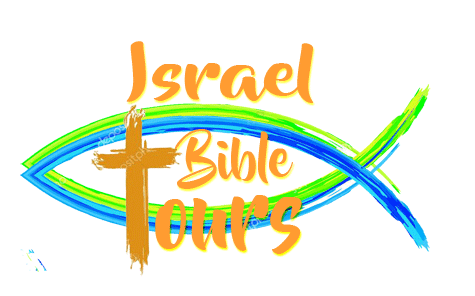
972 54-562-7060

Experience the Holy Land Adventure of a Lifetime!
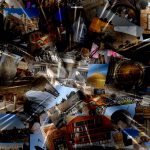
1000s of Historical Sites & Relics
Create your own adventure.
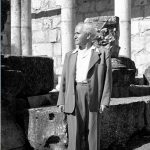
A Great Jew Honouring Another Great Jew

Caesarea Philippi
The church to whom apostle paul wrote.
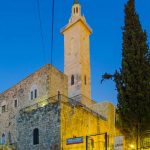
Birthplace of John the Baptist
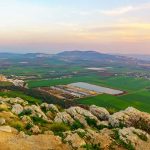
Prophesied location of armies for end time battle

Explore the Beauty

The economic & technological center of Israel

Caves Where Dead Sea Scrolls Discovered
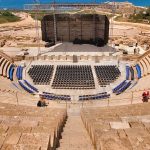
Peter baptized Cornelius, Paul Sailed & Imprisoned
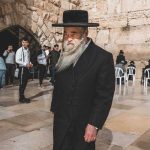
Wailing Wall
Western wall, old city of jerusalem.
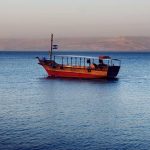
Sail Where Jesus Sailed
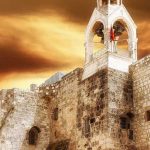
Birthplace of Jesus
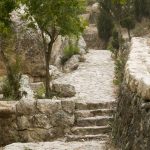
The Road Jesus and Disciples Walked
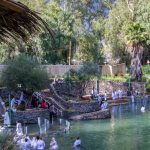
Jordan River
Be baptised in the jordan.
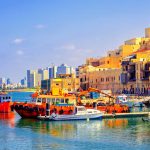
Where Jonah set sail
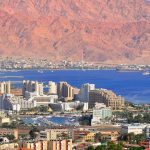
Red Sea, Jordan
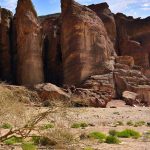
Timna Valley
King solomon's pillars.
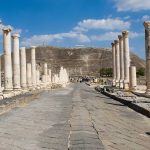
Beit She’an
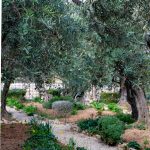
Where Jesus agonized in the garden & Judas betrayed Jesus.
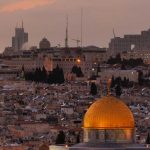
The Center of the World
Ancient & beautiful israel, guided tours of the holy land.
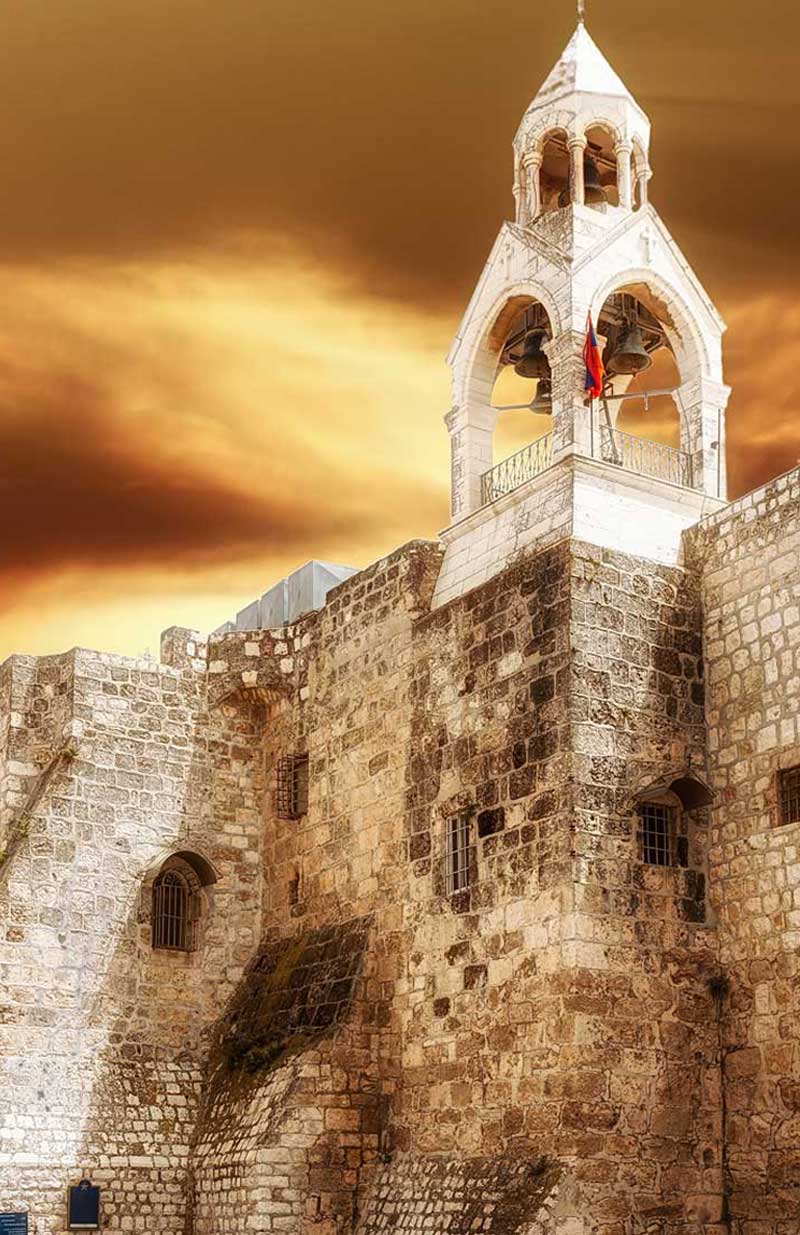
Bethlehem & Jerusalem
1-day holy land tour.
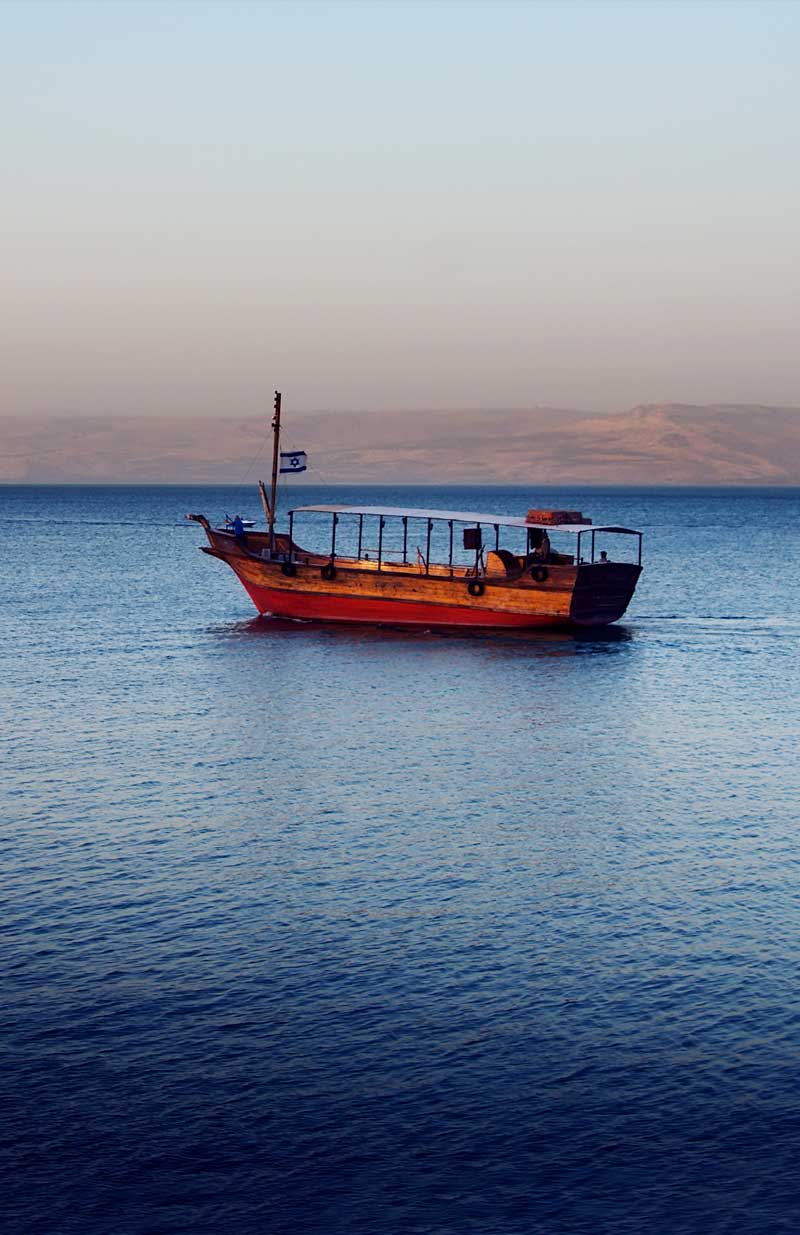
Galilee, Bethlehem, Jerusalem, Caesarea
3-day holy land tour.
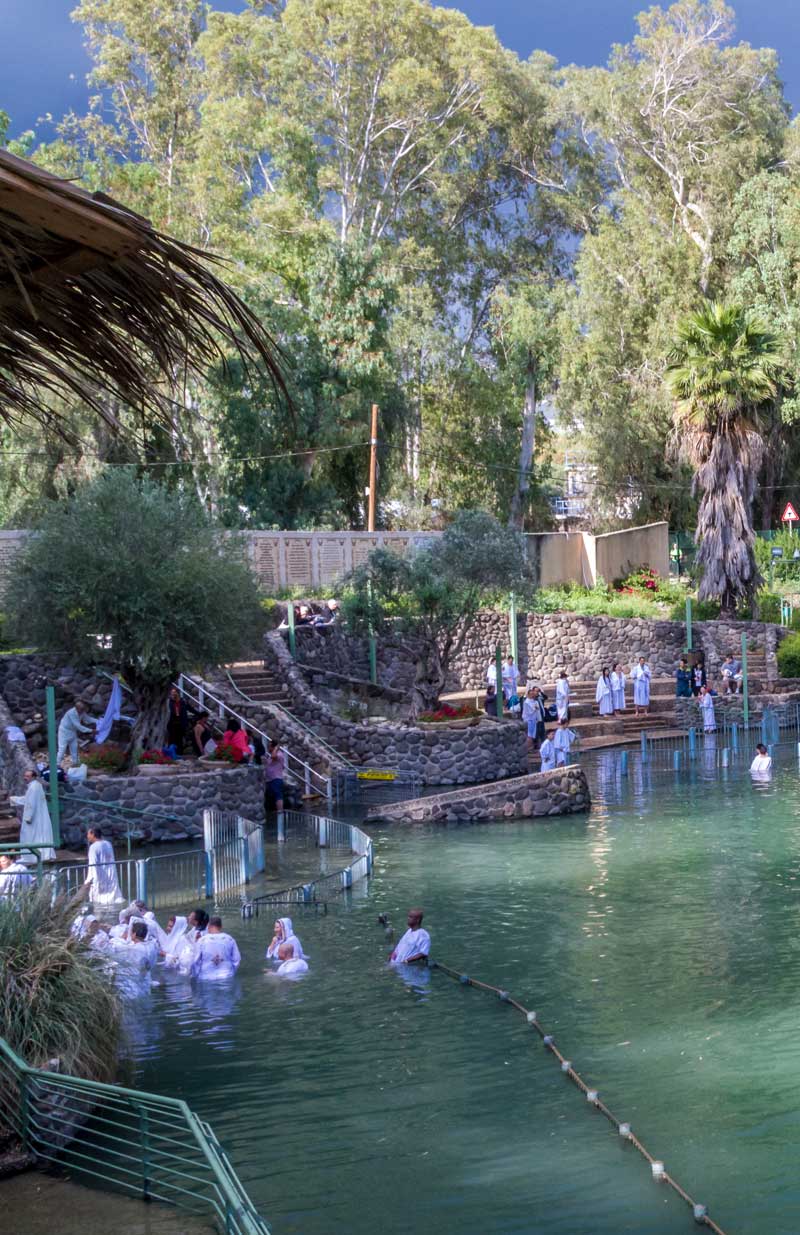
+Nazareth, Cana, Philippi & more
5-day holy land tour.
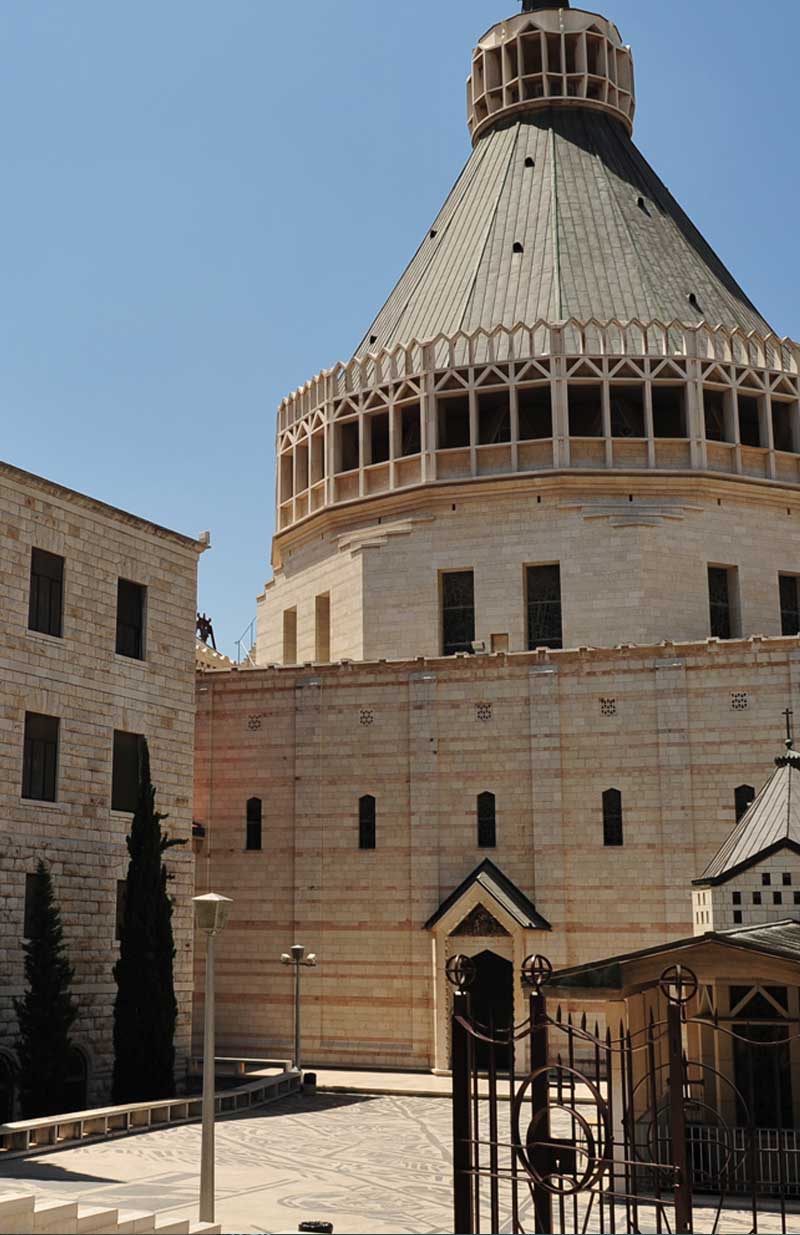
+Capernaum, Gethsemene, Ein Karem & more
7-day holy land tour.
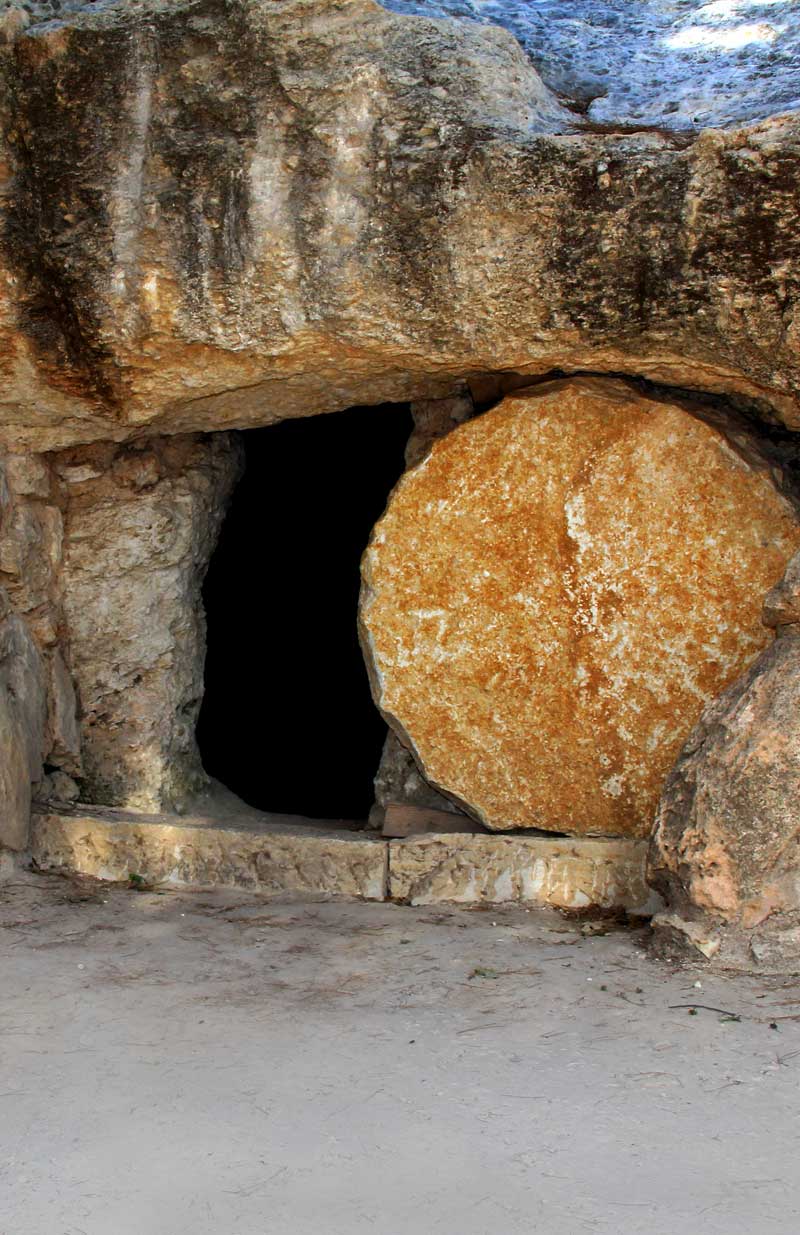
+Sinai, Tel Aviv, Armegeddon, Quman, Petra
10-14-day holy land tour.
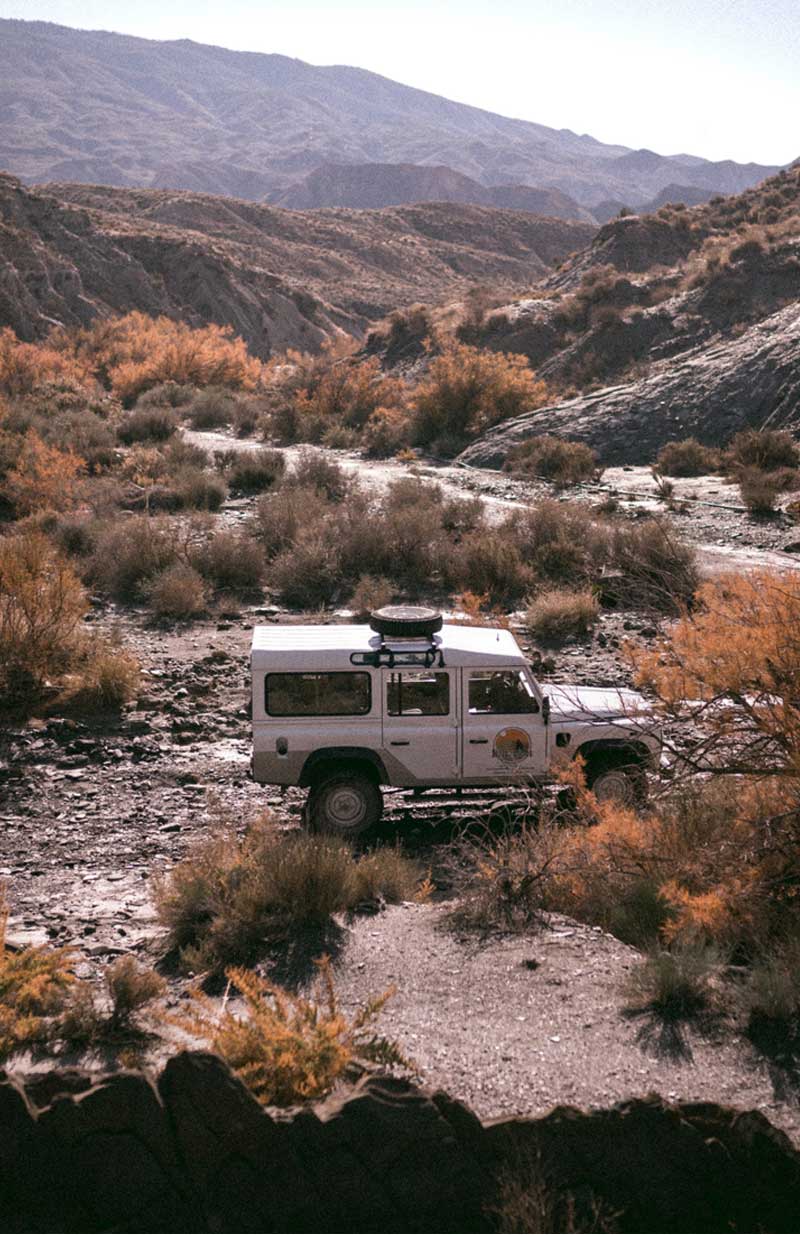
Choose Your Own Adventure
Design your own holy land tour, from the sea to the promised land, explore israel with a certified archeologist and real galilean, matthew 28:10 then jesus said to them, “do not be afraid. go and tell my brethren to go to galilee, and there they will see me.” nkjv.
If you’ve ever wanted to visit the Holy Land, there has never been a better time! Organize a trip with your church, or come in a small group for a private tour with friends & family for a day trip to Bethlehem & Jerusalem, or come for up to 14 days and experience ALL the major cities of the Bible.
Special Attractions
With over 100 attractions to see in the Holy Land, you will experience where your favorite Bible characters walked & lived.
Experience the History
See how 3 cultures: Jews, Muslims & Christians have learned to live together in the homeland of Israel.
Your Private Guide
For large groups or small, we do it all. There's nothing like having a private guide to take you along the safest routes and fill in all the rich history of the sites.
Many Languages
Tour guide languages: Hebrew, English German, French, Hungarian, Spanish, Portuguese, Polish, Flemish, Japanese, Korean, and Chinese
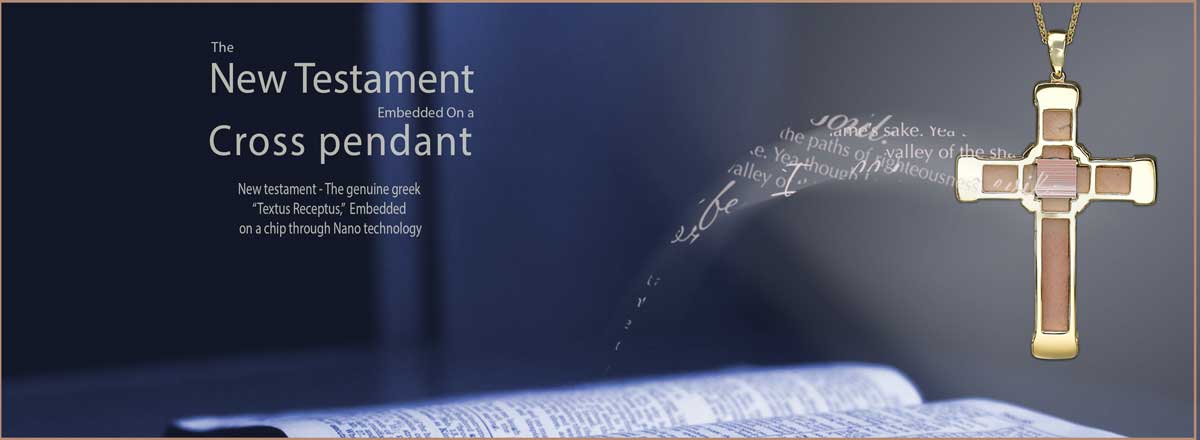
Exciting Sites of the Holy Land of Israel!
Your tour guides.
Explore the most extraordinary locations of the Old & New Testament Bibles with your own, personal, highly-experienced Tour Guide.
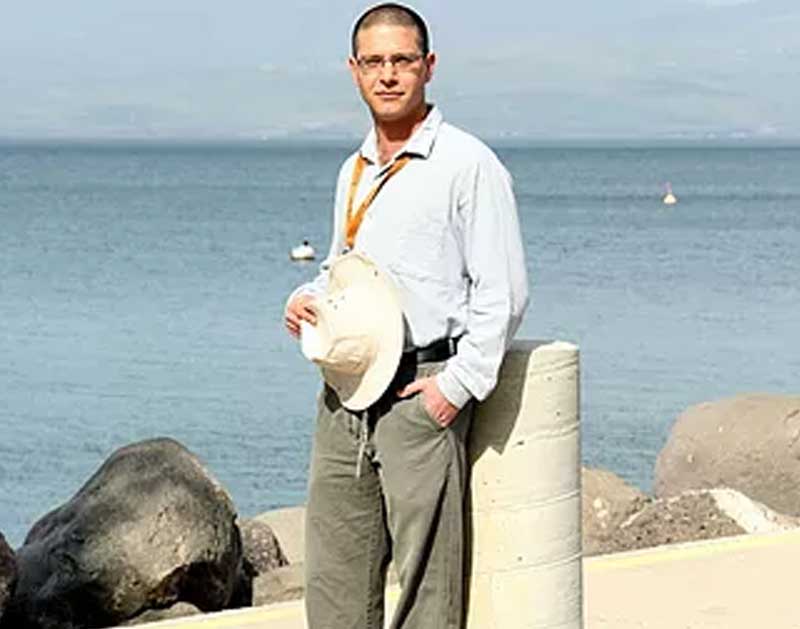
We are the only company in the world of Christian holy land travel to have private tours by REAL Galilean. Edan is an archeologist, historian, theologian, philosopher and political scientist in the form of a courteous and polite young man.
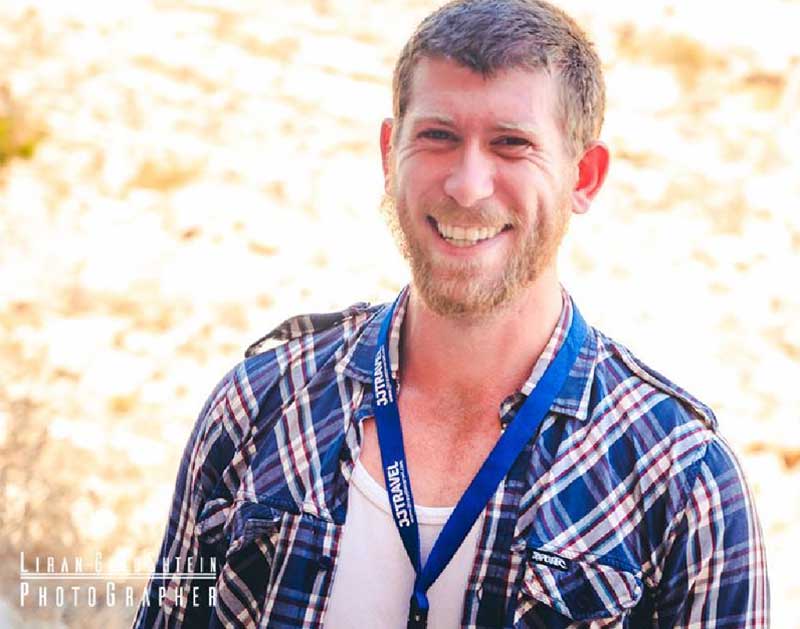
James McKeever
Private Unique guided Tours to Israel ?? and Jordan, by a British born Israeli citizen, Israeli army vetran, fisherman, explorer and qualified guide living in picturesque Kibbutz Ein Gev.+123 456789 1011
Client Testimonials
Testimonial # 4, edan geva provides a smart, inspiring adventure to the holy land for all ages and interests. with an eye for archeology and local color, edan’s expertise will take any visitor to israel “off the grid” of charter buses and canned tours and into the land of the bible., rev. rich webster,, a researchers delight, i'm passionate and i travel the world not just as a tourist but to understand cultures. i've lived with masai tribe. i travel the world and bring it back in the form of a research book., john galliano,, tourist vs traveler, his wide range of life experiences came to surface throughout our journey and heightened our enjoyment, making out trip all the more unique from that of a standard tour. he was always prompt and understanding of our needs as well as flexible to deviating from the formal itinerary. he shared many of his favorite dining places with us and was truly an entertaining man to be with. we genuinely are thankful for his making our trip to the holy land an unforgettable one, daniel j. boorstin ,, september 2018, my wife and i recently had the great fortune of being escorted for one week through israel by a wonderful guide, edan geva. edan is an archeologist, historian, theologian, philosopher and political scientist in the form of a courteous and polite young man. his knowledge of all sites goes beyond statistics and facts. he incorporates personal observations and feelings that embellish your adventure and exploration., clients & endorsements.

You don't have permission to register
Update April 12, 2024
Information for u.s. citizens in the middle east.
- Travel Advisories |
- Contact Us |
- MyTravelGov |
Find U.S. Embassies & Consulates
Travel.state.gov, congressional liaison, special issuance agency, u.s. passports, international travel, intercountry adoption, international parental child abduction, records and authentications, popular links, travel advisories, mytravelgov, stay connected, legal resources, legal information, info for u.s. law enforcement.
Replace or Certify Documents
Share this page:
Latest Information for U.S. Citizens
Information for U.S. Citizens in Israel, the West Bank, and Gaza
The Department reminds U.S. citizens of the continued need for caution and increased personal security awareness as security incidents often take place without warning. The security environment remains complex and can change quickly depending on the political situation and recent events. Please see the latest Israel Security Alert .
U.S. citizens should heed the Travel Advisory for Israel, the West Bank, and Gaza. The U.S. Embassy continues to closely monitor the dynamic security situation in Israel, the West Bank, and Gaza. There are active military operations and active rocket and mortar fire in Gaza and the Gaza periphery. Terrorist groups, lone-actor terrorists and other violent extremists continue plotting possible attacks in Israel, the West Bank, and Gaza. Terrorists and violent extremists may attack with little or no warning, targeting tourist locations, transportation hubs, markets/shopping malls, and local government facilities. Violence can occur in Israel, the West Bank, and Gaza without warning. If you require emergency assistance while in Israel, the West Bank or Gaza, contact the U.S. Embassy in Jerusalem by email ([email protected]).
Individuals seeking to depart Gaza through the Rafah crossing into Egypt should monitor the Palestinian General Authority for Crossings and Borders’ Facebook Page for a list of those approved to cross. U.S. citizens, Lawful Permanent Residents, or immediate family (as listed below) who desire our assistance and have not already provided their information to the Department of State, please email U.S. Embassy Jerusalem at [email protected] with a copy of the individual’s travel document as well as an explanation or proof of relationship.
The U.S. government does not control the crossing lists nor determine who is permitted to depart Gaza or enter Egypt. Individuals must assess their own safety and risks in attempting to cross the border. Individuals permitted to enter Egypt will likely receive a 72-hour Egyptian visa; all those who cross should have a plan for onward travel from Egypt in this timeframe. U.S. citizens, LPRs and their immediate family members who successfully enter Egypt and require further consular assistance should contact the U.S. Embassy in Cairo via the U.S. Citizens Services Navigator . Individuals may apply for a U.S. visa at any U.S. Embassy or Consulate; U.S. immigration laws and regulations will apply.
If a name has appeared on a crossing list since November 1, we understand those individuals will be permitted to cross as long as the border remains open for foreign nationals. We urge U.S. citizens, LPRs, and their immediate family members who have appeared on one of these lists to cross as soon as possible – there is no guarantee the border will remain open. We continue to work in partnership with Egypt and Israel towards safe passage for U.S. citizens, LPRs, and their immediate family members.
Immediate family members of U.S. citizens include:
- unmarried children under the age of 21, and
- parents of U.S. citizens.
If the U.S. citizen is under 21, immediate family will also include any siblings who are also unmarried and under 21.
Immediate family members of LPRs include:
- unmarried children under 21 years of age.
Enroll in STEP

Subscribe to get up-to-date safety and security information and help us reach you in an emergency abroad.
Recommended Web Browsers: Microsoft Edge or Google Chrome.
Make two copies of all of your travel documents in case of emergency, and leave one with a trusted friend or relative.
External Link
You are about to leave travel.state.gov for an external website that is not maintained by the U.S. Department of State.
Links to external websites are provided as a convenience and should not be construed as an endorsement by the U.S. Department of State of the views or products contained therein. If you wish to remain on travel.state.gov, click the "cancel" message.
You are about to visit:

IMAGES
VIDEO
COMMENTS
The list wraps up 40 sacred places in Jerusalem, Bethlehem, Nazareth, Hebron, the Sea of Galilee, Haifa, Acre (Akko), and Safed. The collection of 40 sacred places in Israel and the West Bank starts with the holiest city in the world - Jerusalem. 1. Holy Sites in Jerusalem.
Israel lifted the last of the pandemic travel restrictions in early fall. "We anticipate that 2023 will exceed 2019 tourist numbers," he adds. Ben Julius, Founder of Tourist Israel, projects the ...
Israel is where most of the Biblical events took place. You can follow in Jesus' footsteps when you visit Bethlehem, Nazareth, the Galilee, and Jerusalem. But think bigger! This is the land God promised to Abraham, where Elijah called fire from the sky, Deborah led an army in battle, and where David killed Goliath.
Bethlehem is perhaps the most important place to visit in the Holy Land, as it is the birthplace of Jesus and home to the Church of Nativity (under which Jesus was born, marked by a 14-pointed star set in the ground). ... Other Holy Land Sites in Israel. Israel is full of biblical references everywhere you go. Because I was only there for a ...
Tel Aviv. Famous for its beach lifestyle and hedonistic nightlife, some say if Jerusalem is the holy city, Tel Aviv is Babylon. Tel Aviv often surprises first-timers with its modern outlook and lively social scene. You will never be short of things to do in Tel Aviv . Neve Tzedek - The Soho of Tel Aviv.
In 2014 Israel launched Operation Protective Edge (direct link to idf.il) to restore security in the south around Gaza. Despite International backlash against the operation, the result has been a safer tourist environment. ... With security levels making holy land travel safer, Christmas in the land where Jesus was born and crucified is ...
Visit the Holy Land - Highlights of Israel. 1. Jerusalem Old City. The Old City of Jerusalem itself is home to three key religious sites. The Western Wall is worshipped by Jews as the oldest remaining temple wall, from the second temple period. Temple Mount itself is seen by Jews as the spot of both the first and second temples, but this area ...
The Holy Land is an area roughly located between the Mediterranean Sea and the eastern bank of the Jordan River, traditionally synonymous both with the biblical Land of Israel and with the region of Palestine.Today, the term "Holy Land" usually refers to a territory roughly corresponding to the modern states of Israel and Palestine. Jews, Christians, Muslims, and Bahá'ís regard it as holy.
Christian Galilee Tour - Available every Thursday. Starts in Tel Aviv, Jerusalem. Half Day Tour in Bethlehem - Available everyday. Starts in Tel Aviv, Jerusalem, great for a quick trip. Christmas in Bethlehem and Jerusalem 2 Day Tour - On December 24th, making the festival of Christmas a little more special.
10. Caesarea. One of the best places to visit in Israel for an extended tour of the Holy Land is Caesarea. This ancient port city is located on the Mediterranean Sea and was built by King Herod over 2000 years ago. It has a rich and checkered past, having frequently been conquered by various empires throughout history.
History | July 2019. Two Tour Guides—One Israeli, One Palestinian—Offer a New Way to See the Holy Land. With conflict raging again in Israel, a fearless initiative reveals a complex reality ...
Our Israel tours & Holy Land tours of 9-24 days for the Evangelical Protestant Bible believer are what Pilgrim Tours does best. Prepare yourself for a life-changing journey to walk where Jesus walked and visit Jerusalem, Galilee, & Samaria. Each of our Israel tours is led by a local guide who is an experienced expert on the historical, cultural ...
How to Book Masses in the Holy Land. The one crucial factor to booking masses is very simple: book in advance to secure availability at your preferred churches. From our experience, masses are booked many months prior to arrival and availability becomes quite scarce as your arrival grows nearer. 6.
See the highlights of all the biblical sites in Israel in a peaceful, relaxing setting! Tour the Holy Land and see places like, Jerusalem, Sea of Galilee, Jo...
The "high" season in the south runs from October to March, when it is merely hot- but dry, and quite comfortable in sandals and shorts. 6. Remember the Sabbath (Shabat). Virtually the entire country shuts down from Friday at sundown to Saturday at sundown, except for the Arab businesses, and essential services.
Your adventure starts in Tel Aviv, the chic center for spirited luxury and captivating nightlife. Get a taste of the local flavor during a home-hosted lunch in a Druze community. Step into the past and enjoy a cruise on the Sea of Galilee. Visit UNESCO World Heritage sites, including Jerusalem's Old City. Gain a new perspective as you ascend ...
The Holy Land is the space between the eastern edge of the Jordan River Valley and the shores of the Mediterranean Sea. It spans south through the Sinai Peninsula and north to Lebanon and Syria. Better put… modern Israel. This definition also includes parts of Egypt, Lebanon, Syria and Jordan. Christians sometimes refer to Christian tours ...
Home » Israel: The Holy Land Travel Guide. Israel: The Holy Land Travel Guide. Travel to Israel. Although a small country, Israel has a very rich history and culture and is considered by many as one of the most fascinating countries in the world. For Christians to visit Israel is the ultimate experience! But this country fascinates tourists ...
Israel Holy Land Travel Ltd. Established from the love to Israel. This beautiful country has many years of history and legacy that is meaningful to all religions. The company founded with the belief that each person should come to Israel at least once in their life. Explore the land and be connected to its roots in the best possible way.
Tour Duration: 10 Days / 7 Nights │ Land Package Rate: Prices from $2,180. Christian Holy Land Tour of Israel including all transportation, 5 Star or 4 Star hotel accommodations, daily breakfast, daily dinner, sightseeing as per program, and entrance fees as per itinerary, plus as an extra one night stay in the Dead Sea resort area.
Here are 15 places to visit in the Holy Land! Inspiration Faith & Prayer Health & Wellness Entertainment Love & Family. Newsletters Special Offers. Inspiration. 2024-04-09 2024-04-09.
Testimonial # 4. Edan Geva provides a smart, inspiring adventure to the Holy Land for all ages and interests. With an eye for archeology and local color, Edan's expertise will take any visitor to Israel "off the grid" of Charter Buses and canned tours and into the Land of the Bible.
Please see the latest Israel Security Alert. U.S. citizens should heed the Travel Advisory for Israel, the West Bank, and Gaza. The U.S. Embassy continues to closely monitor the dynamic security situation in Israel, the West Bank, and Gaza. There are active military operations and active rocket and mortar fire in Gaza and the Gaza periphery.